Biometric Technology for Network Security
VerifiedAdded on 2020/05/28
|91
|23282
|230
AI Summary
This assignment delves into the application of biometric technology to strengthen network security. It examines the effectiveness of biometric methods, their advantages such as identity tracking and access control, and potential drawbacks like cost and technical limitations. The analysis also considers various biometric technologies used in business, including face recognition and fingerprint scanning, along with factors for comparison. Furthermore, it explores recommendations for implementing biometric solutions to improve network security within organizations.
Contribute Materials
Your contribution can guide someone’s learning journey. Share your
documents today.
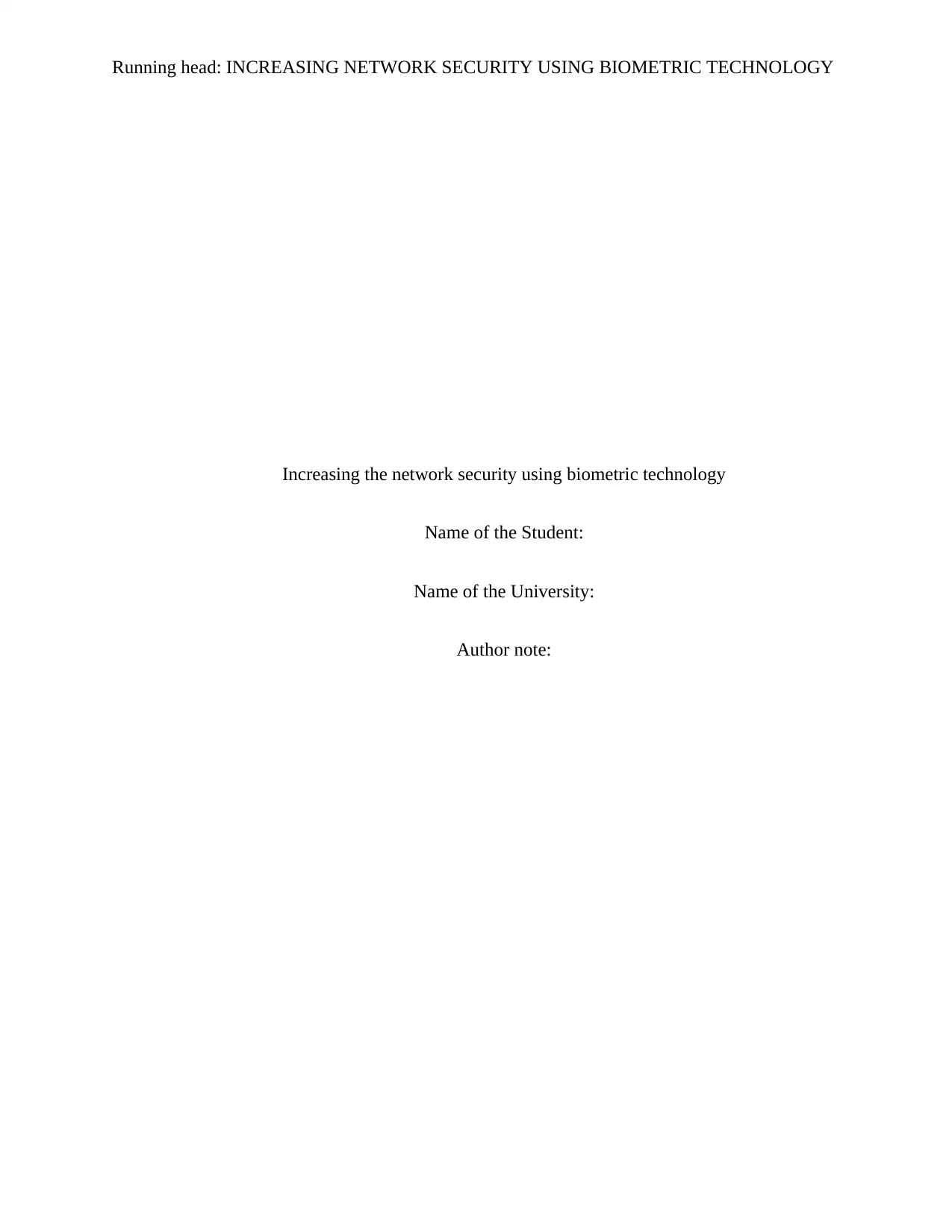
Running head: INCREASING NETWORK SECURITY USING BIOMETRIC TECHNOLOGY
Increasing the network security using biometric technology
Name of the Student:
Name of the University:
Author note:
Increasing the network security using biometric technology
Name of the Student:
Name of the University:
Author note:
Secure Best Marks with AI Grader
Need help grading? Try our AI Grader for instant feedback on your assignments.
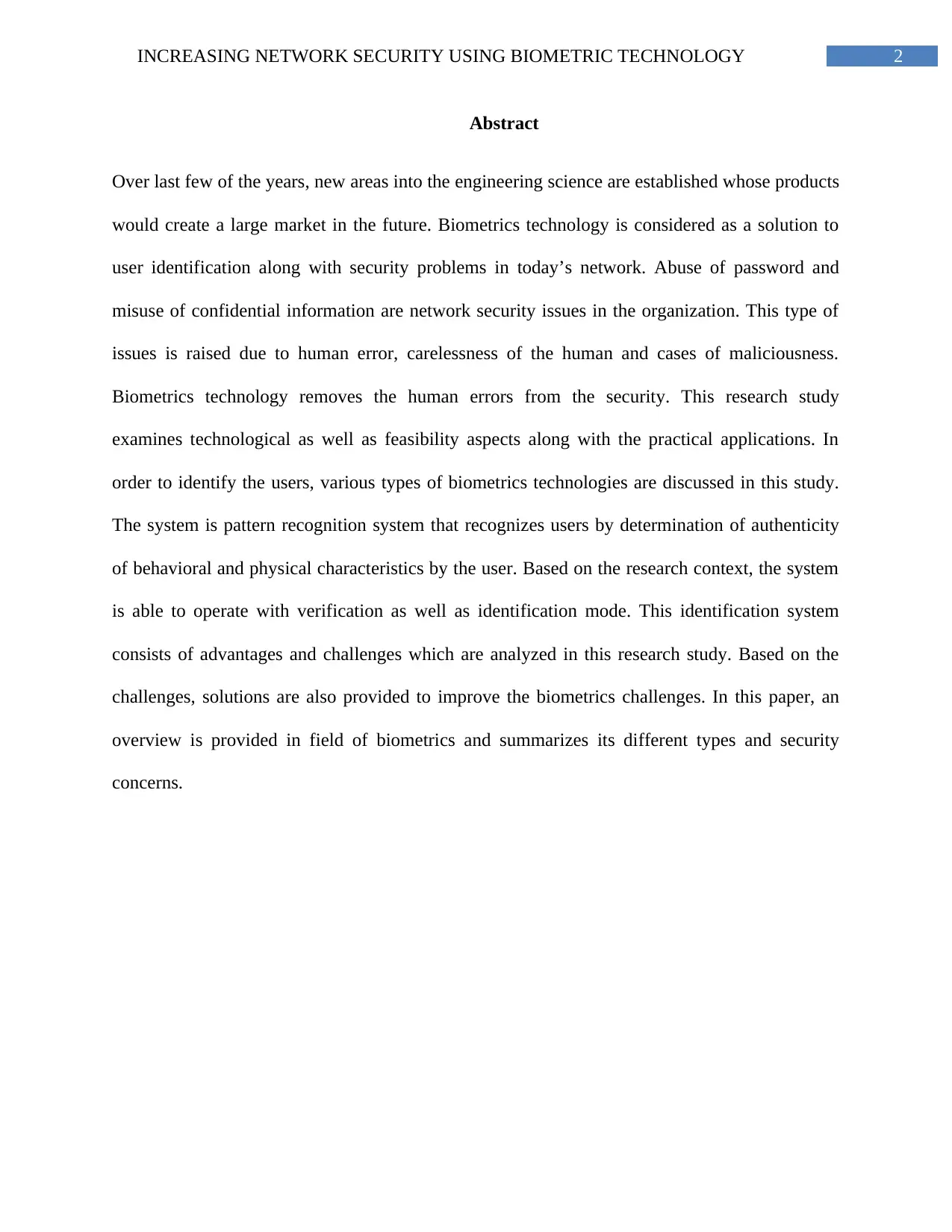
2INCREASING NETWORK SECURITY USING BIOMETRIC TECHNOLOGY
Abstract
Over last few of the years, new areas into the engineering science are established whose products
would create a large market in the future. Biometrics technology is considered as a solution to
user identification along with security problems in today’s network. Abuse of password and
misuse of confidential information are network security issues in the organization. This type of
issues is raised due to human error, carelessness of the human and cases of maliciousness.
Biometrics technology removes the human errors from the security. This research study
examines technological as well as feasibility aspects along with the practical applications. In
order to identify the users, various types of biometrics technologies are discussed in this study.
The system is pattern recognition system that recognizes users by determination of authenticity
of behavioral and physical characteristics by the user. Based on the research context, the system
is able to operate with verification as well as identification mode. This identification system
consists of advantages and challenges which are analyzed in this research study. Based on the
challenges, solutions are also provided to improve the biometrics challenges. In this paper, an
overview is provided in field of biometrics and summarizes its different types and security
concerns.
Abstract
Over last few of the years, new areas into the engineering science are established whose products
would create a large market in the future. Biometrics technology is considered as a solution to
user identification along with security problems in today’s network. Abuse of password and
misuse of confidential information are network security issues in the organization. This type of
issues is raised due to human error, carelessness of the human and cases of maliciousness.
Biometrics technology removes the human errors from the security. This research study
examines technological as well as feasibility aspects along with the practical applications. In
order to identify the users, various types of biometrics technologies are discussed in this study.
The system is pattern recognition system that recognizes users by determination of authenticity
of behavioral and physical characteristics by the user. Based on the research context, the system
is able to operate with verification as well as identification mode. This identification system
consists of advantages and challenges which are analyzed in this research study. Based on the
challenges, solutions are also provided to improve the biometrics challenges. In this paper, an
overview is provided in field of biometrics and summarizes its different types and security
concerns.

3INCREASING NETWORK SECURITY USING BIOMETRIC TECHNOLOGY
Acknowledgement
Conducting the research study enhances me to improve my knowledge as well as analytical
ability. It gave me the chance to face challenges all the while and conquer them. It will not be
possible to conduct the research without the significant direction of my professors, companions
and every one of who have added to this advancing knowledge. I also want to thank my
supervisor __________ for helping me in my research work as well as give their full support
during the research process. I would also thank all the participants within this study for giving
their time and helping me out. From the support of people, I am inspired to work on the research
in this subject area. Finally, thank you to my family members those help me and encourage me.
Thank You.
Acknowledgement
Conducting the research study enhances me to improve my knowledge as well as analytical
ability. It gave me the chance to face challenges all the while and conquer them. It will not be
possible to conduct the research without the significant direction of my professors, companions
and every one of who have added to this advancing knowledge. I also want to thank my
supervisor __________ for helping me in my research work as well as give their full support
during the research process. I would also thank all the participants within this study for giving
their time and helping me out. From the support of people, I am inspired to work on the research
in this subject area. Finally, thank you to my family members those help me and encourage me.
Thank You.
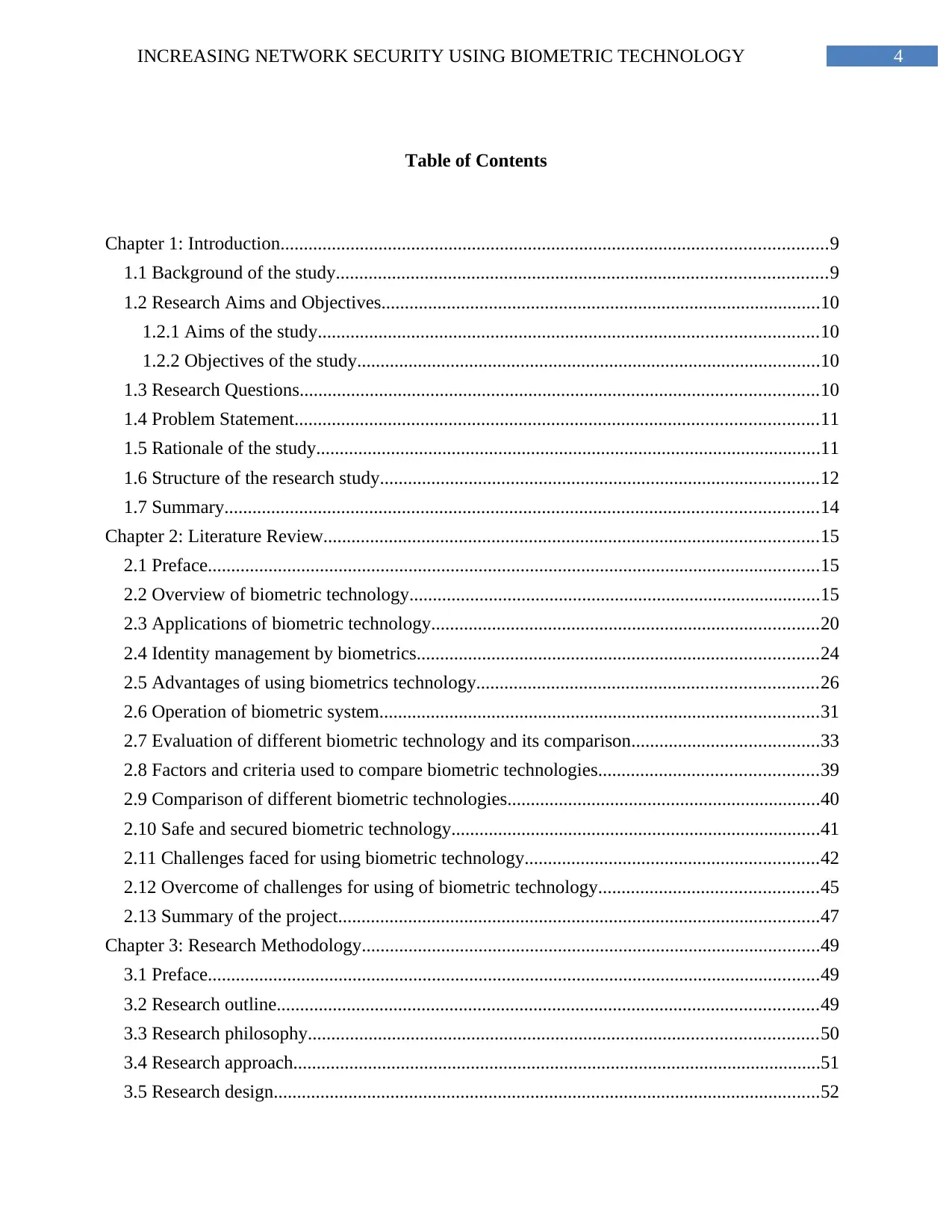
4INCREASING NETWORK SECURITY USING BIOMETRIC TECHNOLOGY
Table of Contents
Chapter 1: Introduction.....................................................................................................................9
1.1 Background of the study.........................................................................................................9
1.2 Research Aims and Objectives..............................................................................................10
1.2.1 Aims of the study...........................................................................................................10
1.2.2 Objectives of the study...................................................................................................10
1.3 Research Questions...............................................................................................................10
1.4 Problem Statement................................................................................................................11
1.5 Rationale of the study............................................................................................................11
1.6 Structure of the research study..............................................................................................12
1.7 Summary...............................................................................................................................14
Chapter 2: Literature Review..........................................................................................................15
2.1 Preface...................................................................................................................................15
2.2 Overview of biometric technology........................................................................................15
2.3 Applications of biometric technology...................................................................................20
2.4 Identity management by biometrics......................................................................................24
2.5 Advantages of using biometrics technology.........................................................................26
2.6 Operation of biometric system..............................................................................................31
2.7 Evaluation of different biometric technology and its comparison........................................33
2.8 Factors and criteria used to compare biometric technologies...............................................39
2.9 Comparison of different biometric technologies...................................................................40
2.10 Safe and secured biometric technology...............................................................................41
2.11 Challenges faced for using biometric technology...............................................................42
2.12 Overcome of challenges for using of biometric technology...............................................45
2.13 Summary of the project.......................................................................................................47
Chapter 3: Research Methodology..................................................................................................49
3.1 Preface...................................................................................................................................49
3.2 Research outline....................................................................................................................49
3.3 Research philosophy.............................................................................................................50
3.4 Research approach.................................................................................................................51
3.5 Research design.....................................................................................................................52
Table of Contents
Chapter 1: Introduction.....................................................................................................................9
1.1 Background of the study.........................................................................................................9
1.2 Research Aims and Objectives..............................................................................................10
1.2.1 Aims of the study...........................................................................................................10
1.2.2 Objectives of the study...................................................................................................10
1.3 Research Questions...............................................................................................................10
1.4 Problem Statement................................................................................................................11
1.5 Rationale of the study............................................................................................................11
1.6 Structure of the research study..............................................................................................12
1.7 Summary...............................................................................................................................14
Chapter 2: Literature Review..........................................................................................................15
2.1 Preface...................................................................................................................................15
2.2 Overview of biometric technology........................................................................................15
2.3 Applications of biometric technology...................................................................................20
2.4 Identity management by biometrics......................................................................................24
2.5 Advantages of using biometrics technology.........................................................................26
2.6 Operation of biometric system..............................................................................................31
2.7 Evaluation of different biometric technology and its comparison........................................33
2.8 Factors and criteria used to compare biometric technologies...............................................39
2.9 Comparison of different biometric technologies...................................................................40
2.10 Safe and secured biometric technology...............................................................................41
2.11 Challenges faced for using biometric technology...............................................................42
2.12 Overcome of challenges for using of biometric technology...............................................45
2.13 Summary of the project.......................................................................................................47
Chapter 3: Research Methodology..................................................................................................49
3.1 Preface...................................................................................................................................49
3.2 Research outline....................................................................................................................49
3.3 Research philosophy.............................................................................................................50
3.4 Research approach.................................................................................................................51
3.5 Research design.....................................................................................................................52
Secure Best Marks with AI Grader
Need help grading? Try our AI Grader for instant feedback on your assignments.
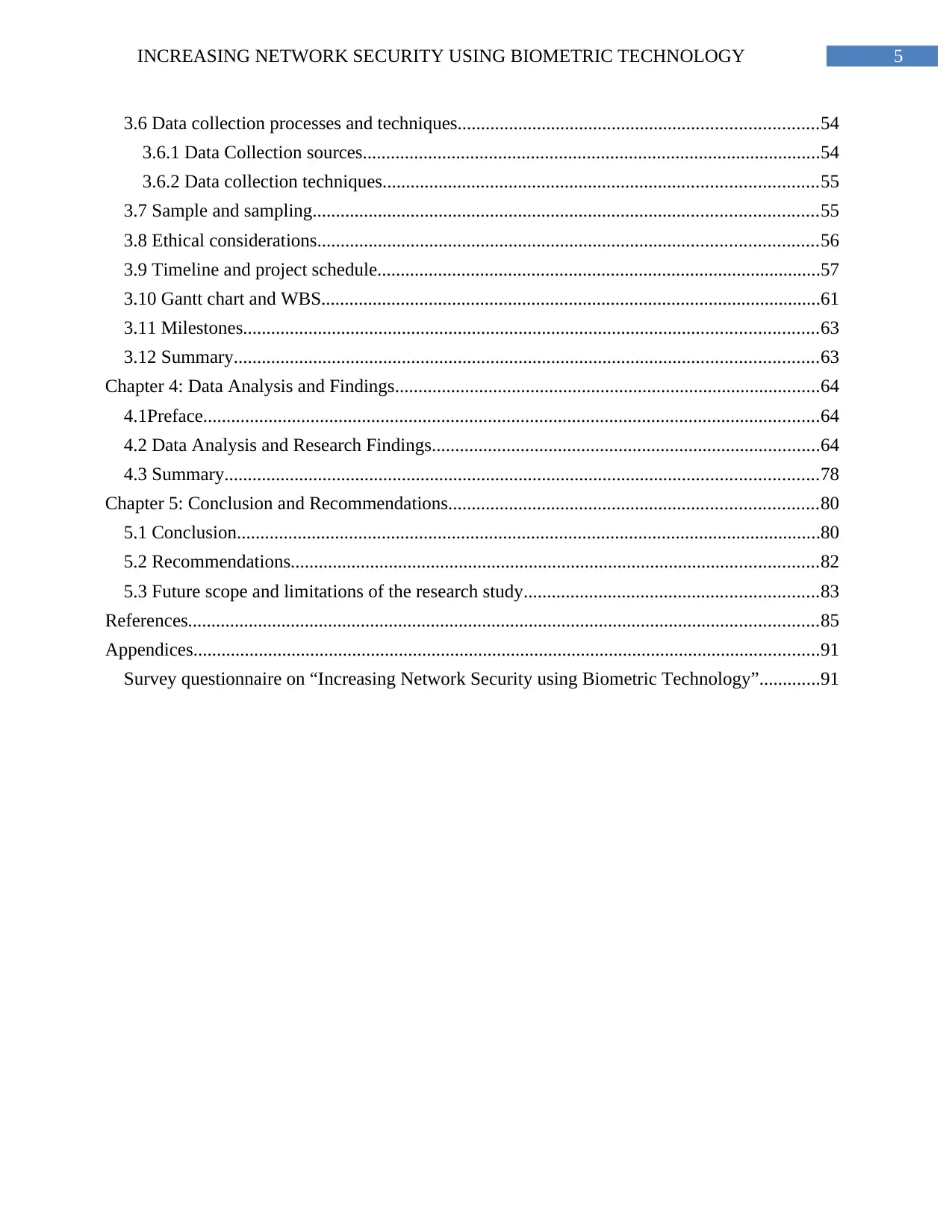
5INCREASING NETWORK SECURITY USING BIOMETRIC TECHNOLOGY
3.6 Data collection processes and techniques.............................................................................54
3.6.1 Data Collection sources..................................................................................................54
3.6.2 Data collection techniques.............................................................................................55
3.7 Sample and sampling............................................................................................................55
3.8 Ethical considerations...........................................................................................................56
3.9 Timeline and project schedule...............................................................................................57
3.10 Gantt chart and WBS...........................................................................................................61
3.11 Milestones...........................................................................................................................63
3.12 Summary.............................................................................................................................63
Chapter 4: Data Analysis and Findings...........................................................................................64
4.1Preface....................................................................................................................................64
4.2 Data Analysis and Research Findings...................................................................................64
4.3 Summary...............................................................................................................................78
Chapter 5: Conclusion and Recommendations...............................................................................80
5.1 Conclusion.............................................................................................................................80
5.2 Recommendations.................................................................................................................82
5.3 Future scope and limitations of the research study...............................................................83
References.......................................................................................................................................85
Appendices......................................................................................................................................91
Survey questionnaire on “Increasing Network Security using Biometric Technology”.............91
3.6 Data collection processes and techniques.............................................................................54
3.6.1 Data Collection sources..................................................................................................54
3.6.2 Data collection techniques.............................................................................................55
3.7 Sample and sampling............................................................................................................55
3.8 Ethical considerations...........................................................................................................56
3.9 Timeline and project schedule...............................................................................................57
3.10 Gantt chart and WBS...........................................................................................................61
3.11 Milestones...........................................................................................................................63
3.12 Summary.............................................................................................................................63
Chapter 4: Data Analysis and Findings...........................................................................................64
4.1Preface....................................................................................................................................64
4.2 Data Analysis and Research Findings...................................................................................64
4.3 Summary...............................................................................................................................78
Chapter 5: Conclusion and Recommendations...............................................................................80
5.1 Conclusion.............................................................................................................................80
5.2 Recommendations.................................................................................................................82
5.3 Future scope and limitations of the research study...............................................................83
References.......................................................................................................................................85
Appendices......................................................................................................................................91
Survey questionnaire on “Increasing Network Security using Biometric Technology”.............91
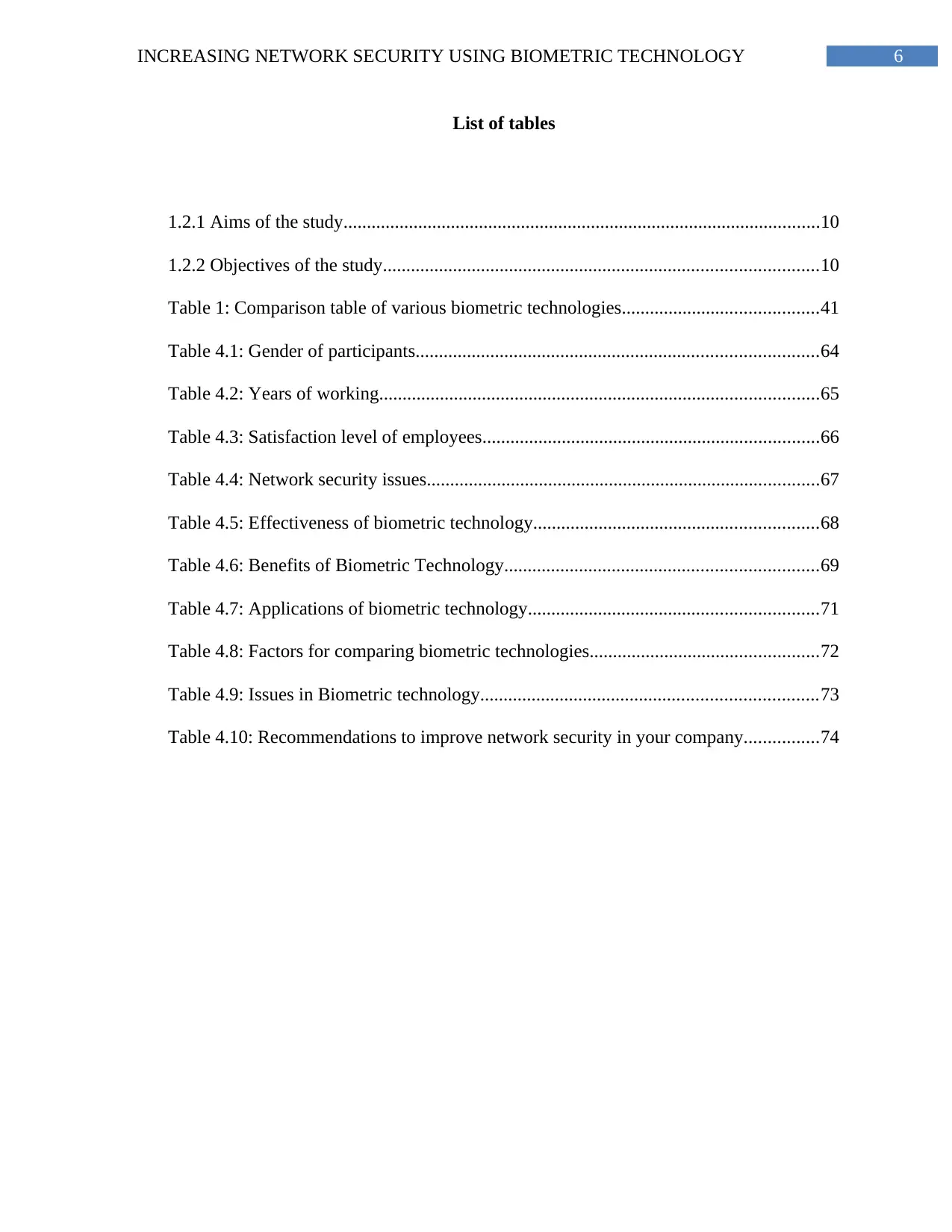
6INCREASING NETWORK SECURITY USING BIOMETRIC TECHNOLOGY
List of tables
1.2.1 Aims of the study......................................................................................................10
1.2.2 Objectives of the study.............................................................................................10
Table 1: Comparison table of various biometric technologies..........................................41
Table 4.1: Gender of participants......................................................................................64
Table 4.2: Years of working..............................................................................................65
Table 4.3: Satisfaction level of employees........................................................................66
Table 4.4: Network security issues....................................................................................67
Table 4.5: Effectiveness of biometric technology.............................................................68
Table 4.6: Benefits of Biometric Technology...................................................................69
Table 4.7: Applications of biometric technology..............................................................71
Table 4.8: Factors for comparing biometric technologies.................................................72
Table 4.9: Issues in Biometric technology........................................................................73
Table 4.10: Recommendations to improve network security in your company................74
List of tables
1.2.1 Aims of the study......................................................................................................10
1.2.2 Objectives of the study.............................................................................................10
Table 1: Comparison table of various biometric technologies..........................................41
Table 4.1: Gender of participants......................................................................................64
Table 4.2: Years of working..............................................................................................65
Table 4.3: Satisfaction level of employees........................................................................66
Table 4.4: Network security issues....................................................................................67
Table 4.5: Effectiveness of biometric technology.............................................................68
Table 4.6: Benefits of Biometric Technology...................................................................69
Table 4.7: Applications of biometric technology..............................................................71
Table 4.8: Factors for comparing biometric technologies.................................................72
Table 4.9: Issues in Biometric technology........................................................................73
Table 4.10: Recommendations to improve network security in your company................74
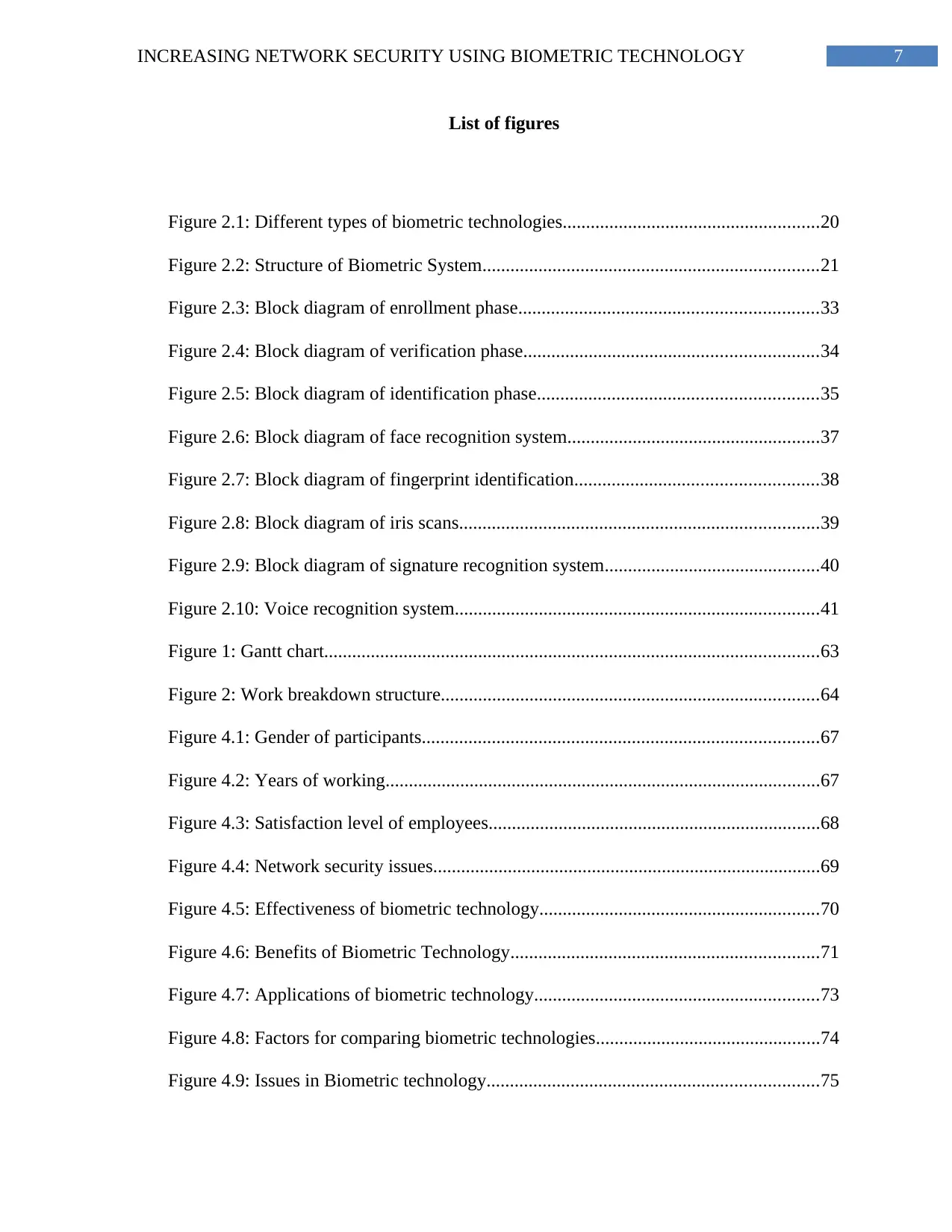
7INCREASING NETWORK SECURITY USING BIOMETRIC TECHNOLOGY
List of figures
Figure 2.1: Different types of biometric technologies.......................................................20
Figure 2.2: Structure of Biometric System........................................................................21
Figure 2.3: Block diagram of enrollment phase................................................................33
Figure 2.4: Block diagram of verification phase...............................................................34
Figure 2.5: Block diagram of identification phase............................................................35
Figure 2.6: Block diagram of face recognition system......................................................37
Figure 2.7: Block diagram of fingerprint identification....................................................38
Figure 2.8: Block diagram of iris scans.............................................................................39
Figure 2.9: Block diagram of signature recognition system..............................................40
Figure 2.10: Voice recognition system..............................................................................41
Figure 1: Gantt chart..........................................................................................................63
Figure 2: Work breakdown structure.................................................................................64
Figure 4.1: Gender of participants.....................................................................................67
Figure 4.2: Years of working.............................................................................................67
Figure 4.3: Satisfaction level of employees.......................................................................68
Figure 4.4: Network security issues...................................................................................69
Figure 4.5: Effectiveness of biometric technology............................................................70
Figure 4.6: Benefits of Biometric Technology..................................................................71
Figure 4.7: Applications of biometric technology.............................................................73
Figure 4.8: Factors for comparing biometric technologies................................................74
Figure 4.9: Issues in Biometric technology.......................................................................75
List of figures
Figure 2.1: Different types of biometric technologies.......................................................20
Figure 2.2: Structure of Biometric System........................................................................21
Figure 2.3: Block diagram of enrollment phase................................................................33
Figure 2.4: Block diagram of verification phase...............................................................34
Figure 2.5: Block diagram of identification phase............................................................35
Figure 2.6: Block diagram of face recognition system......................................................37
Figure 2.7: Block diagram of fingerprint identification....................................................38
Figure 2.8: Block diagram of iris scans.............................................................................39
Figure 2.9: Block diagram of signature recognition system..............................................40
Figure 2.10: Voice recognition system..............................................................................41
Figure 1: Gantt chart..........................................................................................................63
Figure 2: Work breakdown structure.................................................................................64
Figure 4.1: Gender of participants.....................................................................................67
Figure 4.2: Years of working.............................................................................................67
Figure 4.3: Satisfaction level of employees.......................................................................68
Figure 4.4: Network security issues...................................................................................69
Figure 4.5: Effectiveness of biometric technology............................................................70
Figure 4.6: Benefits of Biometric Technology..................................................................71
Figure 4.7: Applications of biometric technology.............................................................73
Figure 4.8: Factors for comparing biometric technologies................................................74
Figure 4.9: Issues in Biometric technology.......................................................................75
Paraphrase This Document
Need a fresh take? Get an instant paraphrase of this document with our AI Paraphraser
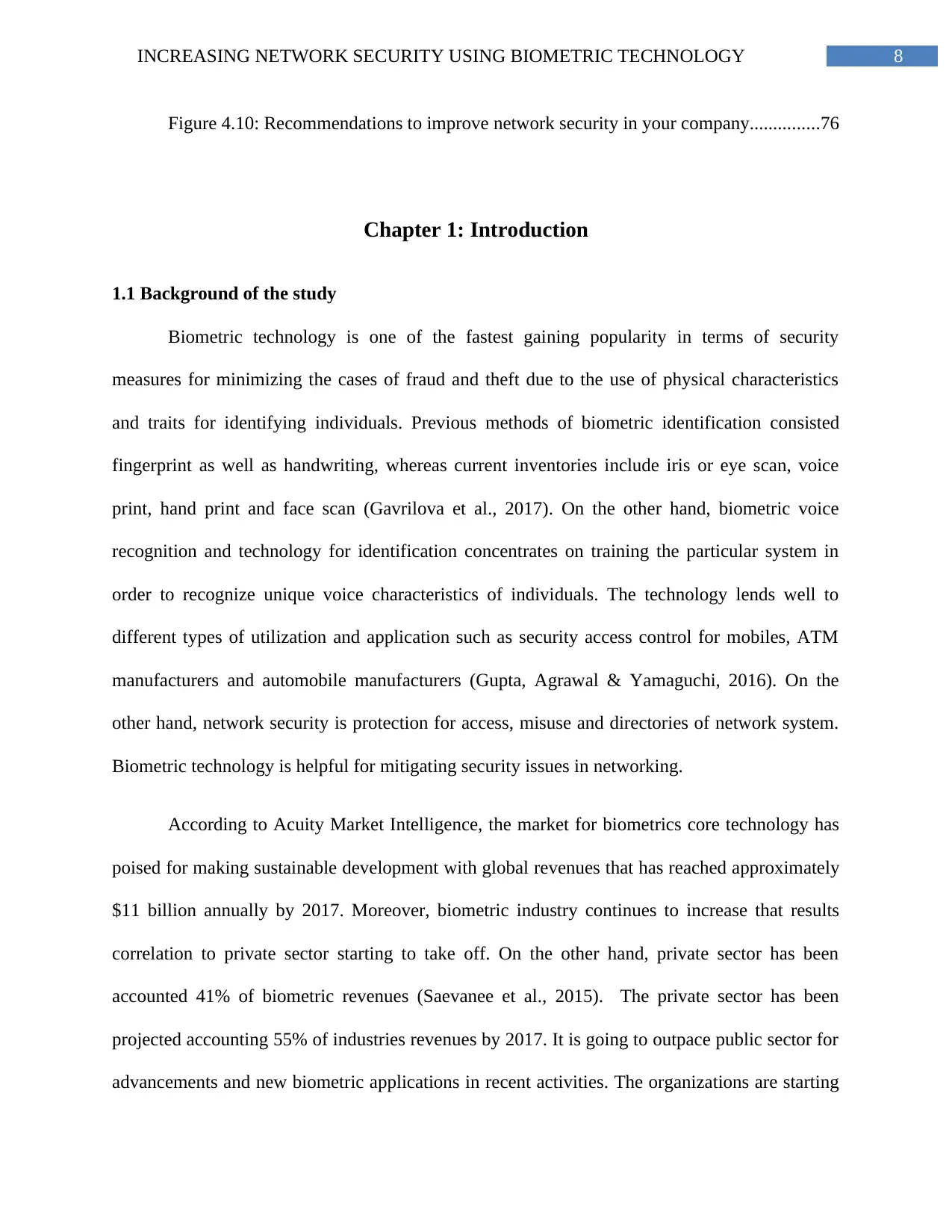
8INCREASING NETWORK SECURITY USING BIOMETRIC TECHNOLOGY
Figure 4.10: Recommendations to improve network security in your company...............76
Chapter 1: Introduction
1.1 Background of the study
Biometric technology is one of the fastest gaining popularity in terms of security
measures for minimizing the cases of fraud and theft due to the use of physical characteristics
and traits for identifying individuals. Previous methods of biometric identification consisted
fingerprint as well as handwriting, whereas current inventories include iris or eye scan, voice
print, hand print and face scan (Gavrilova et al., 2017). On the other hand, biometric voice
recognition and technology for identification concentrates on training the particular system in
order to recognize unique voice characteristics of individuals. The technology lends well to
different types of utilization and application such as security access control for mobiles, ATM
manufacturers and automobile manufacturers (Gupta, Agrawal & Yamaguchi, 2016). On the
other hand, network security is protection for access, misuse and directories of network system.
Biometric technology is helpful for mitigating security issues in networking.
According to Acuity Market Intelligence, the market for biometrics core technology has
poised for making sustainable development with global revenues that has reached approximately
$11 billion annually by 2017. Moreover, biometric industry continues to increase that results
correlation to private sector starting to take off. On the other hand, private sector has been
accounted 41% of biometric revenues (Saevanee et al., 2015). The private sector has been
projected accounting 55% of industries revenues by 2017. It is going to outpace public sector for
advancements and new biometric applications in recent activities. The organizations are starting
Figure 4.10: Recommendations to improve network security in your company...............76
Chapter 1: Introduction
1.1 Background of the study
Biometric technology is one of the fastest gaining popularity in terms of security
measures for minimizing the cases of fraud and theft due to the use of physical characteristics
and traits for identifying individuals. Previous methods of biometric identification consisted
fingerprint as well as handwriting, whereas current inventories include iris or eye scan, voice
print, hand print and face scan (Gavrilova et al., 2017). On the other hand, biometric voice
recognition and technology for identification concentrates on training the particular system in
order to recognize unique voice characteristics of individuals. The technology lends well to
different types of utilization and application such as security access control for mobiles, ATM
manufacturers and automobile manufacturers (Gupta, Agrawal & Yamaguchi, 2016). On the
other hand, network security is protection for access, misuse and directories of network system.
Biometric technology is helpful for mitigating security issues in networking.
According to Acuity Market Intelligence, the market for biometrics core technology has
poised for making sustainable development with global revenues that has reached approximately
$11 billion annually by 2017. Moreover, biometric industry continues to increase that results
correlation to private sector starting to take off. On the other hand, private sector has been
accounted 41% of biometric revenues (Saevanee et al., 2015). The private sector has been
projected accounting 55% of industries revenues by 2017. It is going to outpace public sector for
advancements and new biometric applications in recent activities. The organizations are starting
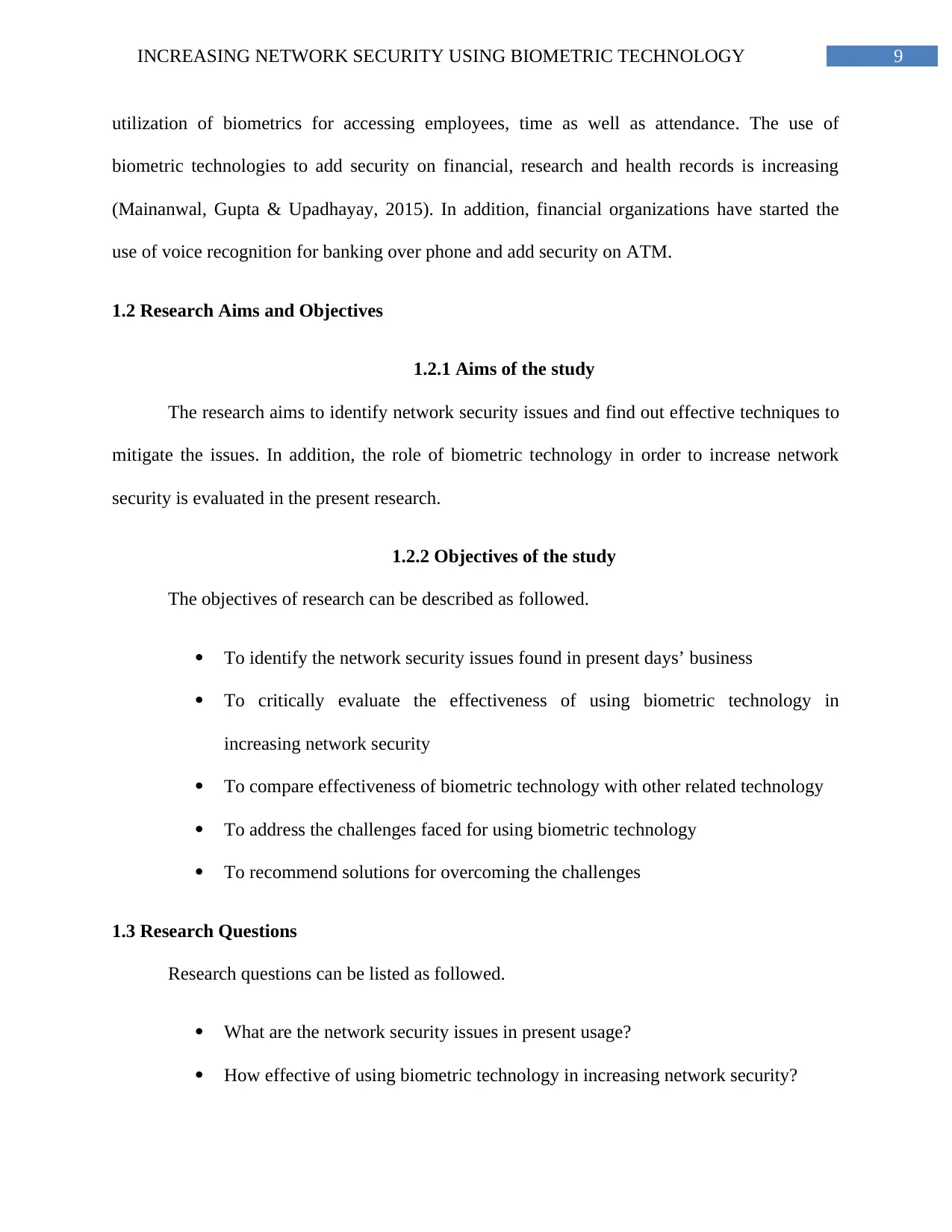
9INCREASING NETWORK SECURITY USING BIOMETRIC TECHNOLOGY
utilization of biometrics for accessing employees, time as well as attendance. The use of
biometric technologies to add security on financial, research and health records is increasing
(Mainanwal, Gupta & Upadhayay, 2015). In addition, financial organizations have started the
use of voice recognition for banking over phone and add security on ATM.
1.2 Research Aims and Objectives
1.2.1 Aims of the study
The research aims to identify network security issues and find out effective techniques to
mitigate the issues. In addition, the role of biometric technology in order to increase network
security is evaluated in the present research.
1.2.2 Objectives of the study
The objectives of research can be described as followed.
To identify the network security issues found in present days’ business
To critically evaluate the effectiveness of using biometric technology in
increasing network security
To compare effectiveness of biometric technology with other related technology
To address the challenges faced for using biometric technology
To recommend solutions for overcoming the challenges
1.3 Research Questions
Research questions can be listed as followed.
What are the network security issues in present usage?
How effective of using biometric technology in increasing network security?
utilization of biometrics for accessing employees, time as well as attendance. The use of
biometric technologies to add security on financial, research and health records is increasing
(Mainanwal, Gupta & Upadhayay, 2015). In addition, financial organizations have started the
use of voice recognition for banking over phone and add security on ATM.
1.2 Research Aims and Objectives
1.2.1 Aims of the study
The research aims to identify network security issues and find out effective techniques to
mitigate the issues. In addition, the role of biometric technology in order to increase network
security is evaluated in the present research.
1.2.2 Objectives of the study
The objectives of research can be described as followed.
To identify the network security issues found in present days’ business
To critically evaluate the effectiveness of using biometric technology in
increasing network security
To compare effectiveness of biometric technology with other related technology
To address the challenges faced for using biometric technology
To recommend solutions for overcoming the challenges
1.3 Research Questions
Research questions can be listed as followed.
What are the network security issues in present usage?
How effective of using biometric technology in increasing network security?
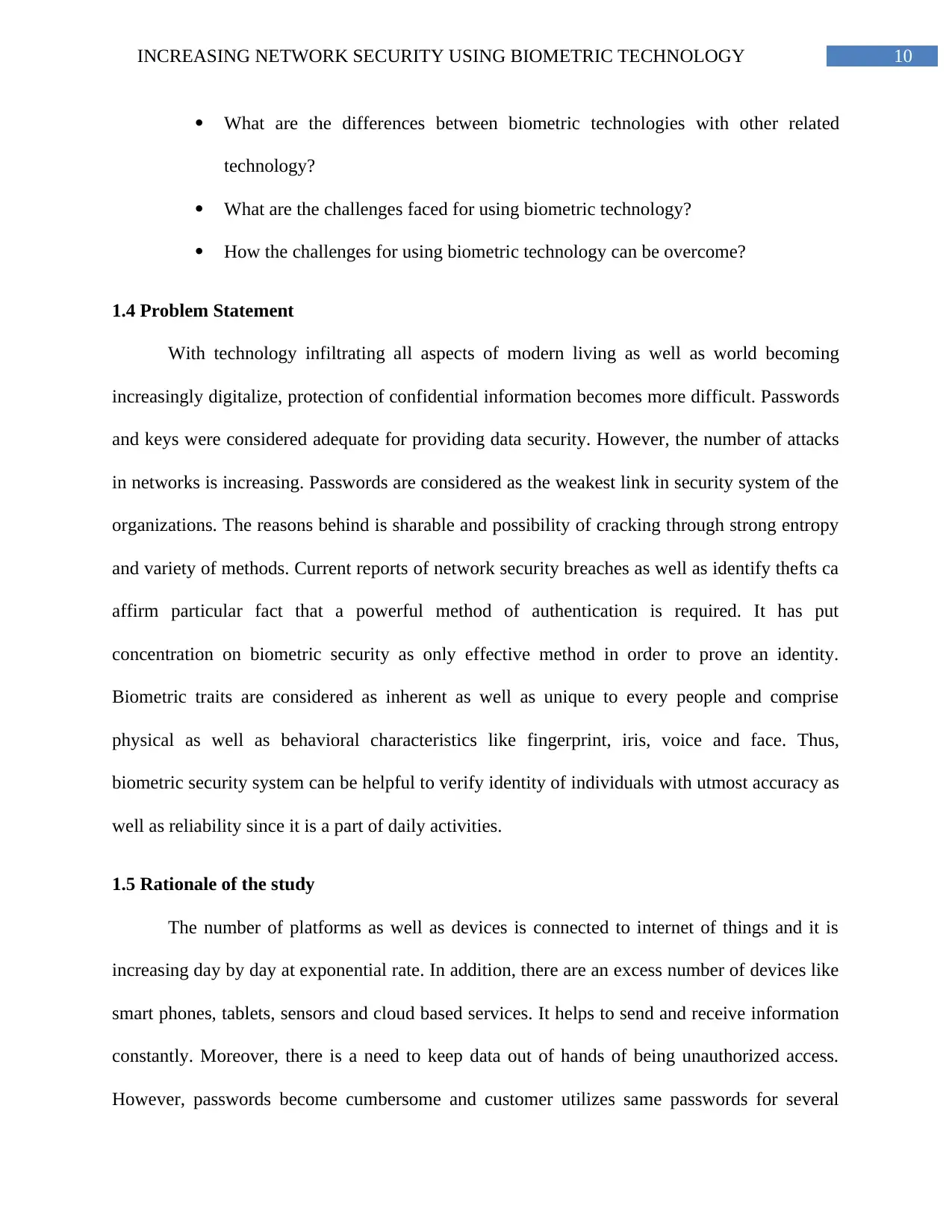
10INCREASING NETWORK SECURITY USING BIOMETRIC TECHNOLOGY
What are the differences between biometric technologies with other related
technology?
What are the challenges faced for using biometric technology?
How the challenges for using biometric technology can be overcome?
1.4 Problem Statement
With technology infiltrating all aspects of modern living as well as world becoming
increasingly digitalize, protection of confidential information becomes more difficult. Passwords
and keys were considered adequate for providing data security. However, the number of attacks
in networks is increasing. Passwords are considered as the weakest link in security system of the
organizations. The reasons behind is sharable and possibility of cracking through strong entropy
and variety of methods. Current reports of network security breaches as well as identify thefts ca
affirm particular fact that a powerful method of authentication is required. It has put
concentration on biometric security as only effective method in order to prove an identity.
Biometric traits are considered as inherent as well as unique to every people and comprise
physical as well as behavioral characteristics like fingerprint, iris, voice and face. Thus,
biometric security system can be helpful to verify identity of individuals with utmost accuracy as
well as reliability since it is a part of daily activities.
1.5 Rationale of the study
The number of platforms as well as devices is connected to internet of things and it is
increasing day by day at exponential rate. In addition, there are an excess number of devices like
smart phones, tablets, sensors and cloud based services. It helps to send and receive information
constantly. Moreover, there is a need to keep data out of hands of being unauthorized access.
However, passwords become cumbersome and customer utilizes same passwords for several
What are the differences between biometric technologies with other related
technology?
What are the challenges faced for using biometric technology?
How the challenges for using biometric technology can be overcome?
1.4 Problem Statement
With technology infiltrating all aspects of modern living as well as world becoming
increasingly digitalize, protection of confidential information becomes more difficult. Passwords
and keys were considered adequate for providing data security. However, the number of attacks
in networks is increasing. Passwords are considered as the weakest link in security system of the
organizations. The reasons behind is sharable and possibility of cracking through strong entropy
and variety of methods. Current reports of network security breaches as well as identify thefts ca
affirm particular fact that a powerful method of authentication is required. It has put
concentration on biometric security as only effective method in order to prove an identity.
Biometric traits are considered as inherent as well as unique to every people and comprise
physical as well as behavioral characteristics like fingerprint, iris, voice and face. Thus,
biometric security system can be helpful to verify identity of individuals with utmost accuracy as
well as reliability since it is a part of daily activities.
1.5 Rationale of the study
The number of platforms as well as devices is connected to internet of things and it is
increasing day by day at exponential rate. In addition, there are an excess number of devices like
smart phones, tablets, sensors and cloud based services. It helps to send and receive information
constantly. Moreover, there is a need to keep data out of hands of being unauthorized access.
However, passwords become cumbersome and customer utilizes same passwords for several
Secure Best Marks with AI Grader
Need help grading? Try our AI Grader for instant feedback on your assignments.
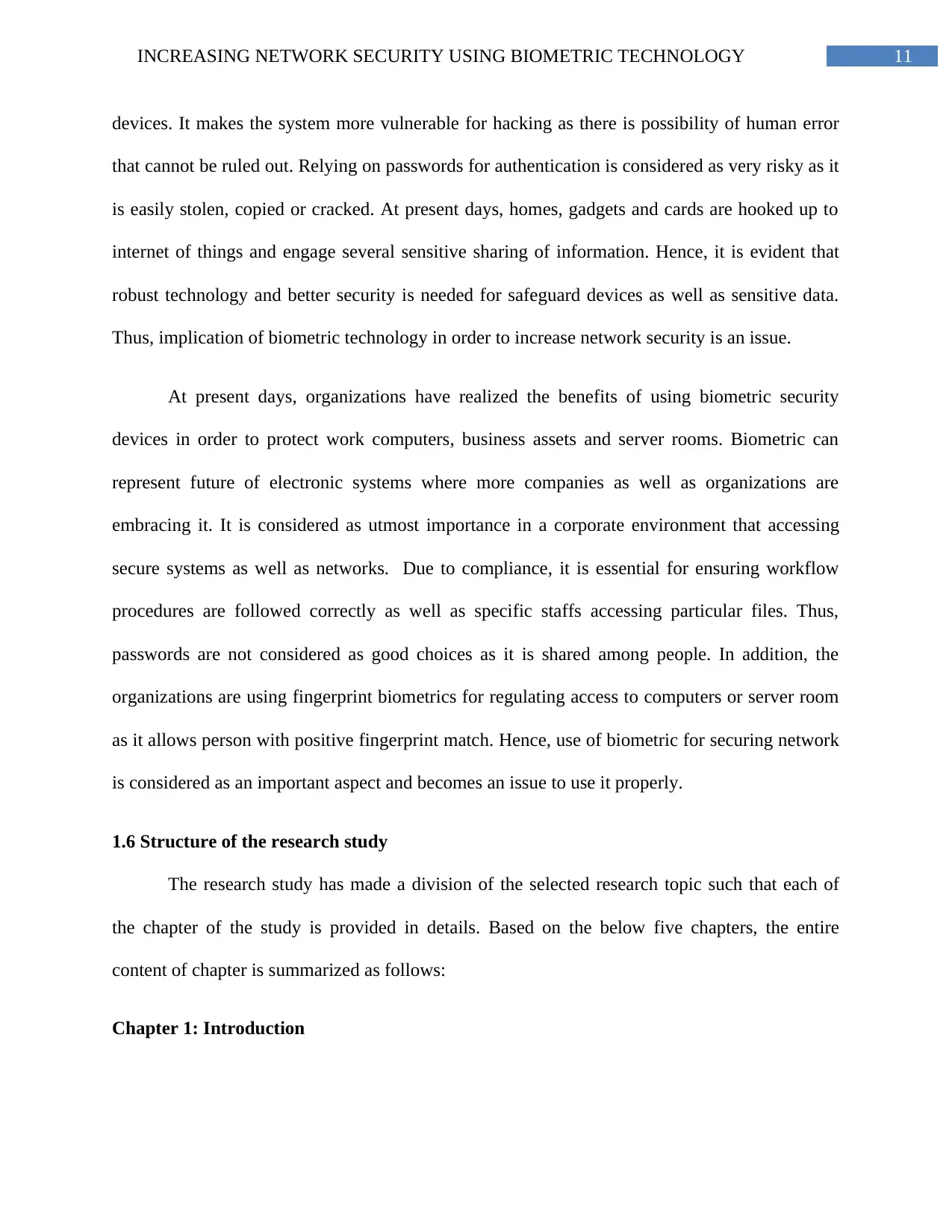
11INCREASING NETWORK SECURITY USING BIOMETRIC TECHNOLOGY
devices. It makes the system more vulnerable for hacking as there is possibility of human error
that cannot be ruled out. Relying on passwords for authentication is considered as very risky as it
is easily stolen, copied or cracked. At present days, homes, gadgets and cards are hooked up to
internet of things and engage several sensitive sharing of information. Hence, it is evident that
robust technology and better security is needed for safeguard devices as well as sensitive data.
Thus, implication of biometric technology in order to increase network security is an issue.
At present days, organizations have realized the benefits of using biometric security
devices in order to protect work computers, business assets and server rooms. Biometric can
represent future of electronic systems where more companies as well as organizations are
embracing it. It is considered as utmost importance in a corporate environment that accessing
secure systems as well as networks. Due to compliance, it is essential for ensuring workflow
procedures are followed correctly as well as specific staffs accessing particular files. Thus,
passwords are not considered as good choices as it is shared among people. In addition, the
organizations are using fingerprint biometrics for regulating access to computers or server room
as it allows person with positive fingerprint match. Hence, use of biometric for securing network
is considered as an important aspect and becomes an issue to use it properly.
1.6 Structure of the research study
The research study has made a division of the selected research topic such that each of
the chapter of the study is provided in details. Based on the below five chapters, the entire
content of chapter is summarized as follows:
Chapter 1: Introduction
devices. It makes the system more vulnerable for hacking as there is possibility of human error
that cannot be ruled out. Relying on passwords for authentication is considered as very risky as it
is easily stolen, copied or cracked. At present days, homes, gadgets and cards are hooked up to
internet of things and engage several sensitive sharing of information. Hence, it is evident that
robust technology and better security is needed for safeguard devices as well as sensitive data.
Thus, implication of biometric technology in order to increase network security is an issue.
At present days, organizations have realized the benefits of using biometric security
devices in order to protect work computers, business assets and server rooms. Biometric can
represent future of electronic systems where more companies as well as organizations are
embracing it. It is considered as utmost importance in a corporate environment that accessing
secure systems as well as networks. Due to compliance, it is essential for ensuring workflow
procedures are followed correctly as well as specific staffs accessing particular files. Thus,
passwords are not considered as good choices as it is shared among people. In addition, the
organizations are using fingerprint biometrics for regulating access to computers or server room
as it allows person with positive fingerprint match. Hence, use of biometric for securing network
is considered as an important aspect and becomes an issue to use it properly.
1.6 Structure of the research study
The research study has made a division of the selected research topic such that each of
the chapter of the study is provided in details. Based on the below five chapters, the entire
content of chapter is summarized as follows:
Chapter 1: Introduction
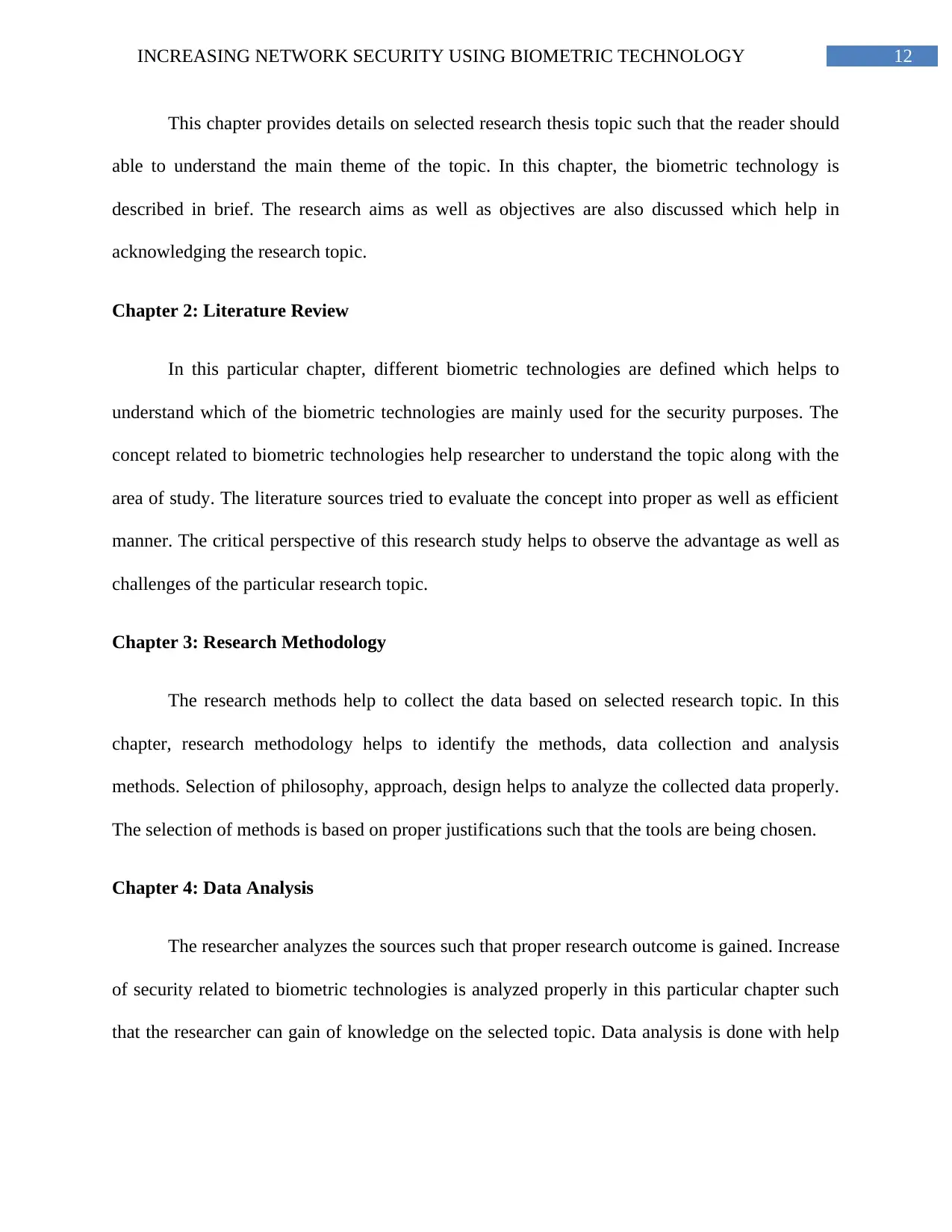
12INCREASING NETWORK SECURITY USING BIOMETRIC TECHNOLOGY
This chapter provides details on selected research thesis topic such that the reader should
able to understand the main theme of the topic. In this chapter, the biometric technology is
described in brief. The research aims as well as objectives are also discussed which help in
acknowledging the research topic.
Chapter 2: Literature Review
In this particular chapter, different biometric technologies are defined which helps to
understand which of the biometric technologies are mainly used for the security purposes. The
concept related to biometric technologies help researcher to understand the topic along with the
area of study. The literature sources tried to evaluate the concept into proper as well as efficient
manner. The critical perspective of this research study helps to observe the advantage as well as
challenges of the particular research topic.
Chapter 3: Research Methodology
The research methods help to collect the data based on selected research topic. In this
chapter, research methodology helps to identify the methods, data collection and analysis
methods. Selection of philosophy, approach, design helps to analyze the collected data properly.
The selection of methods is based on proper justifications such that the tools are being chosen.
Chapter 4: Data Analysis
The researcher analyzes the sources such that proper research outcome is gained. Increase
of security related to biometric technologies is analyzed properly in this particular chapter such
that the researcher can gain of knowledge on the selected topic. Data analysis is done with help
This chapter provides details on selected research thesis topic such that the reader should
able to understand the main theme of the topic. In this chapter, the biometric technology is
described in brief. The research aims as well as objectives are also discussed which help in
acknowledging the research topic.
Chapter 2: Literature Review
In this particular chapter, different biometric technologies are defined which helps to
understand which of the biometric technologies are mainly used for the security purposes. The
concept related to biometric technologies help researcher to understand the topic along with the
area of study. The literature sources tried to evaluate the concept into proper as well as efficient
manner. The critical perspective of this research study helps to observe the advantage as well as
challenges of the particular research topic.
Chapter 3: Research Methodology
The research methods help to collect the data based on selected research topic. In this
chapter, research methodology helps to identify the methods, data collection and analysis
methods. Selection of philosophy, approach, design helps to analyze the collected data properly.
The selection of methods is based on proper justifications such that the tools are being chosen.
Chapter 4: Data Analysis
The researcher analyzes the sources such that proper research outcome is gained. Increase
of security related to biometric technologies is analyzed properly in this particular chapter such
that the researcher can gain of knowledge on the selected topic. Data analysis is done with help

13INCREASING NETWORK SECURITY USING BIOMETRIC TECHNOLOGY
of different methods help in understanding the research topic better based on respondent’s
feedback.
of different methods help in understanding the research topic better based on respondent’s
feedback.
Paraphrase This Document
Need a fresh take? Get an instant paraphrase of this document with our AI Paraphraser
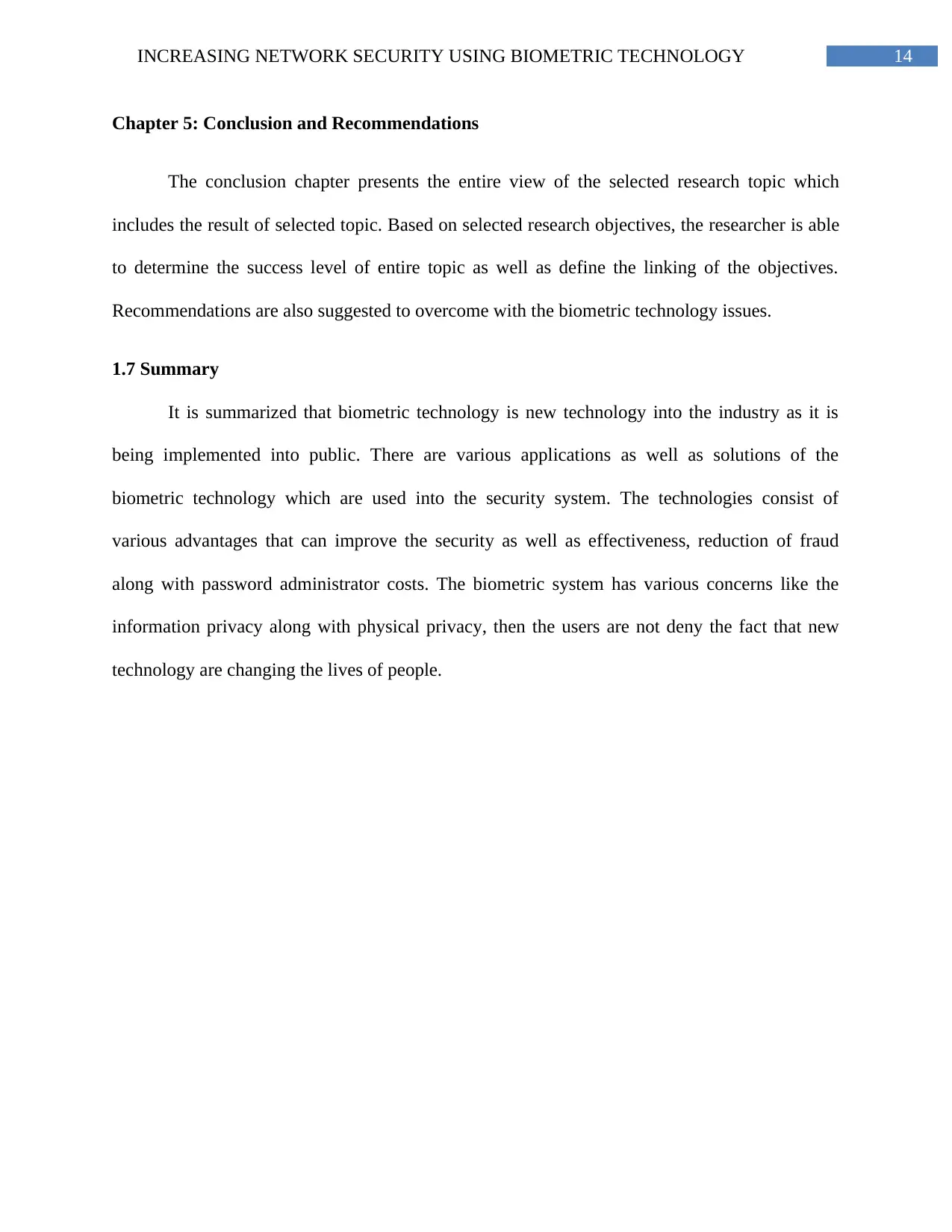
14INCREASING NETWORK SECURITY USING BIOMETRIC TECHNOLOGY
Chapter 5: Conclusion and Recommendations
The conclusion chapter presents the entire view of the selected research topic which
includes the result of selected topic. Based on selected research objectives, the researcher is able
to determine the success level of entire topic as well as define the linking of the objectives.
Recommendations are also suggested to overcome with the biometric technology issues.
1.7 Summary
It is summarized that biometric technology is new technology into the industry as it is
being implemented into public. There are various applications as well as solutions of the
biometric technology which are used into the security system. The technologies consist of
various advantages that can improve the security as well as effectiveness, reduction of fraud
along with password administrator costs. The biometric system has various concerns like the
information privacy along with physical privacy, then the users are not deny the fact that new
technology are changing the lives of people.
Chapter 5: Conclusion and Recommendations
The conclusion chapter presents the entire view of the selected research topic which
includes the result of selected topic. Based on selected research objectives, the researcher is able
to determine the success level of entire topic as well as define the linking of the objectives.
Recommendations are also suggested to overcome with the biometric technology issues.
1.7 Summary
It is summarized that biometric technology is new technology into the industry as it is
being implemented into public. There are various applications as well as solutions of the
biometric technology which are used into the security system. The technologies consist of
various advantages that can improve the security as well as effectiveness, reduction of fraud
along with password administrator costs. The biometric system has various concerns like the
information privacy along with physical privacy, then the users are not deny the fact that new
technology are changing the lives of people.
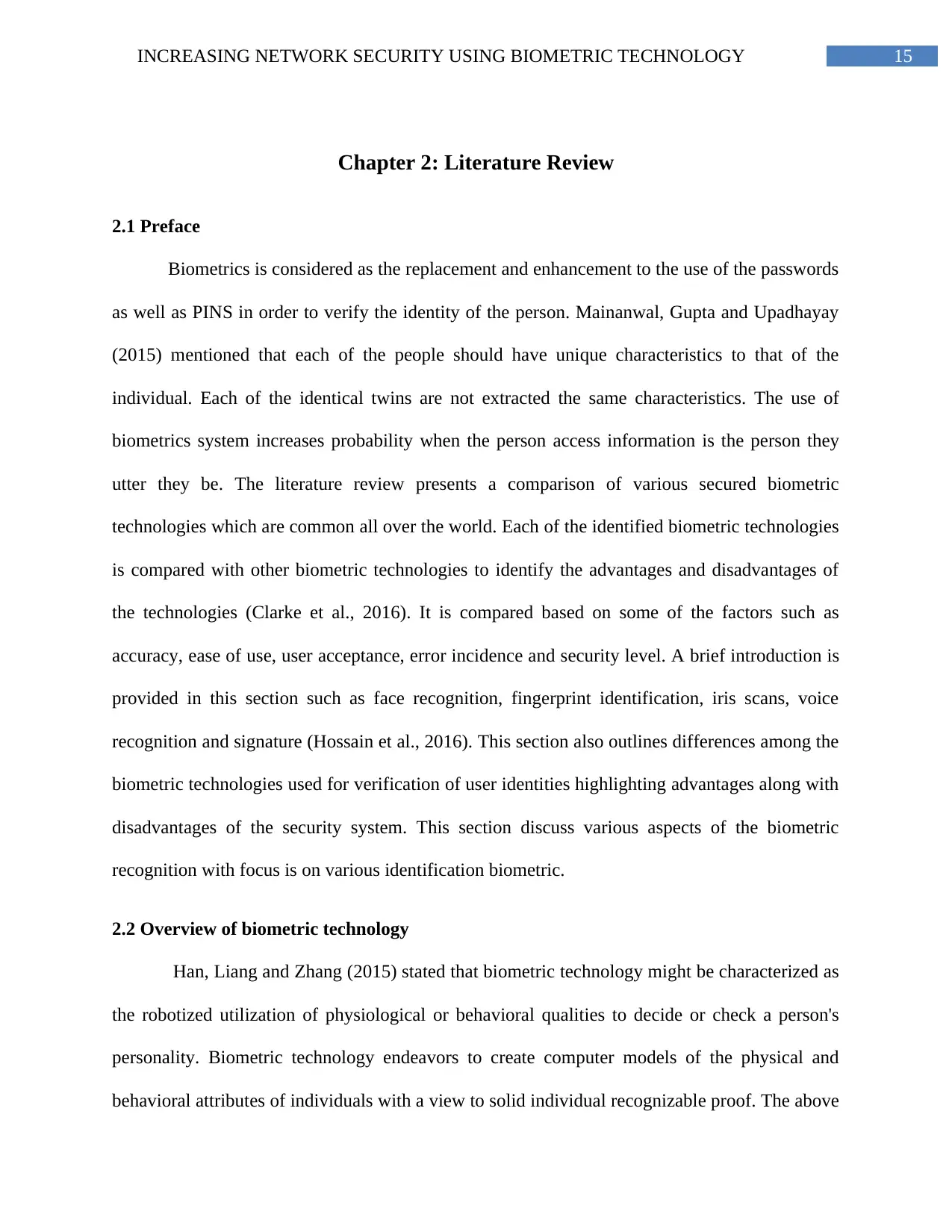
15INCREASING NETWORK SECURITY USING BIOMETRIC TECHNOLOGY
Chapter 2: Literature Review
2.1 Preface
Biometrics is considered as the replacement and enhancement to the use of the passwords
as well as PINS in order to verify the identity of the person. Mainanwal, Gupta and Upadhayay
(2015) mentioned that each of the people should have unique characteristics to that of the
individual. Each of the identical twins are not extracted the same characteristics. The use of
biometrics system increases probability when the person access information is the person they
utter they be. The literature review presents a comparison of various secured biometric
technologies which are common all over the world. Each of the identified biometric technologies
is compared with other biometric technologies to identify the advantages and disadvantages of
the technologies (Clarke et al., 2016). It is compared based on some of the factors such as
accuracy, ease of use, user acceptance, error incidence and security level. A brief introduction is
provided in this section such as face recognition, fingerprint identification, iris scans, voice
recognition and signature (Hossain et al., 2016). This section also outlines differences among the
biometric technologies used for verification of user identities highlighting advantages along with
disadvantages of the security system. This section discuss various aspects of the biometric
recognition with focus is on various identification biometric.
2.2 Overview of biometric technology
Han, Liang and Zhang (2015) stated that biometric technology might be characterized as
the robotized utilization of physiological or behavioral qualities to decide or check a person's
personality. Biometric technology endeavors to create computer models of the physical and
behavioral attributes of individuals with a view to solid individual recognizable proof. The above
Chapter 2: Literature Review
2.1 Preface
Biometrics is considered as the replacement and enhancement to the use of the passwords
as well as PINS in order to verify the identity of the person. Mainanwal, Gupta and Upadhayay
(2015) mentioned that each of the people should have unique characteristics to that of the
individual. Each of the identical twins are not extracted the same characteristics. The use of
biometrics system increases probability when the person access information is the person they
utter they be. The literature review presents a comparison of various secured biometric
technologies which are common all over the world. Each of the identified biometric technologies
is compared with other biometric technologies to identify the advantages and disadvantages of
the technologies (Clarke et al., 2016). It is compared based on some of the factors such as
accuracy, ease of use, user acceptance, error incidence and security level. A brief introduction is
provided in this section such as face recognition, fingerprint identification, iris scans, voice
recognition and signature (Hossain et al., 2016). This section also outlines differences among the
biometric technologies used for verification of user identities highlighting advantages along with
disadvantages of the security system. This section discuss various aspects of the biometric
recognition with focus is on various identification biometric.
2.2 Overview of biometric technology
Han, Liang and Zhang (2015) stated that biometric technology might be characterized as
the robotized utilization of physiological or behavioral qualities to decide or check a person's
personality. Biometric technology endeavors to create computer models of the physical and
behavioral attributes of individuals with a view to solid individual recognizable proof. The above
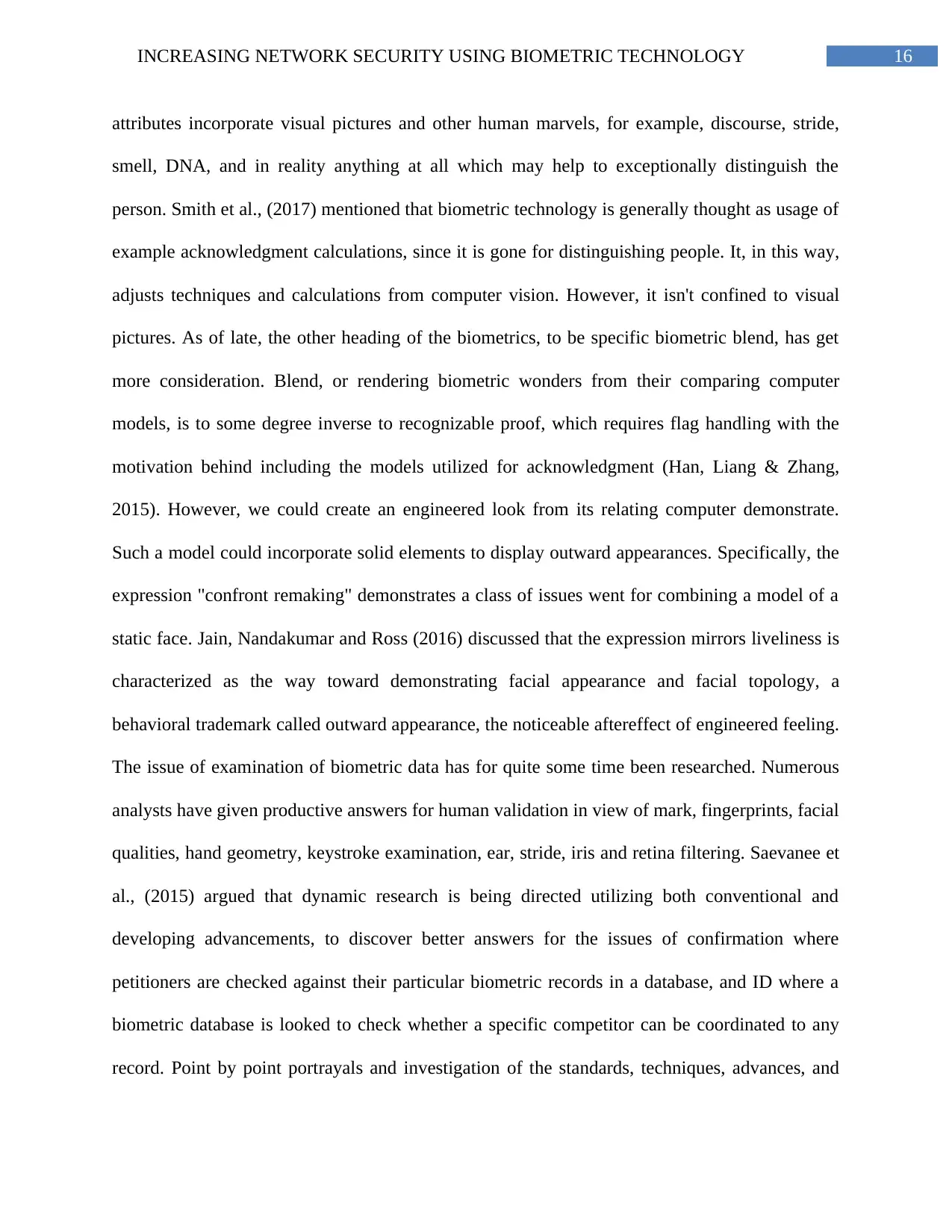
16INCREASING NETWORK SECURITY USING BIOMETRIC TECHNOLOGY
attributes incorporate visual pictures and other human marvels, for example, discourse, stride,
smell, DNA, and in reality anything at all which may help to exceptionally distinguish the
person. Smith et al., (2017) mentioned that biometric technology is generally thought as usage of
example acknowledgment calculations, since it is gone for distinguishing people. It, in this way,
adjusts techniques and calculations from computer vision. However, it isn't confined to visual
pictures. As of late, the other heading of the biometrics, to be specific biometric blend, has get
more consideration. Blend, or rendering biometric wonders from their comparing computer
models, is to some degree inverse to recognizable proof, which requires flag handling with the
motivation behind including the models utilized for acknowledgment (Han, Liang & Zhang,
2015). However, we could create an engineered look from its relating computer demonstrate.
Such a model could incorporate solid elements to display outward appearances. Specifically, the
expression "confront remaking" demonstrates a class of issues went for combining a model of a
static face. Jain, Nandakumar and Ross (2016) discussed that the expression mirrors liveliness is
characterized as the way toward demonstrating facial appearance and facial topology, a
behavioral trademark called outward appearance, the noticeable aftereffect of engineered feeling.
The issue of examination of biometric data has for quite some time been researched. Numerous
analysts have given productive answers for human validation in view of mark, fingerprints, facial
qualities, hand geometry, keystroke examination, ear, stride, iris and retina filtering. Saevanee et
al., (2015) argued that dynamic research is being directed utilizing both conventional and
developing advancements, to discover better answers for the issues of confirmation where
petitioners are checked against their particular biometric records in a database, and ID where a
biometric database is looked to check whether a specific competitor can be coordinated to any
record. Point by point portrayals and investigation of the standards, techniques, advances, and
attributes incorporate visual pictures and other human marvels, for example, discourse, stride,
smell, DNA, and in reality anything at all which may help to exceptionally distinguish the
person. Smith et al., (2017) mentioned that biometric technology is generally thought as usage of
example acknowledgment calculations, since it is gone for distinguishing people. It, in this way,
adjusts techniques and calculations from computer vision. However, it isn't confined to visual
pictures. As of late, the other heading of the biometrics, to be specific biometric blend, has get
more consideration. Blend, or rendering biometric wonders from their comparing computer
models, is to some degree inverse to recognizable proof, which requires flag handling with the
motivation behind including the models utilized for acknowledgment (Han, Liang & Zhang,
2015). However, we could create an engineered look from its relating computer demonstrate.
Such a model could incorporate solid elements to display outward appearances. Specifically, the
expression "confront remaking" demonstrates a class of issues went for combining a model of a
static face. Jain, Nandakumar and Ross (2016) discussed that the expression mirrors liveliness is
characterized as the way toward demonstrating facial appearance and facial topology, a
behavioral trademark called outward appearance, the noticeable aftereffect of engineered feeling.
The issue of examination of biometric data has for quite some time been researched. Numerous
analysts have given productive answers for human validation in view of mark, fingerprints, facial
qualities, hand geometry, keystroke examination, ear, stride, iris and retina filtering. Saevanee et
al., (2015) argued that dynamic research is being directed utilizing both conventional and
developing advancements, to discover better answers for the issues of confirmation where
petitioners are checked against their particular biometric records in a database, and ID where a
biometric database is looked to check whether a specific competitor can be coordinated to any
record. Point by point portrayals and investigation of the standards, techniques, advances, and
Secure Best Marks with AI Grader
Need help grading? Try our AI Grader for instant feedback on your assignments.
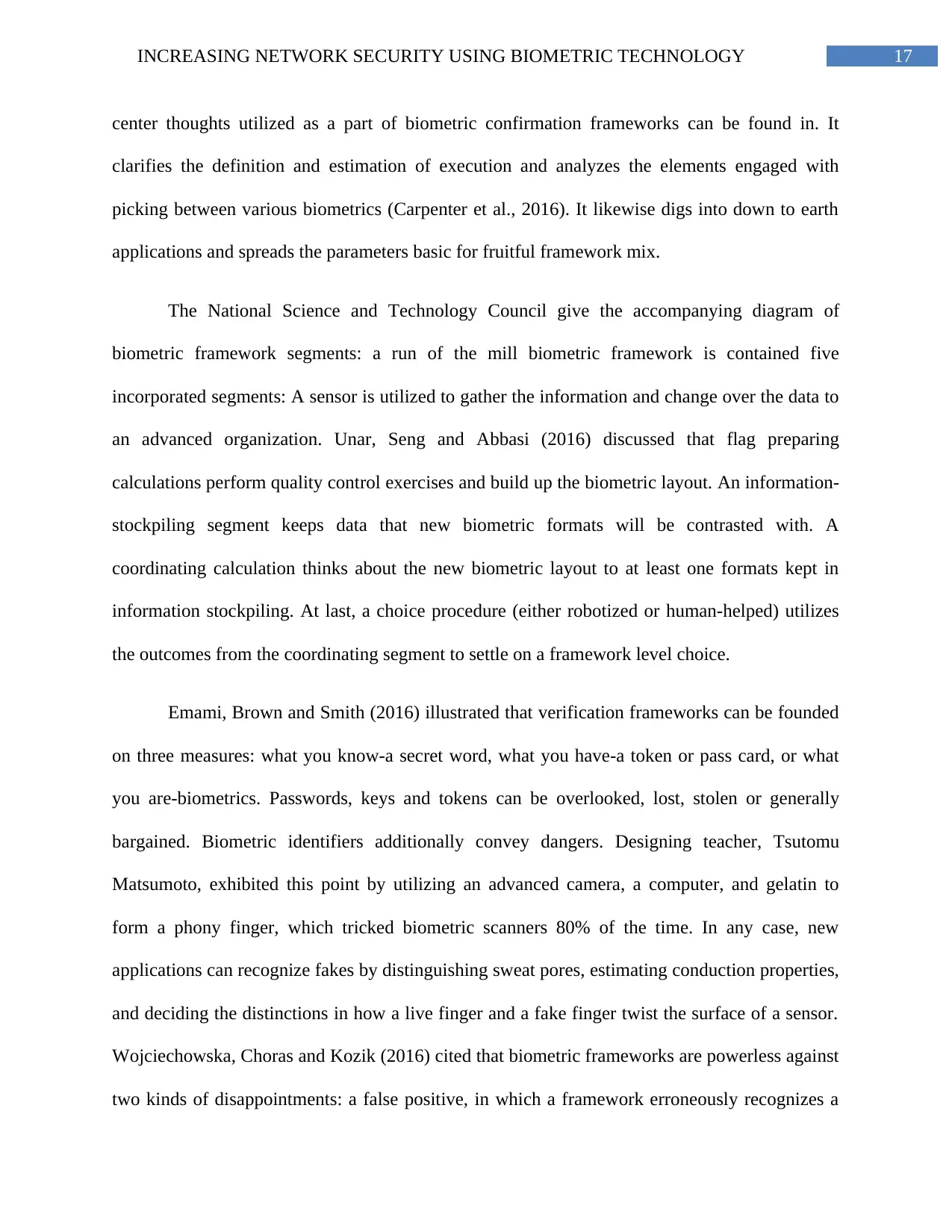
17INCREASING NETWORK SECURITY USING BIOMETRIC TECHNOLOGY
center thoughts utilized as a part of biometric confirmation frameworks can be found in. It
clarifies the definition and estimation of execution and analyzes the elements engaged with
picking between various biometrics (Carpenter et al., 2016). It likewise digs into down to earth
applications and spreads the parameters basic for fruitful framework mix.
The National Science and Technology Council give the accompanying diagram of
biometric framework segments: a run of the mill biometric framework is contained five
incorporated segments: A sensor is utilized to gather the information and change over the data to
an advanced organization. Unar, Seng and Abbasi (2016) discussed that flag preparing
calculations perform quality control exercises and build up the biometric layout. An information-
stockpiling segment keeps data that new biometric formats will be contrasted with. A
coordinating calculation thinks about the new biometric layout to at least one formats kept in
information stockpiling. At last, a choice procedure (either robotized or human-helped) utilizes
the outcomes from the coordinating segment to settle on a framework level choice.
Emami, Brown and Smith (2016) illustrated that verification frameworks can be founded
on three measures: what you know-a secret word, what you have-a token or pass card, or what
you are-biometrics. Passwords, keys and tokens can be overlooked, lost, stolen or generally
bargained. Biometric identifiers additionally convey dangers. Designing teacher, Tsutomu
Matsumoto, exhibited this point by utilizing an advanced camera, a computer, and gelatin to
form a phony finger, which tricked biometric scanners 80% of the time. In any case, new
applications can recognize fakes by distinguishing sweat pores, estimating conduction properties,
and deciding the distinctions in how a live finger and a fake finger twist the surface of a sensor.
Wojciechowska, Choras and Kozik (2016) cited that biometric frameworks are powerless against
two kinds of disappointments: a false positive, in which a framework erroneously recognizes a
center thoughts utilized as a part of biometric confirmation frameworks can be found in. It
clarifies the definition and estimation of execution and analyzes the elements engaged with
picking between various biometrics (Carpenter et al., 2016). It likewise digs into down to earth
applications and spreads the parameters basic for fruitful framework mix.
The National Science and Technology Council give the accompanying diagram of
biometric framework segments: a run of the mill biometric framework is contained five
incorporated segments: A sensor is utilized to gather the information and change over the data to
an advanced organization. Unar, Seng and Abbasi (2016) discussed that flag preparing
calculations perform quality control exercises and build up the biometric layout. An information-
stockpiling segment keeps data that new biometric formats will be contrasted with. A
coordinating calculation thinks about the new biometric layout to at least one formats kept in
information stockpiling. At last, a choice procedure (either robotized or human-helped) utilizes
the outcomes from the coordinating segment to settle on a framework level choice.
Emami, Brown and Smith (2016) illustrated that verification frameworks can be founded
on three measures: what you know-a secret word, what you have-a token or pass card, or what
you are-biometrics. Passwords, keys and tokens can be overlooked, lost, stolen or generally
bargained. Biometric identifiers additionally convey dangers. Designing teacher, Tsutomu
Matsumoto, exhibited this point by utilizing an advanced camera, a computer, and gelatin to
form a phony finger, which tricked biometric scanners 80% of the time. In any case, new
applications can recognize fakes by distinguishing sweat pores, estimating conduction properties,
and deciding the distinctions in how a live finger and a fake finger twist the surface of a sensor.
Wojciechowska, Choras and Kozik (2016) cited that biometric frameworks are powerless against
two kinds of disappointments: a false positive, in which a framework erroneously recognizes a
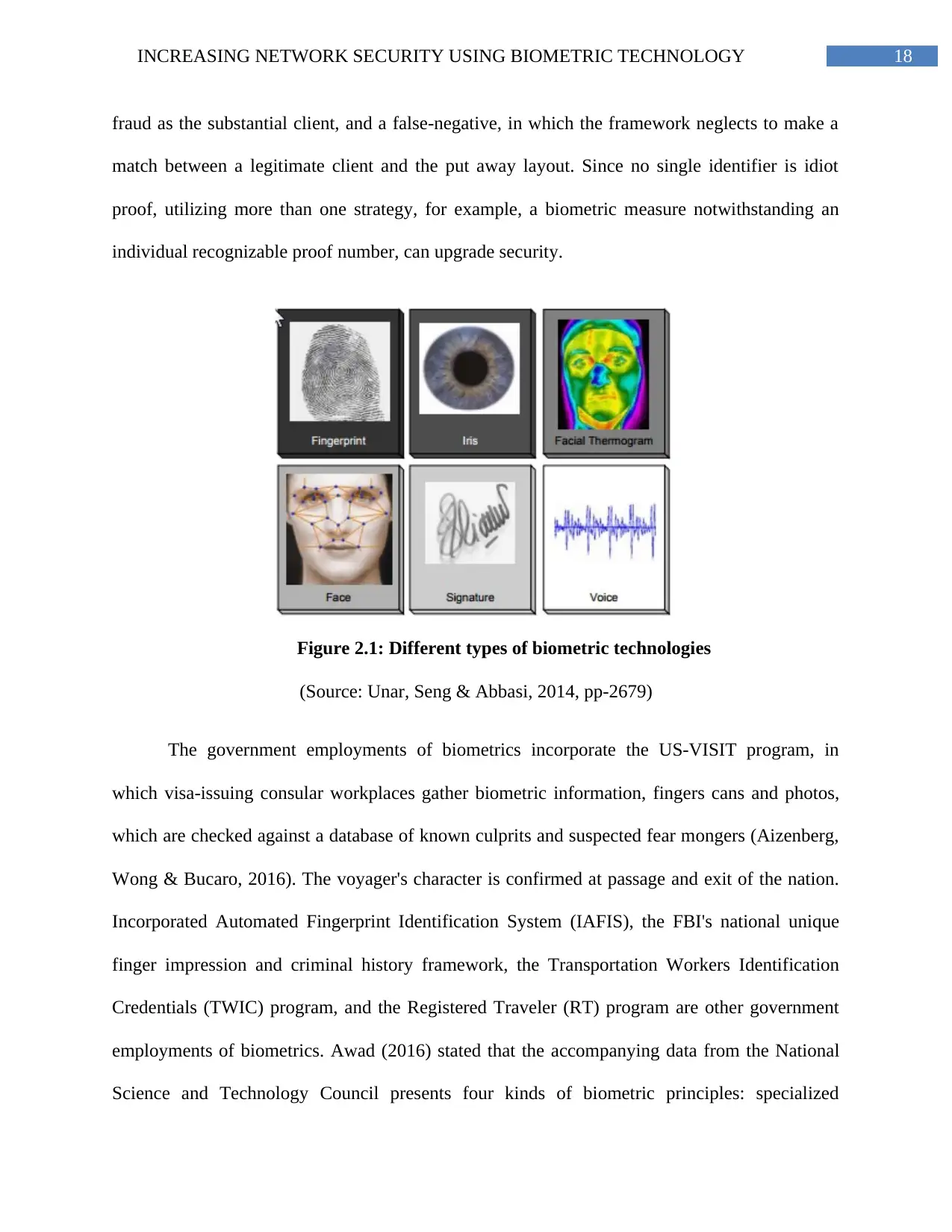
18INCREASING NETWORK SECURITY USING BIOMETRIC TECHNOLOGY
fraud as the substantial client, and a false-negative, in which the framework neglects to make a
match between a legitimate client and the put away layout. Since no single identifier is idiot
proof, utilizing more than one strategy, for example, a biometric measure notwithstanding an
individual recognizable proof number, can upgrade security.
Figure 2.1: Different types of biometric technologies
(Source: Unar, Seng & Abbasi, 2014, pp-2679)
The government employments of biometrics incorporate the US-VISIT program, in
which visa-issuing consular workplaces gather biometric information, fingers cans and photos,
which are checked against a database of known culprits and suspected fear mongers (Aizenberg,
Wong & Bucaro, 2016). The voyager's character is confirmed at passage and exit of the nation.
Incorporated Automated Fingerprint Identification System (IAFIS), the FBI's national unique
finger impression and criminal history framework, the Transportation Workers Identification
Credentials (TWIC) program, and the Registered Traveler (RT) program are other government
employments of biometrics. Awad (2016) stated that the accompanying data from the National
Science and Technology Council presents four kinds of biometric principles: specialized
fraud as the substantial client, and a false-negative, in which the framework neglects to make a
match between a legitimate client and the put away layout. Since no single identifier is idiot
proof, utilizing more than one strategy, for example, a biometric measure notwithstanding an
individual recognizable proof number, can upgrade security.
Figure 2.1: Different types of biometric technologies
(Source: Unar, Seng & Abbasi, 2014, pp-2679)
The government employments of biometrics incorporate the US-VISIT program, in
which visa-issuing consular workplaces gather biometric information, fingers cans and photos,
which are checked against a database of known culprits and suspected fear mongers (Aizenberg,
Wong & Bucaro, 2016). The voyager's character is confirmed at passage and exit of the nation.
Incorporated Automated Fingerprint Identification System (IAFIS), the FBI's national unique
finger impression and criminal history framework, the Transportation Workers Identification
Credentials (TWIC) program, and the Registered Traveler (RT) program are other government
employments of biometrics. Awad (2016) stated that the accompanying data from the National
Science and Technology Council presents four kinds of biometric principles: specialized
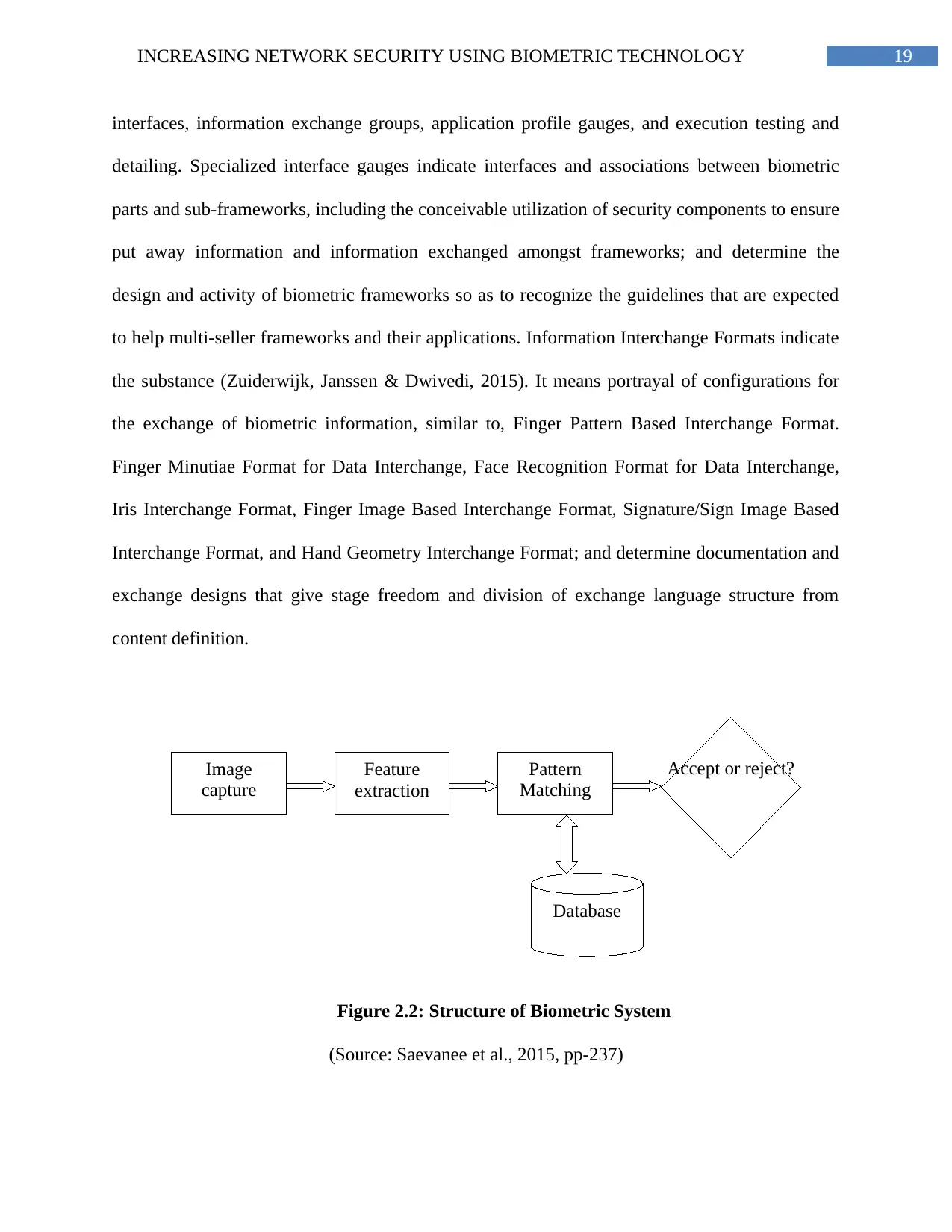
19INCREASING NETWORK SECURITY USING BIOMETRIC TECHNOLOGY
Image
capture
Feature
extraction
Pattern
Matching
Accept or reject?
Database
interfaces, information exchange groups, application profile gauges, and execution testing and
detailing. Specialized interface gauges indicate interfaces and associations between biometric
parts and sub-frameworks, including the conceivable utilization of security components to ensure
put away information and information exchanged amongst frameworks; and determine the
design and activity of biometric frameworks so as to recognize the guidelines that are expected
to help multi-seller frameworks and their applications. Information Interchange Formats indicate
the substance (Zuiderwijk, Janssen & Dwivedi, 2015). It means portrayal of configurations for
the exchange of biometric information, similar to, Finger Pattern Based Interchange Format.
Finger Minutiae Format for Data Interchange, Face Recognition Format for Data Interchange,
Iris Interchange Format, Finger Image Based Interchange Format, Signature/Sign Image Based
Interchange Format, and Hand Geometry Interchange Format; and determine documentation and
exchange designs that give stage freedom and division of exchange language structure from
content definition.
Figure 2.2: Structure of Biometric System
(Source: Saevanee et al., 2015, pp-237)
Image
capture
Feature
extraction
Pattern
Matching
Accept or reject?
Database
interfaces, information exchange groups, application profile gauges, and execution testing and
detailing. Specialized interface gauges indicate interfaces and associations between biometric
parts and sub-frameworks, including the conceivable utilization of security components to ensure
put away information and information exchanged amongst frameworks; and determine the
design and activity of biometric frameworks so as to recognize the guidelines that are expected
to help multi-seller frameworks and their applications. Information Interchange Formats indicate
the substance (Zuiderwijk, Janssen & Dwivedi, 2015). It means portrayal of configurations for
the exchange of biometric information, similar to, Finger Pattern Based Interchange Format.
Finger Minutiae Format for Data Interchange, Face Recognition Format for Data Interchange,
Iris Interchange Format, Finger Image Based Interchange Format, Signature/Sign Image Based
Interchange Format, and Hand Geometry Interchange Format; and determine documentation and
exchange designs that give stage freedom and division of exchange language structure from
content definition.
Figure 2.2: Structure of Biometric System
(Source: Saevanee et al., 2015, pp-237)
Paraphrase This Document
Need a fresh take? Get an instant paraphrase of this document with our AI Paraphraser
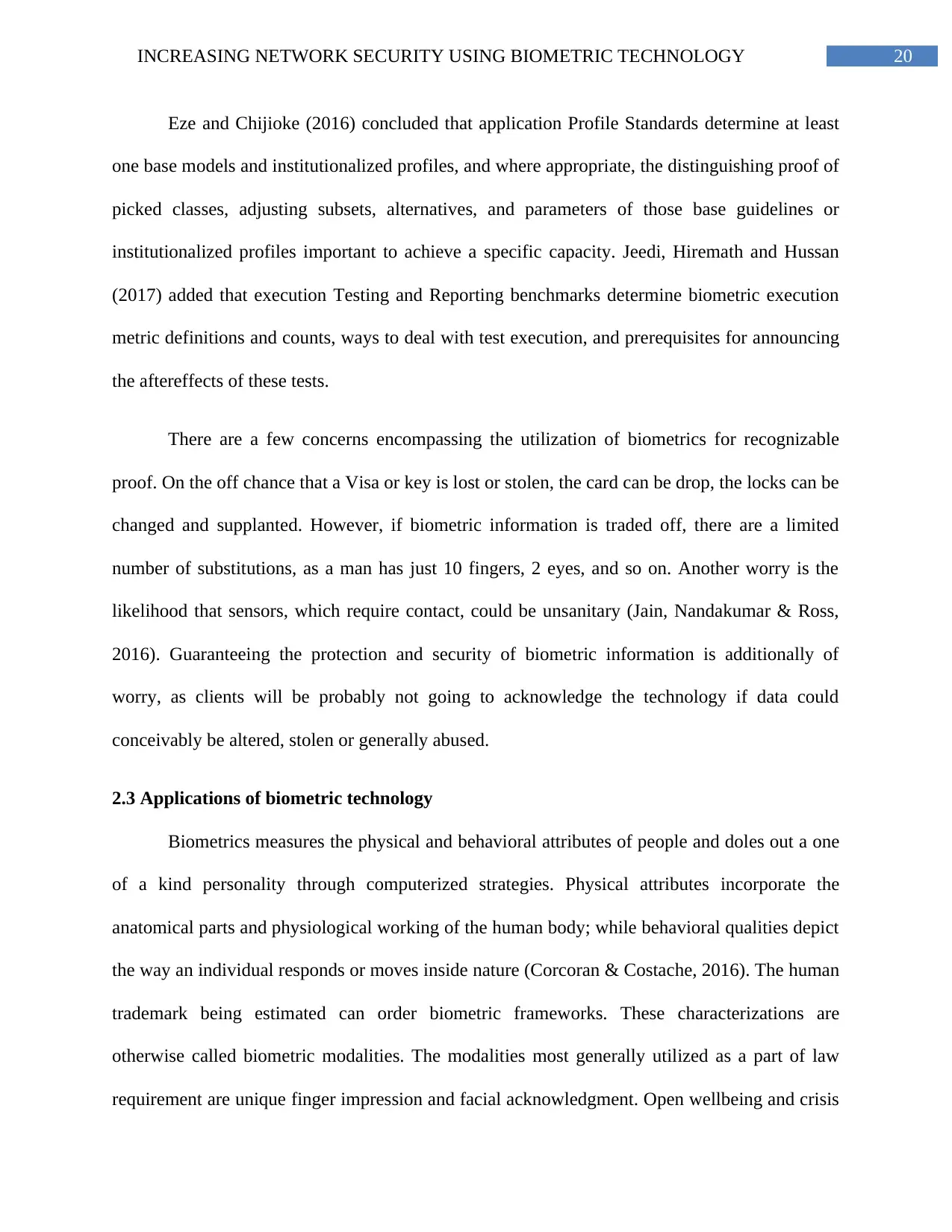
20INCREASING NETWORK SECURITY USING BIOMETRIC TECHNOLOGY
Eze and Chijioke (2016) concluded that application Profile Standards determine at least
one base models and institutionalized profiles, and where appropriate, the distinguishing proof of
picked classes, adjusting subsets, alternatives, and parameters of those base guidelines or
institutionalized profiles important to achieve a specific capacity. Jeedi, Hiremath and Hussan
(2017) added that execution Testing and Reporting benchmarks determine biometric execution
metric definitions and counts, ways to deal with test execution, and prerequisites for announcing
the aftereffects of these tests.
There are a few concerns encompassing the utilization of biometrics for recognizable
proof. On the off chance that a Visa or key is lost or stolen, the card can be drop, the locks can be
changed and supplanted. However, if biometric information is traded off, there are a limited
number of substitutions, as a man has just 10 fingers, 2 eyes, and so on. Another worry is the
likelihood that sensors, which require contact, could be unsanitary (Jain, Nandakumar & Ross,
2016). Guaranteeing the protection and security of biometric information is additionally of
worry, as clients will be probably not going to acknowledge the technology if data could
conceivably be altered, stolen or generally abused.
2.3 Applications of biometric technology
Biometrics measures the physical and behavioral attributes of people and doles out a one
of a kind personality through computerized strategies. Physical attributes incorporate the
anatomical parts and physiological working of the human body; while behavioral qualities depict
the way an individual responds or moves inside nature (Corcoran & Costache, 2016). The human
trademark being estimated can order biometric frameworks. These characterizations are
otherwise called biometric modalities. The modalities most generally utilized as a part of law
requirement are unique finger impression and facial acknowledgment. Open wellbeing and crisis
Eze and Chijioke (2016) concluded that application Profile Standards determine at least
one base models and institutionalized profiles, and where appropriate, the distinguishing proof of
picked classes, adjusting subsets, alternatives, and parameters of those base guidelines or
institutionalized profiles important to achieve a specific capacity. Jeedi, Hiremath and Hussan
(2017) added that execution Testing and Reporting benchmarks determine biometric execution
metric definitions and counts, ways to deal with test execution, and prerequisites for announcing
the aftereffects of these tests.
There are a few concerns encompassing the utilization of biometrics for recognizable
proof. On the off chance that a Visa or key is lost or stolen, the card can be drop, the locks can be
changed and supplanted. However, if biometric information is traded off, there are a limited
number of substitutions, as a man has just 10 fingers, 2 eyes, and so on. Another worry is the
likelihood that sensors, which require contact, could be unsanitary (Jain, Nandakumar & Ross,
2016). Guaranteeing the protection and security of biometric information is additionally of
worry, as clients will be probably not going to acknowledge the technology if data could
conceivably be altered, stolen or generally abused.
2.3 Applications of biometric technology
Biometrics measures the physical and behavioral attributes of people and doles out a one
of a kind personality through computerized strategies. Physical attributes incorporate the
anatomical parts and physiological working of the human body; while behavioral qualities depict
the way an individual responds or moves inside nature (Corcoran & Costache, 2016). The human
trademark being estimated can order biometric frameworks. These characterizations are
otherwise called biometric modalities. The modalities most generally utilized as a part of law
requirement are unique finger impression and facial acknowledgment. Open wellbeing and crisis
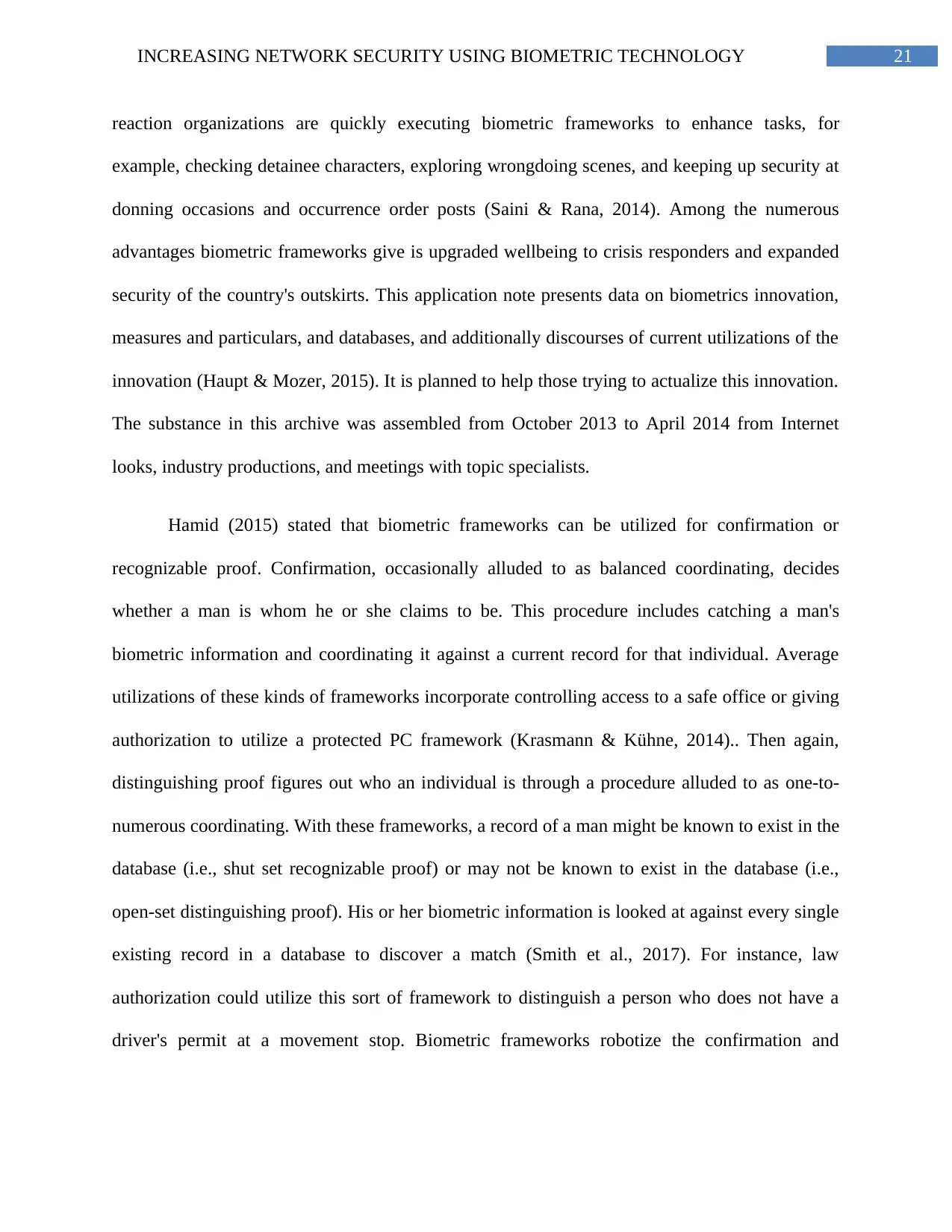
21INCREASING NETWORK SECURITY USING BIOMETRIC TECHNOLOGY
reaction organizations are quickly executing biometric frameworks to enhance tasks, for
example, checking detainee characters, exploring wrongdoing scenes, and keeping up security at
donning occasions and occurrence order posts (Saini & Rana, 2014). Among the numerous
advantages biometric frameworks give is upgraded wellbeing to crisis responders and expanded
security of the country's outskirts. This application note presents data on biometrics innovation,
measures and particulars, and databases, and additionally discourses of current utilizations of the
innovation (Haupt & Mozer, 2015). It is planned to help those trying to actualize this innovation.
The substance in this archive was assembled from October 2013 to April 2014 from Internet
looks, industry productions, and meetings with topic specialists.
Hamid (2015) stated that biometric frameworks can be utilized for confirmation or
recognizable proof. Confirmation, occasionally alluded to as balanced coordinating, decides
whether a man is whom he or she claims to be. This procedure includes catching a man's
biometric information and coordinating it against a current record for that individual. Average
utilizations of these kinds of frameworks incorporate controlling access to a safe office or giving
authorization to utilize a protected PC framework (Krasmann & Kühne, 2014).. Then again,
distinguishing proof figures out who an individual is through a procedure alluded to as one-to-
numerous coordinating. With these frameworks, a record of a man might be known to exist in the
database (i.e., shut set recognizable proof) or may not be known to exist in the database (i.e.,
open-set distinguishing proof). His or her biometric information is looked at against every single
existing record in a database to discover a match (Smith et al., 2017). For instance, law
authorization could utilize this sort of framework to distinguish a person who does not have a
driver's permit at a movement stop. Biometric frameworks robotize the confirmation and
reaction organizations are quickly executing biometric frameworks to enhance tasks, for
example, checking detainee characters, exploring wrongdoing scenes, and keeping up security at
donning occasions and occurrence order posts (Saini & Rana, 2014). Among the numerous
advantages biometric frameworks give is upgraded wellbeing to crisis responders and expanded
security of the country's outskirts. This application note presents data on biometrics innovation,
measures and particulars, and databases, and additionally discourses of current utilizations of the
innovation (Haupt & Mozer, 2015). It is planned to help those trying to actualize this innovation.
The substance in this archive was assembled from October 2013 to April 2014 from Internet
looks, industry productions, and meetings with topic specialists.
Hamid (2015) stated that biometric frameworks can be utilized for confirmation or
recognizable proof. Confirmation, occasionally alluded to as balanced coordinating, decides
whether a man is whom he or she claims to be. This procedure includes catching a man's
biometric information and coordinating it against a current record for that individual. Average
utilizations of these kinds of frameworks incorporate controlling access to a safe office or giving
authorization to utilize a protected PC framework (Krasmann & Kühne, 2014).. Then again,
distinguishing proof figures out who an individual is through a procedure alluded to as one-to-
numerous coordinating. With these frameworks, a record of a man might be known to exist in the
database (i.e., shut set recognizable proof) or may not be known to exist in the database (i.e.,
open-set distinguishing proof). His or her biometric information is looked at against every single
existing record in a database to discover a match (Smith et al., 2017). For instance, law
authorization could utilize this sort of framework to distinguish a person who does not have a
driver's permit at a movement stop. Biometric frameworks robotize the confirmation and
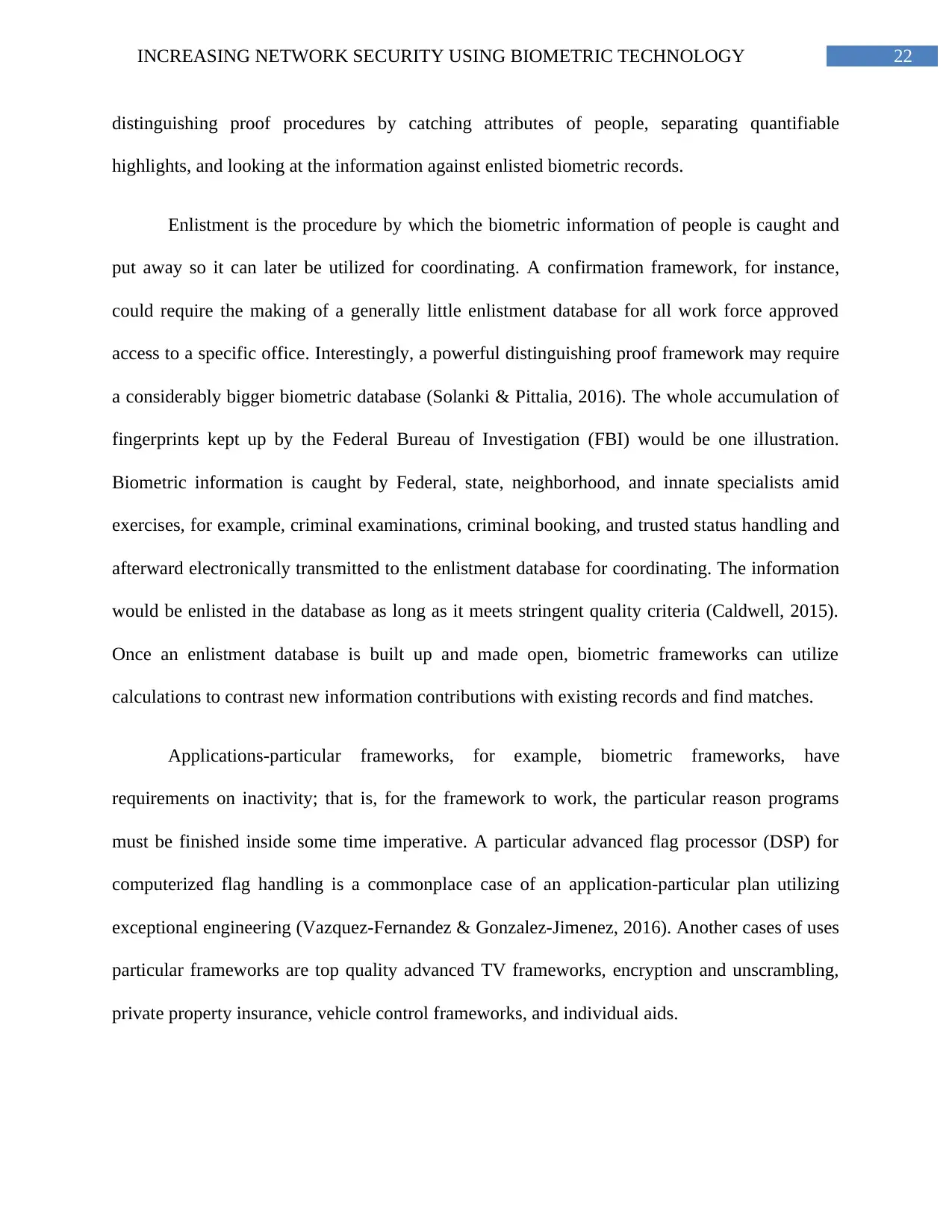
22INCREASING NETWORK SECURITY USING BIOMETRIC TECHNOLOGY
distinguishing proof procedures by catching attributes of people, separating quantifiable
highlights, and looking at the information against enlisted biometric records.
Enlistment is the procedure by which the biometric information of people is caught and
put away so it can later be utilized for coordinating. A confirmation framework, for instance,
could require the making of a generally little enlistment database for all work force approved
access to a specific office. Interestingly, a powerful distinguishing proof framework may require
a considerably bigger biometric database (Solanki & Pittalia, 2016). The whole accumulation of
fingerprints kept up by the Federal Bureau of Investigation (FBI) would be one illustration.
Biometric information is caught by Federal, state, neighborhood, and innate specialists amid
exercises, for example, criminal examinations, criminal booking, and trusted status handling and
afterward electronically transmitted to the enlistment database for coordinating. The information
would be enlisted in the database as long as it meets stringent quality criteria (Caldwell, 2015).
Once an enlistment database is built up and made open, biometric frameworks can utilize
calculations to contrast new information contributions with existing records and find matches.
Applications-particular frameworks, for example, biometric frameworks, have
requirements on inactivity; that is, for the framework to work, the particular reason programs
must be finished inside some time imperative. A particular advanced flag processor (DSP) for
computerized flag handling is a commonplace case of an application-particular plan utilizing
exceptional engineering (Vazquez-Fernandez & Gonzalez-Jimenez, 2016). Another cases of uses
particular frameworks are top quality advanced TV frameworks, encryption and unscrambling,
private property insurance, vehicle control frameworks, and individual aids.
distinguishing proof procedures by catching attributes of people, separating quantifiable
highlights, and looking at the information against enlisted biometric records.
Enlistment is the procedure by which the biometric information of people is caught and
put away so it can later be utilized for coordinating. A confirmation framework, for instance,
could require the making of a generally little enlistment database for all work force approved
access to a specific office. Interestingly, a powerful distinguishing proof framework may require
a considerably bigger biometric database (Solanki & Pittalia, 2016). The whole accumulation of
fingerprints kept up by the Federal Bureau of Investigation (FBI) would be one illustration.
Biometric information is caught by Federal, state, neighborhood, and innate specialists amid
exercises, for example, criminal examinations, criminal booking, and trusted status handling and
afterward electronically transmitted to the enlistment database for coordinating. The information
would be enlisted in the database as long as it meets stringent quality criteria (Caldwell, 2015).
Once an enlistment database is built up and made open, biometric frameworks can utilize
calculations to contrast new information contributions with existing records and find matches.
Applications-particular frameworks, for example, biometric frameworks, have
requirements on inactivity; that is, for the framework to work, the particular reason programs
must be finished inside some time imperative. A particular advanced flag processor (DSP) for
computerized flag handling is a commonplace case of an application-particular plan utilizing
exceptional engineering (Vazquez-Fernandez & Gonzalez-Jimenez, 2016). Another cases of uses
particular frameworks are top quality advanced TV frameworks, encryption and unscrambling,
private property insurance, vehicle control frameworks, and individual aids.
Secure Best Marks with AI Grader
Need help grading? Try our AI Grader for instant feedback on your assignments.
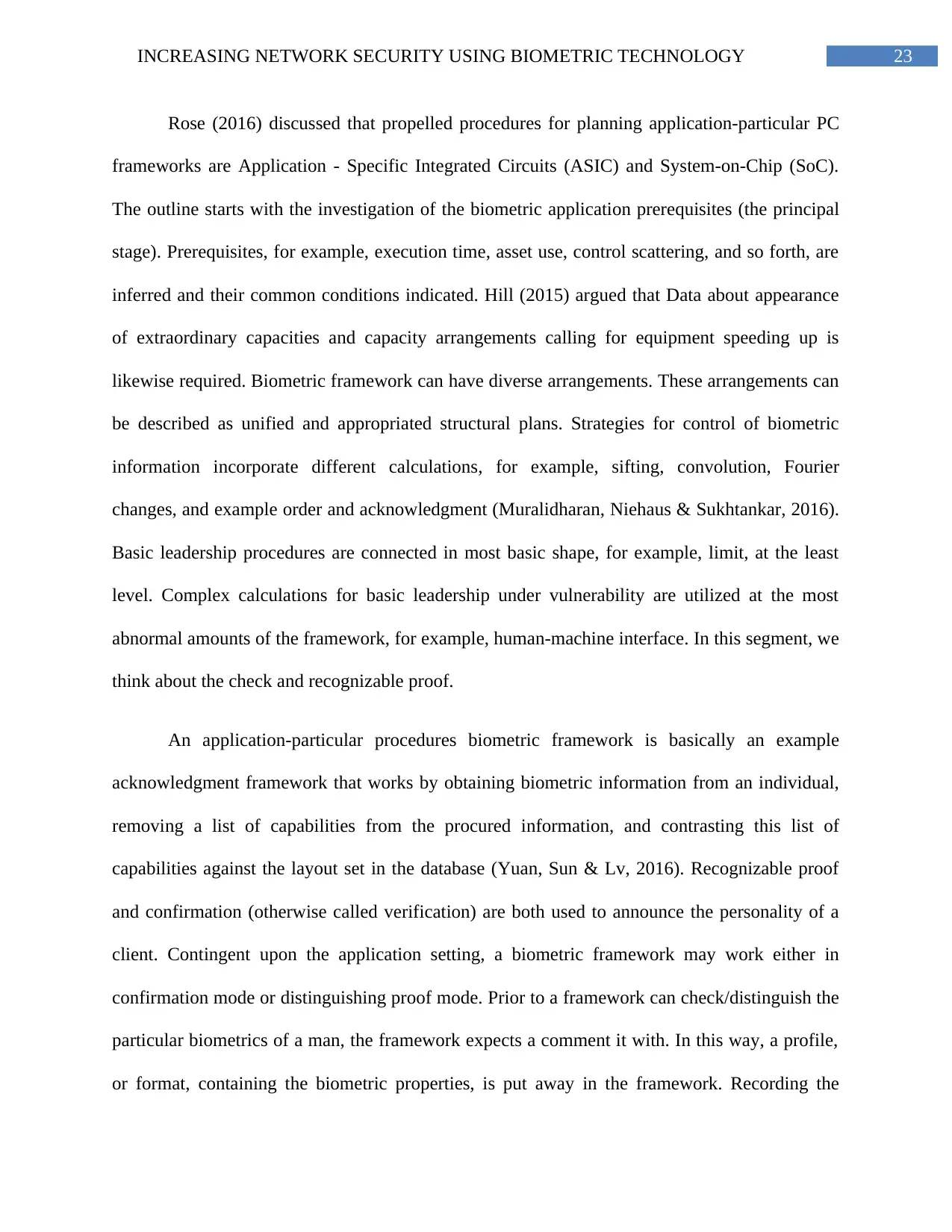
23INCREASING NETWORK SECURITY USING BIOMETRIC TECHNOLOGY
Rose (2016) discussed that propelled procedures for planning application-particular PC
frameworks are Application - Specific Integrated Circuits (ASIC) and System-on-Chip (SoC).
The outline starts with the investigation of the biometric application prerequisites (the principal
stage). Prerequisites, for example, execution time, asset use, control scattering, and so forth, are
inferred and their common conditions indicated. Hill (2015) argued that Data about appearance
of extraordinary capacities and capacity arrangements calling for equipment speeding up is
likewise required. Biometric framework can have diverse arrangements. These arrangements can
be described as unified and appropriated structural plans. Strategies for control of biometric
information incorporate different calculations, for example, sifting, convolution, Fourier
changes, and example order and acknowledgment (Muralidharan, Niehaus & Sukhtankar, 2016).
Basic leadership procedures are connected in most basic shape, for example, limit, at the least
level. Complex calculations for basic leadership under vulnerability are utilized at the most
abnormal amounts of the framework, for example, human-machine interface. In this segment, we
think about the check and recognizable proof.
An application-particular procedures biometric framework is basically an example
acknowledgment framework that works by obtaining biometric information from an individual,
removing a list of capabilities from the procured information, and contrasting this list of
capabilities against the layout set in the database (Yuan, Sun & Lv, 2016). Recognizable proof
and confirmation (otherwise called verification) are both used to announce the personality of a
client. Contingent upon the application setting, a biometric framework may work either in
confirmation mode or distinguishing proof mode. Prior to a framework can check/distinguish the
particular biometrics of a man, the framework expects a comment it with. In this way, a profile,
or format, containing the biometric properties, is put away in the framework. Recording the
Rose (2016) discussed that propelled procedures for planning application-particular PC
frameworks are Application - Specific Integrated Circuits (ASIC) and System-on-Chip (SoC).
The outline starts with the investigation of the biometric application prerequisites (the principal
stage). Prerequisites, for example, execution time, asset use, control scattering, and so forth, are
inferred and their common conditions indicated. Hill (2015) argued that Data about appearance
of extraordinary capacities and capacity arrangements calling for equipment speeding up is
likewise required. Biometric framework can have diverse arrangements. These arrangements can
be described as unified and appropriated structural plans. Strategies for control of biometric
information incorporate different calculations, for example, sifting, convolution, Fourier
changes, and example order and acknowledgment (Muralidharan, Niehaus & Sukhtankar, 2016).
Basic leadership procedures are connected in most basic shape, for example, limit, at the least
level. Complex calculations for basic leadership under vulnerability are utilized at the most
abnormal amounts of the framework, for example, human-machine interface. In this segment, we
think about the check and recognizable proof.
An application-particular procedures biometric framework is basically an example
acknowledgment framework that works by obtaining biometric information from an individual,
removing a list of capabilities from the procured information, and contrasting this list of
capabilities against the layout set in the database (Yuan, Sun & Lv, 2016). Recognizable proof
and confirmation (otherwise called verification) are both used to announce the personality of a
client. Contingent upon the application setting, a biometric framework may work either in
confirmation mode or distinguishing proof mode. Prior to a framework can check/distinguish the
particular biometrics of a man, the framework expects a comment it with. In this way, a profile,
or format, containing the biometric properties, is put away in the framework. Recording the
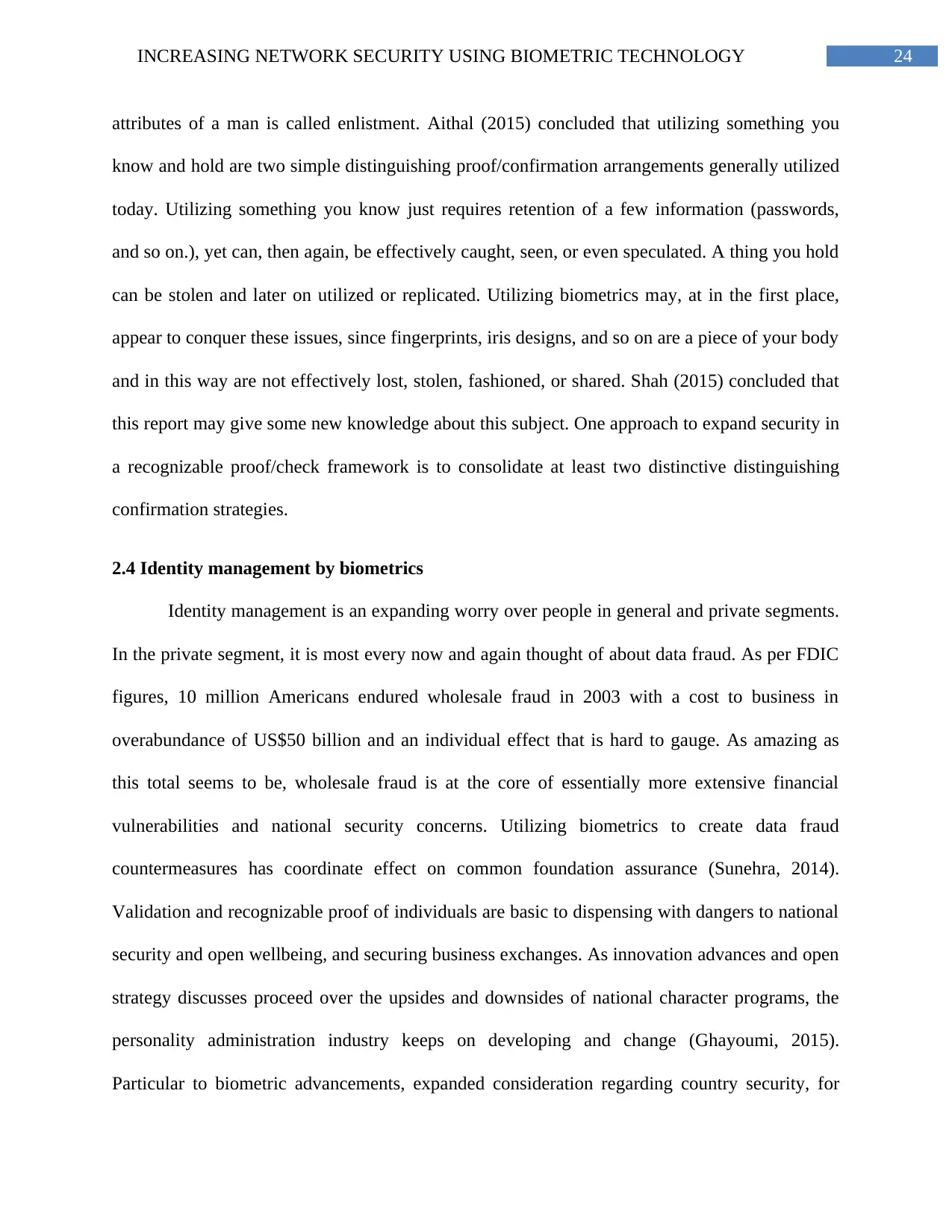
24INCREASING NETWORK SECURITY USING BIOMETRIC TECHNOLOGY
attributes of a man is called enlistment. Aithal (2015) concluded that utilizing something you
know and hold are two simple distinguishing proof/confirmation arrangements generally utilized
today. Utilizing something you know just requires retention of a few information (passwords,
and so on.), yet can, then again, be effectively caught, seen, or even speculated. A thing you hold
can be stolen and later on utilized or replicated. Utilizing biometrics may, at in the first place,
appear to conquer these issues, since fingerprints, iris designs, and so on are a piece of your body
and in this way are not effectively lost, stolen, fashioned, or shared. Shah (2015) concluded that
this report may give some new knowledge about this subject. One approach to expand security in
a recognizable proof/check framework is to consolidate at least two distinctive distinguishing
confirmation strategies.
2.4 Identity management by biometrics
Identity management is an expanding worry over people in general and private segments.
In the private segment, it is most every now and again thought of about data fraud. As per FDIC
figures, 10 million Americans endured wholesale fraud in 2003 with a cost to business in
overabundance of US$50 billion and an individual effect that is hard to gauge. As amazing as
this total seems to be, wholesale fraud is at the core of essentially more extensive financial
vulnerabilities and national security concerns. Utilizing biometrics to create data fraud
countermeasures has coordinate effect on common foundation assurance (Sunehra, 2014).
Validation and recognizable proof of individuals are basic to dispensing with dangers to national
security and open wellbeing, and securing business exchanges. As innovation advances and open
strategy discusses proceed over the upsides and downsides of national character programs, the
personality administration industry keeps on developing and change (Ghayoumi, 2015).
Particular to biometric advancements, expanded consideration regarding country security, for
attributes of a man is called enlistment. Aithal (2015) concluded that utilizing something you
know and hold are two simple distinguishing proof/confirmation arrangements generally utilized
today. Utilizing something you know just requires retention of a few information (passwords,
and so on.), yet can, then again, be effectively caught, seen, or even speculated. A thing you hold
can be stolen and later on utilized or replicated. Utilizing biometrics may, at in the first place,
appear to conquer these issues, since fingerprints, iris designs, and so on are a piece of your body
and in this way are not effectively lost, stolen, fashioned, or shared. Shah (2015) concluded that
this report may give some new knowledge about this subject. One approach to expand security in
a recognizable proof/check framework is to consolidate at least two distinctive distinguishing
confirmation strategies.
2.4 Identity management by biometrics
Identity management is an expanding worry over people in general and private segments.
In the private segment, it is most every now and again thought of about data fraud. As per FDIC
figures, 10 million Americans endured wholesale fraud in 2003 with a cost to business in
overabundance of US$50 billion and an individual effect that is hard to gauge. As amazing as
this total seems to be, wholesale fraud is at the core of essentially more extensive financial
vulnerabilities and national security concerns. Utilizing biometrics to create data fraud
countermeasures has coordinate effect on common foundation assurance (Sunehra, 2014).
Validation and recognizable proof of individuals are basic to dispensing with dangers to national
security and open wellbeing, and securing business exchanges. As innovation advances and open
strategy discusses proceed over the upsides and downsides of national character programs, the
personality administration industry keeps on developing and change (Ghayoumi, 2015).
Particular to biometric advancements, expanded consideration regarding country security, for
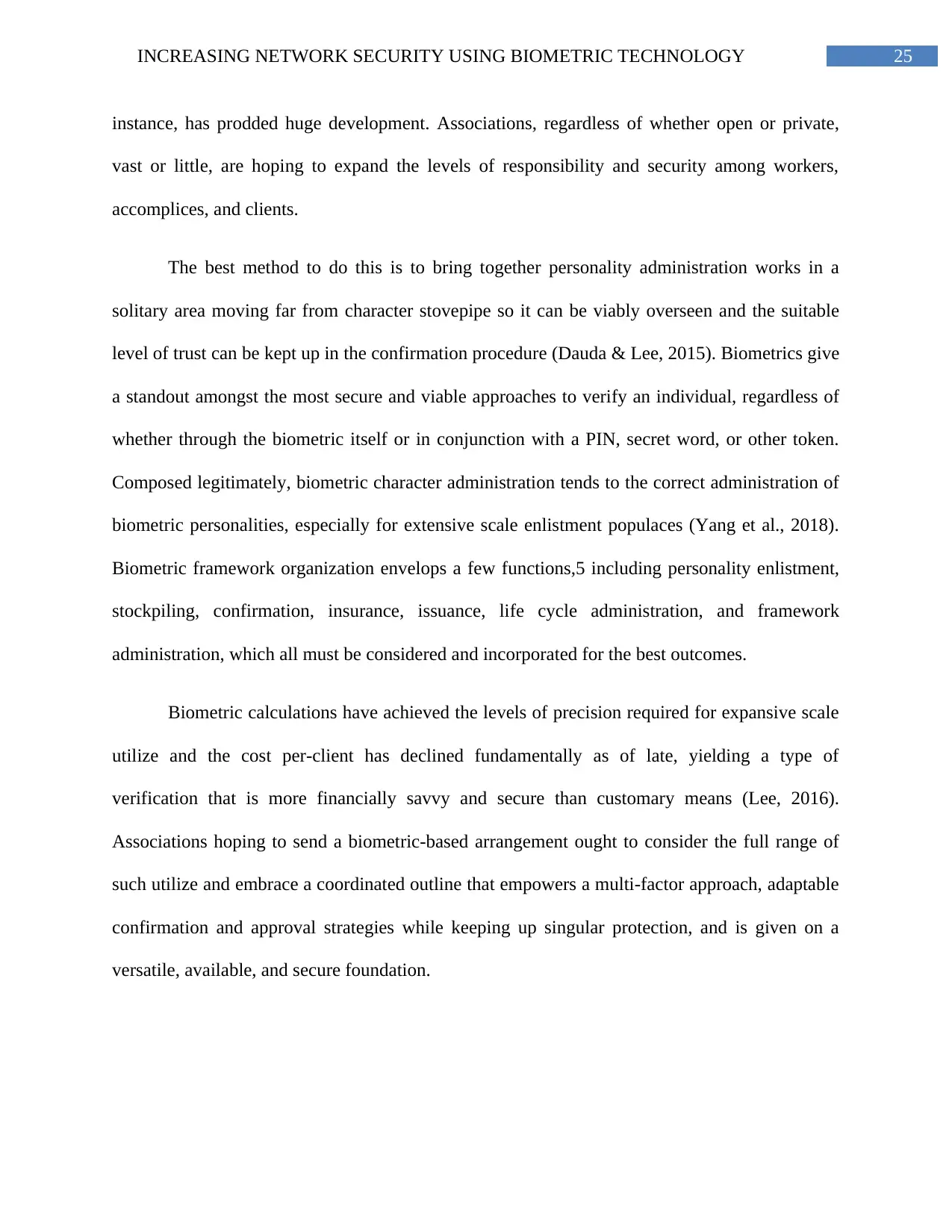
25INCREASING NETWORK SECURITY USING BIOMETRIC TECHNOLOGY
instance, has prodded huge development. Associations, regardless of whether open or private,
vast or little, are hoping to expand the levels of responsibility and security among workers,
accomplices, and clients.
The best method to do this is to bring together personality administration works in a
solitary area moving far from character stovepipe so it can be viably overseen and the suitable
level of trust can be kept up in the confirmation procedure (Dauda & Lee, 2015). Biometrics give
a standout amongst the most secure and viable approaches to verify an individual, regardless of
whether through the biometric itself or in conjunction with a PIN, secret word, or other token.
Composed legitimately, biometric character administration tends to the correct administration of
biometric personalities, especially for extensive scale enlistment populaces (Yang et al., 2018).
Biometric framework organization envelops a few functions,5 including personality enlistment,
stockpiling, confirmation, insurance, issuance, life cycle administration, and framework
administration, which all must be considered and incorporated for the best outcomes.
Biometric calculations have achieved the levels of precision required for expansive scale
utilize and the cost per-client has declined fundamentally as of late, yielding a type of
verification that is more financially savvy and secure than customary means (Lee, 2016).
Associations hoping to send a biometric-based arrangement ought to consider the full range of
such utilize and embrace a coordinated outline that empowers a multi-factor approach, adaptable
confirmation and approval strategies while keeping up singular protection, and is given on a
versatile, available, and secure foundation.
instance, has prodded huge development. Associations, regardless of whether open or private,
vast or little, are hoping to expand the levels of responsibility and security among workers,
accomplices, and clients.
The best method to do this is to bring together personality administration works in a
solitary area moving far from character stovepipe so it can be viably overseen and the suitable
level of trust can be kept up in the confirmation procedure (Dauda & Lee, 2015). Biometrics give
a standout amongst the most secure and viable approaches to verify an individual, regardless of
whether through the biometric itself or in conjunction with a PIN, secret word, or other token.
Composed legitimately, biometric character administration tends to the correct administration of
biometric personalities, especially for extensive scale enlistment populaces (Yang et al., 2018).
Biometric framework organization envelops a few functions,5 including personality enlistment,
stockpiling, confirmation, insurance, issuance, life cycle administration, and framework
administration, which all must be considered and incorporated for the best outcomes.
Biometric calculations have achieved the levels of precision required for expansive scale
utilize and the cost per-client has declined fundamentally as of late, yielding a type of
verification that is more financially savvy and secure than customary means (Lee, 2016).
Associations hoping to send a biometric-based arrangement ought to consider the full range of
such utilize and embrace a coordinated outline that empowers a multi-factor approach, adaptable
confirmation and approval strategies while keeping up singular protection, and is given on a
versatile, available, and secure foundation.
Paraphrase This Document
Need a fresh take? Get an instant paraphrase of this document with our AI Paraphraser
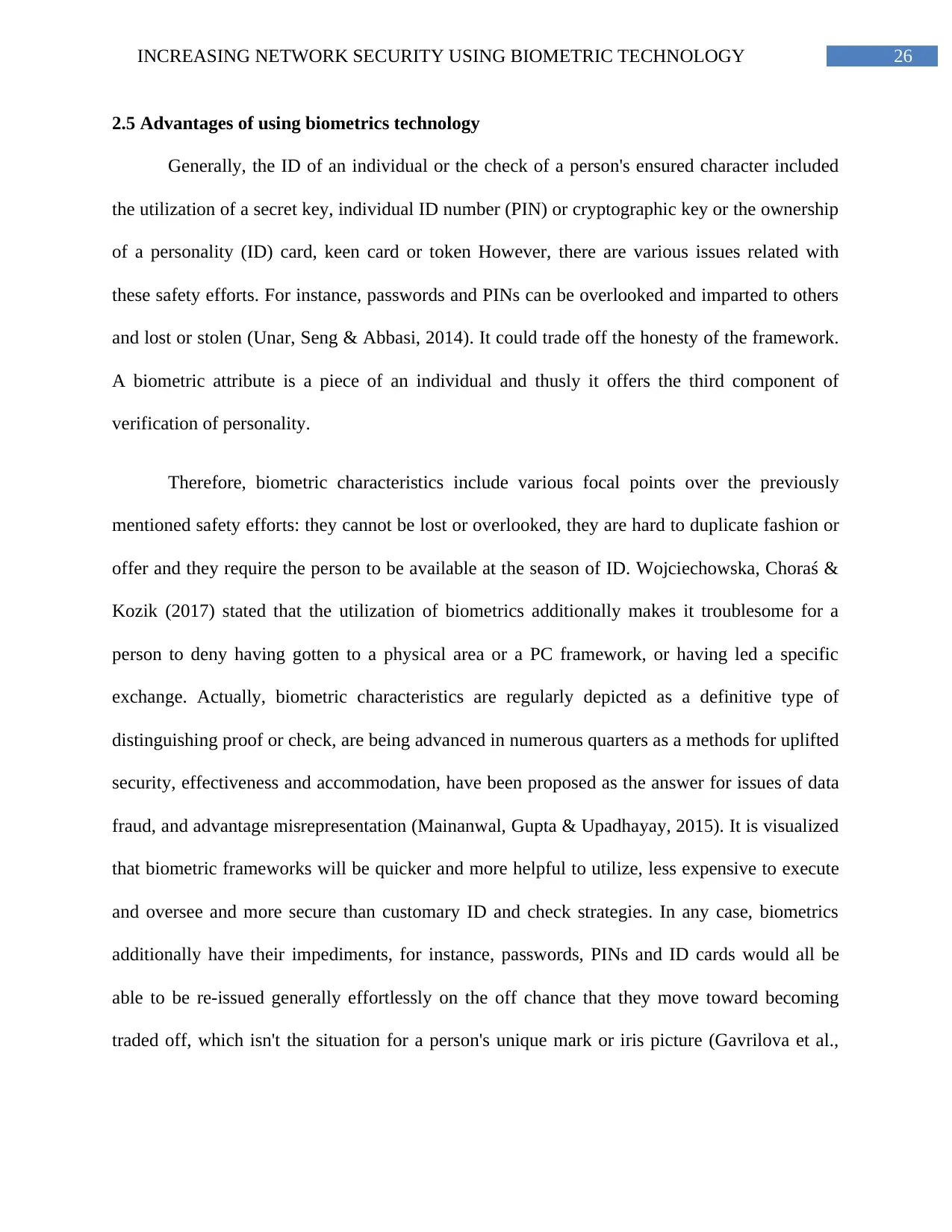
26INCREASING NETWORK SECURITY USING BIOMETRIC TECHNOLOGY
2.5 Advantages of using biometrics technology
Generally, the ID of an individual or the check of a person's ensured character included
the utilization of a secret key, individual ID number (PIN) or cryptographic key or the ownership
of a personality (ID) card, keen card or token However, there are various issues related with
these safety efforts. For instance, passwords and PINs can be overlooked and imparted to others
and lost or stolen (Unar, Seng & Abbasi, 2014). It could trade off the honesty of the framework.
A biometric attribute is a piece of an individual and thusly it offers the third component of
verification of personality.
Therefore, biometric characteristics include various focal points over the previously
mentioned safety efforts: they cannot be lost or overlooked, they are hard to duplicate fashion or
offer and they require the person to be available at the season of ID. Wojciechowska, Choraś &
Kozik (2017) stated that the utilization of biometrics additionally makes it troublesome for a
person to deny having gotten to a physical area or a PC framework, or having led a specific
exchange. Actually, biometric characteristics are regularly depicted as a definitive type of
distinguishing proof or check, are being advanced in numerous quarters as a methods for uplifted
security, effectiveness and accommodation, have been proposed as the answer for issues of data
fraud, and advantage misrepresentation (Mainanwal, Gupta & Upadhayay, 2015). It is visualized
that biometric frameworks will be quicker and more helpful to utilize, less expensive to execute
and oversee and more secure than customary ID and check strategies. In any case, biometrics
additionally have their impediments, for instance, passwords, PINs and ID cards would all be
able to be re-issued generally effortlessly on the off chance that they move toward becoming
traded off, which isn't the situation for a person's unique mark or iris picture (Gavrilova et al.,
2.5 Advantages of using biometrics technology
Generally, the ID of an individual or the check of a person's ensured character included
the utilization of a secret key, individual ID number (PIN) or cryptographic key or the ownership
of a personality (ID) card, keen card or token However, there are various issues related with
these safety efforts. For instance, passwords and PINs can be overlooked and imparted to others
and lost or stolen (Unar, Seng & Abbasi, 2014). It could trade off the honesty of the framework.
A biometric attribute is a piece of an individual and thusly it offers the third component of
verification of personality.
Therefore, biometric characteristics include various focal points over the previously
mentioned safety efforts: they cannot be lost or overlooked, they are hard to duplicate fashion or
offer and they require the person to be available at the season of ID. Wojciechowska, Choraś &
Kozik (2017) stated that the utilization of biometrics additionally makes it troublesome for a
person to deny having gotten to a physical area or a PC framework, or having led a specific
exchange. Actually, biometric characteristics are regularly depicted as a definitive type of
distinguishing proof or check, are being advanced in numerous quarters as a methods for uplifted
security, effectiveness and accommodation, have been proposed as the answer for issues of data
fraud, and advantage misrepresentation (Mainanwal, Gupta & Upadhayay, 2015). It is visualized
that biometric frameworks will be quicker and more helpful to utilize, less expensive to execute
and oversee and more secure than customary ID and check strategies. In any case, biometrics
additionally have their impediments, for instance, passwords, PINs and ID cards would all be
able to be re-issued generally effortlessly on the off chance that they move toward becoming
traded off, which isn't the situation for a person's unique mark or iris picture (Gavrilova et al.,
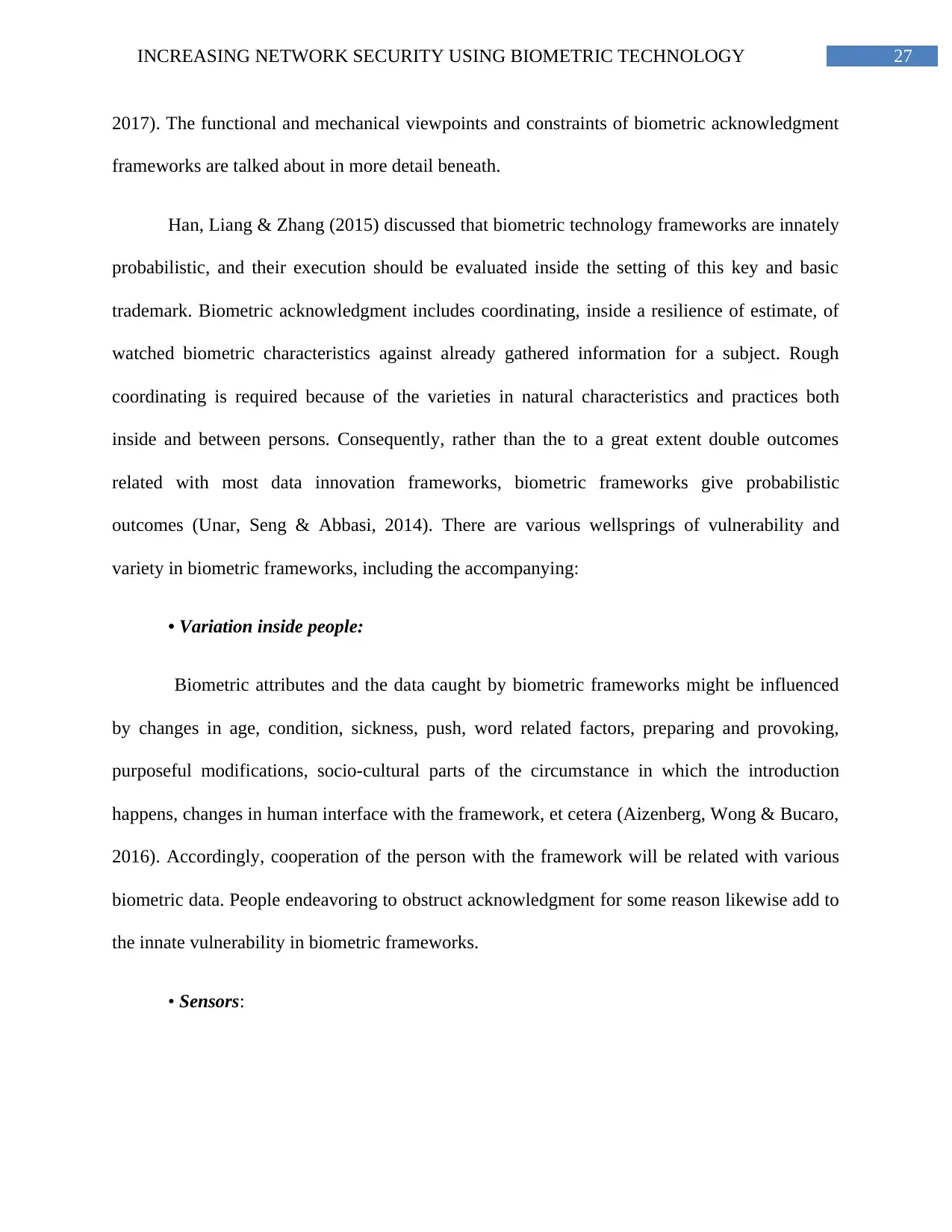
27INCREASING NETWORK SECURITY USING BIOMETRIC TECHNOLOGY
2017). The functional and mechanical viewpoints and constraints of biometric acknowledgment
frameworks are talked about in more detail beneath.
Han, Liang & Zhang (2015) discussed that biometric technology frameworks are innately
probabilistic, and their execution should be evaluated inside the setting of this key and basic
trademark. Biometric acknowledgment includes coordinating, inside a resilience of estimate, of
watched biometric characteristics against already gathered information for a subject. Rough
coordinating is required because of the varieties in natural characteristics and practices both
inside and between persons. Consequently, rather than the to a great extent double outcomes
related with most data innovation frameworks, biometric frameworks give probabilistic
outcomes (Unar, Seng & Abbasi, 2014). There are various wellsprings of vulnerability and
variety in biometric frameworks, including the accompanying:
• Variation inside people:
Biometric attributes and the data caught by biometric frameworks might be influenced
by changes in age, condition, sickness, push, word related factors, preparing and provoking,
purposeful modifications, socio-cultural parts of the circumstance in which the introduction
happens, changes in human interface with the framework, et cetera (Aizenberg, Wong & Bucaro,
2016). Accordingly, cooperation of the person with the framework will be related with various
biometric data. People endeavoring to obstruct acknowledgment for some reason likewise add to
the innate vulnerability in biometric frameworks.
• Sensors:
2017). The functional and mechanical viewpoints and constraints of biometric acknowledgment
frameworks are talked about in more detail beneath.
Han, Liang & Zhang (2015) discussed that biometric technology frameworks are innately
probabilistic, and their execution should be evaluated inside the setting of this key and basic
trademark. Biometric acknowledgment includes coordinating, inside a resilience of estimate, of
watched biometric characteristics against already gathered information for a subject. Rough
coordinating is required because of the varieties in natural characteristics and practices both
inside and between persons. Consequently, rather than the to a great extent double outcomes
related with most data innovation frameworks, biometric frameworks give probabilistic
outcomes (Unar, Seng & Abbasi, 2014). There are various wellsprings of vulnerability and
variety in biometric frameworks, including the accompanying:
• Variation inside people:
Biometric attributes and the data caught by biometric frameworks might be influenced
by changes in age, condition, sickness, push, word related factors, preparing and provoking,
purposeful modifications, socio-cultural parts of the circumstance in which the introduction
happens, changes in human interface with the framework, et cetera (Aizenberg, Wong & Bucaro,
2016). Accordingly, cooperation of the person with the framework will be related with various
biometric data. People endeavoring to obstruct acknowledgment for some reason likewise add to
the innate vulnerability in biometric frameworks.
• Sensors:
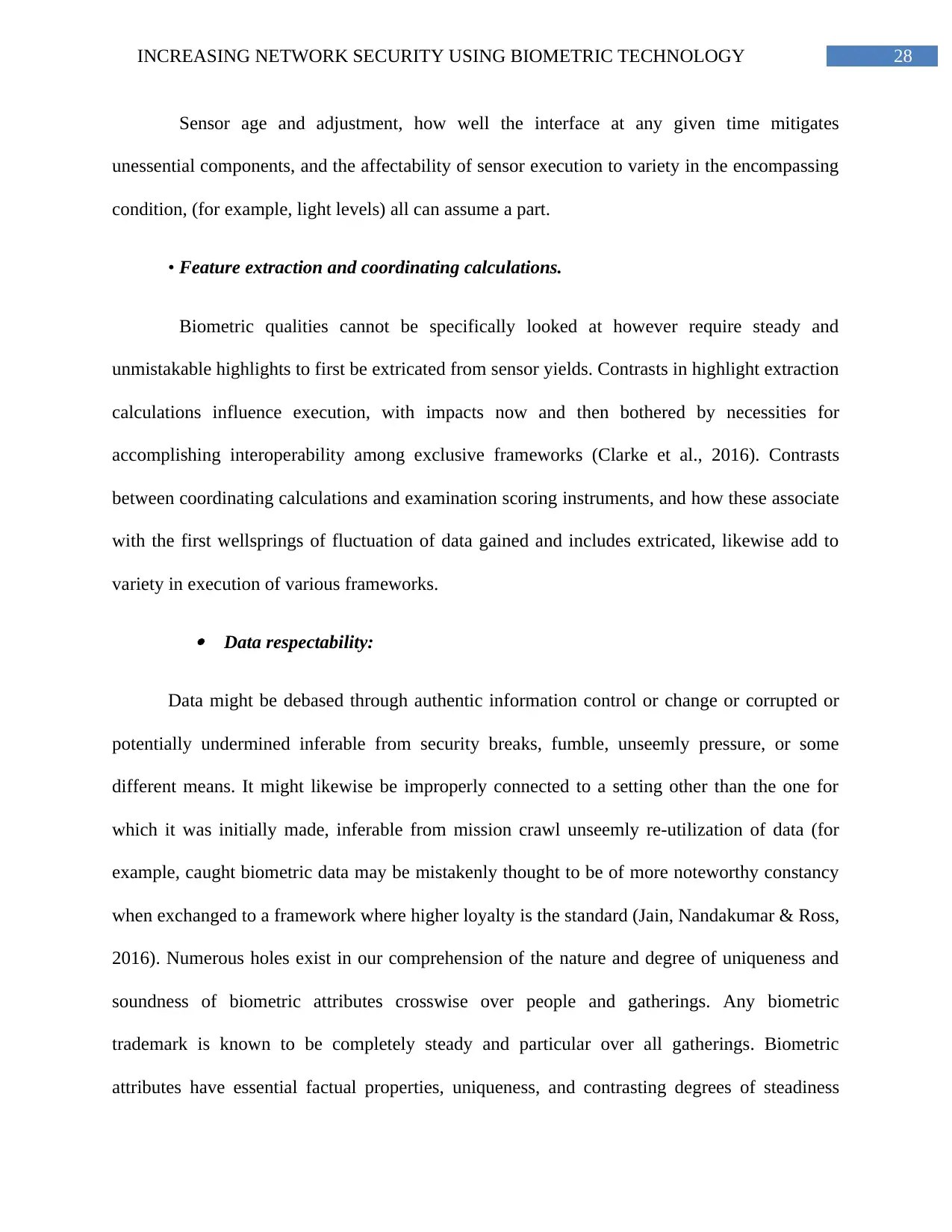
28INCREASING NETWORK SECURITY USING BIOMETRIC TECHNOLOGY
Sensor age and adjustment, how well the interface at any given time mitigates
unessential components, and the affectability of sensor execution to variety in the encompassing
condition, (for example, light levels) all can assume a part.
• Feature extraction and coordinating calculations.
Biometric qualities cannot be specifically looked at however require steady and
unmistakable highlights to first be extricated from sensor yields. Contrasts in highlight extraction
calculations influence execution, with impacts now and then bothered by necessities for
accomplishing interoperability among exclusive frameworks (Clarke et al., 2016). Contrasts
between coordinating calculations and examination scoring instruments, and how these associate
with the first wellsprings of fluctuation of data gained and includes extricated, likewise add to
variety in execution of various frameworks. Data respectability:
Data might be debased through authentic information control or change or corrupted or
potentially undermined inferable from security breaks, fumble, unseemly pressure, or some
different means. It might likewise be improperly connected to a setting other than the one for
which it was initially made, inferable from mission crawl unseemly re-utilization of data (for
example, caught biometric data may be mistakenly thought to be of more noteworthy constancy
when exchanged to a framework where higher loyalty is the standard (Jain, Nandakumar & Ross,
2016). Numerous holes exist in our comprehension of the nature and degree of uniqueness and
soundness of biometric attributes crosswise over people and gatherings. Any biometric
trademark is known to be completely steady and particular over all gatherings. Biometric
attributes have essential factual properties, uniqueness, and contrasting degrees of steadiness
Sensor age and adjustment, how well the interface at any given time mitigates
unessential components, and the affectability of sensor execution to variety in the encompassing
condition, (for example, light levels) all can assume a part.
• Feature extraction and coordinating calculations.
Biometric qualities cannot be specifically looked at however require steady and
unmistakable highlights to first be extricated from sensor yields. Contrasts in highlight extraction
calculations influence execution, with impacts now and then bothered by necessities for
accomplishing interoperability among exclusive frameworks (Clarke et al., 2016). Contrasts
between coordinating calculations and examination scoring instruments, and how these associate
with the first wellsprings of fluctuation of data gained and includes extricated, likewise add to
variety in execution of various frameworks. Data respectability:
Data might be debased through authentic information control or change or corrupted or
potentially undermined inferable from security breaks, fumble, unseemly pressure, or some
different means. It might likewise be improperly connected to a setting other than the one for
which it was initially made, inferable from mission crawl unseemly re-utilization of data (for
example, caught biometric data may be mistakenly thought to be of more noteworthy constancy
when exchanged to a framework where higher loyalty is the standard (Jain, Nandakumar & Ross,
2016). Numerous holes exist in our comprehension of the nature and degree of uniqueness and
soundness of biometric attributes crosswise over people and gatherings. Any biometric
trademark is known to be completely steady and particular over all gatherings. Biometric
attributes have essential factual properties, uniqueness, and contrasting degrees of steadiness
Secure Best Marks with AI Grader
Need help grading? Try our AI Grader for instant feedback on your assignments.
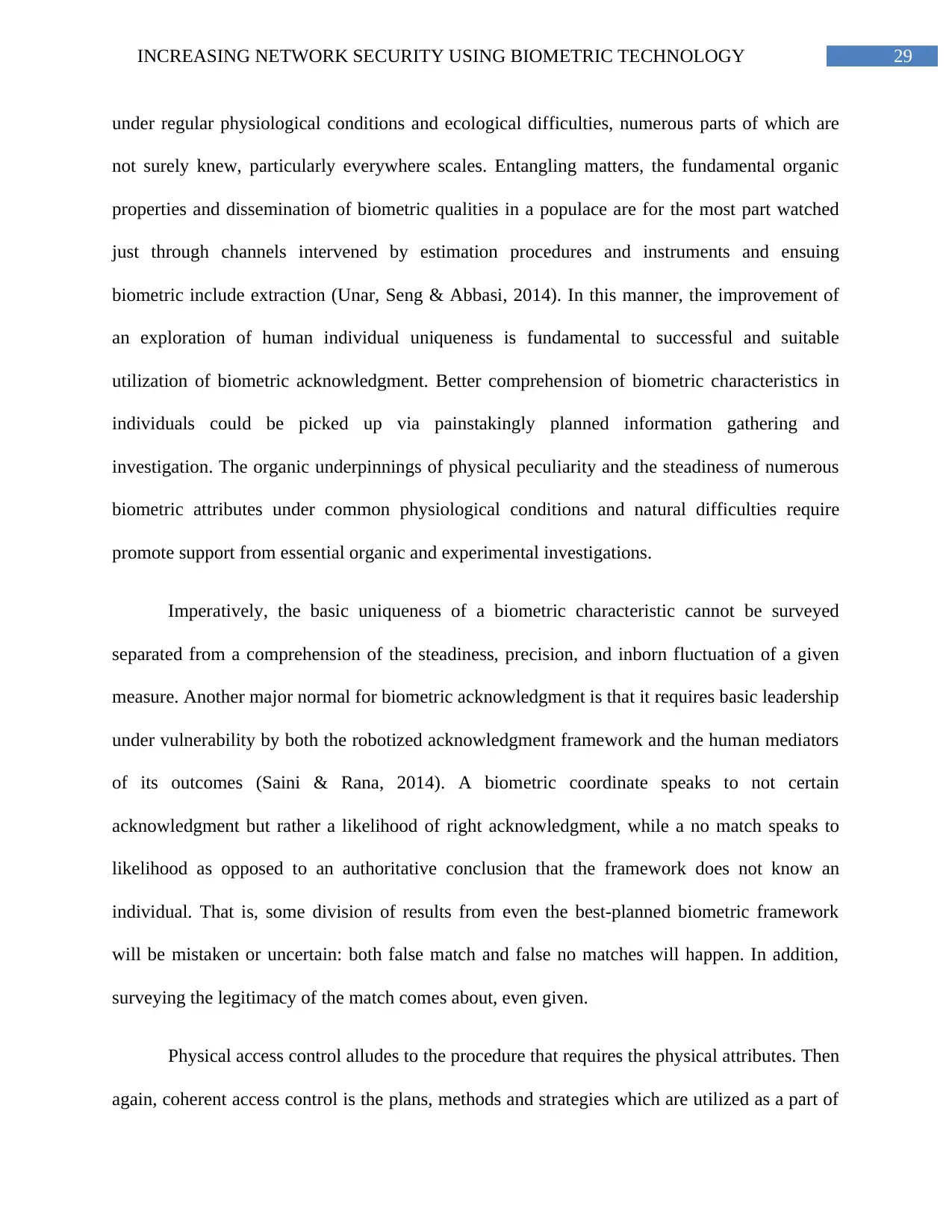
29INCREASING NETWORK SECURITY USING BIOMETRIC TECHNOLOGY
under regular physiological conditions and ecological difficulties, numerous parts of which are
not surely knew, particularly everywhere scales. Entangling matters, the fundamental organic
properties and dissemination of biometric qualities in a populace are for the most part watched
just through channels intervened by estimation procedures and instruments and ensuing
biometric include extraction (Unar, Seng & Abbasi, 2014). In this manner, the improvement of
an exploration of human individual uniqueness is fundamental to successful and suitable
utilization of biometric acknowledgment. Better comprehension of biometric characteristics in
individuals could be picked up via painstakingly planned information gathering and
investigation. The organic underpinnings of physical peculiarity and the steadiness of numerous
biometric attributes under common physiological conditions and natural difficulties require
promote support from essential organic and experimental investigations.
Imperatively, the basic uniqueness of a biometric characteristic cannot be surveyed
separated from a comprehension of the steadiness, precision, and inborn fluctuation of a given
measure. Another major normal for biometric acknowledgment is that it requires basic leadership
under vulnerability by both the robotized acknowledgment framework and the human mediators
of its outcomes (Saini & Rana, 2014). A biometric coordinate speaks to not certain
acknowledgment but rather a likelihood of right acknowledgment, while a no match speaks to
likelihood as opposed to an authoritative conclusion that the framework does not know an
individual. That is, some division of results from even the best-planned biometric framework
will be mistaken or uncertain: both false match and false no matches will happen. In addition,
surveying the legitimacy of the match comes about, even given.
Physical access control alludes to the procedure that requires the physical attributes. Then
again, coherent access control is the plans, methods and strategies which are utilized as a part of
under regular physiological conditions and ecological difficulties, numerous parts of which are
not surely knew, particularly everywhere scales. Entangling matters, the fundamental organic
properties and dissemination of biometric qualities in a populace are for the most part watched
just through channels intervened by estimation procedures and instruments and ensuing
biometric include extraction (Unar, Seng & Abbasi, 2014). In this manner, the improvement of
an exploration of human individual uniqueness is fundamental to successful and suitable
utilization of biometric acknowledgment. Better comprehension of biometric characteristics in
individuals could be picked up via painstakingly planned information gathering and
investigation. The organic underpinnings of physical peculiarity and the steadiness of numerous
biometric attributes under common physiological conditions and natural difficulties require
promote support from essential organic and experimental investigations.
Imperatively, the basic uniqueness of a biometric characteristic cannot be surveyed
separated from a comprehension of the steadiness, precision, and inborn fluctuation of a given
measure. Another major normal for biometric acknowledgment is that it requires basic leadership
under vulnerability by both the robotized acknowledgment framework and the human mediators
of its outcomes (Saini & Rana, 2014). A biometric coordinate speaks to not certain
acknowledgment but rather a likelihood of right acknowledgment, while a no match speaks to
likelihood as opposed to an authoritative conclusion that the framework does not know an
individual. That is, some division of results from even the best-planned biometric framework
will be mistaken or uncertain: both false match and false no matches will happen. In addition,
surveying the legitimacy of the match comes about, even given.
Physical access control alludes to the procedure that requires the physical attributes. Then
again, coherent access control is the plans, methods and strategies which are utilized as a part of
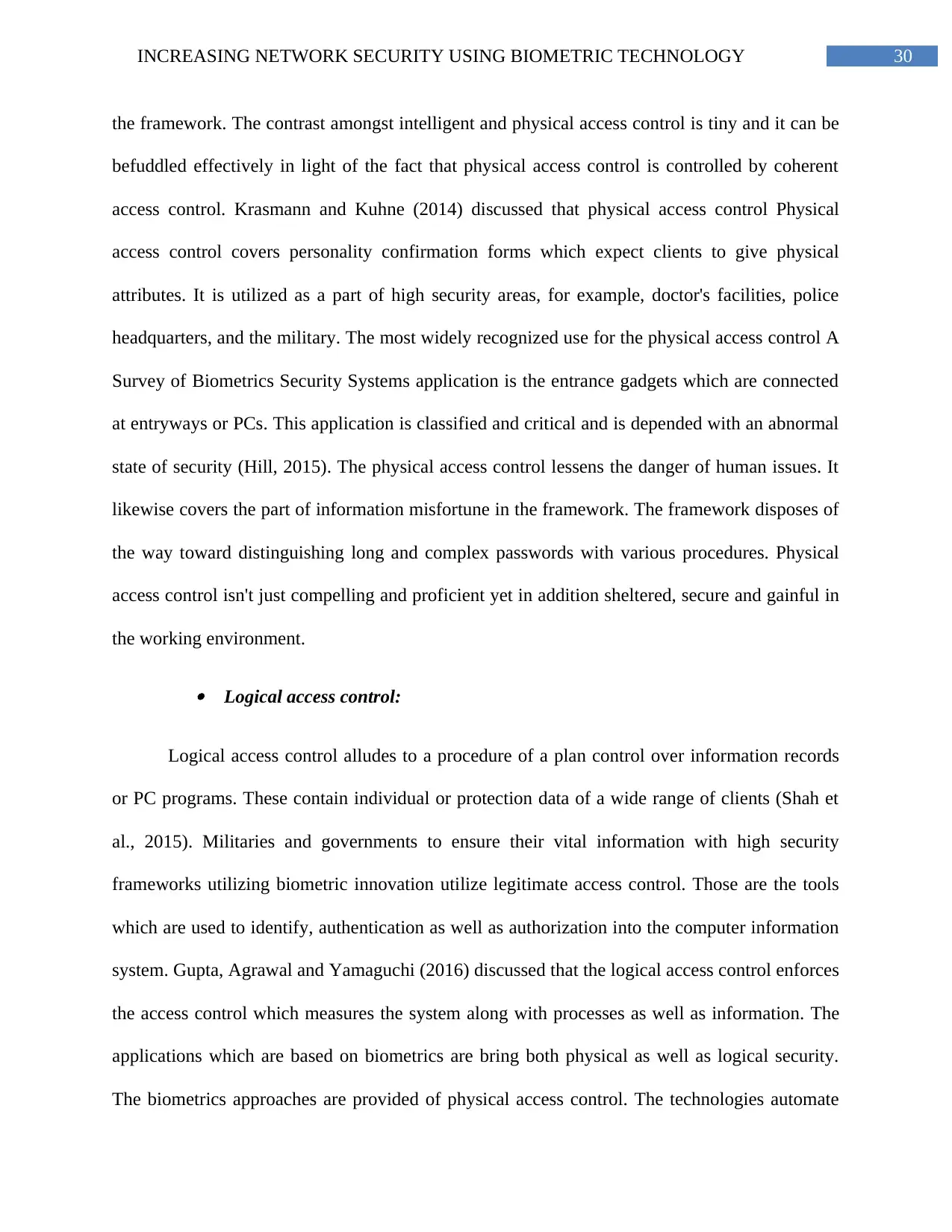
30INCREASING NETWORK SECURITY USING BIOMETRIC TECHNOLOGY
the framework. The contrast amongst intelligent and physical access control is tiny and it can be
befuddled effectively in light of the fact that physical access control is controlled by coherent
access control. Krasmann and Kuhne (2014) discussed that physical access control Physical
access control covers personality confirmation forms which expect clients to give physical
attributes. It is utilized as a part of high security areas, for example, doctor's facilities, police
headquarters, and the military. The most widely recognized use for the physical access control A
Survey of Biometrics Security Systems application is the entrance gadgets which are connected
at entryways or PCs. This application is classified and critical and is depended with an abnormal
state of security (Hill, 2015). The physical access control lessens the danger of human issues. It
likewise covers the part of information misfortune in the framework. The framework disposes of
the way toward distinguishing long and complex passwords with various procedures. Physical
access control isn't just compelling and proficient yet in addition sheltered, secure and gainful in
the working environment. Logical access control:
Logical access control alludes to a procedure of a plan control over information records
or PC programs. These contain individual or protection data of a wide range of clients (Shah et
al., 2015). Militaries and governments to ensure their vital information with high security
frameworks utilizing biometric innovation utilize legitimate access control. Those are the tools
which are used to identify, authentication as well as authorization into the computer information
system. Gupta, Agrawal and Yamaguchi (2016) discussed that the logical access control enforces
the access control which measures the system along with processes as well as information. The
applications which are based on biometrics are bring both physical as well as logical security.
The biometrics approaches are provided of physical access control. The technologies automate
the framework. The contrast amongst intelligent and physical access control is tiny and it can be
befuddled effectively in light of the fact that physical access control is controlled by coherent
access control. Krasmann and Kuhne (2014) discussed that physical access control Physical
access control covers personality confirmation forms which expect clients to give physical
attributes. It is utilized as a part of high security areas, for example, doctor's facilities, police
headquarters, and the military. The most widely recognized use for the physical access control A
Survey of Biometrics Security Systems application is the entrance gadgets which are connected
at entryways or PCs. This application is classified and critical and is depended with an abnormal
state of security (Hill, 2015). The physical access control lessens the danger of human issues. It
likewise covers the part of information misfortune in the framework. The framework disposes of
the way toward distinguishing long and complex passwords with various procedures. Physical
access control isn't just compelling and proficient yet in addition sheltered, secure and gainful in
the working environment. Logical access control:
Logical access control alludes to a procedure of a plan control over information records
or PC programs. These contain individual or protection data of a wide range of clients (Shah et
al., 2015). Militaries and governments to ensure their vital information with high security
frameworks utilizing biometric innovation utilize legitimate access control. Those are the tools
which are used to identify, authentication as well as authorization into the computer information
system. Gupta, Agrawal and Yamaguchi (2016) discussed that the logical access control enforces
the access control which measures the system along with processes as well as information. The
applications which are based on biometrics are bring both physical as well as logical security.
The biometrics approaches are provided of physical access control. The technologies automate
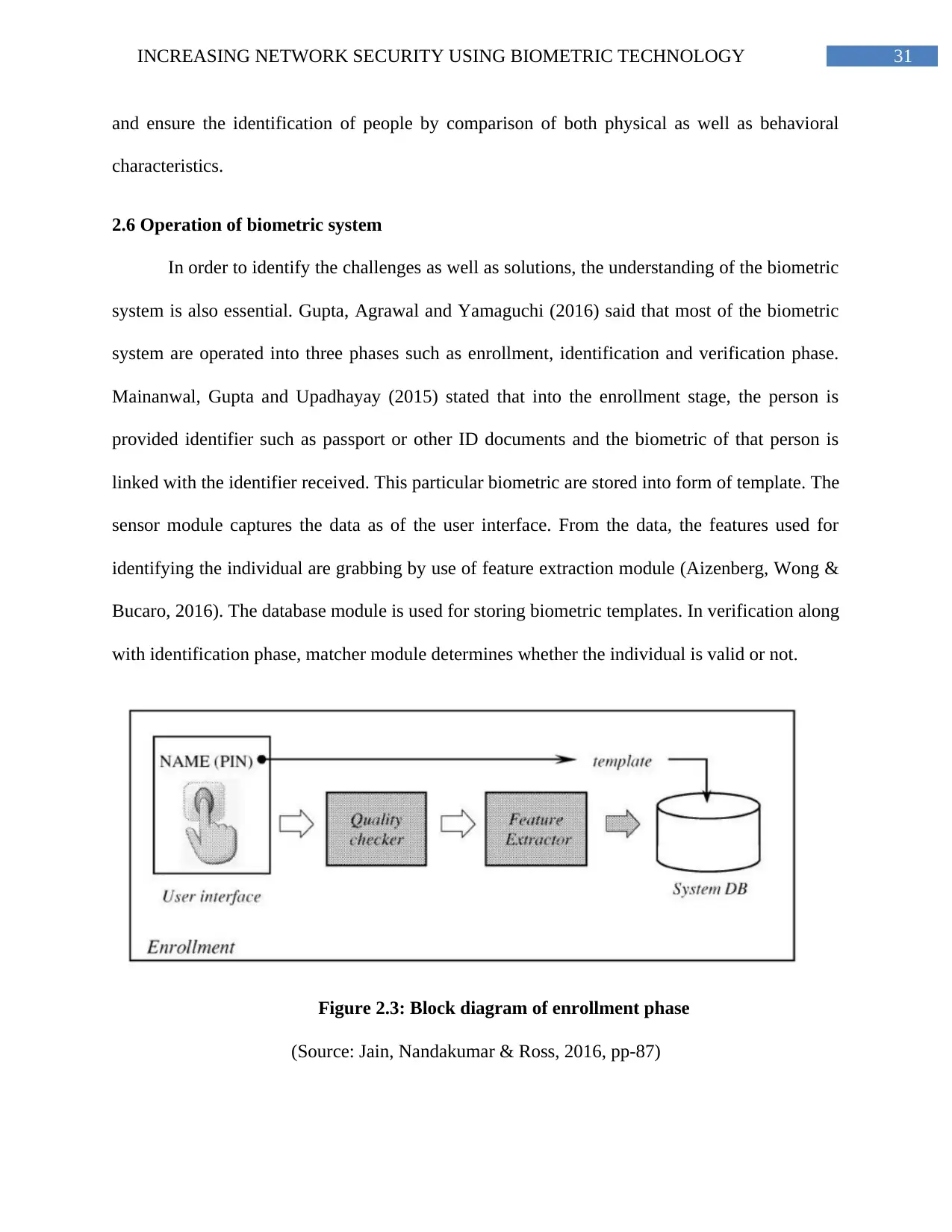
31INCREASING NETWORK SECURITY USING BIOMETRIC TECHNOLOGY
and ensure the identification of people by comparison of both physical as well as behavioral
characteristics.
2.6 Operation of biometric system
In order to identify the challenges as well as solutions, the understanding of the biometric
system is also essential. Gupta, Agrawal and Yamaguchi (2016) said that most of the biometric
system are operated into three phases such as enrollment, identification and verification phase.
Mainanwal, Gupta and Upadhayay (2015) stated that into the enrollment stage, the person is
provided identifier such as passport or other ID documents and the biometric of that person is
linked with the identifier received. This particular biometric are stored into form of template. The
sensor module captures the data as of the user interface. From the data, the features used for
identifying the individual are grabbing by use of feature extraction module (Aizenberg, Wong &
Bucaro, 2016). The database module is used for storing biometric templates. In verification along
with identification phase, matcher module determines whether the individual is valid or not.
Figure 2.3: Block diagram of enrollment phase
(Source: Jain, Nandakumar & Ross, 2016, pp-87)
and ensure the identification of people by comparison of both physical as well as behavioral
characteristics.
2.6 Operation of biometric system
In order to identify the challenges as well as solutions, the understanding of the biometric
system is also essential. Gupta, Agrawal and Yamaguchi (2016) said that most of the biometric
system are operated into three phases such as enrollment, identification and verification phase.
Mainanwal, Gupta and Upadhayay (2015) stated that into the enrollment stage, the person is
provided identifier such as passport or other ID documents and the biometric of that person is
linked with the identifier received. This particular biometric are stored into form of template. The
sensor module captures the data as of the user interface. From the data, the features used for
identifying the individual are grabbing by use of feature extraction module (Aizenberg, Wong &
Bucaro, 2016). The database module is used for storing biometric templates. In verification along
with identification phase, matcher module determines whether the individual is valid or not.
Figure 2.3: Block diagram of enrollment phase
(Source: Jain, Nandakumar & Ross, 2016, pp-87)
Paraphrase This Document
Need a fresh take? Get an instant paraphrase of this document with our AI Paraphraser
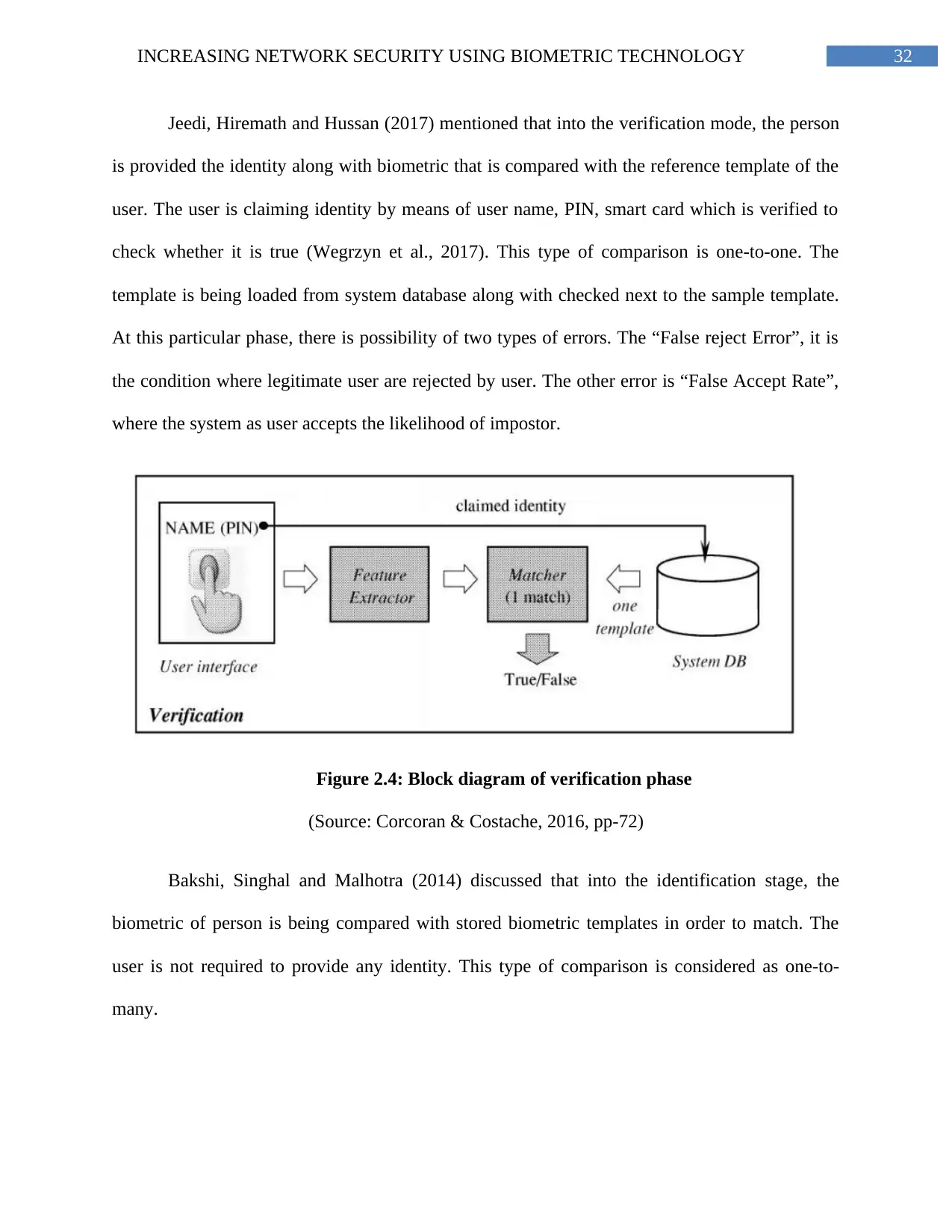
32INCREASING NETWORK SECURITY USING BIOMETRIC TECHNOLOGY
Jeedi, Hiremath and Hussan (2017) mentioned that into the verification mode, the person
is provided the identity along with biometric that is compared with the reference template of the
user. The user is claiming identity by means of user name, PIN, smart card which is verified to
check whether it is true (Wegrzyn et al., 2017). This type of comparison is one-to-one. The
template is being loaded from system database along with checked next to the sample template.
At this particular phase, there is possibility of two types of errors. The “False reject Error”, it is
the condition where legitimate user are rejected by user. The other error is “False Accept Rate”,
where the system as user accepts the likelihood of impostor.
Figure 2.4: Block diagram of verification phase
(Source: Corcoran & Costache, 2016, pp-72)
Bakshi, Singhal and Malhotra (2014) discussed that into the identification stage, the
biometric of person is being compared with stored biometric templates in order to match. The
user is not required to provide any identity. This type of comparison is considered as one-to-
many.
Jeedi, Hiremath and Hussan (2017) mentioned that into the verification mode, the person
is provided the identity along with biometric that is compared with the reference template of the
user. The user is claiming identity by means of user name, PIN, smart card which is verified to
check whether it is true (Wegrzyn et al., 2017). This type of comparison is one-to-one. The
template is being loaded from system database along with checked next to the sample template.
At this particular phase, there is possibility of two types of errors. The “False reject Error”, it is
the condition where legitimate user are rejected by user. The other error is “False Accept Rate”,
where the system as user accepts the likelihood of impostor.
Figure 2.4: Block diagram of verification phase
(Source: Corcoran & Costache, 2016, pp-72)
Bakshi, Singhal and Malhotra (2014) discussed that into the identification stage, the
biometric of person is being compared with stored biometric templates in order to match. The
user is not required to provide any identity. This type of comparison is considered as one-to-
many.
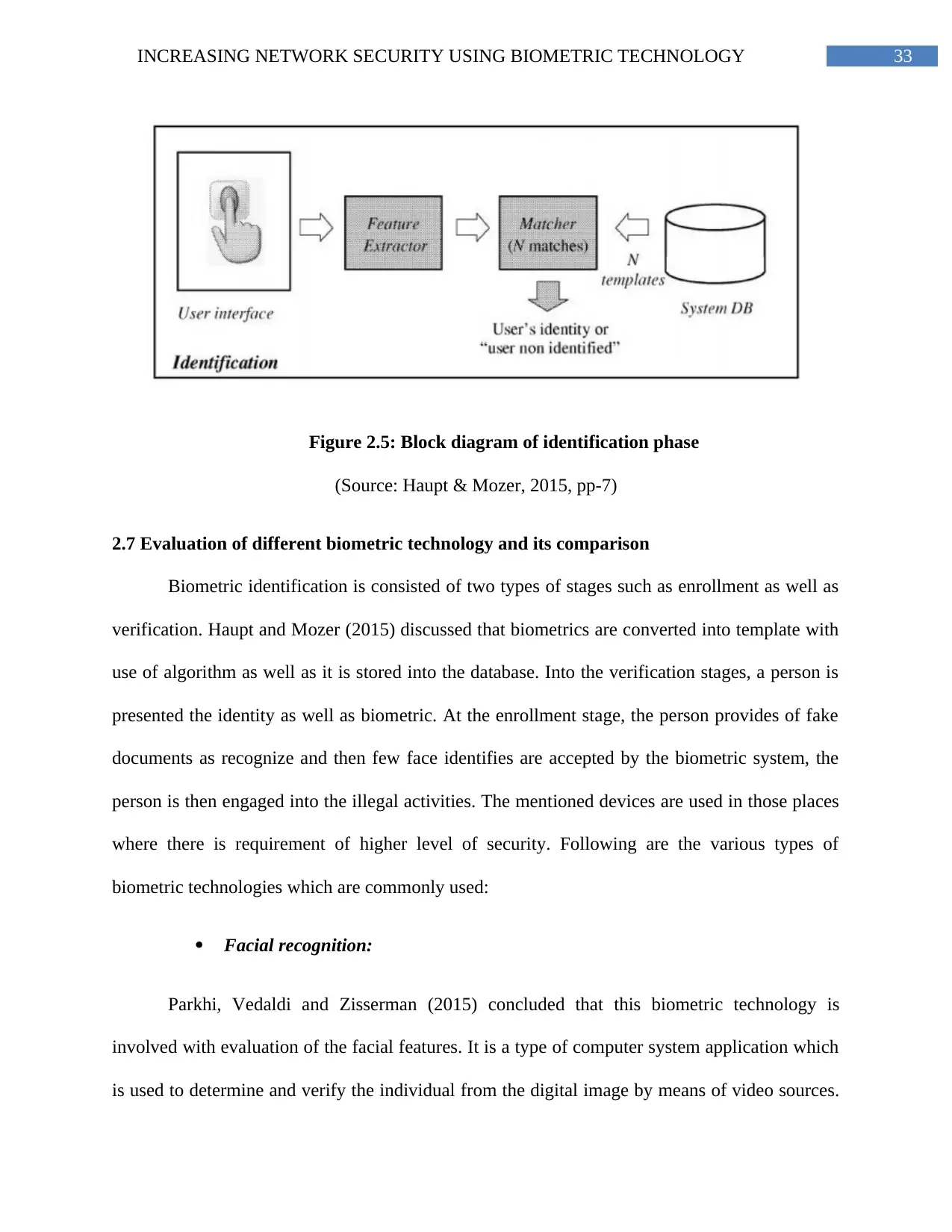
33INCREASING NETWORK SECURITY USING BIOMETRIC TECHNOLOGY
Figure 2.5: Block diagram of identification phase
(Source: Haupt & Mozer, 2015, pp-7)
2.7 Evaluation of different biometric technology and its comparison
Biometric identification is consisted of two types of stages such as enrollment as well as
verification. Haupt and Mozer (2015) discussed that biometrics are converted into template with
use of algorithm as well as it is stored into the database. Into the verification stages, a person is
presented the identity as well as biometric. At the enrollment stage, the person provides of fake
documents as recognize and then few face identifies are accepted by the biometric system, the
person is then engaged into the illegal activities. The mentioned devices are used in those places
where there is requirement of higher level of security. Following are the various types of
biometric technologies which are commonly used:
Facial recognition:
Parkhi, Vedaldi and Zisserman (2015) concluded that this biometric technology is
involved with evaluation of the facial features. It is a type of computer system application which
is used to determine and verify the individual from the digital image by means of video sources.
Figure 2.5: Block diagram of identification phase
(Source: Haupt & Mozer, 2015, pp-7)
2.7 Evaluation of different biometric technology and its comparison
Biometric identification is consisted of two types of stages such as enrollment as well as
verification. Haupt and Mozer (2015) discussed that biometrics are converted into template with
use of algorithm as well as it is stored into the database. Into the verification stages, a person is
presented the identity as well as biometric. At the enrollment stage, the person provides of fake
documents as recognize and then few face identifies are accepted by the biometric system, the
person is then engaged into the illegal activities. The mentioned devices are used in those places
where there is requirement of higher level of security. Following are the various types of
biometric technologies which are commonly used:
Facial recognition:
Parkhi, Vedaldi and Zisserman (2015) concluded that this biometric technology is
involved with evaluation of the facial features. It is a type of computer system application which
is used to determine and verify the individual from the digital image by means of video sources.
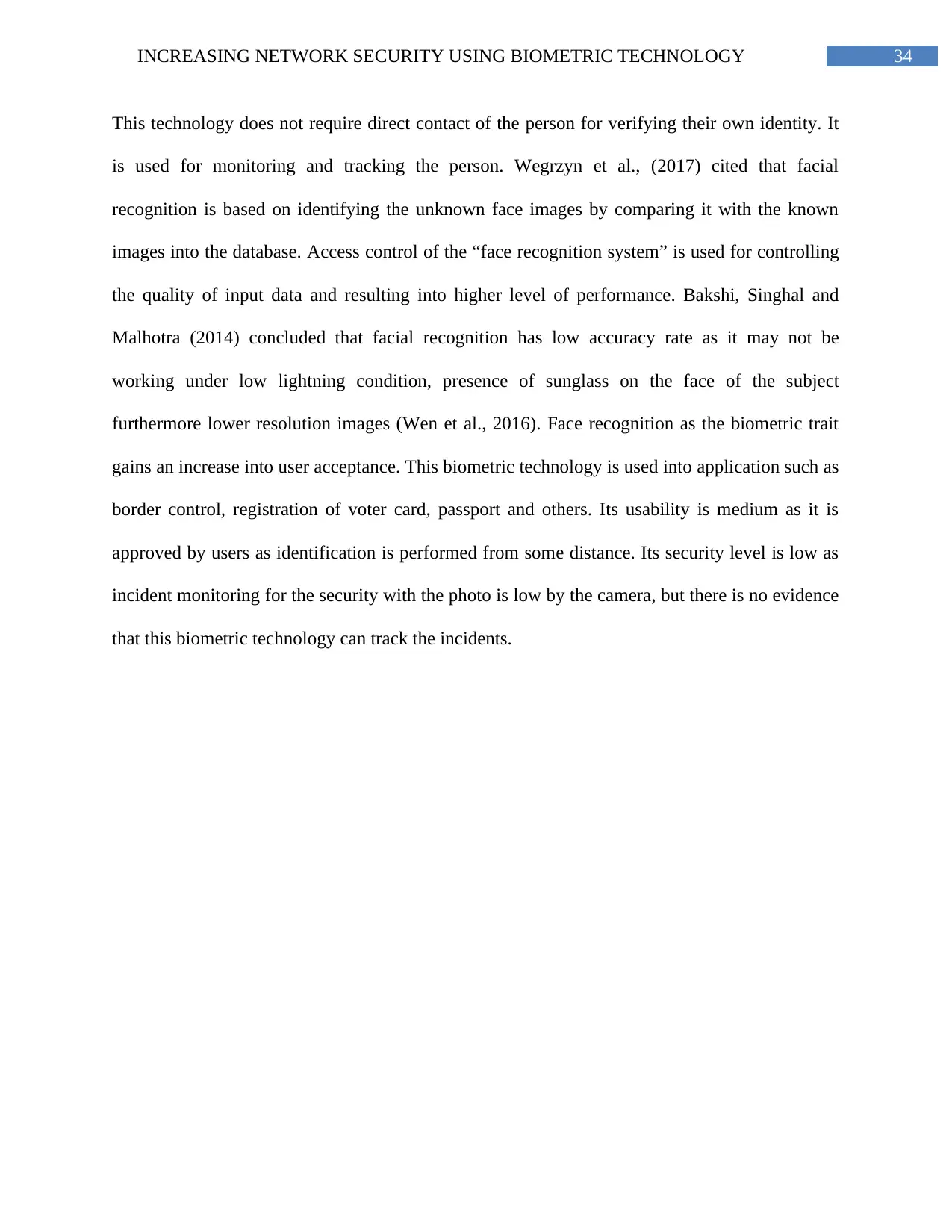
34INCREASING NETWORK SECURITY USING BIOMETRIC TECHNOLOGY
This technology does not require direct contact of the person for verifying their own identity. It
is used for monitoring and tracking the person. Wegrzyn et al., (2017) cited that facial
recognition is based on identifying the unknown face images by comparing it with the known
images into the database. Access control of the “face recognition system” is used for controlling
the quality of input data and resulting into higher level of performance. Bakshi, Singhal and
Malhotra (2014) concluded that facial recognition has low accuracy rate as it may not be
working under low lightning condition, presence of sunglass on the face of the subject
furthermore lower resolution images (Wen et al., 2016). Face recognition as the biometric trait
gains an increase into user acceptance. This biometric technology is used into application such as
border control, registration of voter card, passport and others. Its usability is medium as it is
approved by users as identification is performed from some distance. Its security level is low as
incident monitoring for the security with the photo is low by the camera, but there is no evidence
that this biometric technology can track the incidents.
This technology does not require direct contact of the person for verifying their own identity. It
is used for monitoring and tracking the person. Wegrzyn et al., (2017) cited that facial
recognition is based on identifying the unknown face images by comparing it with the known
images into the database. Access control of the “face recognition system” is used for controlling
the quality of input data and resulting into higher level of performance. Bakshi, Singhal and
Malhotra (2014) concluded that facial recognition has low accuracy rate as it may not be
working under low lightning condition, presence of sunglass on the face of the subject
furthermore lower resolution images (Wen et al., 2016). Face recognition as the biometric trait
gains an increase into user acceptance. This biometric technology is used into application such as
border control, registration of voter card, passport and others. Its usability is medium as it is
approved by users as identification is performed from some distance. Its security level is low as
incident monitoring for the security with the photo is low by the camera, but there is no evidence
that this biometric technology can track the incidents.
Secure Best Marks with AI Grader
Need help grading? Try our AI Grader for instant feedback on your assignments.
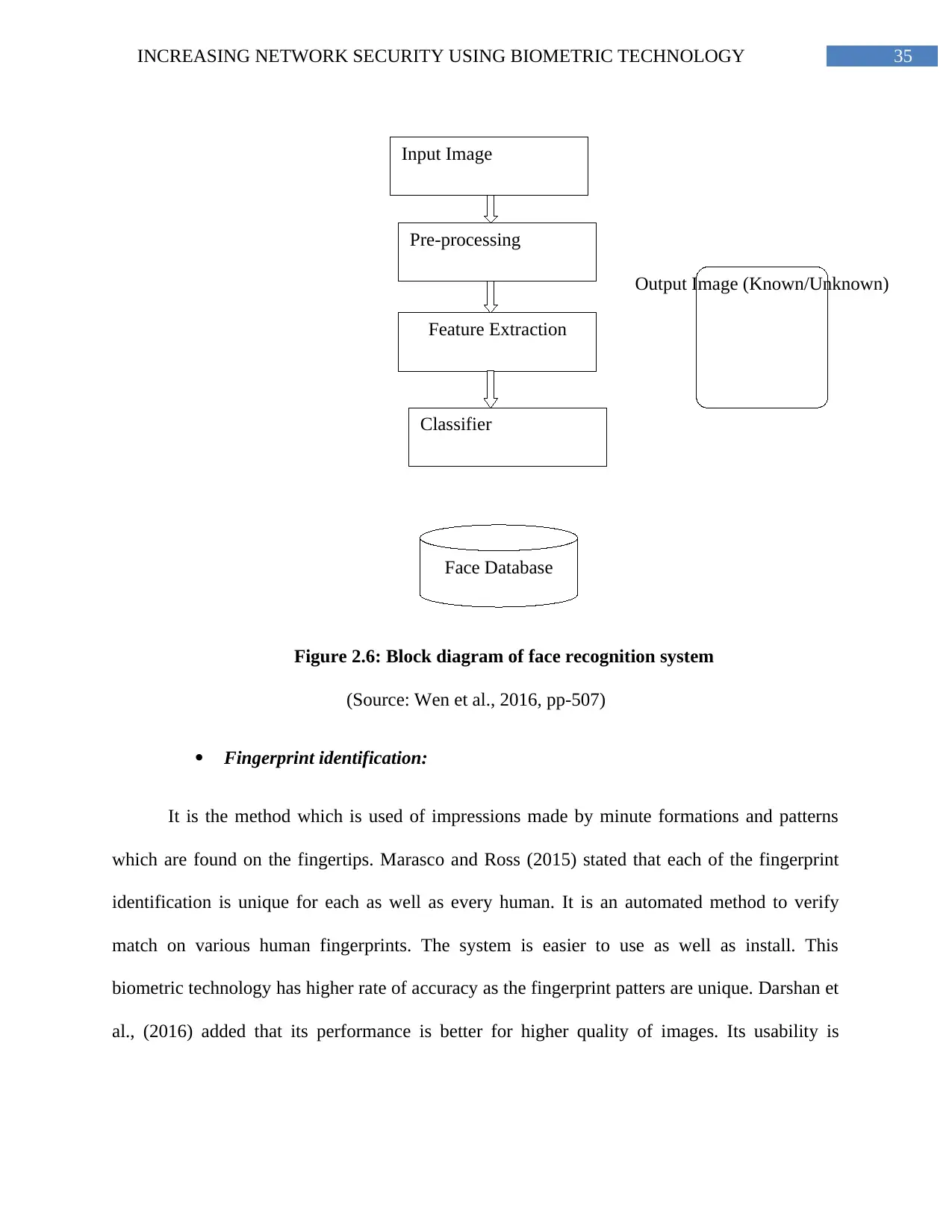
35INCREASING NETWORK SECURITY USING BIOMETRIC TECHNOLOGY
Input Image
Pre-processing
Feature Extraction
Classifier
Output Image (Known/Unknown)
Face Database
Figure 2.6: Block diagram of face recognition system
(Source: Wen et al., 2016, pp-507)
Fingerprint identification:
It is the method which is used of impressions made by minute formations and patterns
which are found on the fingertips. Marasco and Ross (2015) stated that each of the fingerprint
identification is unique for each as well as every human. It is an automated method to verify
match on various human fingerprints. The system is easier to use as well as install. This
biometric technology has higher rate of accuracy as the fingerprint patters are unique. Darshan et
al., (2016) added that its performance is better for higher quality of images. Its usability is
Input Image
Pre-processing
Feature Extraction
Classifier
Output Image (Known/Unknown)
Face Database
Figure 2.6: Block diagram of face recognition system
(Source: Wen et al., 2016, pp-507)
Fingerprint identification:
It is the method which is used of impressions made by minute formations and patterns
which are found on the fingertips. Marasco and Ross (2015) stated that each of the fingerprint
identification is unique for each as well as every human. It is an automated method to verify
match on various human fingerprints. The system is easier to use as well as install. This
biometric technology has higher rate of accuracy as the fingerprint patters are unique. Darshan et
al., (2016) added that its performance is better for higher quality of images. Its usability is
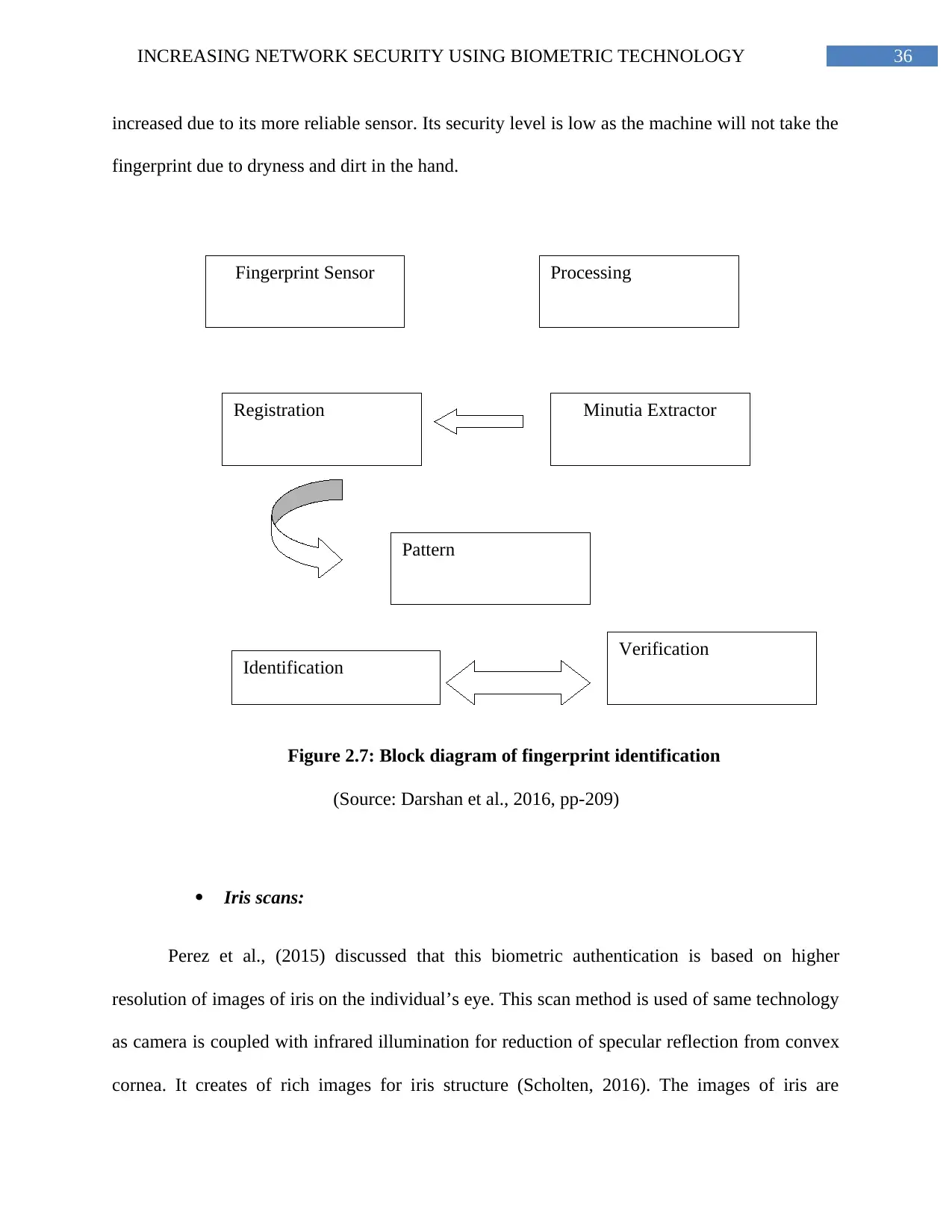
36INCREASING NETWORK SECURITY USING BIOMETRIC TECHNOLOGY
Fingerprint Sensor
Pattern
Registration Minutia Extractor
Processing
Verification
Identification
increased due to its more reliable sensor. Its security level is low as the machine will not take the
fingerprint due to dryness and dirt in the hand.
Figure 2.7: Block diagram of fingerprint identification
(Source: Darshan et al., 2016, pp-209)
Iris scans:
Perez et al., (2015) discussed that this biometric authentication is based on higher
resolution of images of iris on the individual’s eye. This scan method is used of same technology
as camera is coupled with infrared illumination for reduction of specular reflection from convex
cornea. It creates of rich images for iris structure (Scholten, 2016). The images of iris are
Fingerprint Sensor
Pattern
Registration Minutia Extractor
Processing
Verification
Identification
increased due to its more reliable sensor. Its security level is low as the machine will not take the
fingerprint due to dryness and dirt in the hand.
Figure 2.7: Block diagram of fingerprint identification
(Source: Darshan et al., 2016, pp-209)
Iris scans:
Perez et al., (2015) discussed that this biometric authentication is based on higher
resolution of images of iris on the individual’s eye. This scan method is used of same technology
as camera is coupled with infrared illumination for reduction of specular reflection from convex
cornea. It creates of rich images for iris structure (Scholten, 2016). The images of iris are
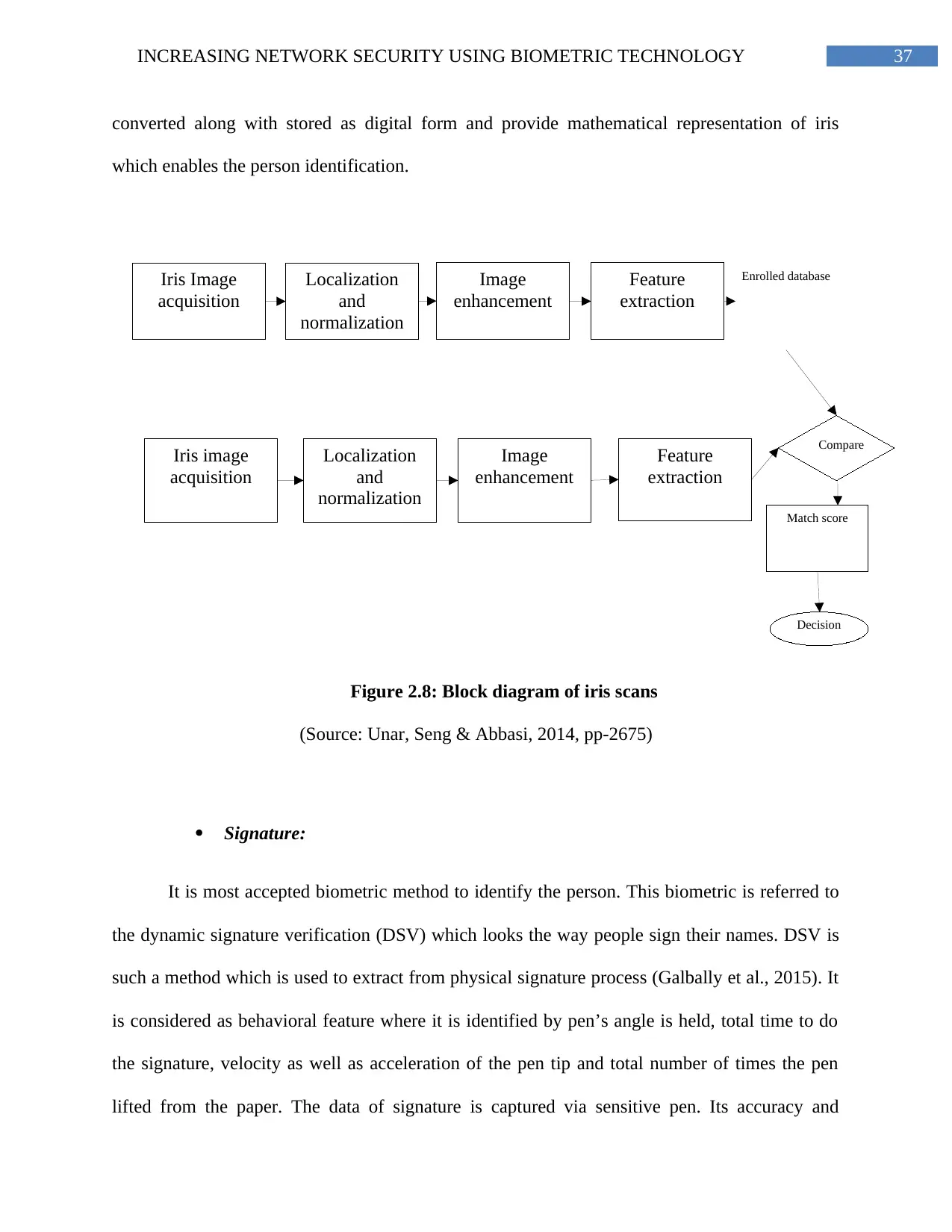
37INCREASING NETWORK SECURITY USING BIOMETRIC TECHNOLOGY
Iris Image
acquisition
Feature
extraction
Feature
extraction
Image
enhancement
Localization
and
normalization
Image
enhancement
Localization
and
normalization
Iris image
acquisition
Enrolled database
Match score
Decision
Compare
converted along with stored as digital form and provide mathematical representation of iris
which enables the person identification.
Figure 2.8: Block diagram of iris scans
(Source: Unar, Seng & Abbasi, 2014, pp-2675)
Signature:
It is most accepted biometric method to identify the person. This biometric is referred to
the dynamic signature verification (DSV) which looks the way people sign their names. DSV is
such a method which is used to extract from physical signature process (Galbally et al., 2015). It
is considered as behavioral feature where it is identified by pen’s angle is held, total time to do
the signature, velocity as well as acceleration of the pen tip and total number of times the pen
lifted from the paper. The data of signature is captured via sensitive pen. Its accuracy and
Iris Image
acquisition
Feature
extraction
Feature
extraction
Image
enhancement
Localization
and
normalization
Image
enhancement
Localization
and
normalization
Iris image
acquisition
Enrolled database
Match score
Decision
Compare
converted along with stored as digital form and provide mathematical representation of iris
which enables the person identification.
Figure 2.8: Block diagram of iris scans
(Source: Unar, Seng & Abbasi, 2014, pp-2675)
Signature:
It is most accepted biometric method to identify the person. This biometric is referred to
the dynamic signature verification (DSV) which looks the way people sign their names. DSV is
such a method which is used to extract from physical signature process (Galbally et al., 2015). It
is considered as behavioral feature where it is identified by pen’s angle is held, total time to do
the signature, velocity as well as acceleration of the pen tip and total number of times the pen
lifted from the paper. The data of signature is captured via sensitive pen. Its accuracy and
Paraphrase This Document
Need a fresh take? Get an instant paraphrase of this document with our AI Paraphraser
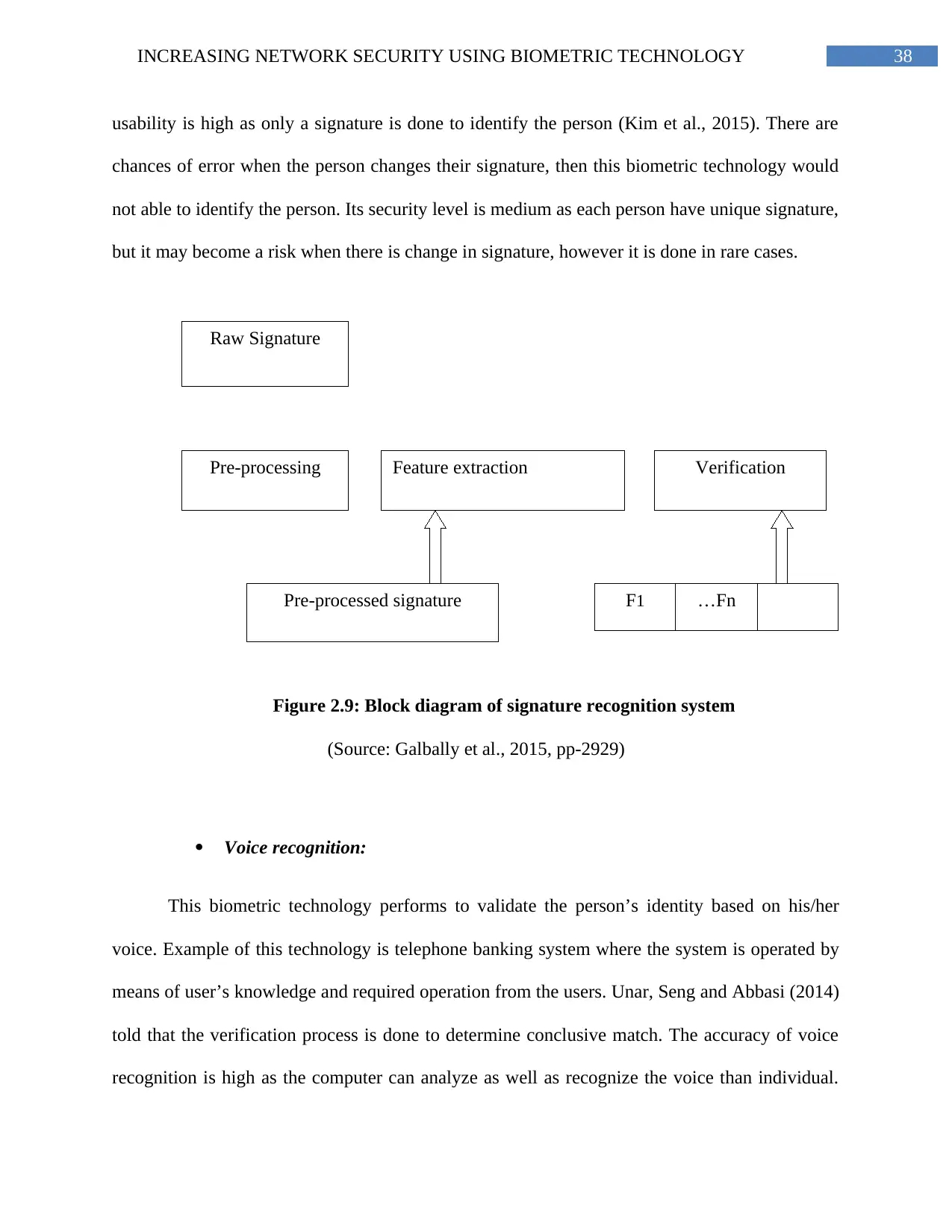
38INCREASING NETWORK SECURITY USING BIOMETRIC TECHNOLOGY
Raw Signature
Pre-processing Feature extraction Verification
Pre-processed signature F1 …Fn
usability is high as only a signature is done to identify the person (Kim et al., 2015). There are
chances of error when the person changes their signature, then this biometric technology would
not able to identify the person. Its security level is medium as each person have unique signature,
but it may become a risk when there is change in signature, however it is done in rare cases.
Figure 2.9: Block diagram of signature recognition system
(Source: Galbally et al., 2015, pp-2929)
Voice recognition:
This biometric technology performs to validate the person’s identity based on his/her
voice. Example of this technology is telephone banking system where the system is operated by
means of user’s knowledge and required operation from the users. Unar, Seng and Abbasi (2014)
told that the verification process is done to determine conclusive match. The accuracy of voice
recognition is high as the computer can analyze as well as recognize the voice than individual.
Raw Signature
Pre-processing Feature extraction Verification
Pre-processed signature F1 …Fn
usability is high as only a signature is done to identify the person (Kim et al., 2015). There are
chances of error when the person changes their signature, then this biometric technology would
not able to identify the person. Its security level is medium as each person have unique signature,
but it may become a risk when there is change in signature, however it is done in rare cases.
Figure 2.9: Block diagram of signature recognition system
(Source: Galbally et al., 2015, pp-2929)
Voice recognition:
This biometric technology performs to validate the person’s identity based on his/her
voice. Example of this technology is telephone banking system where the system is operated by
means of user’s knowledge and required operation from the users. Unar, Seng and Abbasi (2014)
told that the verification process is done to determine conclusive match. The accuracy of voice
recognition is high as the computer can analyze as well as recognize the voice than individual.
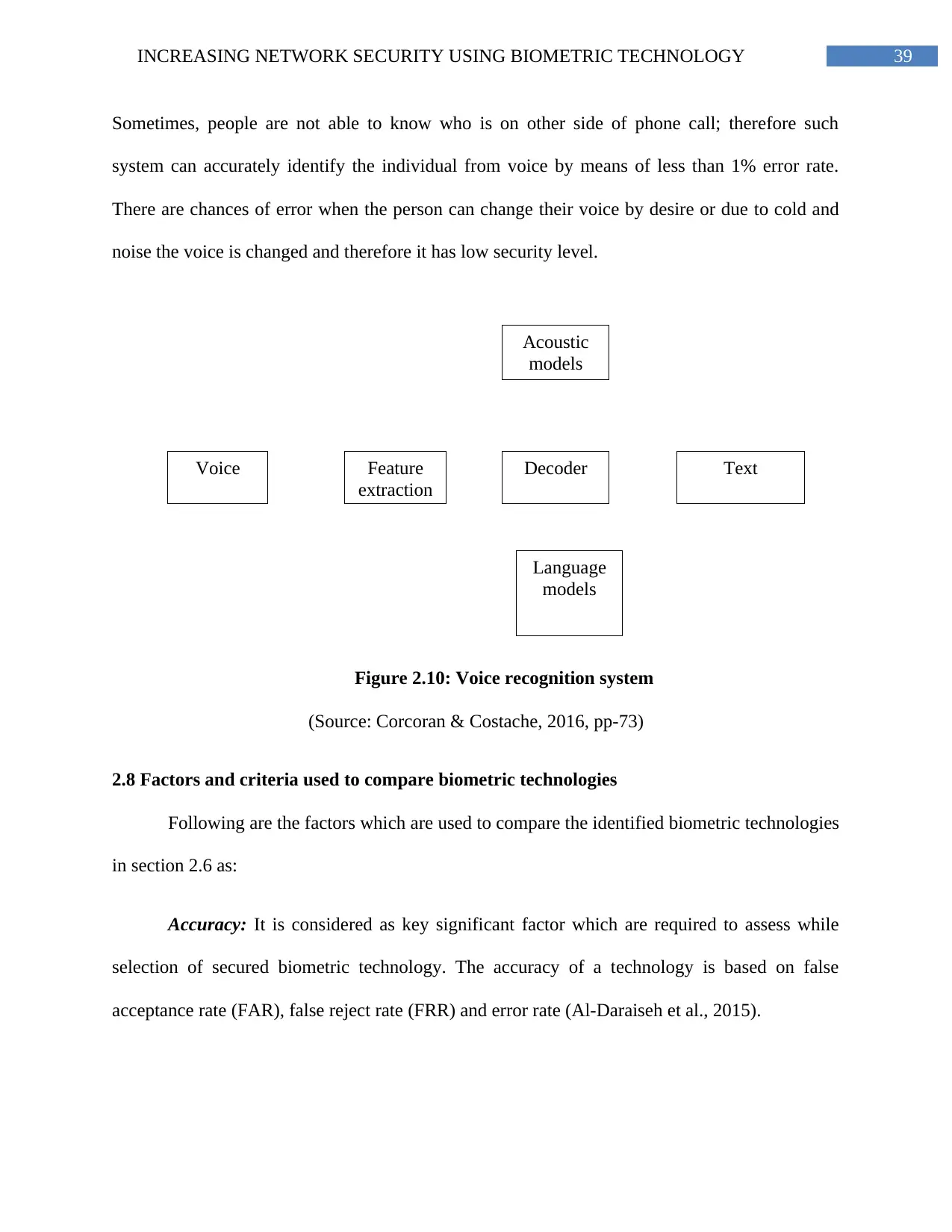
39INCREASING NETWORK SECURITY USING BIOMETRIC TECHNOLOGY
Voice Feature
extraction
Decoder
Acoustic
models
Language
models
Text
Sometimes, people are not able to know who is on other side of phone call; therefore such
system can accurately identify the individual from voice by means of less than 1% error rate.
There are chances of error when the person can change their voice by desire or due to cold and
noise the voice is changed and therefore it has low security level.
Figure 2.10: Voice recognition system
(Source: Corcoran & Costache, 2016, pp-73)
2.8 Factors and criteria used to compare biometric technologies
Following are the factors which are used to compare the identified biometric technologies
in section 2.6 as:
Accuracy: It is considered as key significant factor which are required to assess while
selection of secured biometric technology. The accuracy of a technology is based on false
acceptance rate (FAR), false reject rate (FRR) and error rate (Al-Daraiseh et al., 2015).
Voice Feature
extraction
Decoder
Acoustic
models
Language
models
Text
Sometimes, people are not able to know who is on other side of phone call; therefore such
system can accurately identify the individual from voice by means of less than 1% error rate.
There are chances of error when the person can change their voice by desire or due to cold and
noise the voice is changed and therefore it has low security level.
Figure 2.10: Voice recognition system
(Source: Corcoran & Costache, 2016, pp-73)
2.8 Factors and criteria used to compare biometric technologies
Following are the factors which are used to compare the identified biometric technologies
in section 2.6 as:
Accuracy: It is considered as key significant factor which are required to assess while
selection of secured biometric technology. The accuracy of a technology is based on false
acceptance rate (FAR), false reject rate (FRR) and error rate (Al-Daraiseh et al., 2015).
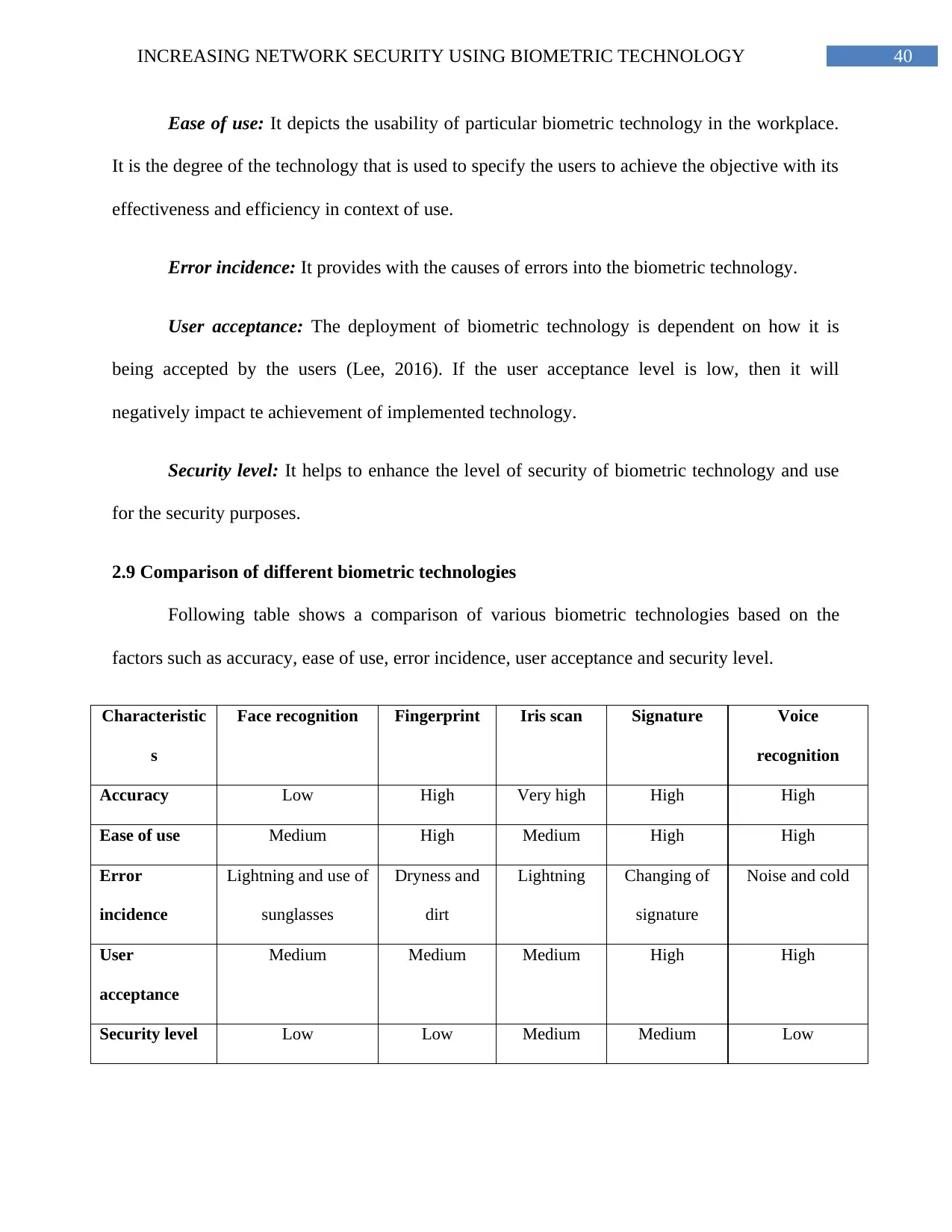
40INCREASING NETWORK SECURITY USING BIOMETRIC TECHNOLOGY
Ease of use: It depicts the usability of particular biometric technology in the workplace.
It is the degree of the technology that is used to specify the users to achieve the objective with its
effectiveness and efficiency in context of use.
Error incidence: It provides with the causes of errors into the biometric technology.
User acceptance: The deployment of biometric technology is dependent on how it is
being accepted by the users (Lee, 2016). If the user acceptance level is low, then it will
negatively impact te achievement of implemented technology.
Security level: It helps to enhance the level of security of biometric technology and use
for the security purposes.
2.9 Comparison of different biometric technologies
Following table shows a comparison of various biometric technologies based on the
factors such as accuracy, ease of use, error incidence, user acceptance and security level.
Characteristic
s
Face recognition Fingerprint Iris scan Signature Voice
recognition
Accuracy Low High Very high High High
Ease of use Medium High Medium High High
Error
incidence
Lightning and use of
sunglasses
Dryness and
dirt
Lightning Changing of
signature
Noise and cold
User
acceptance
Medium Medium Medium High High
Security level Low Low Medium Medium Low
Ease of use: It depicts the usability of particular biometric technology in the workplace.
It is the degree of the technology that is used to specify the users to achieve the objective with its
effectiveness and efficiency in context of use.
Error incidence: It provides with the causes of errors into the biometric technology.
User acceptance: The deployment of biometric technology is dependent on how it is
being accepted by the users (Lee, 2016). If the user acceptance level is low, then it will
negatively impact te achievement of implemented technology.
Security level: It helps to enhance the level of security of biometric technology and use
for the security purposes.
2.9 Comparison of different biometric technologies
Following table shows a comparison of various biometric technologies based on the
factors such as accuracy, ease of use, error incidence, user acceptance and security level.
Characteristic
s
Face recognition Fingerprint Iris scan Signature Voice
recognition
Accuracy Low High Very high High High
Ease of use Medium High Medium High High
Error
incidence
Lightning and use of
sunglasses
Dryness and
dirt
Lightning Changing of
signature
Noise and cold
User
acceptance
Medium Medium Medium High High
Security level Low Low Medium Medium Low
Secure Best Marks with AI Grader
Need help grading? Try our AI Grader for instant feedback on your assignments.
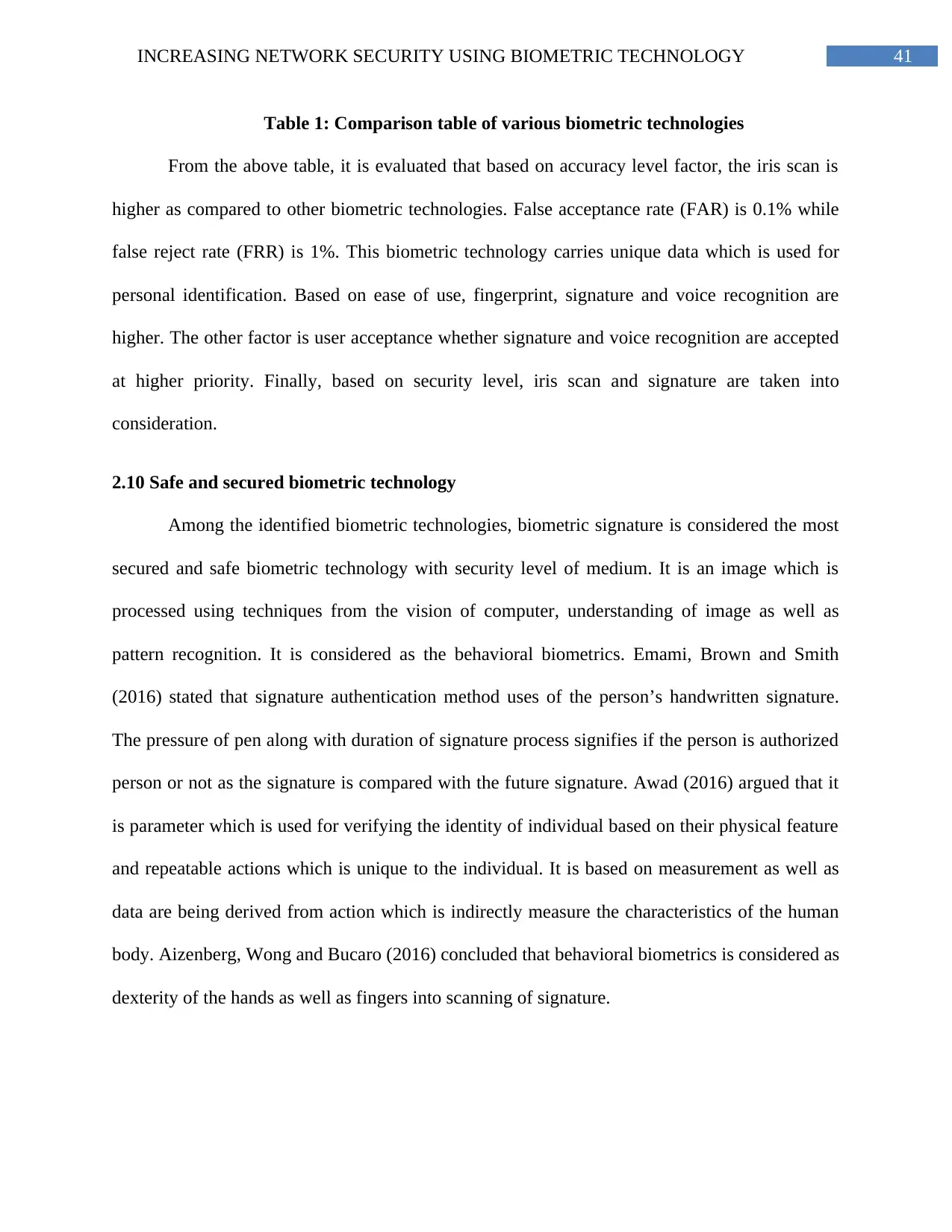
41INCREASING NETWORK SECURITY USING BIOMETRIC TECHNOLOGY
Table 1: Comparison table of various biometric technologies
From the above table, it is evaluated that based on accuracy level factor, the iris scan is
higher as compared to other biometric technologies. False acceptance rate (FAR) is 0.1% while
false reject rate (FRR) is 1%. This biometric technology carries unique data which is used for
personal identification. Based on ease of use, fingerprint, signature and voice recognition are
higher. The other factor is user acceptance whether signature and voice recognition are accepted
at higher priority. Finally, based on security level, iris scan and signature are taken into
consideration.
2.10 Safe and secured biometric technology
Among the identified biometric technologies, biometric signature is considered the most
secured and safe biometric technology with security level of medium. It is an image which is
processed using techniques from the vision of computer, understanding of image as well as
pattern recognition. It is considered as the behavioral biometrics. Emami, Brown and Smith
(2016) stated that signature authentication method uses of the person’s handwritten signature.
The pressure of pen along with duration of signature process signifies if the person is authorized
person or not as the signature is compared with the future signature. Awad (2016) argued that it
is parameter which is used for verifying the identity of individual based on their physical feature
and repeatable actions which is unique to the individual. It is based on measurement as well as
data are being derived from action which is indirectly measure the characteristics of the human
body. Aizenberg, Wong and Bucaro (2016) concluded that behavioral biometrics is considered as
dexterity of the hands as well as fingers into scanning of signature.
Table 1: Comparison table of various biometric technologies
From the above table, it is evaluated that based on accuracy level factor, the iris scan is
higher as compared to other biometric technologies. False acceptance rate (FAR) is 0.1% while
false reject rate (FRR) is 1%. This biometric technology carries unique data which is used for
personal identification. Based on ease of use, fingerprint, signature and voice recognition are
higher. The other factor is user acceptance whether signature and voice recognition are accepted
at higher priority. Finally, based on security level, iris scan and signature are taken into
consideration.
2.10 Safe and secured biometric technology
Among the identified biometric technologies, biometric signature is considered the most
secured and safe biometric technology with security level of medium. It is an image which is
processed using techniques from the vision of computer, understanding of image as well as
pattern recognition. It is considered as the behavioral biometrics. Emami, Brown and Smith
(2016) stated that signature authentication method uses of the person’s handwritten signature.
The pressure of pen along with duration of signature process signifies if the person is authorized
person or not as the signature is compared with the future signature. Awad (2016) argued that it
is parameter which is used for verifying the identity of individual based on their physical feature
and repeatable actions which is unique to the individual. It is based on measurement as well as
data are being derived from action which is indirectly measure the characteristics of the human
body. Aizenberg, Wong and Bucaro (2016) concluded that behavioral biometrics is considered as
dexterity of the hands as well as fingers into scanning of signature.
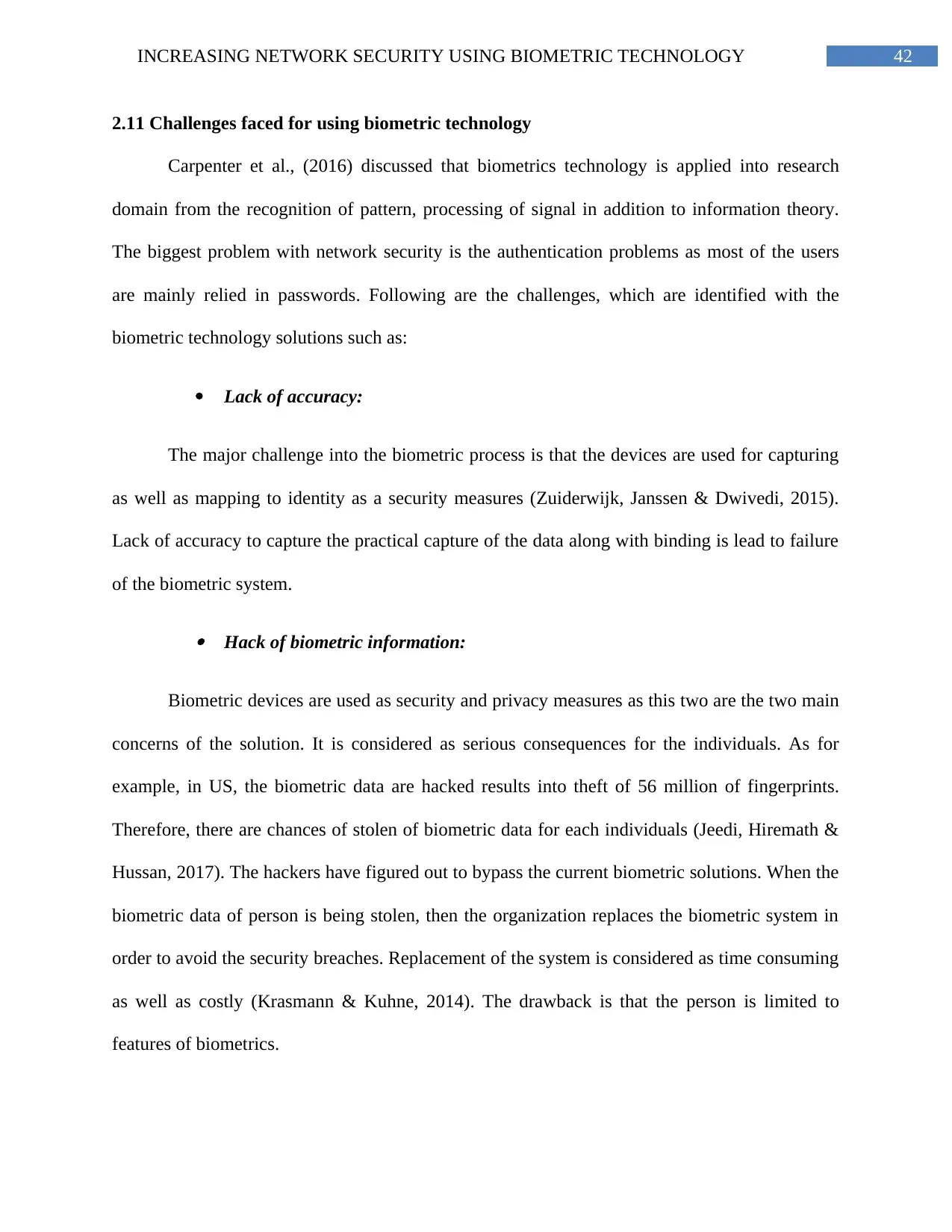
42INCREASING NETWORK SECURITY USING BIOMETRIC TECHNOLOGY
2.11 Challenges faced for using biometric technology
Carpenter et al., (2016) discussed that biometrics technology is applied into research
domain from the recognition of pattern, processing of signal in addition to information theory.
The biggest problem with network security is the authentication problems as most of the users
are mainly relied in passwords. Following are the challenges, which are identified with the
biometric technology solutions such as:
Lack of accuracy:
The major challenge into the biometric process is that the devices are used for capturing
as well as mapping to identity as a security measures (Zuiderwijk, Janssen & Dwivedi, 2015).
Lack of accuracy to capture the practical capture of the data along with binding is lead to failure
of the biometric system. Hack of biometric information:
Biometric devices are used as security and privacy measures as this two are the two main
concerns of the solution. It is considered as serious consequences for the individuals. As for
example, in US, the biometric data are hacked results into theft of 56 million of fingerprints.
Therefore, there are chances of stolen of biometric data for each individuals (Jeedi, Hiremath &
Hussan, 2017). The hackers have figured out to bypass the current biometric solutions. When the
biometric data of person is being stolen, then the organization replaces the biometric system in
order to avoid the security breaches. Replacement of the system is considered as time consuming
as well as costly (Krasmann & Kuhne, 2014). The drawback is that the person is limited to
features of biometrics.
2.11 Challenges faced for using biometric technology
Carpenter et al., (2016) discussed that biometrics technology is applied into research
domain from the recognition of pattern, processing of signal in addition to information theory.
The biggest problem with network security is the authentication problems as most of the users
are mainly relied in passwords. Following are the challenges, which are identified with the
biometric technology solutions such as:
Lack of accuracy:
The major challenge into the biometric process is that the devices are used for capturing
as well as mapping to identity as a security measures (Zuiderwijk, Janssen & Dwivedi, 2015).
Lack of accuracy to capture the practical capture of the data along with binding is lead to failure
of the biometric system. Hack of biometric information:
Biometric devices are used as security and privacy measures as this two are the two main
concerns of the solution. It is considered as serious consequences for the individuals. As for
example, in US, the biometric data are hacked results into theft of 56 million of fingerprints.
Therefore, there are chances of stolen of biometric data for each individuals (Jeedi, Hiremath &
Hussan, 2017). The hackers have figured out to bypass the current biometric solutions. When the
biometric data of person is being stolen, then the organization replaces the biometric system in
order to avoid the security breaches. Replacement of the system is considered as time consuming
as well as costly (Krasmann & Kuhne, 2014). The drawback is that the person is limited to
features of biometrics.
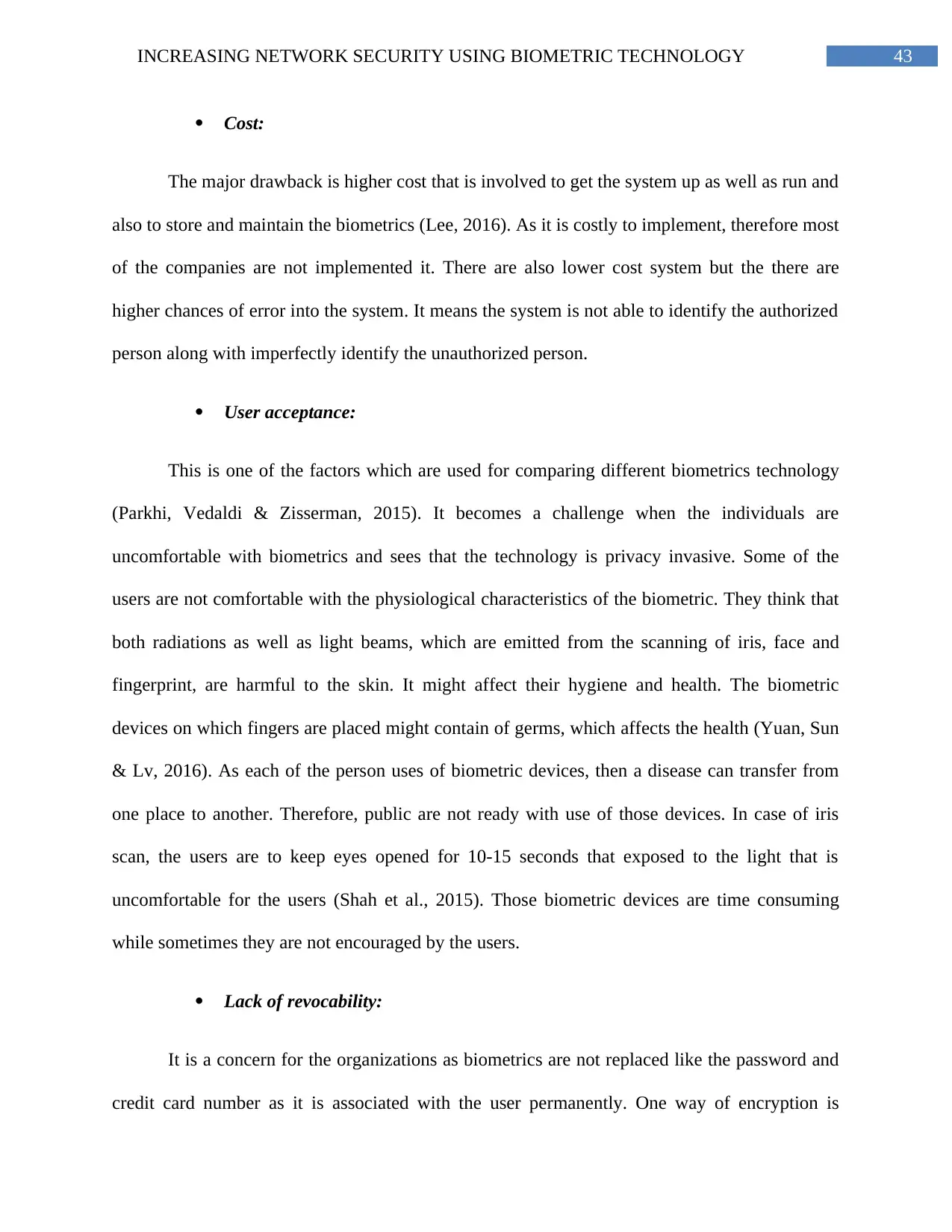
43INCREASING NETWORK SECURITY USING BIOMETRIC TECHNOLOGY
Cost:
The major drawback is higher cost that is involved to get the system up as well as run and
also to store and maintain the biometrics (Lee, 2016). As it is costly to implement, therefore most
of the companies are not implemented it. There are also lower cost system but the there are
higher chances of error into the system. It means the system is not able to identify the authorized
person along with imperfectly identify the unauthorized person.
User acceptance:
This is one of the factors which are used for comparing different biometrics technology
(Parkhi, Vedaldi & Zisserman, 2015). It becomes a challenge when the individuals are
uncomfortable with biometrics and sees that the technology is privacy invasive. Some of the
users are not comfortable with the physiological characteristics of the biometric. They think that
both radiations as well as light beams, which are emitted from the scanning of iris, face and
fingerprint, are harmful to the skin. It might affect their hygiene and health. The biometric
devices on which fingers are placed might contain of germs, which affects the health (Yuan, Sun
& Lv, 2016). As each of the person uses of biometric devices, then a disease can transfer from
one place to another. Therefore, public are not ready with use of those devices. In case of iris
scan, the users are to keep eyes opened for 10-15 seconds that exposed to the light that is
uncomfortable for the users (Shah et al., 2015). Those biometric devices are time consuming
while sometimes they are not encouraged by the users.
Lack of revocability:
It is a concern for the organizations as biometrics are not replaced like the password and
credit card number as it is associated with the user permanently. One way of encryption is
Cost:
The major drawback is higher cost that is involved to get the system up as well as run and
also to store and maintain the biometrics (Lee, 2016). As it is costly to implement, therefore most
of the companies are not implemented it. There are also lower cost system but the there are
higher chances of error into the system. It means the system is not able to identify the authorized
person along with imperfectly identify the unauthorized person.
User acceptance:
This is one of the factors which are used for comparing different biometrics technology
(Parkhi, Vedaldi & Zisserman, 2015). It becomes a challenge when the individuals are
uncomfortable with biometrics and sees that the technology is privacy invasive. Some of the
users are not comfortable with the physiological characteristics of the biometric. They think that
both radiations as well as light beams, which are emitted from the scanning of iris, face and
fingerprint, are harmful to the skin. It might affect their hygiene and health. The biometric
devices on which fingers are placed might contain of germs, which affects the health (Yuan, Sun
& Lv, 2016). As each of the person uses of biometric devices, then a disease can transfer from
one place to another. Therefore, public are not ready with use of those devices. In case of iris
scan, the users are to keep eyes opened for 10-15 seconds that exposed to the light that is
uncomfortable for the users (Shah et al., 2015). Those biometric devices are time consuming
while sometimes they are not encouraged by the users.
Lack of revocability:
It is a concern for the organizations as biometrics are not replaced like the password and
credit card number as it is associated with the user permanently. One way of encryption is
Paraphrase This Document
Need a fresh take? Get an instant paraphrase of this document with our AI Paraphraser
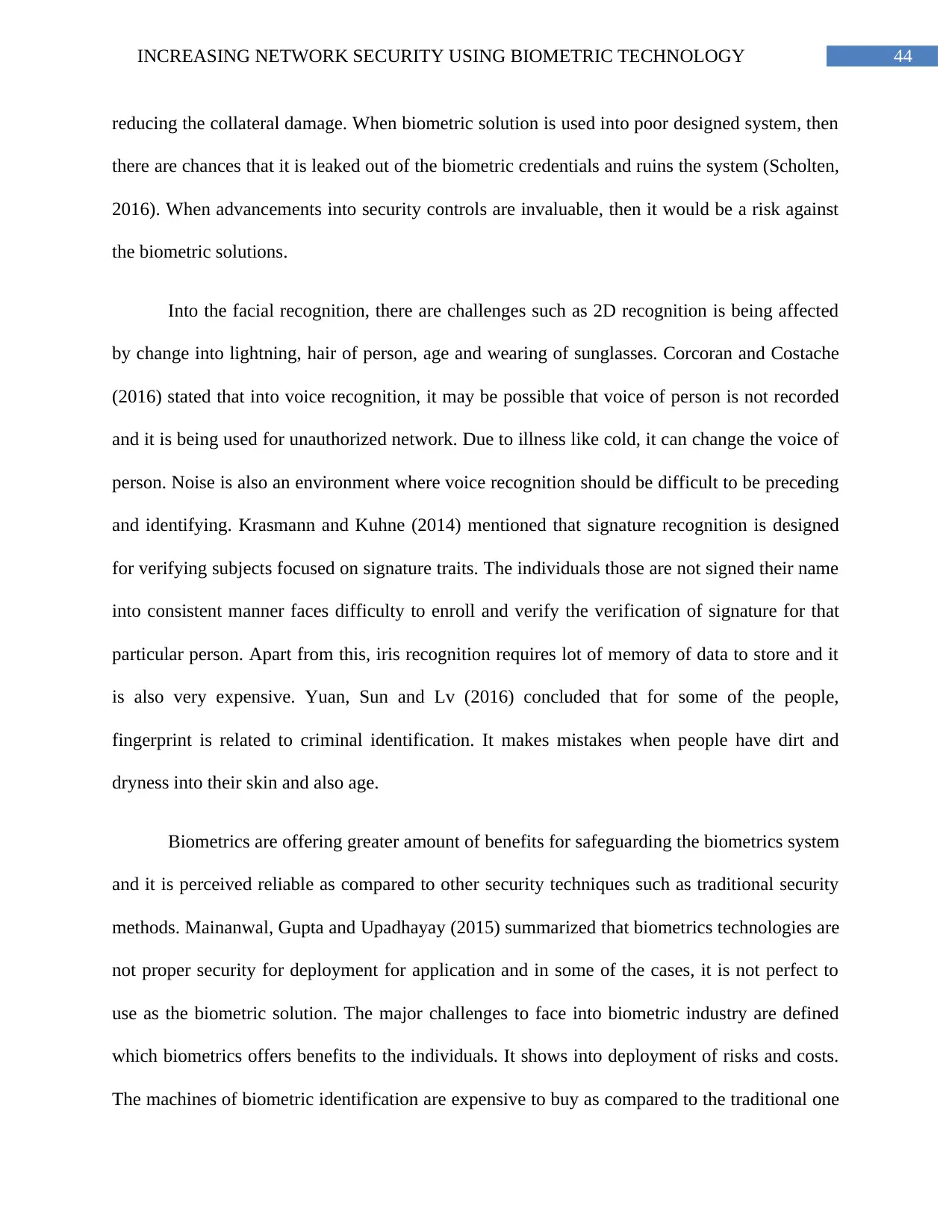
44INCREASING NETWORK SECURITY USING BIOMETRIC TECHNOLOGY
reducing the collateral damage. When biometric solution is used into poor designed system, then
there are chances that it is leaked out of the biometric credentials and ruins the system (Scholten,
2016). When advancements into security controls are invaluable, then it would be a risk against
the biometric solutions.
Into the facial recognition, there are challenges such as 2D recognition is being affected
by change into lightning, hair of person, age and wearing of sunglasses. Corcoran and Costache
(2016) stated that into voice recognition, it may be possible that voice of person is not recorded
and it is being used for unauthorized network. Due to illness like cold, it can change the voice of
person. Noise is also an environment where voice recognition should be difficult to be preceding
and identifying. Krasmann and Kuhne (2014) mentioned that signature recognition is designed
for verifying subjects focused on signature traits. The individuals those are not signed their name
into consistent manner faces difficulty to enroll and verify the verification of signature for that
particular person. Apart from this, iris recognition requires lot of memory of data to store and it
is also very expensive. Yuan, Sun and Lv (2016) concluded that for some of the people,
fingerprint is related to criminal identification. It makes mistakes when people have dirt and
dryness into their skin and also age.
Biometrics are offering greater amount of benefits for safeguarding the biometrics system
and it is perceived reliable as compared to other security techniques such as traditional security
methods. Mainanwal, Gupta and Upadhayay (2015) summarized that biometrics technologies are
not proper security for deployment for application and in some of the cases, it is not perfect to
use as the biometric solution. The major challenges to face into biometric industry are defined
which biometrics offers benefits to the individuals. It shows into deployment of risks and costs.
The machines of biometric identification are expensive to buy as compared to the traditional one
reducing the collateral damage. When biometric solution is used into poor designed system, then
there are chances that it is leaked out of the biometric credentials and ruins the system (Scholten,
2016). When advancements into security controls are invaluable, then it would be a risk against
the biometric solutions.
Into the facial recognition, there are challenges such as 2D recognition is being affected
by change into lightning, hair of person, age and wearing of sunglasses. Corcoran and Costache
(2016) stated that into voice recognition, it may be possible that voice of person is not recorded
and it is being used for unauthorized network. Due to illness like cold, it can change the voice of
person. Noise is also an environment where voice recognition should be difficult to be preceding
and identifying. Krasmann and Kuhne (2014) mentioned that signature recognition is designed
for verifying subjects focused on signature traits. The individuals those are not signed their name
into consistent manner faces difficulty to enroll and verify the verification of signature for that
particular person. Apart from this, iris recognition requires lot of memory of data to store and it
is also very expensive. Yuan, Sun and Lv (2016) concluded that for some of the people,
fingerprint is related to criminal identification. It makes mistakes when people have dirt and
dryness into their skin and also age.
Biometrics are offering greater amount of benefits for safeguarding the biometrics system
and it is perceived reliable as compared to other security techniques such as traditional security
methods. Mainanwal, Gupta and Upadhayay (2015) summarized that biometrics technologies are
not proper security for deployment for application and in some of the cases, it is not perfect to
use as the biometric solution. The major challenges to face into biometric industry are defined
which biometrics offers benefits to the individuals. It shows into deployment of risks and costs.
The machines of biometric identification are expensive to buy as compared to the traditional one
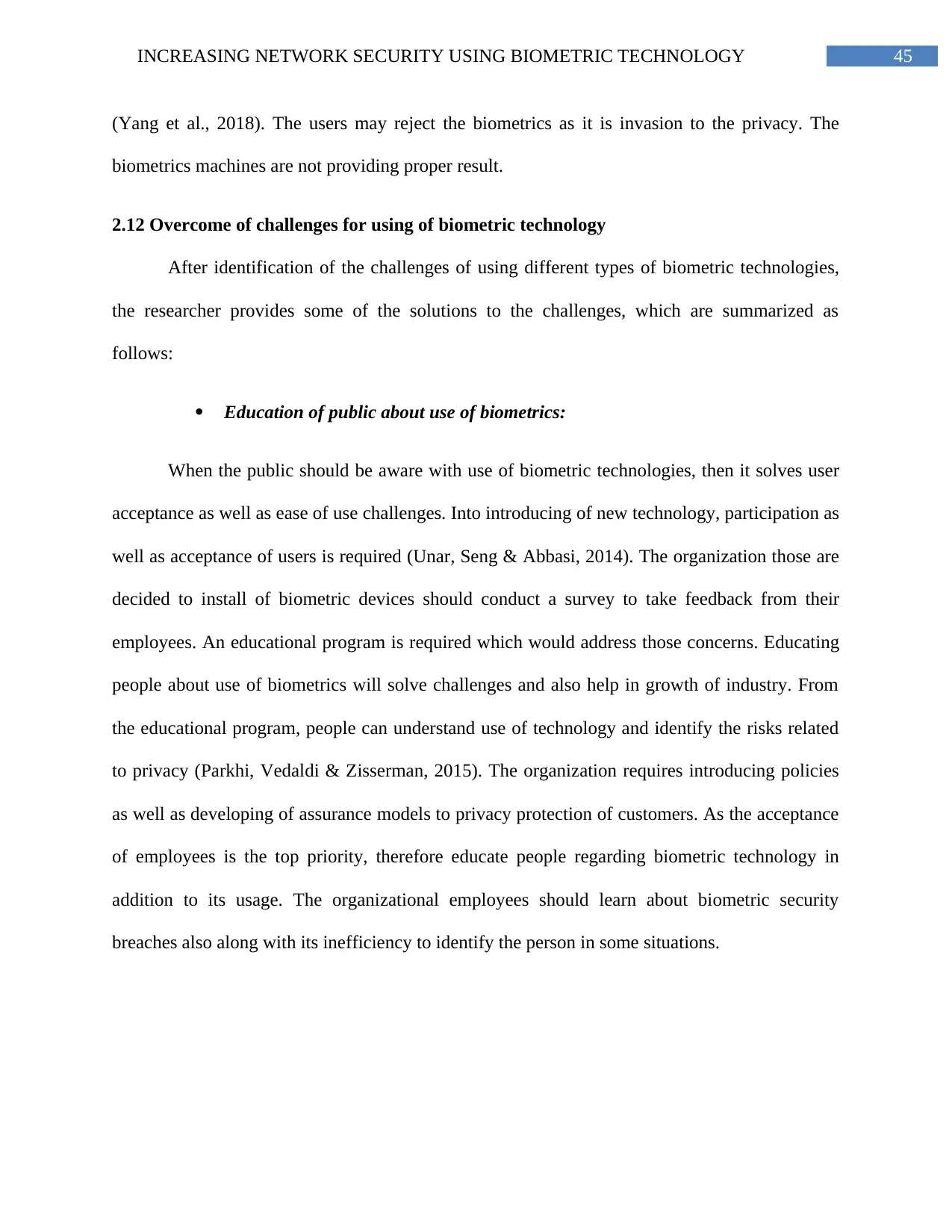
45INCREASING NETWORK SECURITY USING BIOMETRIC TECHNOLOGY
(Yang et al., 2018). The users may reject the biometrics as it is invasion to the privacy. The
biometrics machines are not providing proper result.
2.12 Overcome of challenges for using of biometric technology
After identification of the challenges of using different types of biometric technologies,
the researcher provides some of the solutions to the challenges, which are summarized as
follows:
Education of public about use of biometrics:
When the public should be aware with use of biometric technologies, then it solves user
acceptance as well as ease of use challenges. Into introducing of new technology, participation as
well as acceptance of users is required (Unar, Seng & Abbasi, 2014). The organization those are
decided to install of biometric devices should conduct a survey to take feedback from their
employees. An educational program is required which would address those concerns. Educating
people about use of biometrics will solve challenges and also help in growth of industry. From
the educational program, people can understand use of technology and identify the risks related
to privacy (Parkhi, Vedaldi & Zisserman, 2015). The organization requires introducing policies
as well as developing of assurance models to privacy protection of customers. As the acceptance
of employees is the top priority, therefore educate people regarding biometric technology in
addition to its usage. The organizational employees should learn about biometric security
breaches also along with its inefficiency to identify the person in some situations.
(Yang et al., 2018). The users may reject the biometrics as it is invasion to the privacy. The
biometrics machines are not providing proper result.
2.12 Overcome of challenges for using of biometric technology
After identification of the challenges of using different types of biometric technologies,
the researcher provides some of the solutions to the challenges, which are summarized as
follows:
Education of public about use of biometrics:
When the public should be aware with use of biometric technologies, then it solves user
acceptance as well as ease of use challenges. Into introducing of new technology, participation as
well as acceptance of users is required (Unar, Seng & Abbasi, 2014). The organization those are
decided to install of biometric devices should conduct a survey to take feedback from their
employees. An educational program is required which would address those concerns. Educating
people about use of biometrics will solve challenges and also help in growth of industry. From
the educational program, people can understand use of technology and identify the risks related
to privacy (Parkhi, Vedaldi & Zisserman, 2015). The organization requires introducing policies
as well as developing of assurance models to privacy protection of customers. As the acceptance
of employees is the top priority, therefore educate people regarding biometric technology in
addition to its usage. The organizational employees should learn about biometric security
breaches also along with its inefficiency to identify the person in some situations.
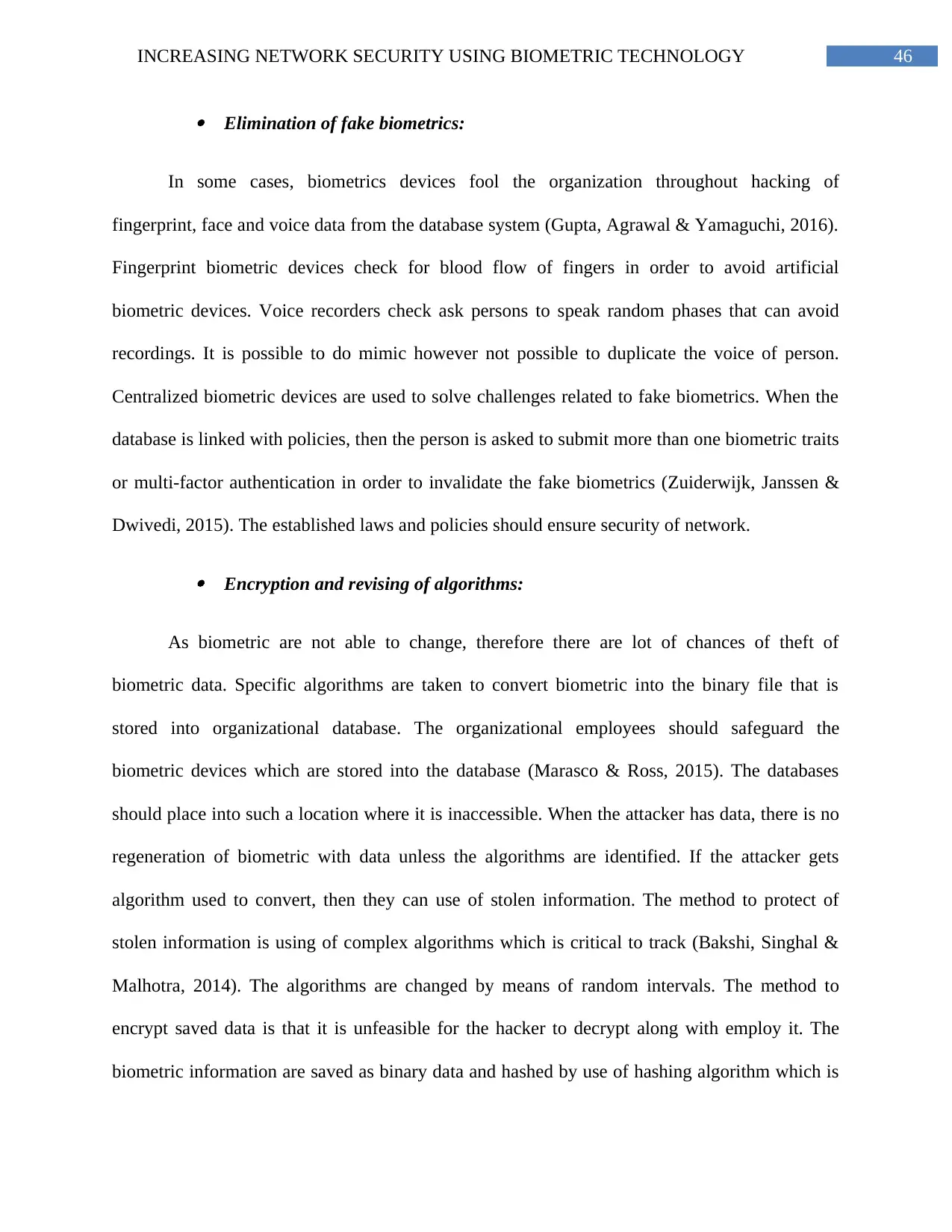
46INCREASING NETWORK SECURITY USING BIOMETRIC TECHNOLOGY
Elimination of fake biometrics:
In some cases, biometrics devices fool the organization throughout hacking of
fingerprint, face and voice data from the database system (Gupta, Agrawal & Yamaguchi, 2016).
Fingerprint biometric devices check for blood flow of fingers in order to avoid artificial
biometric devices. Voice recorders check ask persons to speak random phases that can avoid
recordings. It is possible to do mimic however not possible to duplicate the voice of person.
Centralized biometric devices are used to solve challenges related to fake biometrics. When the
database is linked with policies, then the person is asked to submit more than one biometric traits
or multi-factor authentication in order to invalidate the fake biometrics (Zuiderwijk, Janssen &
Dwivedi, 2015). The established laws and policies should ensure security of network. Encryption and revising of algorithms:
As biometric are not able to change, therefore there are lot of chances of theft of
biometric data. Specific algorithms are taken to convert biometric into the binary file that is
stored into organizational database. The organizational employees should safeguard the
biometric devices which are stored into the database (Marasco & Ross, 2015). The databases
should place into such a location where it is inaccessible. When the attacker has data, there is no
regeneration of biometric with data unless the algorithms are identified. If the attacker gets
algorithm used to convert, then they can use of stolen information. The method to protect of
stolen information is using of complex algorithms which is critical to track (Bakshi, Singhal &
Malhotra, 2014). The algorithms are changed by means of random intervals. The method to
encrypt saved data is that it is unfeasible for the hacker to decrypt along with employ it. The
biometric information are saved as binary data and hashed by use of hashing algorithm which is
Elimination of fake biometrics:
In some cases, biometrics devices fool the organization throughout hacking of
fingerprint, face and voice data from the database system (Gupta, Agrawal & Yamaguchi, 2016).
Fingerprint biometric devices check for blood flow of fingers in order to avoid artificial
biometric devices. Voice recorders check ask persons to speak random phases that can avoid
recordings. It is possible to do mimic however not possible to duplicate the voice of person.
Centralized biometric devices are used to solve challenges related to fake biometrics. When the
database is linked with policies, then the person is asked to submit more than one biometric traits
or multi-factor authentication in order to invalidate the fake biometrics (Zuiderwijk, Janssen &
Dwivedi, 2015). The established laws and policies should ensure security of network. Encryption and revising of algorithms:
As biometric are not able to change, therefore there are lot of chances of theft of
biometric data. Specific algorithms are taken to convert biometric into the binary file that is
stored into organizational database. The organizational employees should safeguard the
biometric devices which are stored into the database (Marasco & Ross, 2015). The databases
should place into such a location where it is inaccessible. When the attacker has data, there is no
regeneration of biometric with data unless the algorithms are identified. If the attacker gets
algorithm used to convert, then they can use of stolen information. The method to protect of
stolen information is using of complex algorithms which is critical to track (Bakshi, Singhal &
Malhotra, 2014). The algorithms are changed by means of random intervals. The method to
encrypt saved data is that it is unfeasible for the hacker to decrypt along with employ it. The
biometric information are saved as binary data and hashed by use of hashing algorithm which is
Secure Best Marks with AI Grader
Need help grading? Try our AI Grader for instant feedback on your assignments.
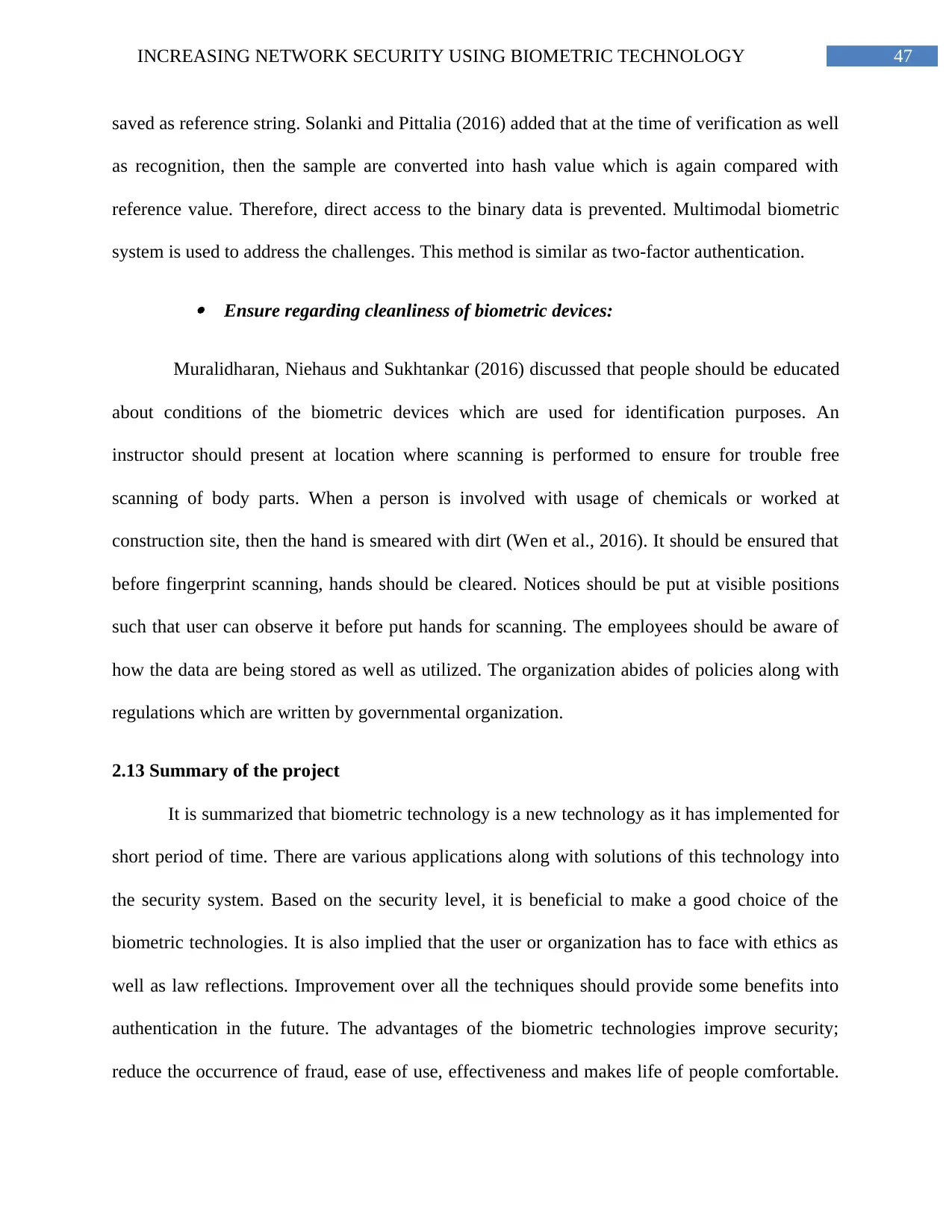
47INCREASING NETWORK SECURITY USING BIOMETRIC TECHNOLOGY
saved as reference string. Solanki and Pittalia (2016) added that at the time of verification as well
as recognition, then the sample are converted into hash value which is again compared with
reference value. Therefore, direct access to the binary data is prevented. Multimodal biometric
system is used to address the challenges. This method is similar as two-factor authentication. Ensure regarding cleanliness of biometric devices:
Muralidharan, Niehaus and Sukhtankar (2016) discussed that people should be educated
about conditions of the biometric devices which are used for identification purposes. An
instructor should present at location where scanning is performed to ensure for trouble free
scanning of body parts. When a person is involved with usage of chemicals or worked at
construction site, then the hand is smeared with dirt (Wen et al., 2016). It should be ensured that
before fingerprint scanning, hands should be cleared. Notices should be put at visible positions
such that user can observe it before put hands for scanning. The employees should be aware of
how the data are being stored as well as utilized. The organization abides of policies along with
regulations which are written by governmental organization.
2.13 Summary of the project
It is summarized that biometric technology is a new technology as it has implemented for
short period of time. There are various applications along with solutions of this technology into
the security system. Based on the security level, it is beneficial to make a good choice of the
biometric technologies. It is also implied that the user or organization has to face with ethics as
well as law reflections. Improvement over all the techniques should provide some benefits into
authentication in the future. The advantages of the biometric technologies improve security;
reduce the occurrence of fraud, ease of use, effectiveness and makes life of people comfortable.
saved as reference string. Solanki and Pittalia (2016) added that at the time of verification as well
as recognition, then the sample are converted into hash value which is again compared with
reference value. Therefore, direct access to the binary data is prevented. Multimodal biometric
system is used to address the challenges. This method is similar as two-factor authentication. Ensure regarding cleanliness of biometric devices:
Muralidharan, Niehaus and Sukhtankar (2016) discussed that people should be educated
about conditions of the biometric devices which are used for identification purposes. An
instructor should present at location where scanning is performed to ensure for trouble free
scanning of body parts. When a person is involved with usage of chemicals or worked at
construction site, then the hand is smeared with dirt (Wen et al., 2016). It should be ensured that
before fingerprint scanning, hands should be cleared. Notices should be put at visible positions
such that user can observe it before put hands for scanning. The employees should be aware of
how the data are being stored as well as utilized. The organization abides of policies along with
regulations which are written by governmental organization.
2.13 Summary of the project
It is summarized that biometric technology is a new technology as it has implemented for
short period of time. There are various applications along with solutions of this technology into
the security system. Based on the security level, it is beneficial to make a good choice of the
biometric technologies. It is also implied that the user or organization has to face with ethics as
well as law reflections. Improvement over all the techniques should provide some benefits into
authentication in the future. The advantages of the biometric technologies improve security;
reduce the occurrence of fraud, ease of use, effectiveness and makes life of people comfortable.
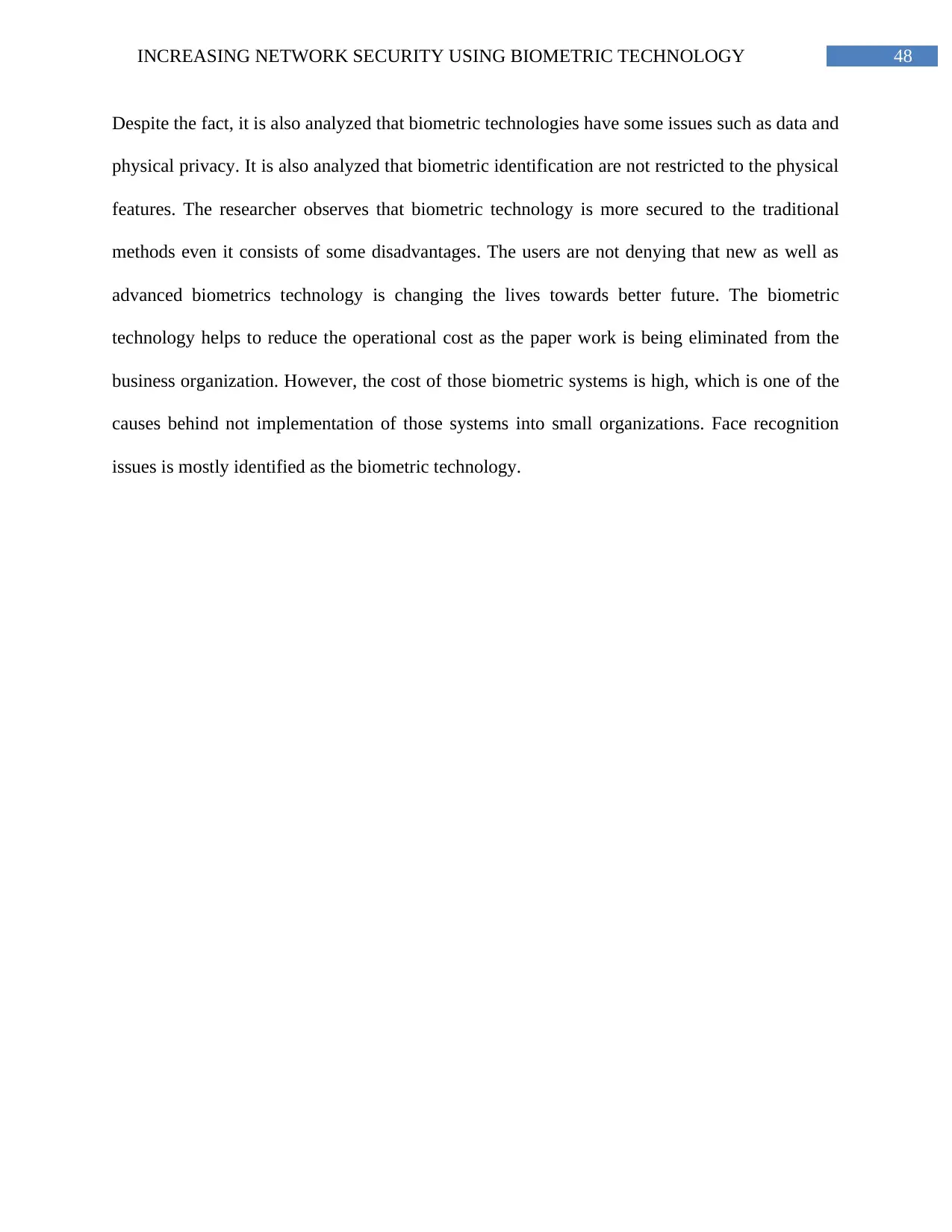
48INCREASING NETWORK SECURITY USING BIOMETRIC TECHNOLOGY
Despite the fact, it is also analyzed that biometric technologies have some issues such as data and
physical privacy. It is also analyzed that biometric identification are not restricted to the physical
features. The researcher observes that biometric technology is more secured to the traditional
methods even it consists of some disadvantages. The users are not denying that new as well as
advanced biometrics technology is changing the lives towards better future. The biometric
technology helps to reduce the operational cost as the paper work is being eliminated from the
business organization. However, the cost of those biometric systems is high, which is one of the
causes behind not implementation of those systems into small organizations. Face recognition
issues is mostly identified as the biometric technology.
Despite the fact, it is also analyzed that biometric technologies have some issues such as data and
physical privacy. It is also analyzed that biometric identification are not restricted to the physical
features. The researcher observes that biometric technology is more secured to the traditional
methods even it consists of some disadvantages. The users are not denying that new as well as
advanced biometrics technology is changing the lives towards better future. The biometric
technology helps to reduce the operational cost as the paper work is being eliminated from the
business organization. However, the cost of those biometric systems is high, which is one of the
causes behind not implementation of those systems into small organizations. Face recognition
issues is mostly identified as the biometric technology.
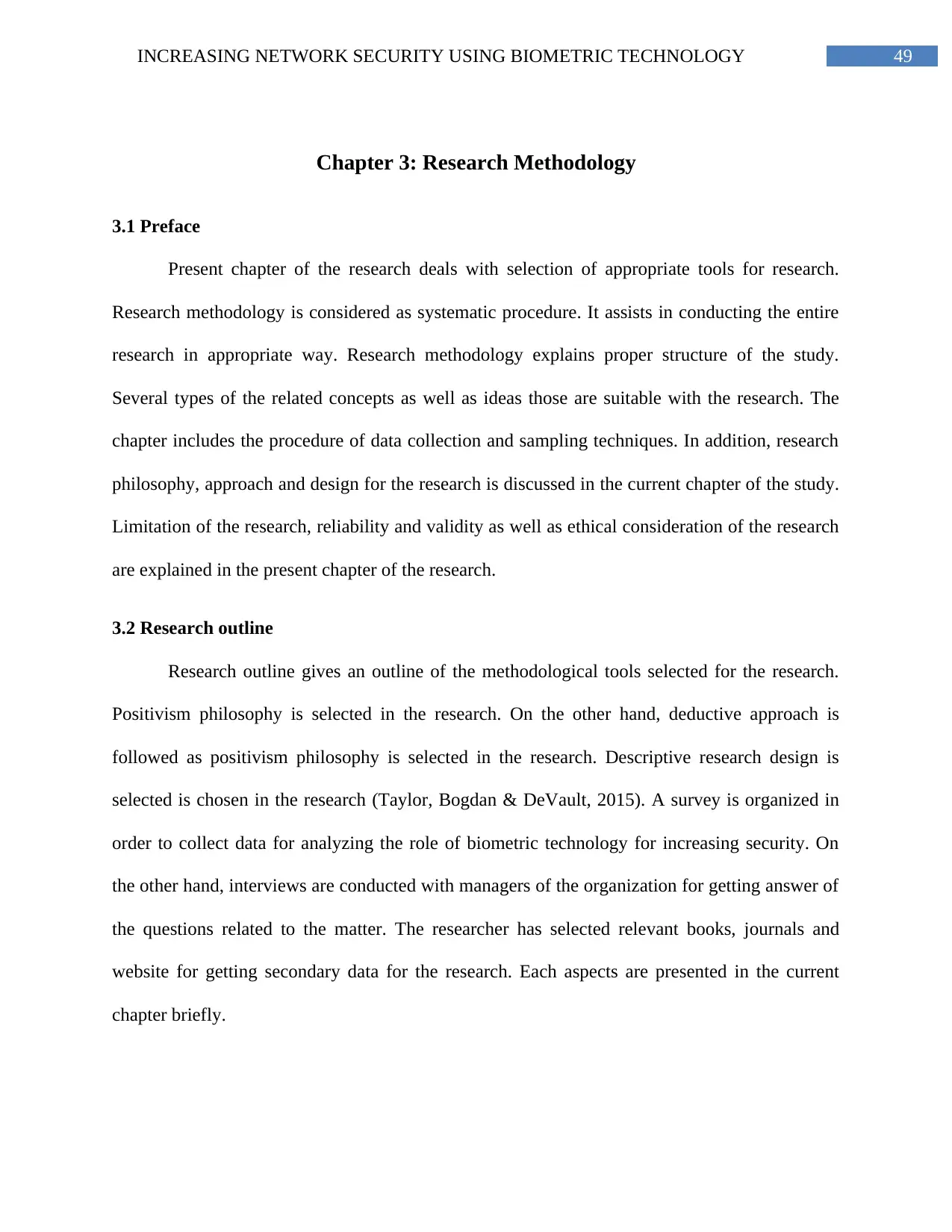
49INCREASING NETWORK SECURITY USING BIOMETRIC TECHNOLOGY
Chapter 3: Research Methodology
3.1 Preface
Present chapter of the research deals with selection of appropriate tools for research.
Research methodology is considered as systematic procedure. It assists in conducting the entire
research in appropriate way. Research methodology explains proper structure of the study.
Several types of the related concepts as well as ideas those are suitable with the research. The
chapter includes the procedure of data collection and sampling techniques. In addition, research
philosophy, approach and design for the research is discussed in the current chapter of the study.
Limitation of the research, reliability and validity as well as ethical consideration of the research
are explained in the present chapter of the research.
3.2 Research outline
Research outline gives an outline of the methodological tools selected for the research.
Positivism philosophy is selected in the research. On the other hand, deductive approach is
followed as positivism philosophy is selected in the research. Descriptive research design is
selected is chosen in the research (Taylor, Bogdan & DeVault, 2015). A survey is organized in
order to collect data for analyzing the role of biometric technology for increasing security. On
the other hand, interviews are conducted with managers of the organization for getting answer of
the questions related to the matter. The researcher has selected relevant books, journals and
website for getting secondary data for the research. Each aspects are presented in the current
chapter briefly.
Chapter 3: Research Methodology
3.1 Preface
Present chapter of the research deals with selection of appropriate tools for research.
Research methodology is considered as systematic procedure. It assists in conducting the entire
research in appropriate way. Research methodology explains proper structure of the study.
Several types of the related concepts as well as ideas those are suitable with the research. The
chapter includes the procedure of data collection and sampling techniques. In addition, research
philosophy, approach and design for the research is discussed in the current chapter of the study.
Limitation of the research, reliability and validity as well as ethical consideration of the research
are explained in the present chapter of the research.
3.2 Research outline
Research outline gives an outline of the methodological tools selected for the research.
Positivism philosophy is selected in the research. On the other hand, deductive approach is
followed as positivism philosophy is selected in the research. Descriptive research design is
selected is chosen in the research (Taylor, Bogdan & DeVault, 2015). A survey is organized in
order to collect data for analyzing the role of biometric technology for increasing security. On
the other hand, interviews are conducted with managers of the organization for getting answer of
the questions related to the matter. The researcher has selected relevant books, journals and
website for getting secondary data for the research. Each aspects are presented in the current
chapter briefly.
Paraphrase This Document
Need a fresh take? Get an instant paraphrase of this document with our AI Paraphraser
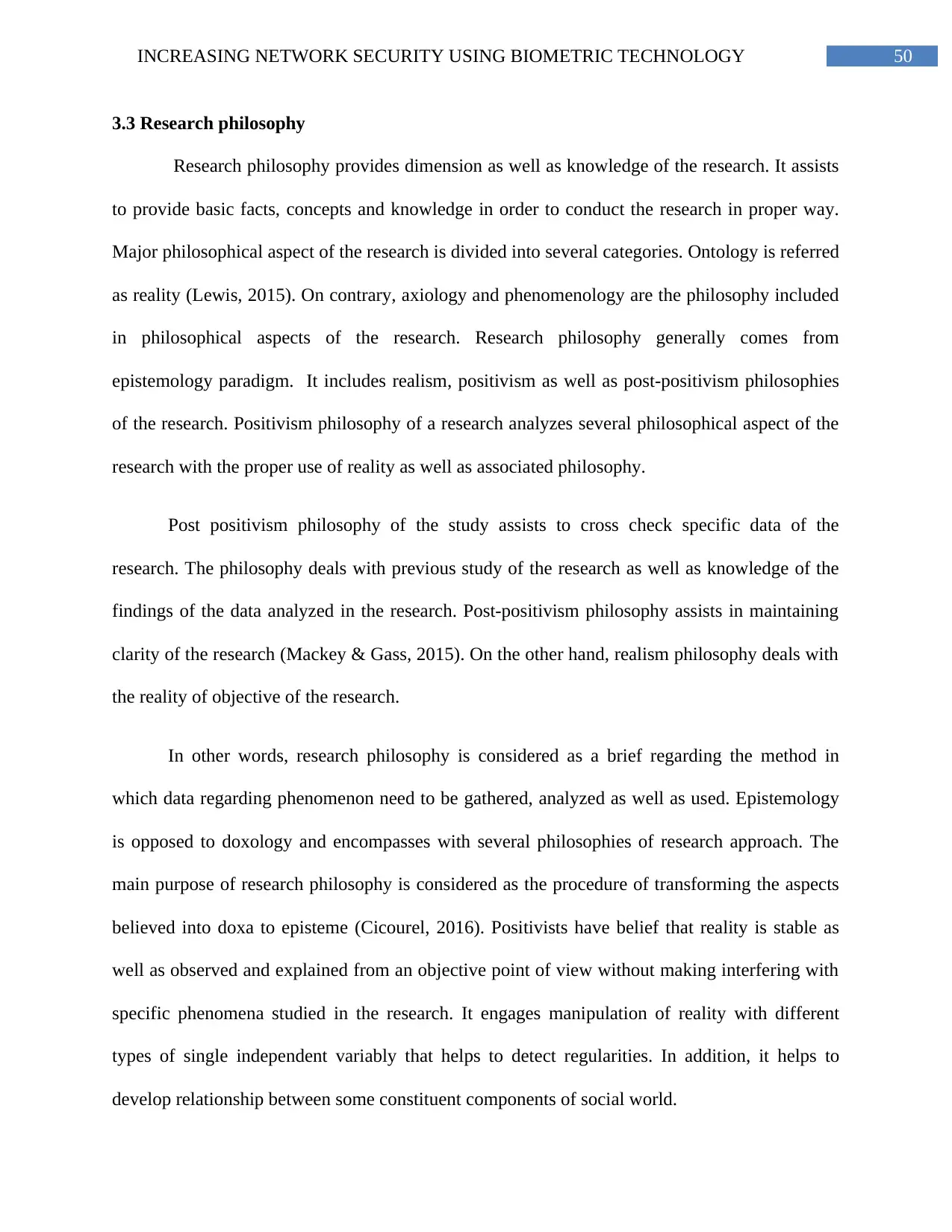
50INCREASING NETWORK SECURITY USING BIOMETRIC TECHNOLOGY
3.3 Research philosophy
Research philosophy provides dimension as well as knowledge of the research. It assists
to provide basic facts, concepts and knowledge in order to conduct the research in proper way.
Major philosophical aspect of the research is divided into several categories. Ontology is referred
as reality (Lewis, 2015). On contrary, axiology and phenomenology are the philosophy included
in philosophical aspects of the research. Research philosophy generally comes from
epistemology paradigm. It includes realism, positivism as well as post-positivism philosophies
of the research. Positivism philosophy of a research analyzes several philosophical aspect of the
research with the proper use of reality as well as associated philosophy.
Post positivism philosophy of the study assists to cross check specific data of the
research. The philosophy deals with previous study of the research as well as knowledge of the
findings of the data analyzed in the research. Post-positivism philosophy assists in maintaining
clarity of the research (Mackey & Gass, 2015). On the other hand, realism philosophy deals with
the reality of objective of the research.
In other words, research philosophy is considered as a brief regarding the method in
which data regarding phenomenon need to be gathered, analyzed as well as used. Epistemology
is opposed to doxology and encompasses with several philosophies of research approach. The
main purpose of research philosophy is considered as the procedure of transforming the aspects
believed into doxa to episteme (Cicourel, 2016). Positivists have belief that reality is stable as
well as observed and explained from an objective point of view without making interfering with
specific phenomena studied in the research. It engages manipulation of reality with different
types of single independent variably that helps to detect regularities. In addition, it helps to
develop relationship between some constituent components of social world.
3.3 Research philosophy
Research philosophy provides dimension as well as knowledge of the research. It assists
to provide basic facts, concepts and knowledge in order to conduct the research in proper way.
Major philosophical aspect of the research is divided into several categories. Ontology is referred
as reality (Lewis, 2015). On contrary, axiology and phenomenology are the philosophy included
in philosophical aspects of the research. Research philosophy generally comes from
epistemology paradigm. It includes realism, positivism as well as post-positivism philosophies
of the research. Positivism philosophy of a research analyzes several philosophical aspect of the
research with the proper use of reality as well as associated philosophy.
Post positivism philosophy of the study assists to cross check specific data of the
research. The philosophy deals with previous study of the research as well as knowledge of the
findings of the data analyzed in the research. Post-positivism philosophy assists in maintaining
clarity of the research (Mackey & Gass, 2015). On the other hand, realism philosophy deals with
the reality of objective of the research.
In other words, research philosophy is considered as a brief regarding the method in
which data regarding phenomenon need to be gathered, analyzed as well as used. Epistemology
is opposed to doxology and encompasses with several philosophies of research approach. The
main purpose of research philosophy is considered as the procedure of transforming the aspects
believed into doxa to episteme (Cicourel, 2016). Positivists have belief that reality is stable as
well as observed and explained from an objective point of view without making interfering with
specific phenomena studied in the research. It engages manipulation of reality with different
types of single independent variably that helps to detect regularities. In addition, it helps to
develop relationship between some constituent components of social world.
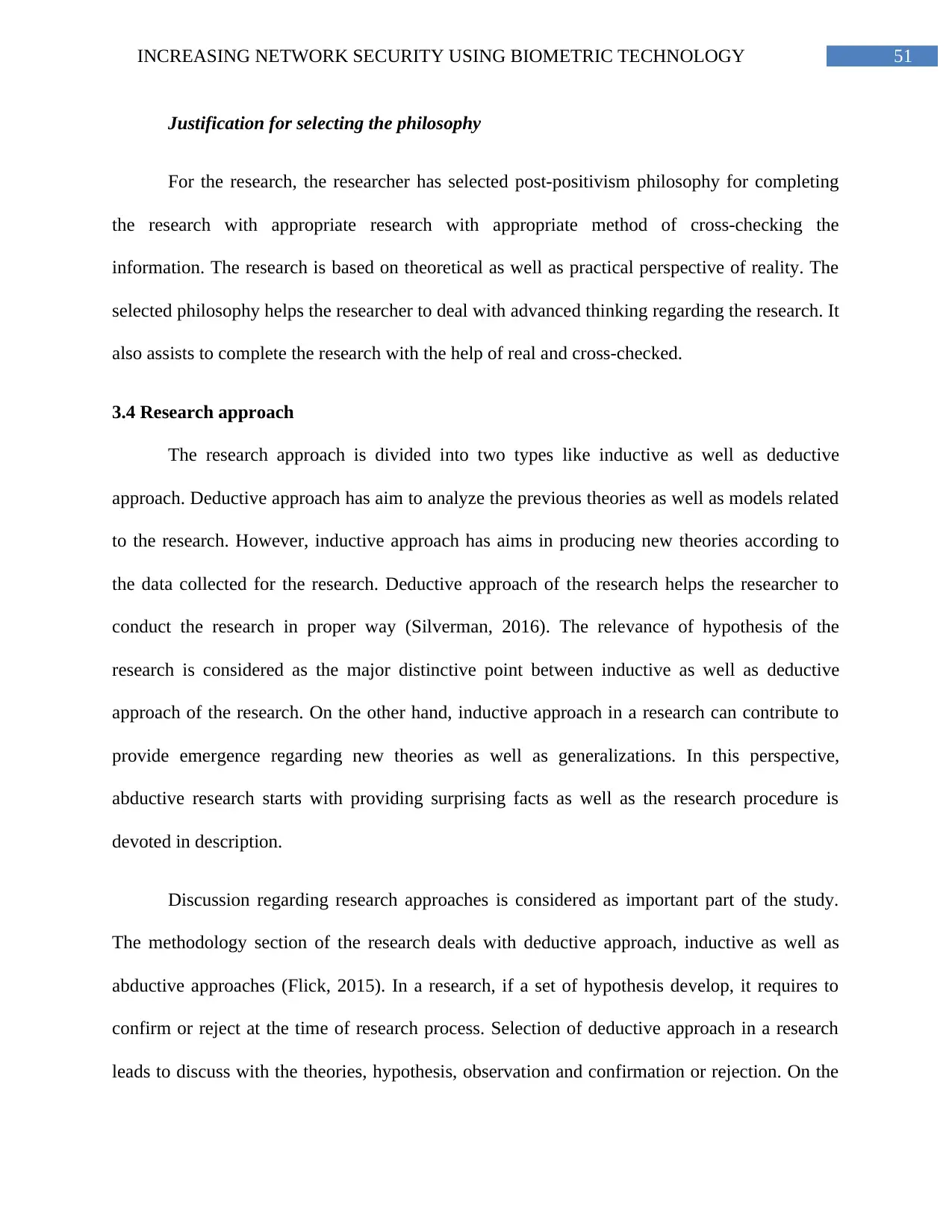
51INCREASING NETWORK SECURITY USING BIOMETRIC TECHNOLOGY
Justification for selecting the philosophy
For the research, the researcher has selected post-positivism philosophy for completing
the research with appropriate research with appropriate method of cross-checking the
information. The research is based on theoretical as well as practical perspective of reality. The
selected philosophy helps the researcher to deal with advanced thinking regarding the research. It
also assists to complete the research with the help of real and cross-checked.
3.4 Research approach
The research approach is divided into two types like inductive as well as deductive
approach. Deductive approach has aim to analyze the previous theories as well as models related
to the research. However, inductive approach has aims in producing new theories according to
the data collected for the research. Deductive approach of the research helps the researcher to
conduct the research in proper way (Silverman, 2016). The relevance of hypothesis of the
research is considered as the major distinctive point between inductive as well as deductive
approach of the research. On the other hand, inductive approach in a research can contribute to
provide emergence regarding new theories as well as generalizations. In this perspective,
abductive research starts with providing surprising facts as well as the research procedure is
devoted in description.
Discussion regarding research approaches is considered as important part of the study.
The methodology section of the research deals with deductive approach, inductive as well as
abductive approaches (Flick, 2015). In a research, if a set of hypothesis develop, it requires to
confirm or reject at the time of research process. Selection of deductive approach in a research
leads to discuss with the theories, hypothesis, observation and confirmation or rejection. On the
Justification for selecting the philosophy
For the research, the researcher has selected post-positivism philosophy for completing
the research with appropriate research with appropriate method of cross-checking the
information. The research is based on theoretical as well as practical perspective of reality. The
selected philosophy helps the researcher to deal with advanced thinking regarding the research. It
also assists to complete the research with the help of real and cross-checked.
3.4 Research approach
The research approach is divided into two types like inductive as well as deductive
approach. Deductive approach has aim to analyze the previous theories as well as models related
to the research. However, inductive approach has aims in producing new theories according to
the data collected for the research. Deductive approach of the research helps the researcher to
conduct the research in proper way (Silverman, 2016). The relevance of hypothesis of the
research is considered as the major distinctive point between inductive as well as deductive
approach of the research. On the other hand, inductive approach in a research can contribute to
provide emergence regarding new theories as well as generalizations. In this perspective,
abductive research starts with providing surprising facts as well as the research procedure is
devoted in description.
Discussion regarding research approaches is considered as important part of the study.
The methodology section of the research deals with deductive approach, inductive as well as
abductive approaches (Flick, 2015). In a research, if a set of hypothesis develop, it requires to
confirm or reject at the time of research process. Selection of deductive approach in a research
leads to discuss with the theories, hypothesis, observation and confirmation or rejection. On the
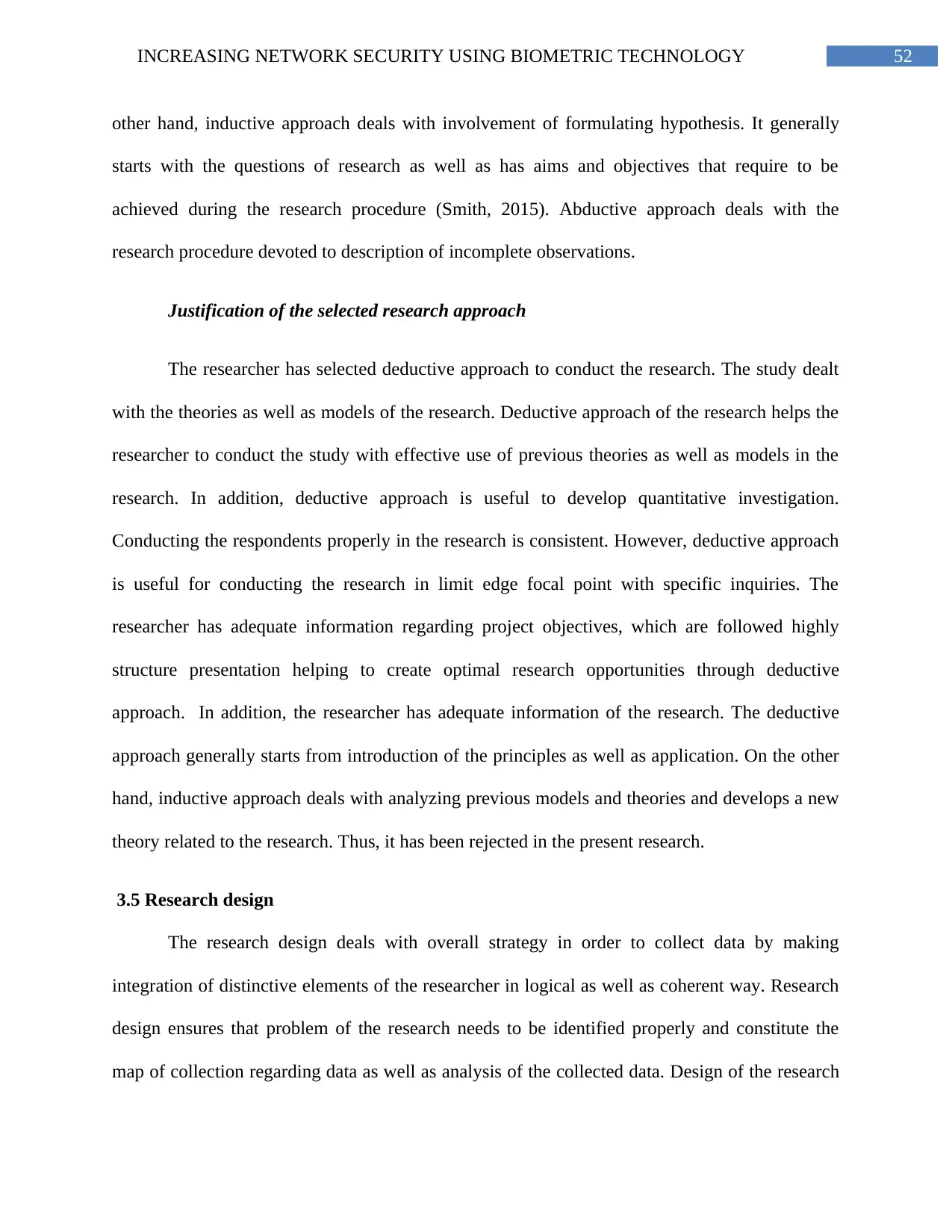
52INCREASING NETWORK SECURITY USING BIOMETRIC TECHNOLOGY
other hand, inductive approach deals with involvement of formulating hypothesis. It generally
starts with the questions of research as well as has aims and objectives that require to be
achieved during the research procedure (Smith, 2015). Abductive approach deals with the
research procedure devoted to description of incomplete observations.
Justification of the selected research approach
The researcher has selected deductive approach to conduct the research. The study dealt
with the theories as well as models of the research. Deductive approach of the research helps the
researcher to conduct the study with effective use of previous theories as well as models in the
research. In addition, deductive approach is useful to develop quantitative investigation.
Conducting the respondents properly in the research is consistent. However, deductive approach
is useful for conducting the research in limit edge focal point with specific inquiries. The
researcher has adequate information regarding project objectives, which are followed highly
structure presentation helping to create optimal research opportunities through deductive
approach. In addition, the researcher has adequate information of the research. The deductive
approach generally starts from introduction of the principles as well as application. On the other
hand, inductive approach deals with analyzing previous models and theories and develops a new
theory related to the research. Thus, it has been rejected in the present research.
3.5 Research design
The research design deals with overall strategy in order to collect data by making
integration of distinctive elements of the researcher in logical as well as coherent way. Research
design ensures that problem of the research needs to be identified properly and constitute the
map of collection regarding data as well as analysis of the collected data. Design of the research
other hand, inductive approach deals with involvement of formulating hypothesis. It generally
starts with the questions of research as well as has aims and objectives that require to be
achieved during the research procedure (Smith, 2015). Abductive approach deals with the
research procedure devoted to description of incomplete observations.
Justification of the selected research approach
The researcher has selected deductive approach to conduct the research. The study dealt
with the theories as well as models of the research. Deductive approach of the research helps the
researcher to conduct the study with effective use of previous theories as well as models in the
research. In addition, deductive approach is useful to develop quantitative investigation.
Conducting the respondents properly in the research is consistent. However, deductive approach
is useful for conducting the research in limit edge focal point with specific inquiries. The
researcher has adequate information regarding project objectives, which are followed highly
structure presentation helping to create optimal research opportunities through deductive
approach. In addition, the researcher has adequate information of the research. The deductive
approach generally starts from introduction of the principles as well as application. On the other
hand, inductive approach deals with analyzing previous models and theories and develops a new
theory related to the research. Thus, it has been rejected in the present research.
3.5 Research design
The research design deals with overall strategy in order to collect data by making
integration of distinctive elements of the researcher in logical as well as coherent way. Research
design ensures that problem of the research needs to be identified properly and constitute the
map of collection regarding data as well as analysis of the collected data. Design of the research
Secure Best Marks with AI Grader
Need help grading? Try our AI Grader for instant feedback on your assignments.
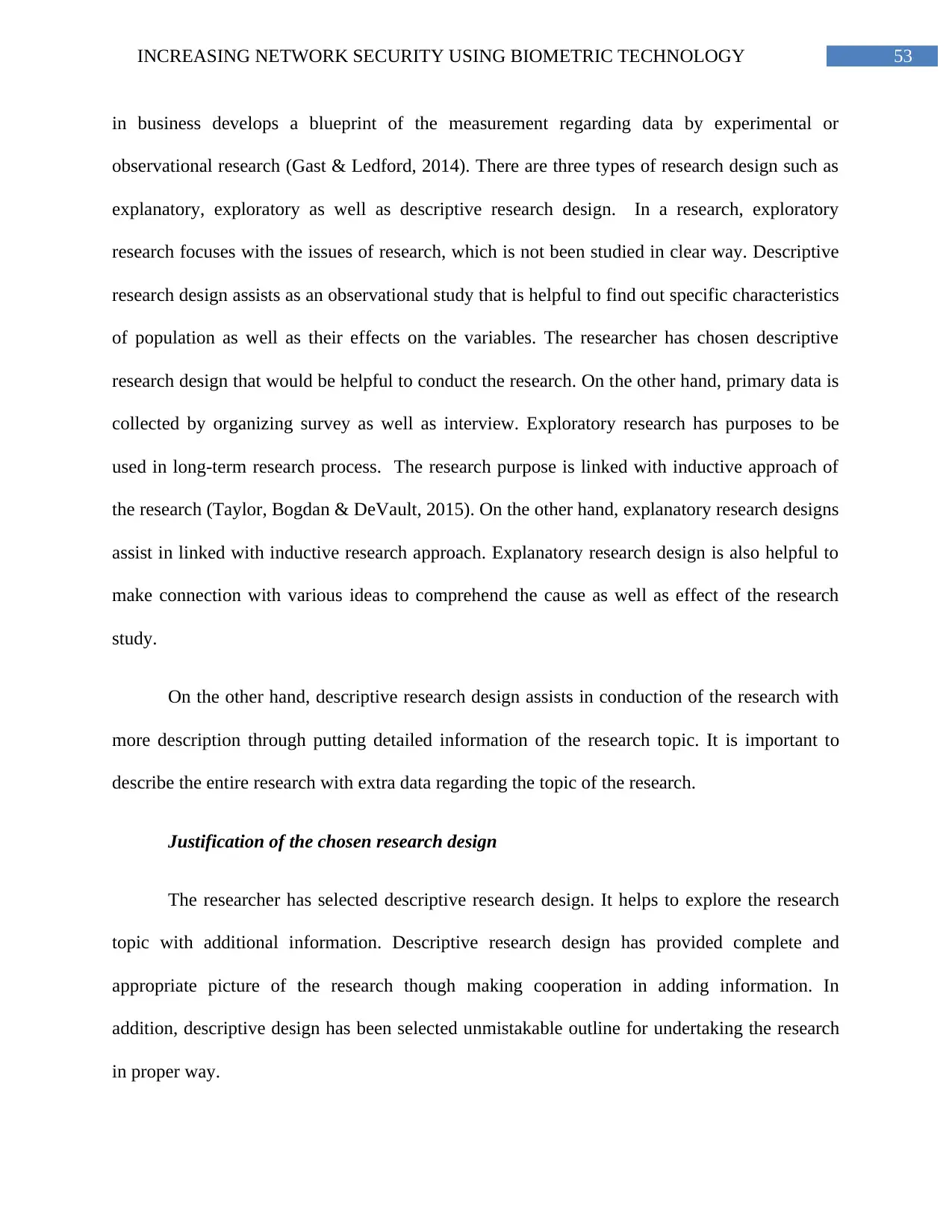
53INCREASING NETWORK SECURITY USING BIOMETRIC TECHNOLOGY
in business develops a blueprint of the measurement regarding data by experimental or
observational research (Gast & Ledford, 2014). There are three types of research design such as
explanatory, exploratory as well as descriptive research design. In a research, exploratory
research focuses with the issues of research, which is not been studied in clear way. Descriptive
research design assists as an observational study that is helpful to find out specific characteristics
of population as well as their effects on the variables. The researcher has chosen descriptive
research design that would be helpful to conduct the research. On the other hand, primary data is
collected by organizing survey as well as interview. Exploratory research has purposes to be
used in long-term research process. The research purpose is linked with inductive approach of
the research (Taylor, Bogdan & DeVault, 2015). On the other hand, explanatory research designs
assist in linked with inductive research approach. Explanatory research design is also helpful to
make connection with various ideas to comprehend the cause as well as effect of the research
study.
On the other hand, descriptive research design assists in conduction of the research with
more description through putting detailed information of the research topic. It is important to
describe the entire research with extra data regarding the topic of the research.
Justification of the chosen research design
The researcher has selected descriptive research design. It helps to explore the research
topic with additional information. Descriptive research design has provided complete and
appropriate picture of the research though making cooperation in adding information. In
addition, descriptive design has been selected unmistakable outline for undertaking the research
in proper way.
in business develops a blueprint of the measurement regarding data by experimental or
observational research (Gast & Ledford, 2014). There are three types of research design such as
explanatory, exploratory as well as descriptive research design. In a research, exploratory
research focuses with the issues of research, which is not been studied in clear way. Descriptive
research design assists as an observational study that is helpful to find out specific characteristics
of population as well as their effects on the variables. The researcher has chosen descriptive
research design that would be helpful to conduct the research. On the other hand, primary data is
collected by organizing survey as well as interview. Exploratory research has purposes to be
used in long-term research process. The research purpose is linked with inductive approach of
the research (Taylor, Bogdan & DeVault, 2015). On the other hand, explanatory research designs
assist in linked with inductive research approach. Explanatory research design is also helpful to
make connection with various ideas to comprehend the cause as well as effect of the research
study.
On the other hand, descriptive research design assists in conduction of the research with
more description through putting detailed information of the research topic. It is important to
describe the entire research with extra data regarding the topic of the research.
Justification of the chosen research design
The researcher has selected descriptive research design. It helps to explore the research
topic with additional information. Descriptive research design has provided complete and
appropriate picture of the research though making cooperation in adding information. In
addition, descriptive design has been selected unmistakable outline for undertaking the research
in proper way.
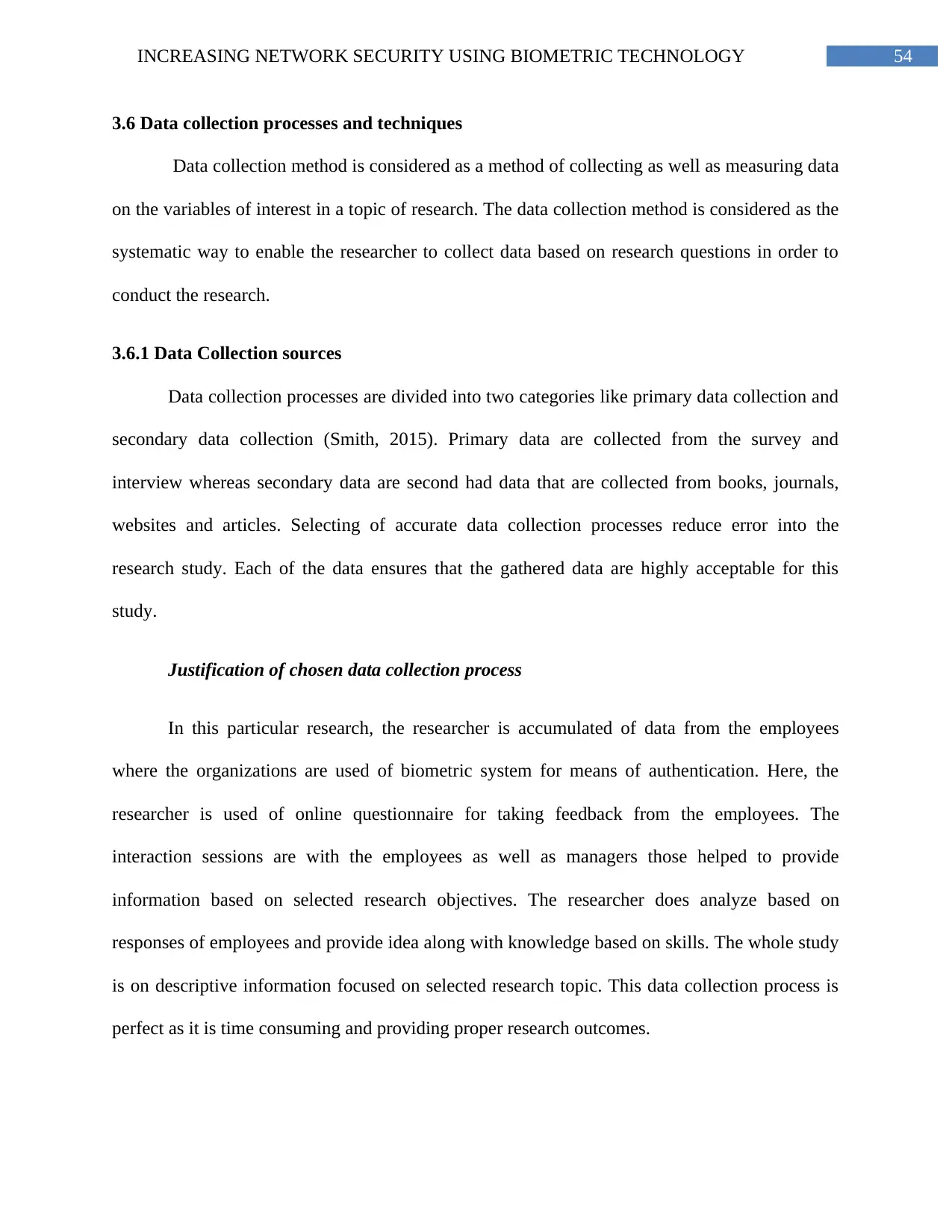
54INCREASING NETWORK SECURITY USING BIOMETRIC TECHNOLOGY
3.6 Data collection processes and techniques
Data collection method is considered as a method of collecting as well as measuring data
on the variables of interest in a topic of research. The data collection method is considered as the
systematic way to enable the researcher to collect data based on research questions in order to
conduct the research.
3.6.1 Data Collection sources
Data collection processes are divided into two categories like primary data collection and
secondary data collection (Smith, 2015). Primary data are collected from the survey and
interview whereas secondary data are second had data that are collected from books, journals,
websites and articles. Selecting of accurate data collection processes reduce error into the
research study. Each of the data ensures that the gathered data are highly acceptable for this
study.
Justification of chosen data collection process
In this particular research, the researcher is accumulated of data from the employees
where the organizations are used of biometric system for means of authentication. Here, the
researcher is used of online questionnaire for taking feedback from the employees. The
interaction sessions are with the employees as well as managers those helped to provide
information based on selected research objectives. The researcher does analyze based on
responses of employees and provide idea along with knowledge based on skills. The whole study
is on descriptive information focused on selected research topic. This data collection process is
perfect as it is time consuming and providing proper research outcomes.
3.6 Data collection processes and techniques
Data collection method is considered as a method of collecting as well as measuring data
on the variables of interest in a topic of research. The data collection method is considered as the
systematic way to enable the researcher to collect data based on research questions in order to
conduct the research.
3.6.1 Data Collection sources
Data collection processes are divided into two categories like primary data collection and
secondary data collection (Smith, 2015). Primary data are collected from the survey and
interview whereas secondary data are second had data that are collected from books, journals,
websites and articles. Selecting of accurate data collection processes reduce error into the
research study. Each of the data ensures that the gathered data are highly acceptable for this
study.
Justification of chosen data collection process
In this particular research, the researcher is accumulated of data from the employees
where the organizations are used of biometric system for means of authentication. Here, the
researcher is used of online questionnaire for taking feedback from the employees. The
interaction sessions are with the employees as well as managers those helped to provide
information based on selected research objectives. The researcher does analyze based on
responses of employees and provide idea along with knowledge based on skills. The whole study
is on descriptive information focused on selected research topic. This data collection process is
perfect as it is time consuming and providing proper research outcomes.
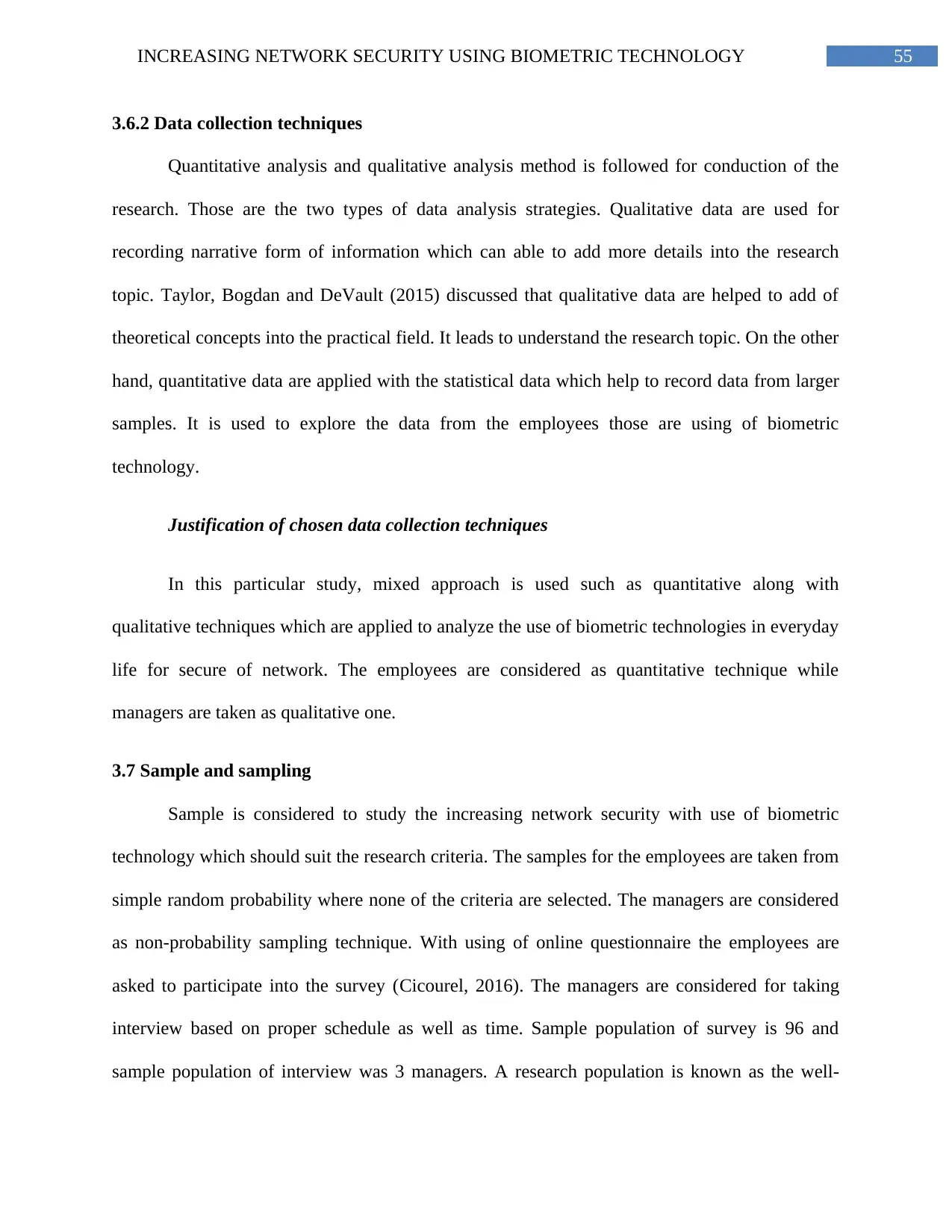
55INCREASING NETWORK SECURITY USING BIOMETRIC TECHNOLOGY
3.6.2 Data collection techniques
Quantitative analysis and qualitative analysis method is followed for conduction of the
research. Those are the two types of data analysis strategies. Qualitative data are used for
recording narrative form of information which can able to add more details into the research
topic. Taylor, Bogdan and DeVault (2015) discussed that qualitative data are helped to add of
theoretical concepts into the practical field. It leads to understand the research topic. On the other
hand, quantitative data are applied with the statistical data which help to record data from larger
samples. It is used to explore the data from the employees those are using of biometric
technology.
Justification of chosen data collection techniques
In this particular study, mixed approach is used such as quantitative along with
qualitative techniques which are applied to analyze the use of biometric technologies in everyday
life for secure of network. The employees are considered as quantitative technique while
managers are taken as qualitative one.
3.7 Sample and sampling
Sample is considered to study the increasing network security with use of biometric
technology which should suit the research criteria. The samples for the employees are taken from
simple random probability where none of the criteria are selected. The managers are considered
as non-probability sampling technique. With using of online questionnaire the employees are
asked to participate into the survey (Cicourel, 2016). The managers are considered for taking
interview based on proper schedule as well as time. Sample population of survey is 96 and
sample population of interview was 3 managers. A research population is known as the well-
3.6.2 Data collection techniques
Quantitative analysis and qualitative analysis method is followed for conduction of the
research. Those are the two types of data analysis strategies. Qualitative data are used for
recording narrative form of information which can able to add more details into the research
topic. Taylor, Bogdan and DeVault (2015) discussed that qualitative data are helped to add of
theoretical concepts into the practical field. It leads to understand the research topic. On the other
hand, quantitative data are applied with the statistical data which help to record data from larger
samples. It is used to explore the data from the employees those are using of biometric
technology.
Justification of chosen data collection techniques
In this particular study, mixed approach is used such as quantitative along with
qualitative techniques which are applied to analyze the use of biometric technologies in everyday
life for secure of network. The employees are considered as quantitative technique while
managers are taken as qualitative one.
3.7 Sample and sampling
Sample is considered to study the increasing network security with use of biometric
technology which should suit the research criteria. The samples for the employees are taken from
simple random probability where none of the criteria are selected. The managers are considered
as non-probability sampling technique. With using of online questionnaire the employees are
asked to participate into the survey (Cicourel, 2016). The managers are considered for taking
interview based on proper schedule as well as time. Sample population of survey is 96 and
sample population of interview was 3 managers. A research population is known as the well-
Paraphrase This Document
Need a fresh take? Get an instant paraphrase of this document with our AI Paraphraser
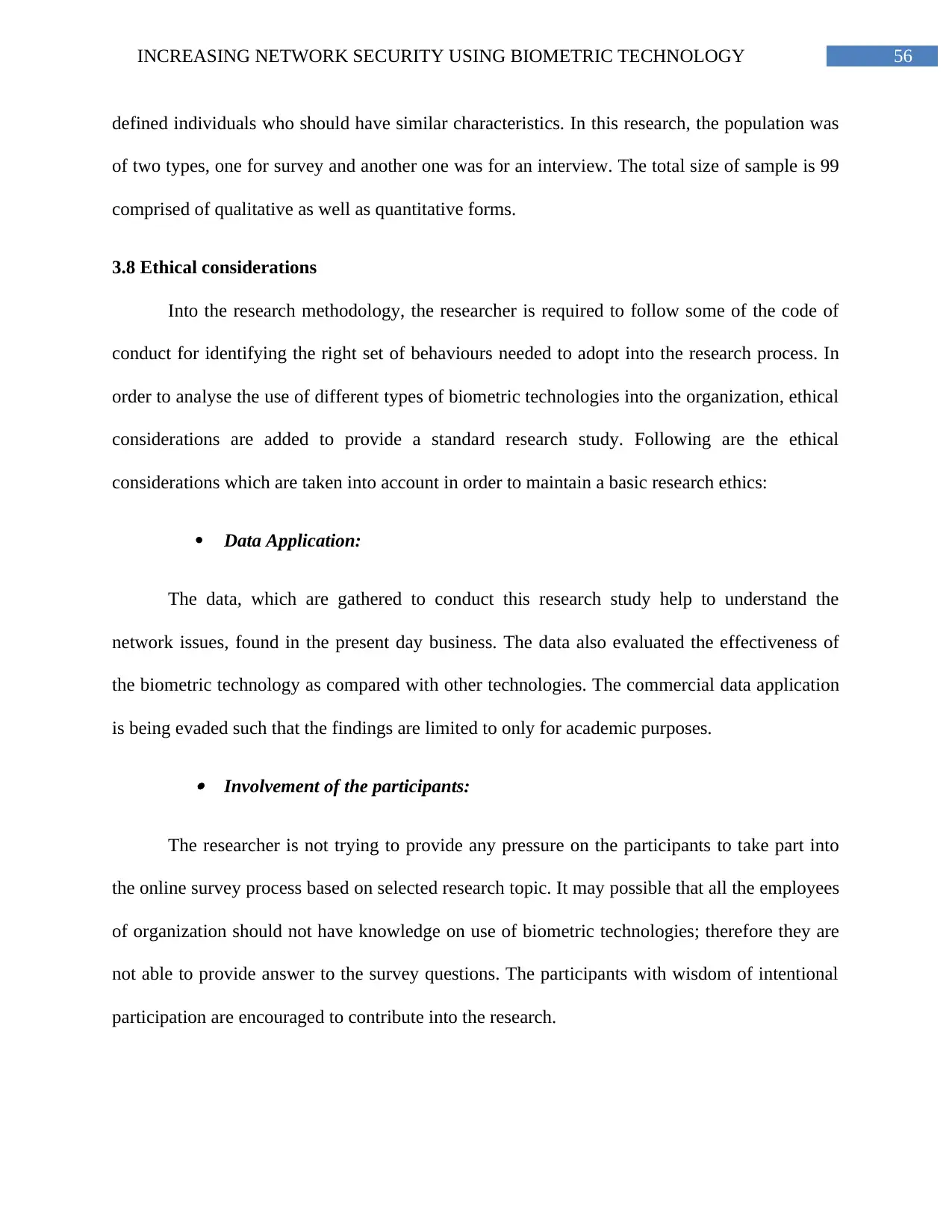
56INCREASING NETWORK SECURITY USING BIOMETRIC TECHNOLOGY
defined individuals who should have similar characteristics. In this research, the population was
of two types, one for survey and another one was for an interview. The total size of sample is 99
comprised of qualitative as well as quantitative forms.
3.8 Ethical considerations
Into the research methodology, the researcher is required to follow some of the code of
conduct for identifying the right set of behaviours needed to adopt into the research process. In
order to analyse the use of different types of biometric technologies into the organization, ethical
considerations are added to provide a standard research study. Following are the ethical
considerations which are taken into account in order to maintain a basic research ethics:
Data Application:
The data, which are gathered to conduct this research study help to understand the
network issues, found in the present day business. The data also evaluated the effectiveness of
the biometric technology as compared with other technologies. The commercial data application
is being evaded such that the findings are limited to only for academic purposes. Involvement of the participants:
The researcher is not trying to provide any pressure on the participants to take part into
the online survey process based on selected research topic. It may possible that all the employees
of organization should not have knowledge on use of biometric technologies; therefore they are
not able to provide answer to the survey questions. The participants with wisdom of intentional
participation are encouraged to contribute into the research.
defined individuals who should have similar characteristics. In this research, the population was
of two types, one for survey and another one was for an interview. The total size of sample is 99
comprised of qualitative as well as quantitative forms.
3.8 Ethical considerations
Into the research methodology, the researcher is required to follow some of the code of
conduct for identifying the right set of behaviours needed to adopt into the research process. In
order to analyse the use of different types of biometric technologies into the organization, ethical
considerations are added to provide a standard research study. Following are the ethical
considerations which are taken into account in order to maintain a basic research ethics:
Data Application:
The data, which are gathered to conduct this research study help to understand the
network issues, found in the present day business. The data also evaluated the effectiveness of
the biometric technology as compared with other technologies. The commercial data application
is being evaded such that the findings are limited to only for academic purposes. Involvement of the participants:
The researcher is not trying to provide any pressure on the participants to take part into
the online survey process based on selected research topic. It may possible that all the employees
of organization should not have knowledge on use of biometric technologies; therefore they are
not able to provide answer to the survey questions. The participants with wisdom of intentional
participation are encouraged to contribute into the research.
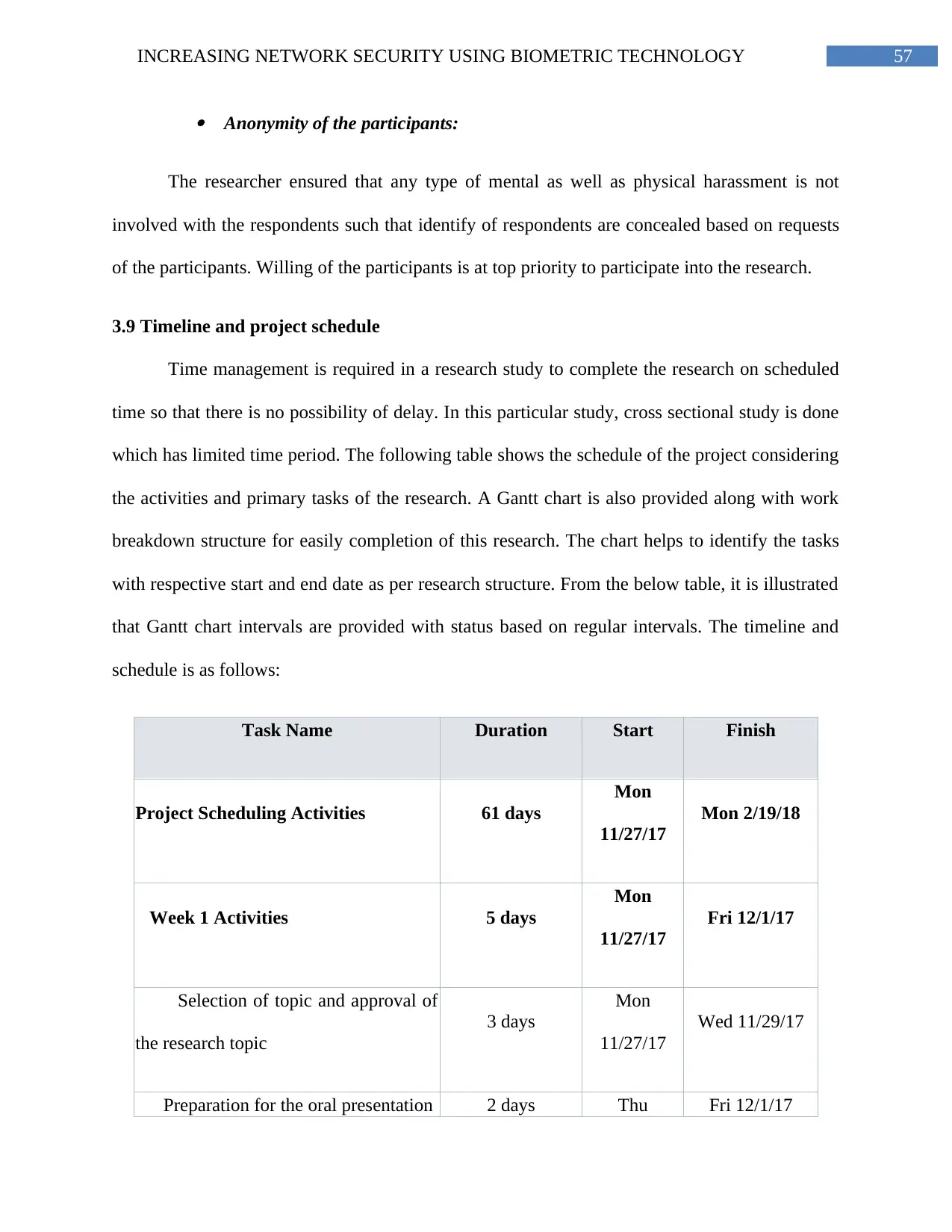
57INCREASING NETWORK SECURITY USING BIOMETRIC TECHNOLOGY
Anonymity of the participants:
The researcher ensured that any type of mental as well as physical harassment is not
involved with the respondents such that identify of respondents are concealed based on requests
of the participants. Willing of the participants is at top priority to participate into the research.
3.9 Timeline and project schedule
Time management is required in a research study to complete the research on scheduled
time so that there is no possibility of delay. In this particular study, cross sectional study is done
which has limited time period. The following table shows the schedule of the project considering
the activities and primary tasks of the research. A Gantt chart is also provided along with work
breakdown structure for easily completion of this research. The chart helps to identify the tasks
with respective start and end date as per research structure. From the below table, it is illustrated
that Gantt chart intervals are provided with status based on regular intervals. The timeline and
schedule is as follows:
Task Name Duration Start Finish
Project Scheduling Activities 61 days
Mon
11/27/17
Mon 2/19/18
Week 1 Activities 5 days
Mon
11/27/17
Fri 12/1/17
Selection of topic and approval of
the research topic
3 days
Mon
11/27/17
Wed 11/29/17
Preparation for the oral presentation 2 days Thu Fri 12/1/17
Anonymity of the participants:
The researcher ensured that any type of mental as well as physical harassment is not
involved with the respondents such that identify of respondents are concealed based on requests
of the participants. Willing of the participants is at top priority to participate into the research.
3.9 Timeline and project schedule
Time management is required in a research study to complete the research on scheduled
time so that there is no possibility of delay. In this particular study, cross sectional study is done
which has limited time period. The following table shows the schedule of the project considering
the activities and primary tasks of the research. A Gantt chart is also provided along with work
breakdown structure for easily completion of this research. The chart helps to identify the tasks
with respective start and end date as per research structure. From the below table, it is illustrated
that Gantt chart intervals are provided with status based on regular intervals. The timeline and
schedule is as follows:
Task Name Duration Start Finish
Project Scheduling Activities 61 days
Mon
11/27/17
Mon 2/19/18
Week 1 Activities 5 days
Mon
11/27/17
Fri 12/1/17
Selection of topic and approval of
the research topic
3 days
Mon
11/27/17
Wed 11/29/17
Preparation for the oral presentation 2 days Thu Fri 12/1/17
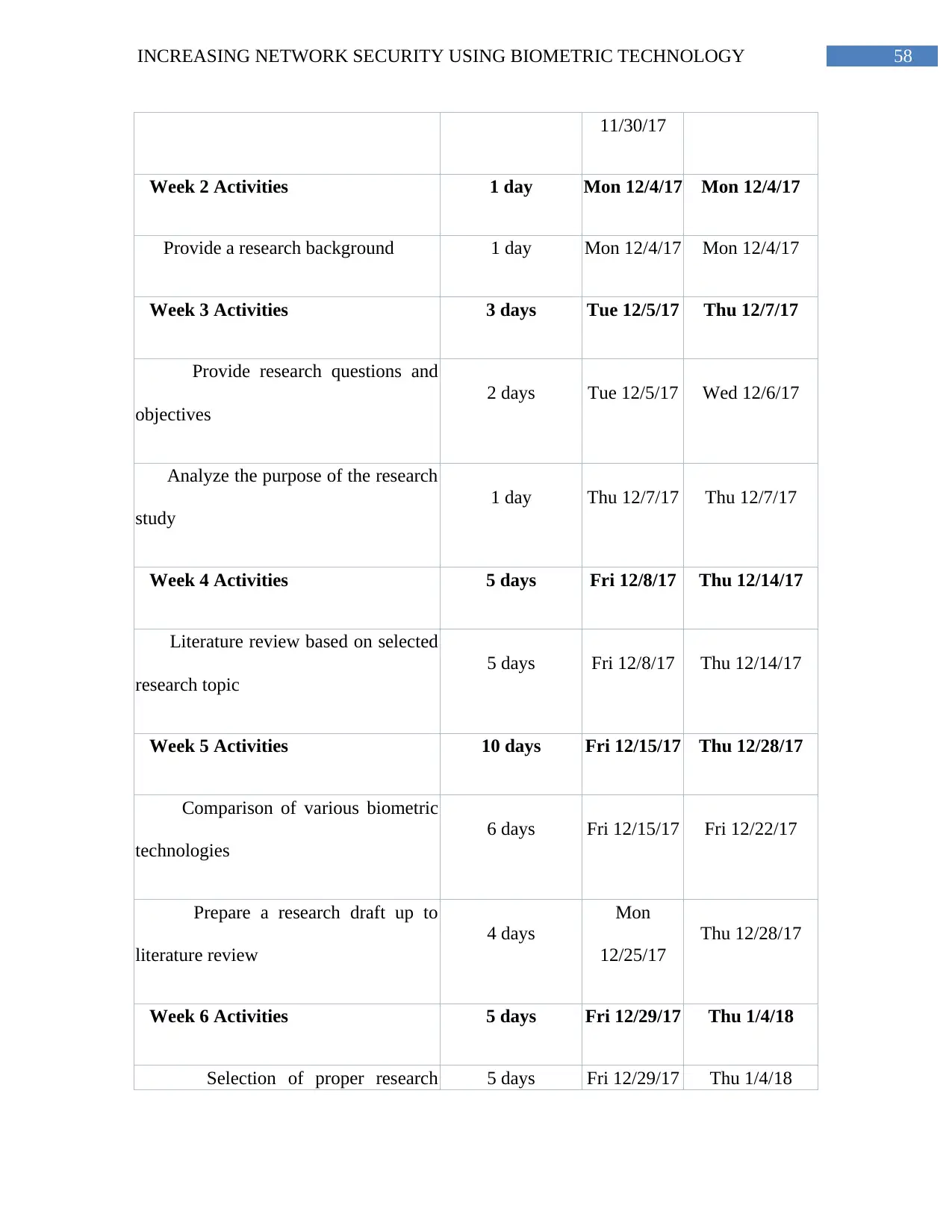
58INCREASING NETWORK SECURITY USING BIOMETRIC TECHNOLOGY
11/30/17
Week 2 Activities 1 day Mon 12/4/17 Mon 12/4/17
Provide a research background 1 day Mon 12/4/17 Mon 12/4/17
Week 3 Activities 3 days Tue 12/5/17 Thu 12/7/17
Provide research questions and
objectives
2 days Tue 12/5/17 Wed 12/6/17
Analyze the purpose of the research
study
1 day Thu 12/7/17 Thu 12/7/17
Week 4 Activities 5 days Fri 12/8/17 Thu 12/14/17
Literature review based on selected
research topic
5 days Fri 12/8/17 Thu 12/14/17
Week 5 Activities 10 days Fri 12/15/17 Thu 12/28/17
Comparison of various biometric
technologies
6 days Fri 12/15/17 Fri 12/22/17
Prepare a research draft up to
literature review
4 days
Mon
12/25/17
Thu 12/28/17
Week 6 Activities 5 days Fri 12/29/17 Thu 1/4/18
Selection of proper research 5 days Fri 12/29/17 Thu 1/4/18
11/30/17
Week 2 Activities 1 day Mon 12/4/17 Mon 12/4/17
Provide a research background 1 day Mon 12/4/17 Mon 12/4/17
Week 3 Activities 3 days Tue 12/5/17 Thu 12/7/17
Provide research questions and
objectives
2 days Tue 12/5/17 Wed 12/6/17
Analyze the purpose of the research
study
1 day Thu 12/7/17 Thu 12/7/17
Week 4 Activities 5 days Fri 12/8/17 Thu 12/14/17
Literature review based on selected
research topic
5 days Fri 12/8/17 Thu 12/14/17
Week 5 Activities 10 days Fri 12/15/17 Thu 12/28/17
Comparison of various biometric
technologies
6 days Fri 12/15/17 Fri 12/22/17
Prepare a research draft up to
literature review
4 days
Mon
12/25/17
Thu 12/28/17
Week 6 Activities 5 days Fri 12/29/17 Thu 1/4/18
Selection of proper research 5 days Fri 12/29/17 Thu 1/4/18
Secure Best Marks with AI Grader
Need help grading? Try our AI Grader for instant feedback on your assignments.
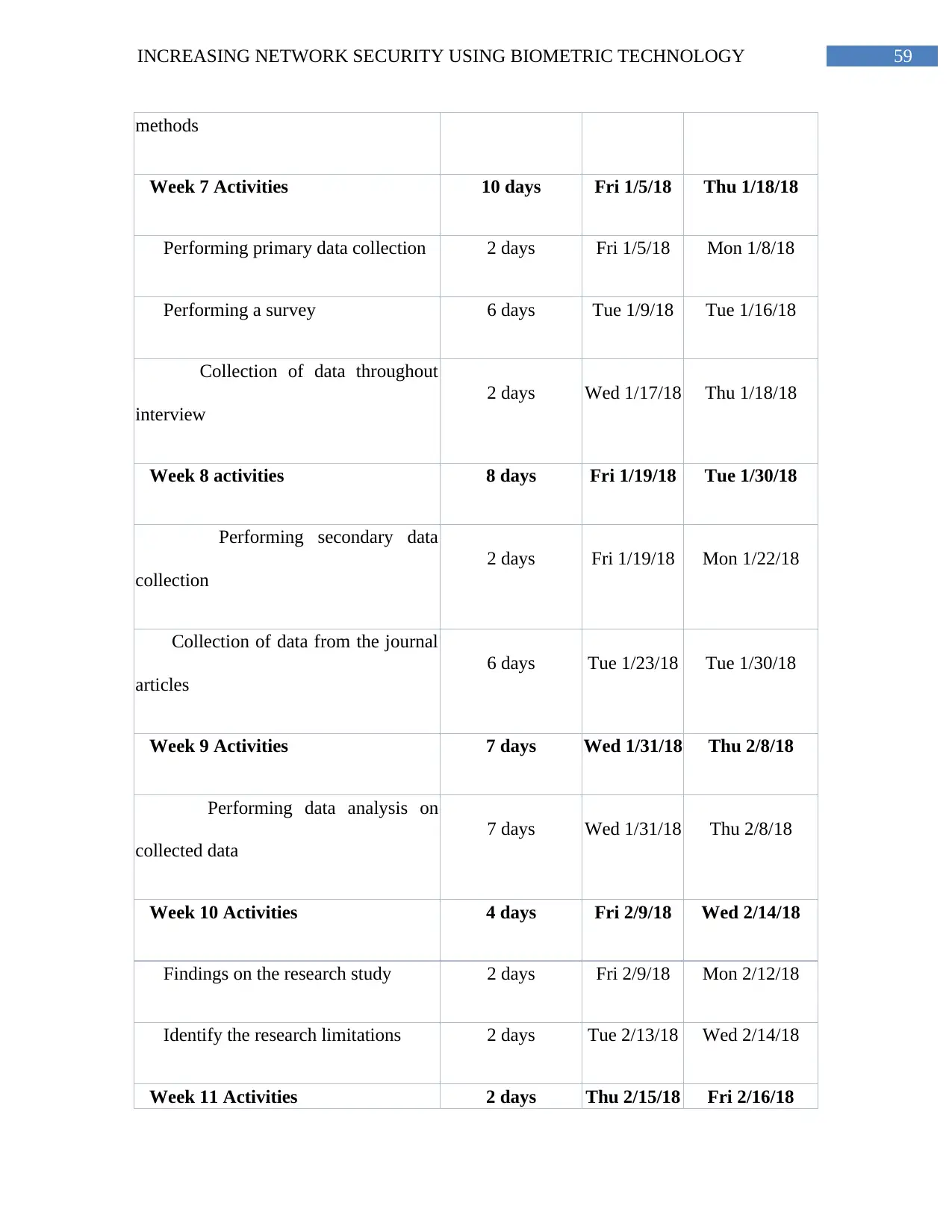
59INCREASING NETWORK SECURITY USING BIOMETRIC TECHNOLOGY
methods
Week 7 Activities 10 days Fri 1/5/18 Thu 1/18/18
Performing primary data collection 2 days Fri 1/5/18 Mon 1/8/18
Performing a survey 6 days Tue 1/9/18 Tue 1/16/18
Collection of data throughout
interview
2 days Wed 1/17/18 Thu 1/18/18
Week 8 activities 8 days Fri 1/19/18 Tue 1/30/18
Performing secondary data
collection
2 days Fri 1/19/18 Mon 1/22/18
Collection of data from the journal
articles
6 days Tue 1/23/18 Tue 1/30/18
Week 9 Activities 7 days Wed 1/31/18 Thu 2/8/18
Performing data analysis on
collected data
7 days Wed 1/31/18 Thu 2/8/18
Week 10 Activities 4 days Fri 2/9/18 Wed 2/14/18
Findings on the research study 2 days Fri 2/9/18 Mon 2/12/18
Identify the research limitations 2 days Tue 2/13/18 Wed 2/14/18
Week 11 Activities 2 days Thu 2/15/18 Fri 2/16/18
methods
Week 7 Activities 10 days Fri 1/5/18 Thu 1/18/18
Performing primary data collection 2 days Fri 1/5/18 Mon 1/8/18
Performing a survey 6 days Tue 1/9/18 Tue 1/16/18
Collection of data throughout
interview
2 days Wed 1/17/18 Thu 1/18/18
Week 8 activities 8 days Fri 1/19/18 Tue 1/30/18
Performing secondary data
collection
2 days Fri 1/19/18 Mon 1/22/18
Collection of data from the journal
articles
6 days Tue 1/23/18 Tue 1/30/18
Week 9 Activities 7 days Wed 1/31/18 Thu 2/8/18
Performing data analysis on
collected data
7 days Wed 1/31/18 Thu 2/8/18
Week 10 Activities 4 days Fri 2/9/18 Wed 2/14/18
Findings on the research study 2 days Fri 2/9/18 Mon 2/12/18
Identify the research limitations 2 days Tue 2/13/18 Wed 2/14/18
Week 11 Activities 2 days Thu 2/15/18 Fri 2/16/18
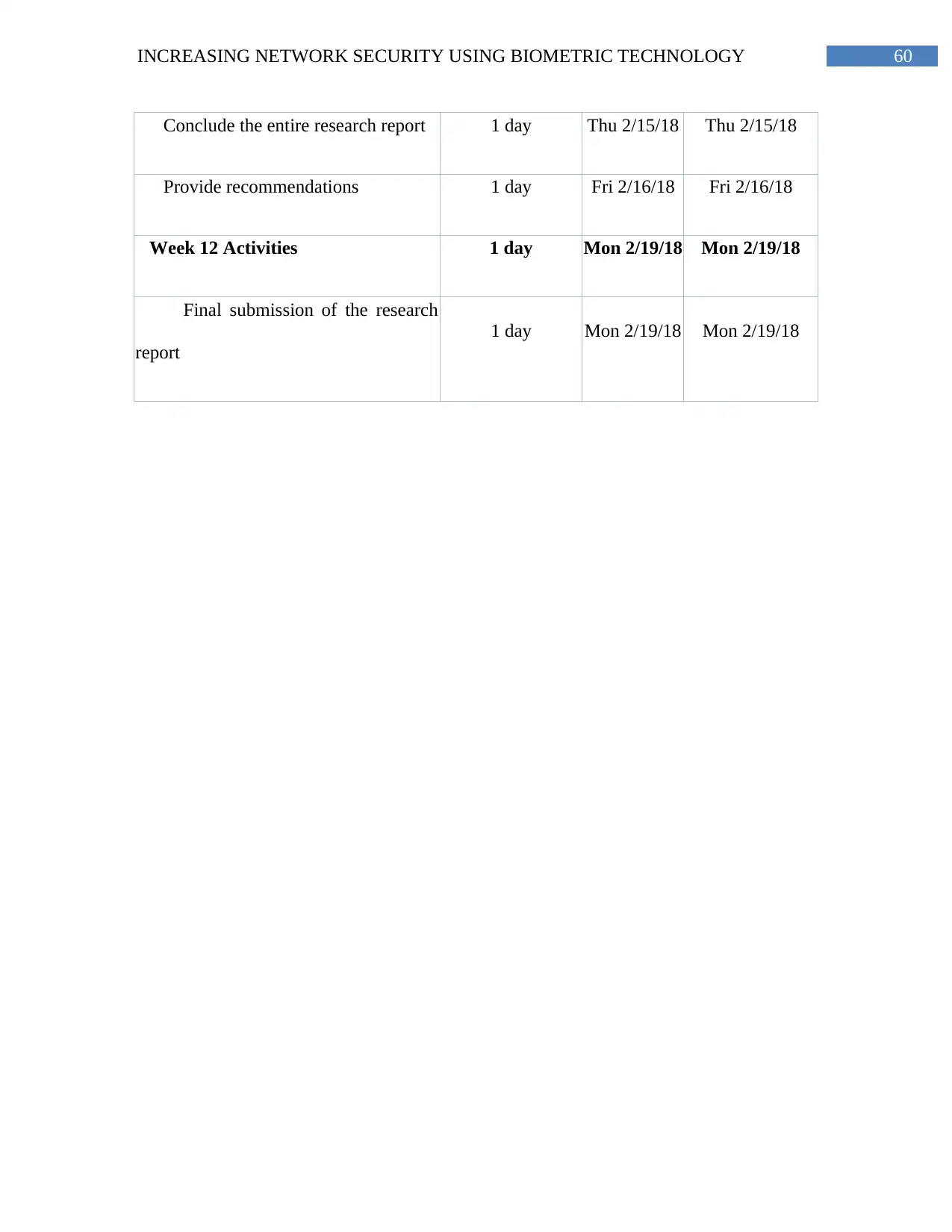
60INCREASING NETWORK SECURITY USING BIOMETRIC TECHNOLOGY
Conclude the entire research report 1 day Thu 2/15/18 Thu 2/15/18
Provide recommendations 1 day Fri 2/16/18 Fri 2/16/18
Week 12 Activities 1 day Mon 2/19/18 Mon 2/19/18
Final submission of the research
report
1 day Mon 2/19/18 Mon 2/19/18
Conclude the entire research report 1 day Thu 2/15/18 Thu 2/15/18
Provide recommendations 1 day Fri 2/16/18 Fri 2/16/18
Week 12 Activities 1 day Mon 2/19/18 Mon 2/19/18
Final submission of the research
report
1 day Mon 2/19/18 Mon 2/19/18
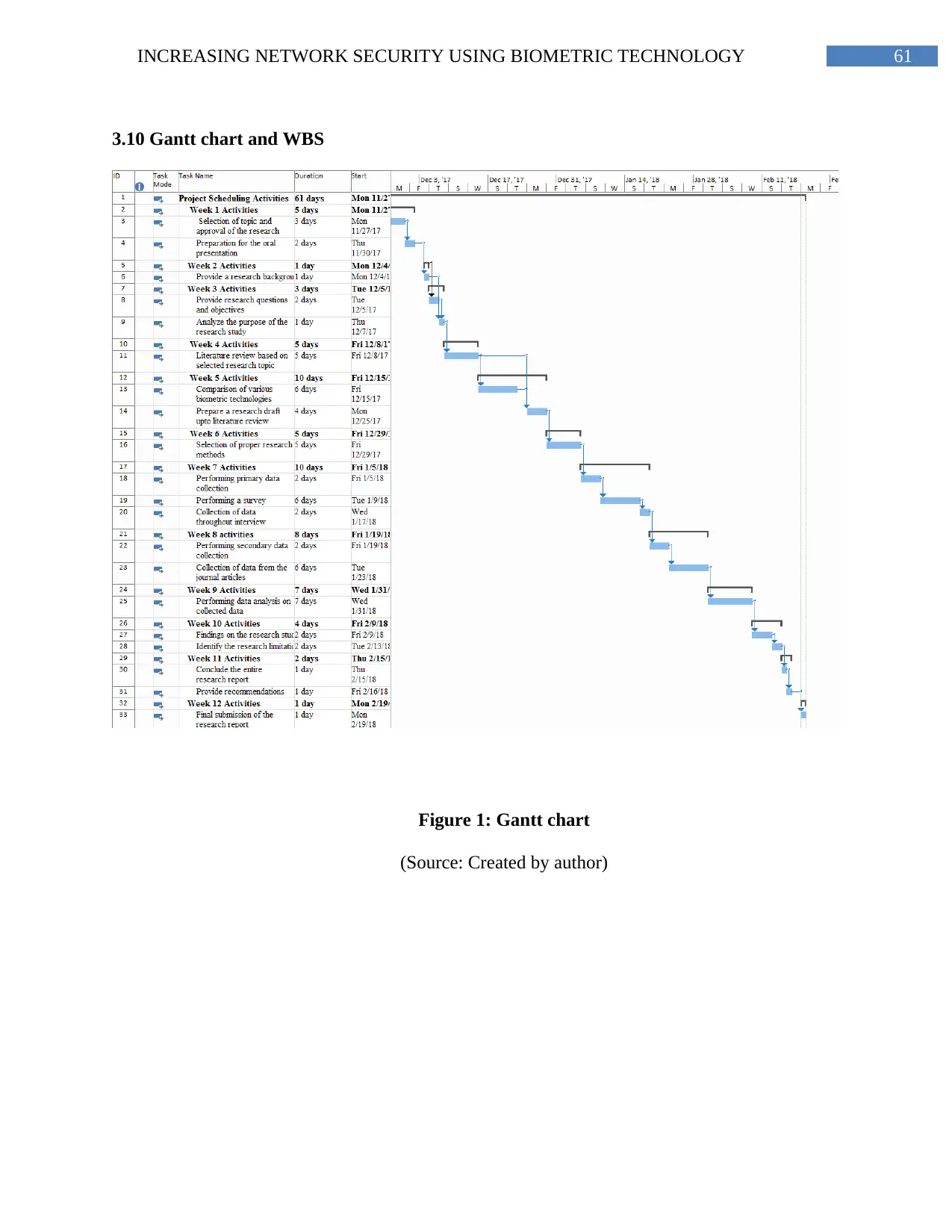
61INCREASING NETWORK SECURITY USING BIOMETRIC TECHNOLOGY
3.10 Gantt chart and WBS
Figure 1: Gantt chart
(Source: Created by author)
3.10 Gantt chart and WBS
Figure 1: Gantt chart
(Source: Created by author)
Paraphrase This Document
Need a fresh take? Get an instant paraphrase of this document with our AI Paraphraser
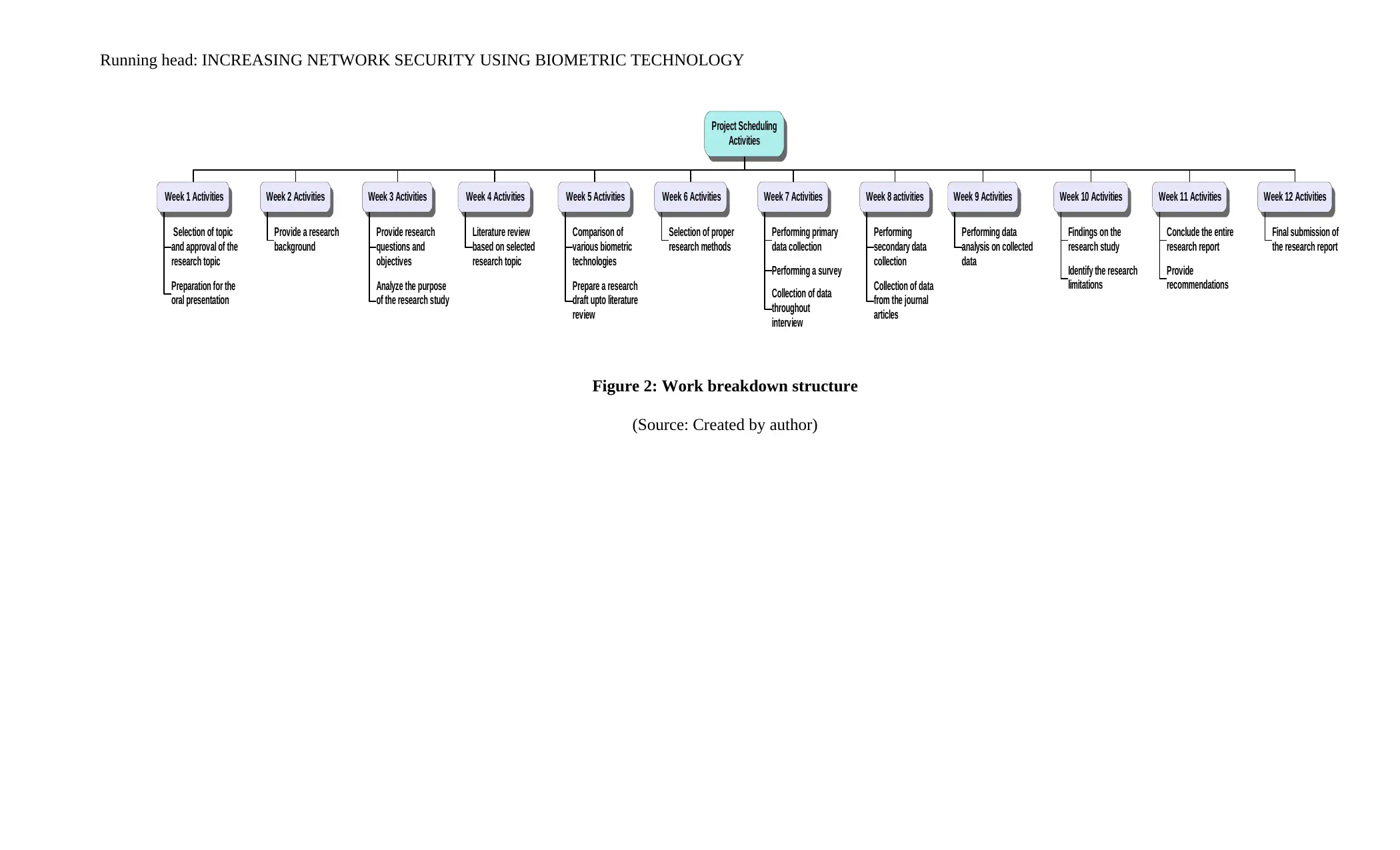
Running head: INCREASING NETWORK SECURITY USING BIOMETRIC TECHNOLOGY
Project Scheduling
Activities
Week 1 Activities
Selection of topic
and approval of the
research topic
Preparation for the
oral presentation
Week 2 Activities
Provide a research
background
Week 3 Activities
Provide research
questions and
objectives
Analyze the purpose
of the research study
Week 4 Activities
Literature review
based on selected
research topic
Week 5 Activities
Comparison of
various biometric
technologies
Prepare a research
draft upto literature
review
Week 6 Activities
Selection of proper
research methods
Week 7 Activities
Performing primary
data collection
Performing a survey
Collection of data
throughout
interview
Week 8 activities
Performing
secondary data
collection
Collection of data
from the journal
articles
Week 9 Activities
Performing data
analysis on collected
data
Week 10 Activities
Findings on the
research study
Identify the research
limitations
Week 11 Activities
Conclude the entire
research report
Provide
recommendations
Week 12 Activities
Final submission of
the research report
Figure 2: Work breakdown structure
(Source: Created by author)
Project Scheduling
Activities
Week 1 Activities
Selection of topic
and approval of the
research topic
Preparation for the
oral presentation
Week 2 Activities
Provide a research
background
Week 3 Activities
Provide research
questions and
objectives
Analyze the purpose
of the research study
Week 4 Activities
Literature review
based on selected
research topic
Week 5 Activities
Comparison of
various biometric
technologies
Prepare a research
draft upto literature
review
Week 6 Activities
Selection of proper
research methods
Week 7 Activities
Performing primary
data collection
Performing a survey
Collection of data
throughout
interview
Week 8 activities
Performing
secondary data
collection
Collection of data
from the journal
articles
Week 9 Activities
Performing data
analysis on collected
data
Week 10 Activities
Findings on the
research study
Identify the research
limitations
Week 11 Activities
Conclude the entire
research report
Provide
recommendations
Week 12 Activities
Final submission of
the research report
Figure 2: Work breakdown structure
(Source: Created by author)
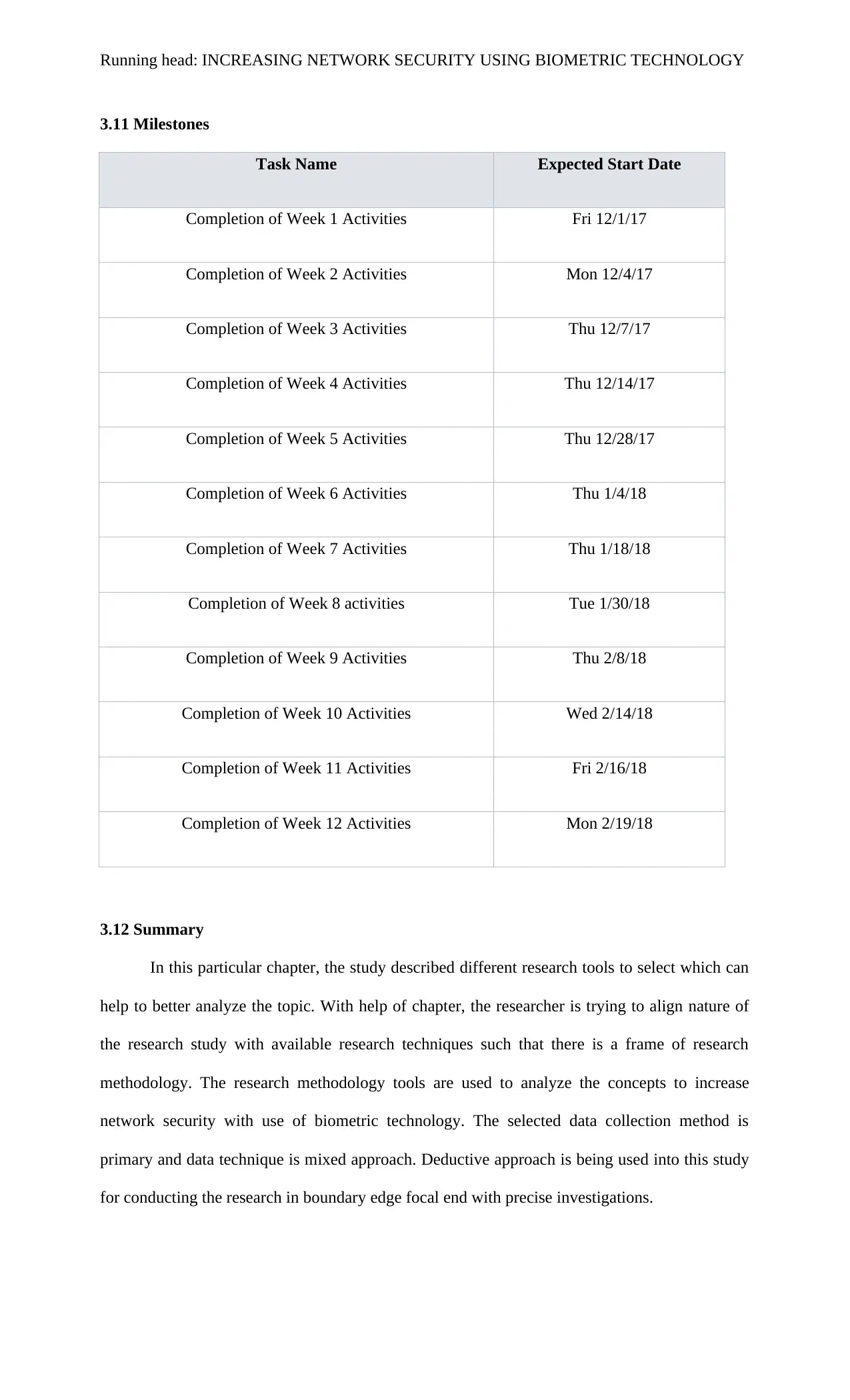
Running head: INCREASING NETWORK SECURITY USING BIOMETRIC TECHNOLOGY
3.11 Milestones
Task Name Expected Start Date
Completion of Week 1 Activities Fri 12/1/17
Completion of Week 2 Activities Mon 12/4/17
Completion of Week 3 Activities Thu 12/7/17
Completion of Week 4 Activities Thu 12/14/17
Completion of Week 5 Activities Thu 12/28/17
Completion of Week 6 Activities Thu 1/4/18
Completion of Week 7 Activities Thu 1/18/18
Completion of Week 8 activities Tue 1/30/18
Completion of Week 9 Activities Thu 2/8/18
Completion of Week 10 Activities Wed 2/14/18
Completion of Week 11 Activities Fri 2/16/18
Completion of Week 12 Activities Mon 2/19/18
3.12 Summary
In this particular chapter, the study described different research tools to select which can
help to better analyze the topic. With help of chapter, the researcher is trying to align nature of
the research study with available research techniques such that there is a frame of research
methodology. The research methodology tools are used to analyze the concepts to increase
network security with use of biometric technology. The selected data collection method is
primary and data technique is mixed approach. Deductive approach is being used into this study
for conducting the research in boundary edge focal end with precise investigations.
3.11 Milestones
Task Name Expected Start Date
Completion of Week 1 Activities Fri 12/1/17
Completion of Week 2 Activities Mon 12/4/17
Completion of Week 3 Activities Thu 12/7/17
Completion of Week 4 Activities Thu 12/14/17
Completion of Week 5 Activities Thu 12/28/17
Completion of Week 6 Activities Thu 1/4/18
Completion of Week 7 Activities Thu 1/18/18
Completion of Week 8 activities Tue 1/30/18
Completion of Week 9 Activities Thu 2/8/18
Completion of Week 10 Activities Wed 2/14/18
Completion of Week 11 Activities Fri 2/16/18
Completion of Week 12 Activities Mon 2/19/18
3.12 Summary
In this particular chapter, the study described different research tools to select which can
help to better analyze the topic. With help of chapter, the researcher is trying to align nature of
the research study with available research techniques such that there is a frame of research
methodology. The research methodology tools are used to analyze the concepts to increase
network security with use of biometric technology. The selected data collection method is
primary and data technique is mixed approach. Deductive approach is being used into this study
for conducting the research in boundary edge focal end with precise investigations.
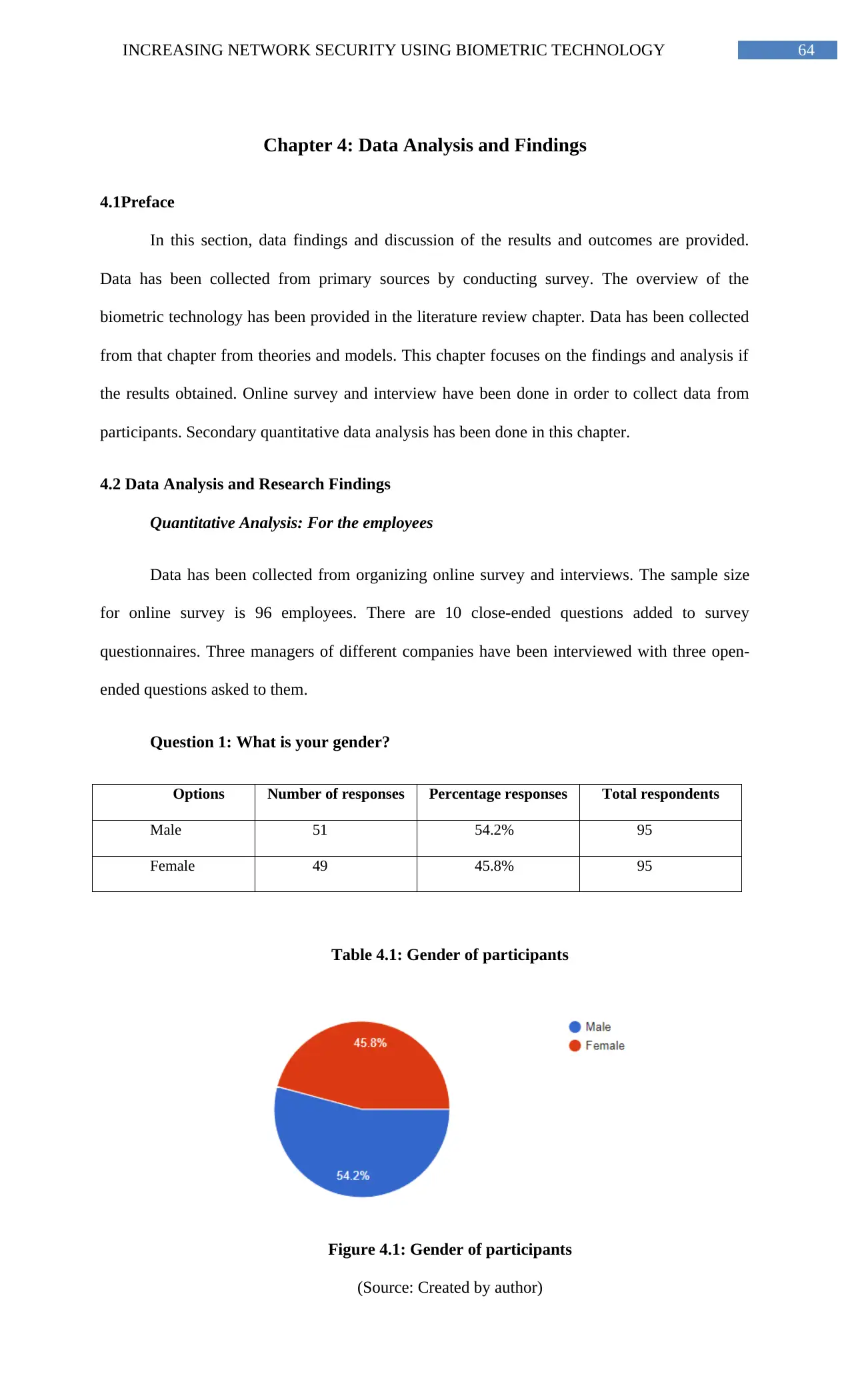
64INCREASING NETWORK SECURITY USING BIOMETRIC TECHNOLOGY
Chapter 4: Data Analysis and Findings
4.1Preface
In this section, data findings and discussion of the results and outcomes are provided.
Data has been collected from primary sources by conducting survey. The overview of the
biometric technology has been provided in the literature review chapter. Data has been collected
from that chapter from theories and models. This chapter focuses on the findings and analysis if
the results obtained. Online survey and interview have been done in order to collect data from
participants. Secondary quantitative data analysis has been done in this chapter.
4.2 Data Analysis and Research Findings
Quantitative Analysis: For the employees
Data has been collected from organizing online survey and interviews. The sample size
for online survey is 96 employees. There are 10 close-ended questions added to survey
questionnaires. Three managers of different companies have been interviewed with three open-
ended questions asked to them.
Question 1: What is your gender?
Options Number of responses Percentage responses Total respondents
Male 51 54.2% 95
Female 49 45.8% 95
Table 4.1: Gender of participants
Figure 4.1: Gender of participants
(Source: Created by author)
Chapter 4: Data Analysis and Findings
4.1Preface
In this section, data findings and discussion of the results and outcomes are provided.
Data has been collected from primary sources by conducting survey. The overview of the
biometric technology has been provided in the literature review chapter. Data has been collected
from that chapter from theories and models. This chapter focuses on the findings and analysis if
the results obtained. Online survey and interview have been done in order to collect data from
participants. Secondary quantitative data analysis has been done in this chapter.
4.2 Data Analysis and Research Findings
Quantitative Analysis: For the employees
Data has been collected from organizing online survey and interviews. The sample size
for online survey is 96 employees. There are 10 close-ended questions added to survey
questionnaires. Three managers of different companies have been interviewed with three open-
ended questions asked to them.
Question 1: What is your gender?
Options Number of responses Percentage responses Total respondents
Male 51 54.2% 95
Female 49 45.8% 95
Table 4.1: Gender of participants
Figure 4.1: Gender of participants
(Source: Created by author)
Secure Best Marks with AI Grader
Need help grading? Try our AI Grader for instant feedback on your assignments.
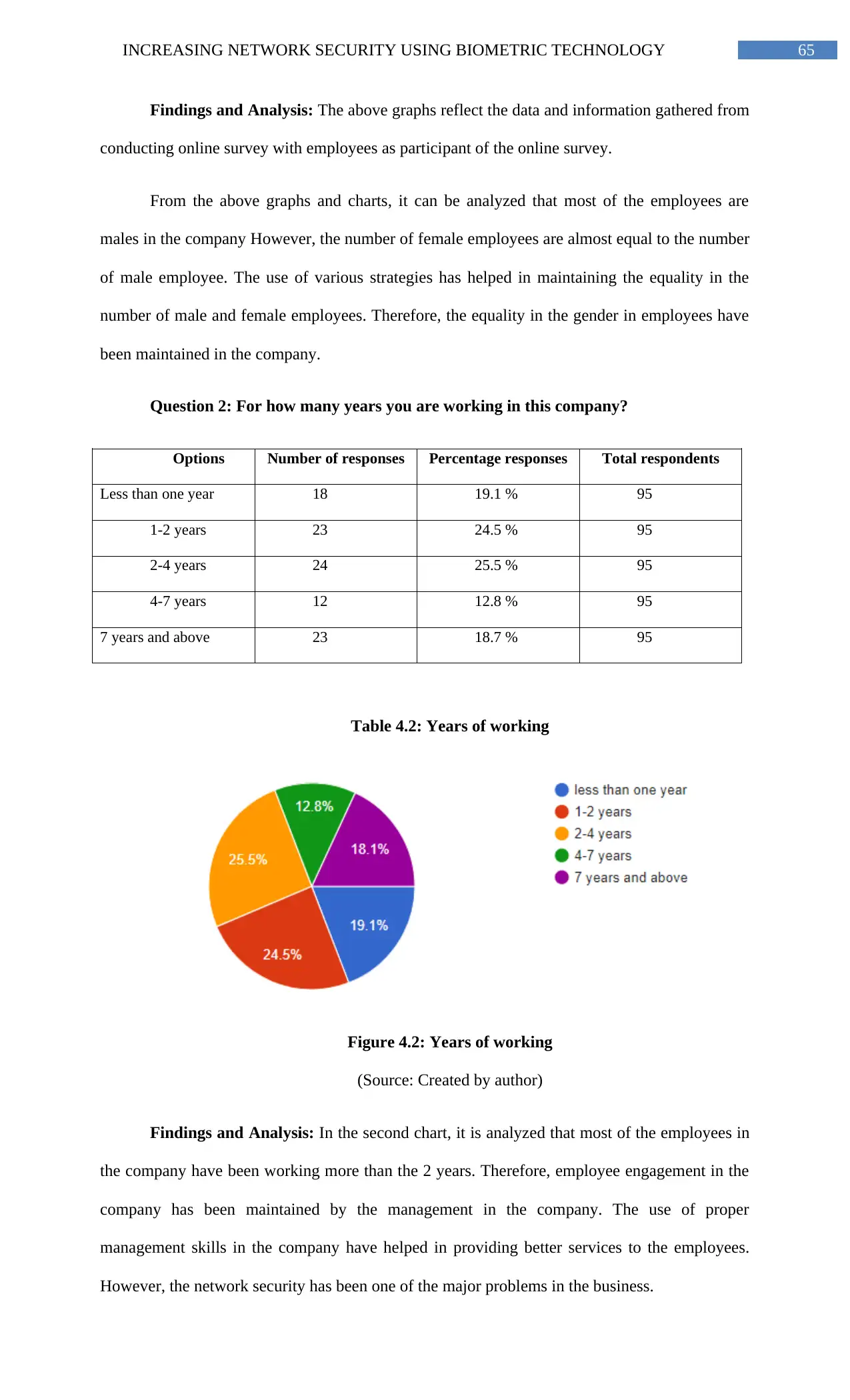
65INCREASING NETWORK SECURITY USING BIOMETRIC TECHNOLOGY
Findings and Analysis: The above graphs reflect the data and information gathered from
conducting online survey with employees as participant of the online survey.
From the above graphs and charts, it can be analyzed that most of the employees are
males in the company However, the number of female employees are almost equal to the number
of male employee. The use of various strategies has helped in maintaining the equality in the
number of male and female employees. Therefore, the equality in the gender in employees have
been maintained in the company.
Question 2: For how many years you are working in this company?
Options Number of responses Percentage responses Total respondents
Less than one year 18 19.1 % 95
1-2 years 23 24.5 % 95
2-4 years 24 25.5 % 95
4-7 years 12 12.8 % 95
7 years and above 23 18.7 % 95
Table 4.2: Years of working
Figure 4.2: Years of working
(Source: Created by author)
Findings and Analysis: In the second chart, it is analyzed that most of the employees in
the company have been working more than the 2 years. Therefore, employee engagement in the
company has been maintained by the management in the company. The use of proper
management skills in the company have helped in providing better services to the employees.
However, the network security has been one of the major problems in the business.
Findings and Analysis: The above graphs reflect the data and information gathered from
conducting online survey with employees as participant of the online survey.
From the above graphs and charts, it can be analyzed that most of the employees are
males in the company However, the number of female employees are almost equal to the number
of male employee. The use of various strategies has helped in maintaining the equality in the
number of male and female employees. Therefore, the equality in the gender in employees have
been maintained in the company.
Question 2: For how many years you are working in this company?
Options Number of responses Percentage responses Total respondents
Less than one year 18 19.1 % 95
1-2 years 23 24.5 % 95
2-4 years 24 25.5 % 95
4-7 years 12 12.8 % 95
7 years and above 23 18.7 % 95
Table 4.2: Years of working
Figure 4.2: Years of working
(Source: Created by author)
Findings and Analysis: In the second chart, it is analyzed that most of the employees in
the company have been working more than the 2 years. Therefore, employee engagement in the
company has been maintained by the management in the company. The use of proper
management skills in the company have helped in providing better services to the employees.
However, the network security has been one of the major problems in the business.
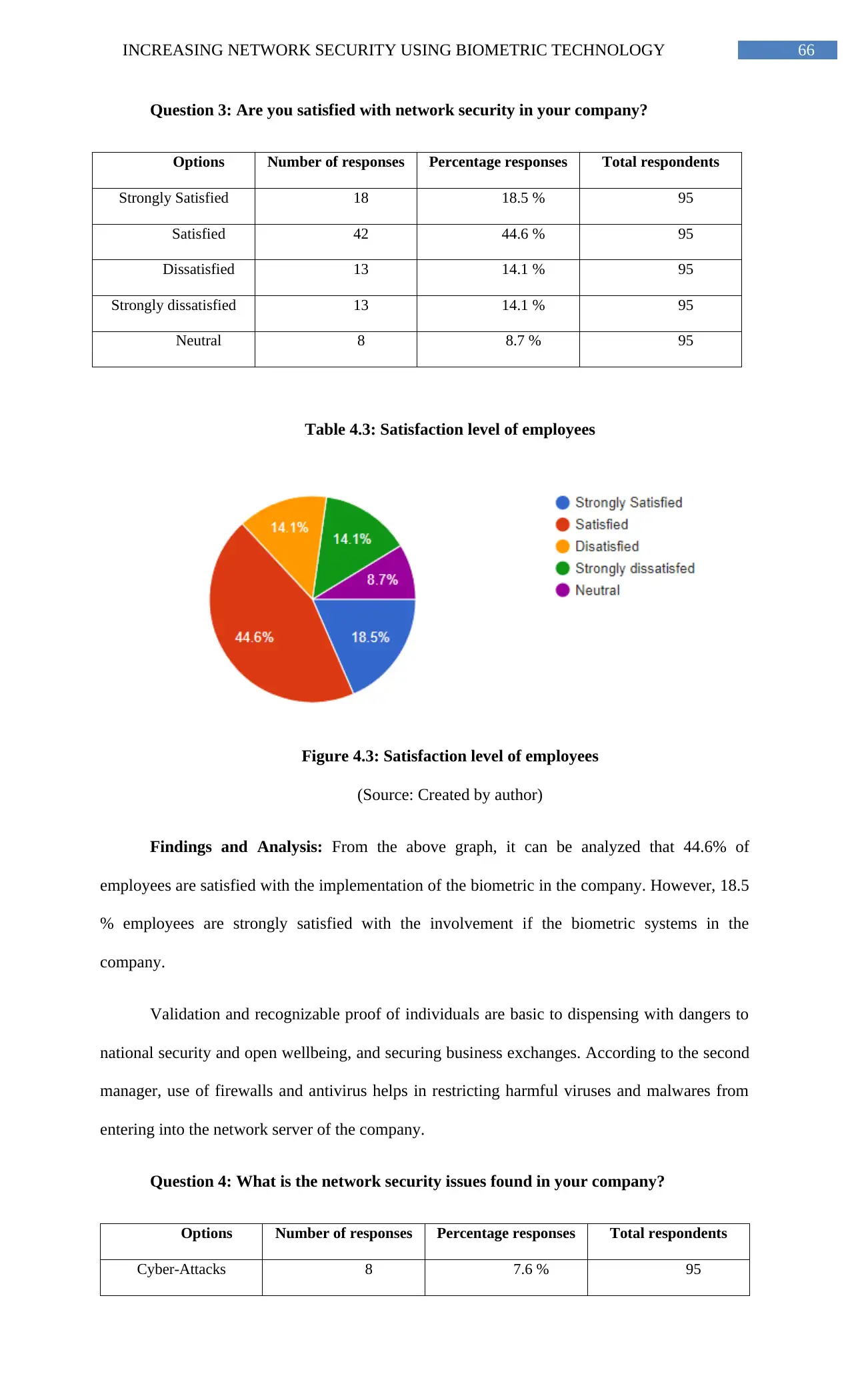
66INCREASING NETWORK SECURITY USING BIOMETRIC TECHNOLOGY
Question 3: Are you satisfied with network security in your company?
Options Number of responses Percentage responses Total respondents
Strongly Satisfied 18 18.5 % 95
Satisfied 42 44.6 % 95
Dissatisfied 13 14.1 % 95
Strongly dissatisfied 13 14.1 % 95
Neutral 8 8.7 % 95
Table 4.3: Satisfaction level of employees
Figure 4.3: Satisfaction level of employees
(Source: Created by author)
Findings and Analysis: From the above graph, it can be analyzed that 44.6% of
employees are satisfied with the implementation of the biometric in the company. However, 18.5
% employees are strongly satisfied with the involvement if the biometric systems in the
company.
Validation and recognizable proof of individuals are basic to dispensing with dangers to
national security and open wellbeing, and securing business exchanges. According to the second
manager, use of firewalls and antivirus helps in restricting harmful viruses and malwares from
entering into the network server of the company.
Question 4: What is the network security issues found in your company?
Options Number of responses Percentage responses Total respondents
Cyber-Attacks 8 7.6 % 95
Question 3: Are you satisfied with network security in your company?
Options Number of responses Percentage responses Total respondents
Strongly Satisfied 18 18.5 % 95
Satisfied 42 44.6 % 95
Dissatisfied 13 14.1 % 95
Strongly dissatisfied 13 14.1 % 95
Neutral 8 8.7 % 95
Table 4.3: Satisfaction level of employees
Figure 4.3: Satisfaction level of employees
(Source: Created by author)
Findings and Analysis: From the above graph, it can be analyzed that 44.6% of
employees are satisfied with the implementation of the biometric in the company. However, 18.5
% employees are strongly satisfied with the involvement if the biometric systems in the
company.
Validation and recognizable proof of individuals are basic to dispensing with dangers to
national security and open wellbeing, and securing business exchanges. According to the second
manager, use of firewalls and antivirus helps in restricting harmful viruses and malwares from
entering into the network server of the company.
Question 4: What is the network security issues found in your company?
Options Number of responses Percentage responses Total respondents
Cyber-Attacks 8 7.6 % 95
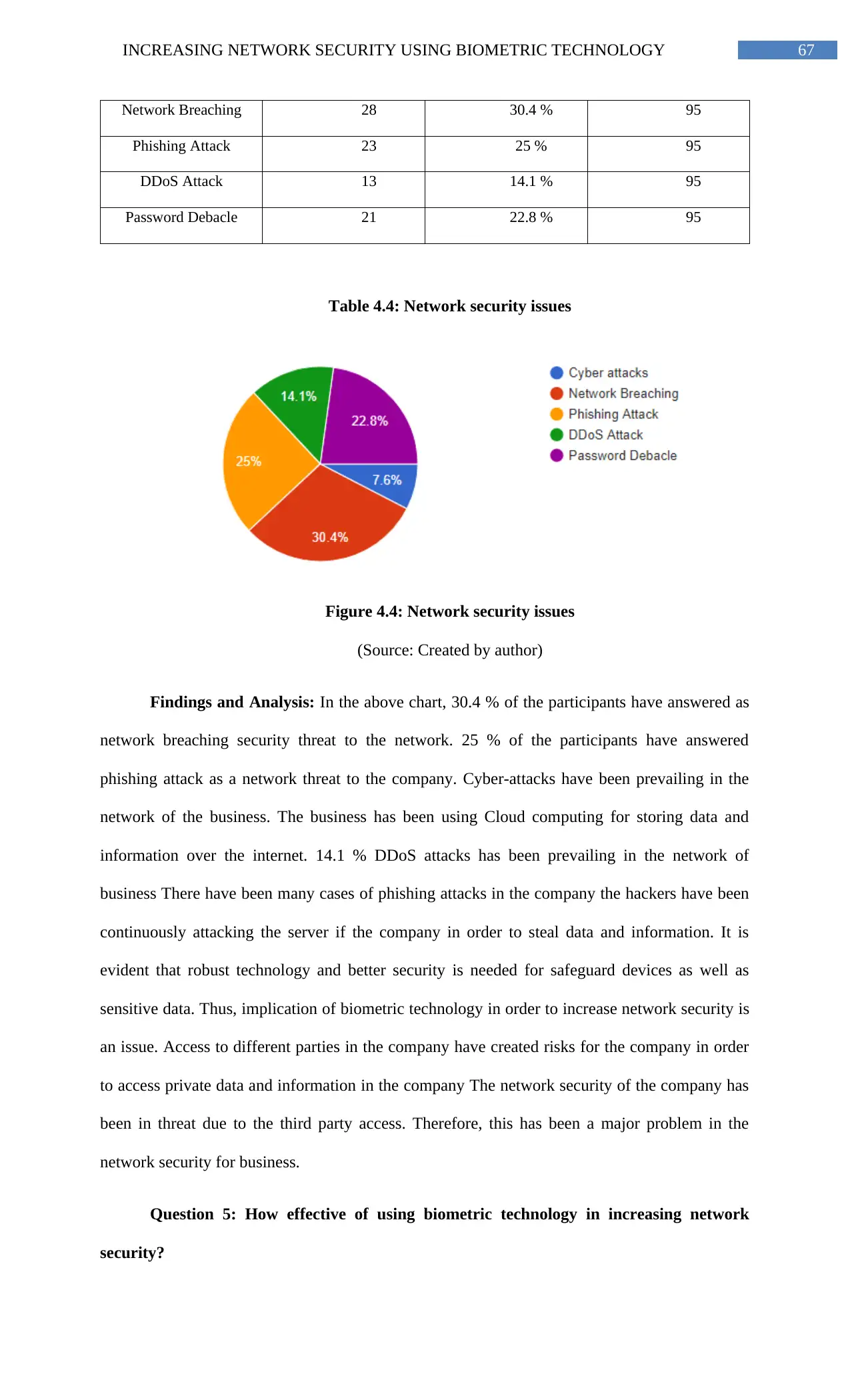
67INCREASING NETWORK SECURITY USING BIOMETRIC TECHNOLOGY
Network Breaching 28 30.4 % 95
Phishing Attack 23 25 % 95
DDoS Attack 13 14.1 % 95
Password Debacle 21 22.8 % 95
Table 4.4: Network security issues
Figure 4.4: Network security issues
(Source: Created by author)
Findings and Analysis: In the above chart, 30.4 % of the participants have answered as
network breaching security threat to the network. 25 % of the participants have answered
phishing attack as a network threat to the company. Cyber-attacks have been prevailing in the
network of the business. The business has been using Cloud computing for storing data and
information over the internet. 14.1 % DDoS attacks has been prevailing in the network of
business There have been many cases of phishing attacks in the company the hackers have been
continuously attacking the server if the company in order to steal data and information. It is
evident that robust technology and better security is needed for safeguard devices as well as
sensitive data. Thus, implication of biometric technology in order to increase network security is
an issue. Access to different parties in the company have created risks for the company in order
to access private data and information in the company The network security of the company has
been in threat due to the third party access. Therefore, this has been a major problem in the
network security for business.
Question 5: How effective of using biometric technology in increasing network
security?
Network Breaching 28 30.4 % 95
Phishing Attack 23 25 % 95
DDoS Attack 13 14.1 % 95
Password Debacle 21 22.8 % 95
Table 4.4: Network security issues
Figure 4.4: Network security issues
(Source: Created by author)
Findings and Analysis: In the above chart, 30.4 % of the participants have answered as
network breaching security threat to the network. 25 % of the participants have answered
phishing attack as a network threat to the company. Cyber-attacks have been prevailing in the
network of the business. The business has been using Cloud computing for storing data and
information over the internet. 14.1 % DDoS attacks has been prevailing in the network of
business There have been many cases of phishing attacks in the company the hackers have been
continuously attacking the server if the company in order to steal data and information. It is
evident that robust technology and better security is needed for safeguard devices as well as
sensitive data. Thus, implication of biometric technology in order to increase network security is
an issue. Access to different parties in the company have created risks for the company in order
to access private data and information in the company The network security of the company has
been in threat due to the third party access. Therefore, this has been a major problem in the
network security for business.
Question 5: How effective of using biometric technology in increasing network
security?
Paraphrase This Document
Need a fresh take? Get an instant paraphrase of this document with our AI Paraphraser
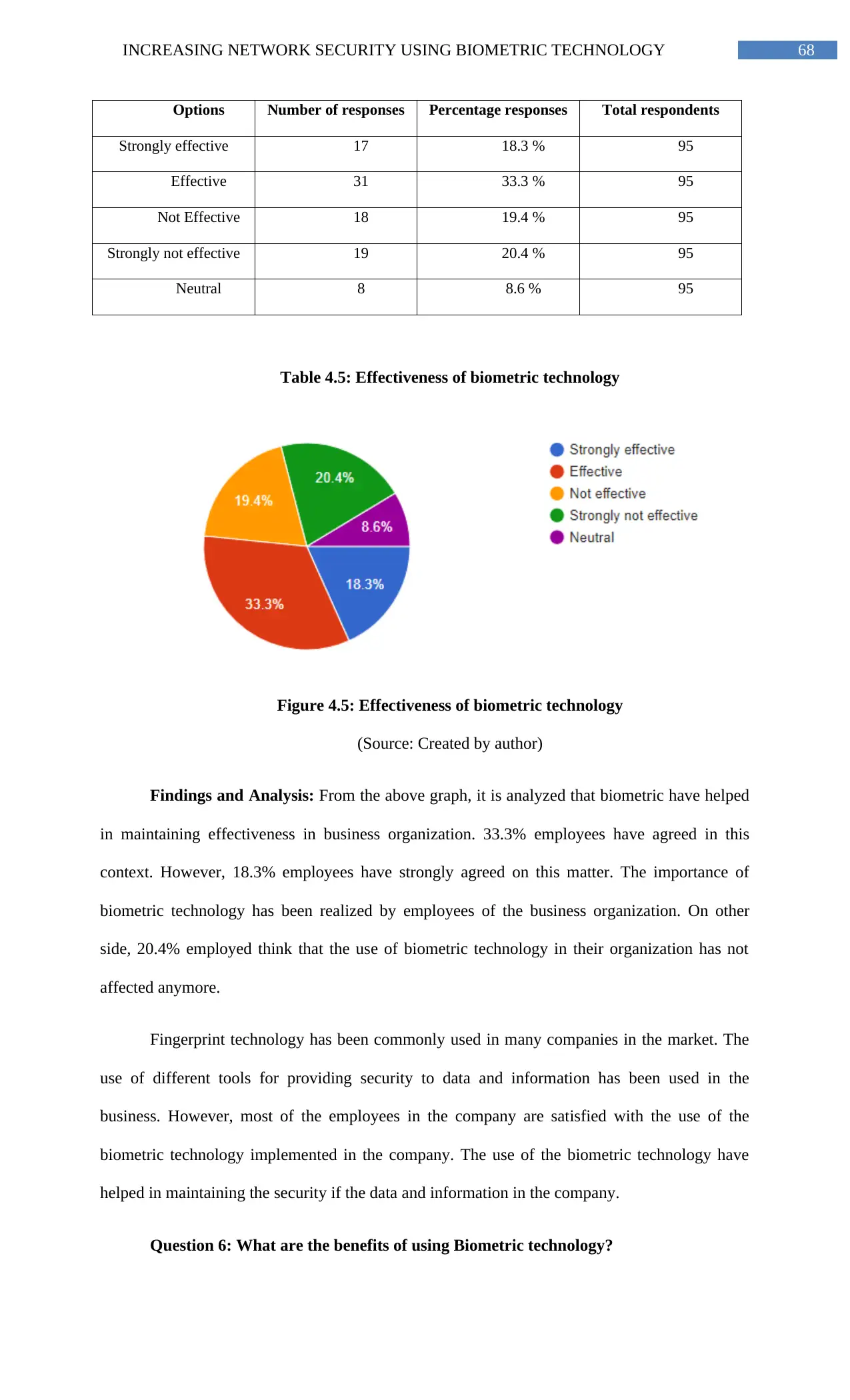
68INCREASING NETWORK SECURITY USING BIOMETRIC TECHNOLOGY
Options Number of responses Percentage responses Total respondents
Strongly effective 17 18.3 % 95
Effective 31 33.3 % 95
Not Effective 18 19.4 % 95
Strongly not effective 19 20.4 % 95
Neutral 8 8.6 % 95
Table 4.5: Effectiveness of biometric technology
Figure 4.5: Effectiveness of biometric technology
(Source: Created by author)
Findings and Analysis: From the above graph, it is analyzed that biometric have helped
in maintaining effectiveness in business organization. 33.3% employees have agreed in this
context. However, 18.3% employees have strongly agreed on this matter. The importance of
biometric technology has been realized by employees of the business organization. On other
side, 20.4% employed think that the use of biometric technology in their organization has not
affected anymore.
Fingerprint technology has been commonly used in many companies in the market. The
use of different tools for providing security to data and information has been used in the
business. However, most of the employees in the company are satisfied with the use of the
biometric technology implemented in the company. The use of the biometric technology have
helped in maintaining the security if the data and information in the company.
Question 6: What are the benefits of using Biometric technology?
Options Number of responses Percentage responses Total respondents
Strongly effective 17 18.3 % 95
Effective 31 33.3 % 95
Not Effective 18 19.4 % 95
Strongly not effective 19 20.4 % 95
Neutral 8 8.6 % 95
Table 4.5: Effectiveness of biometric technology
Figure 4.5: Effectiveness of biometric technology
(Source: Created by author)
Findings and Analysis: From the above graph, it is analyzed that biometric have helped
in maintaining effectiveness in business organization. 33.3% employees have agreed in this
context. However, 18.3% employees have strongly agreed on this matter. The importance of
biometric technology has been realized by employees of the business organization. On other
side, 20.4% employed think that the use of biometric technology in their organization has not
affected anymore.
Fingerprint technology has been commonly used in many companies in the market. The
use of different tools for providing security to data and information has been used in the
business. However, most of the employees in the company are satisfied with the use of the
biometric technology implemented in the company. The use of the biometric technology have
helped in maintaining the security if the data and information in the company.
Question 6: What are the benefits of using Biometric technology?
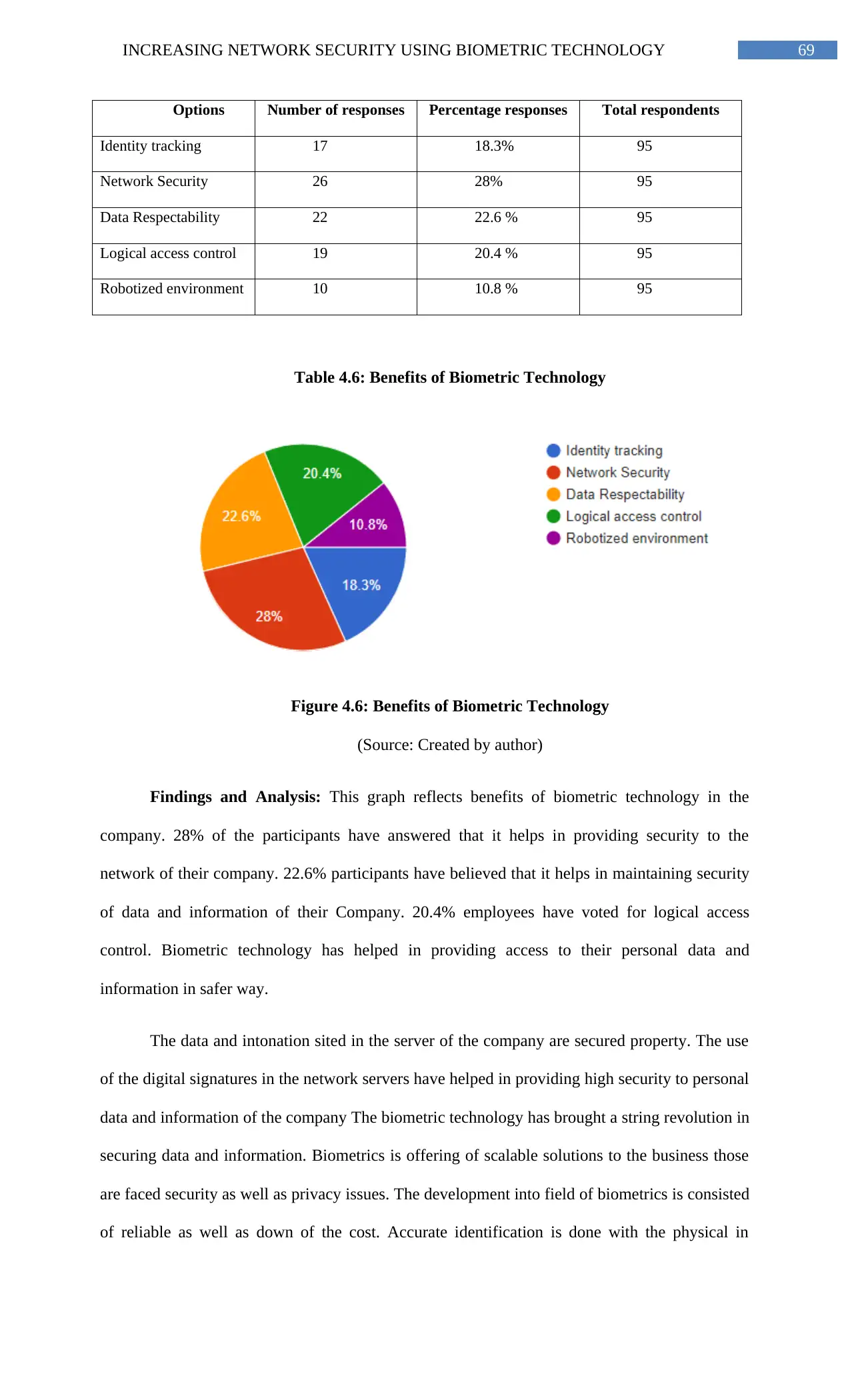
69INCREASING NETWORK SECURITY USING BIOMETRIC TECHNOLOGY
Options Number of responses Percentage responses Total respondents
Identity tracking 17 18.3% 95
Network Security 26 28% 95
Data Respectability 22 22.6 % 95
Logical access control 19 20.4 % 95
Robotized environment 10 10.8 % 95
Table 4.6: Benefits of Biometric Technology
Figure 4.6: Benefits of Biometric Technology
(Source: Created by author)
Findings and Analysis: This graph reflects benefits of biometric technology in the
company. 28% of the participants have answered that it helps in providing security to the
network of their company. 22.6% participants have believed that it helps in maintaining security
of data and information of their Company. 20.4% employees have voted for logical access
control. Biometric technology has helped in providing access to their personal data and
information in safer way.
The data and intonation sited in the server of the company are secured property. The use
of the digital signatures in the network servers have helped in providing high security to personal
data and information of the company The biometric technology has brought a string revolution in
securing data and information. Biometrics is offering of scalable solutions to the business those
are faced security as well as privacy issues. The development into field of biometrics is consisted
of reliable as well as down of the cost. Accurate identification is done with the physical in
Options Number of responses Percentage responses Total respondents
Identity tracking 17 18.3% 95
Network Security 26 28% 95
Data Respectability 22 22.6 % 95
Logical access control 19 20.4 % 95
Robotized environment 10 10.8 % 95
Table 4.6: Benefits of Biometric Technology
Figure 4.6: Benefits of Biometric Technology
(Source: Created by author)
Findings and Analysis: This graph reflects benefits of biometric technology in the
company. 28% of the participants have answered that it helps in providing security to the
network of their company. 22.6% participants have believed that it helps in maintaining security
of data and information of their Company. 20.4% employees have voted for logical access
control. Biometric technology has helped in providing access to their personal data and
information in safer way.
The data and intonation sited in the server of the company are secured property. The use
of the digital signatures in the network servers have helped in providing high security to personal
data and information of the company The biometric technology has brought a string revolution in
securing data and information. Biometrics is offering of scalable solutions to the business those
are faced security as well as privacy issues. The development into field of biometrics is consisted
of reliable as well as down of the cost. Accurate identification is done with the physical in
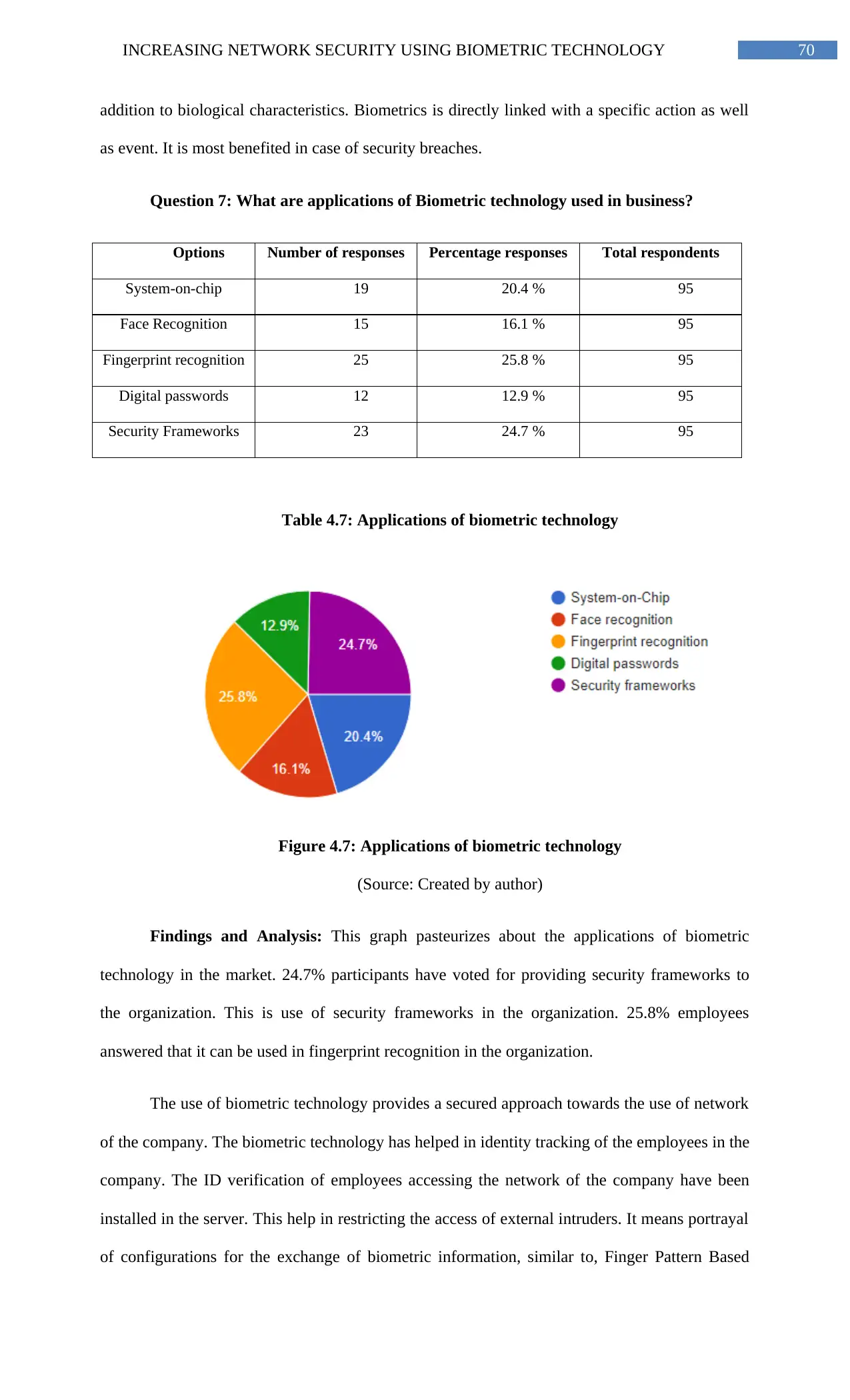
70INCREASING NETWORK SECURITY USING BIOMETRIC TECHNOLOGY
addition to biological characteristics. Biometrics is directly linked with a specific action as well
as event. It is most benefited in case of security breaches.
Question 7: What are applications of Biometric technology used in business?
Options Number of responses Percentage responses Total respondents
System-on-chip 19 20.4 % 95
Face Recognition 15 16.1 % 95
Fingerprint recognition 25 25.8 % 95
Digital passwords 12 12.9 % 95
Security Frameworks 23 24.7 % 95
Table 4.7: Applications of biometric technology
Figure 4.7: Applications of biometric technology
(Source: Created by author)
Findings and Analysis: This graph pasteurizes about the applications of biometric
technology in the market. 24.7% participants have voted for providing security frameworks to
the organization. This is use of security frameworks in the organization. 25.8% employees
answered that it can be used in fingerprint recognition in the organization.
The use of biometric technology provides a secured approach towards the use of network
of the company. The biometric technology has helped in identity tracking of the employees in the
company. The ID verification of employees accessing the network of the company have been
installed in the server. This help in restricting the access of external intruders. It means portrayal
of configurations for the exchange of biometric information, similar to, Finger Pattern Based
addition to biological characteristics. Biometrics is directly linked with a specific action as well
as event. It is most benefited in case of security breaches.
Question 7: What are applications of Biometric technology used in business?
Options Number of responses Percentage responses Total respondents
System-on-chip 19 20.4 % 95
Face Recognition 15 16.1 % 95
Fingerprint recognition 25 25.8 % 95
Digital passwords 12 12.9 % 95
Security Frameworks 23 24.7 % 95
Table 4.7: Applications of biometric technology
Figure 4.7: Applications of biometric technology
(Source: Created by author)
Findings and Analysis: This graph pasteurizes about the applications of biometric
technology in the market. 24.7% participants have voted for providing security frameworks to
the organization. This is use of security frameworks in the organization. 25.8% employees
answered that it can be used in fingerprint recognition in the organization.
The use of biometric technology provides a secured approach towards the use of network
of the company. The biometric technology has helped in identity tracking of the employees in the
company. The ID verification of employees accessing the network of the company have been
installed in the server. This help in restricting the access of external intruders. It means portrayal
of configurations for the exchange of biometric information, similar to, Finger Pattern Based
Secure Best Marks with AI Grader
Need help grading? Try our AI Grader for instant feedback on your assignments.
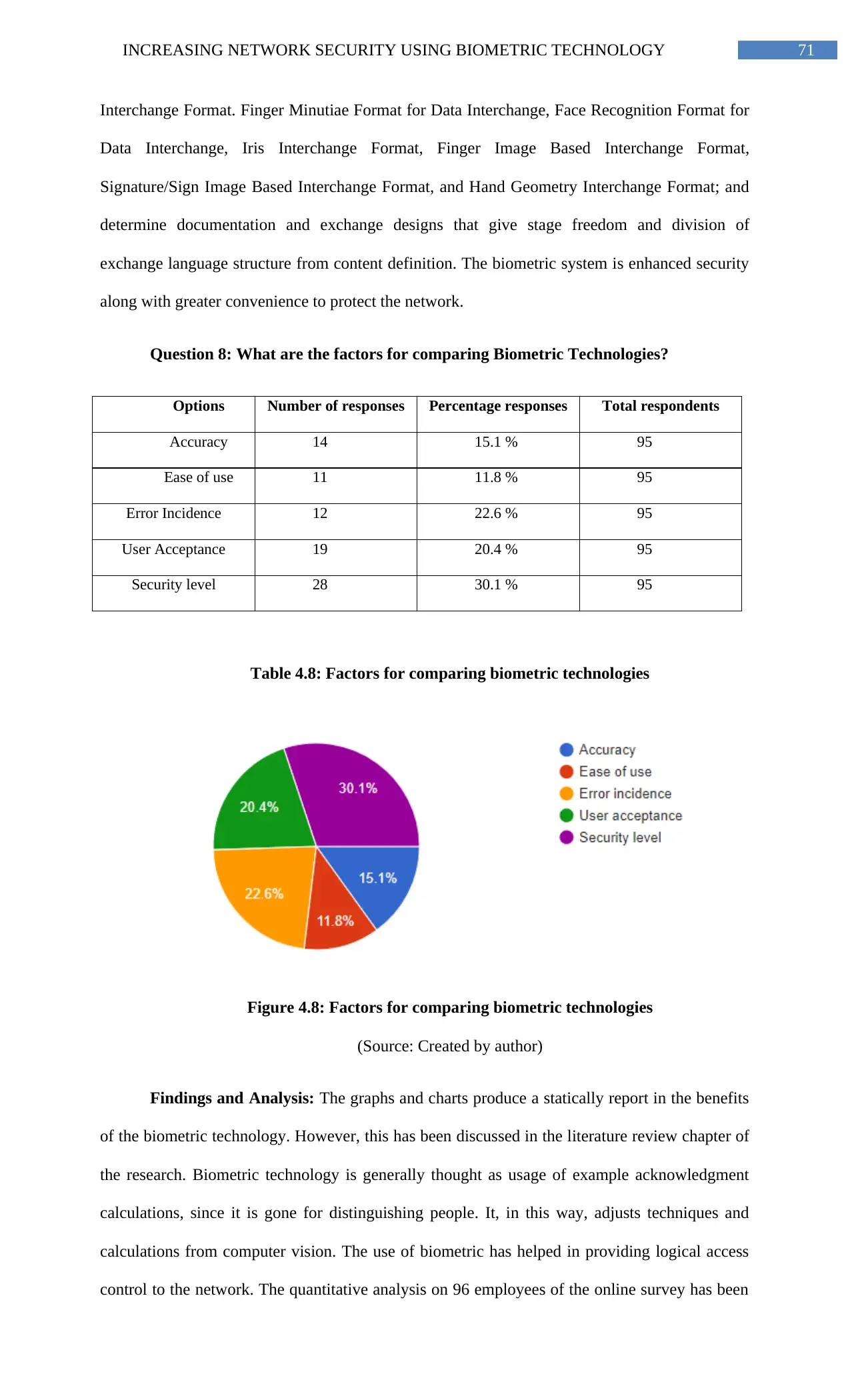
71INCREASING NETWORK SECURITY USING BIOMETRIC TECHNOLOGY
Interchange Format. Finger Minutiae Format for Data Interchange, Face Recognition Format for
Data Interchange, Iris Interchange Format, Finger Image Based Interchange Format,
Signature/Sign Image Based Interchange Format, and Hand Geometry Interchange Format; and
determine documentation and exchange designs that give stage freedom and division of
exchange language structure from content definition. The biometric system is enhanced security
along with greater convenience to protect the network.
Question 8: What are the factors for comparing Biometric Technologies?
Options Number of responses Percentage responses Total respondents
Accuracy 14 15.1 % 95
Ease of use 11 11.8 % 95
Error Incidence 12 22.6 % 95
User Acceptance 19 20.4 % 95
Security level 28 30.1 % 95
Table 4.8: Factors for comparing biometric technologies
Figure 4.8: Factors for comparing biometric technologies
(Source: Created by author)
Findings and Analysis: The graphs and charts produce a statically report in the benefits
of the biometric technology. However, this has been discussed in the literature review chapter of
the research. Biometric technology is generally thought as usage of example acknowledgment
calculations, since it is gone for distinguishing people. It, in this way, adjusts techniques and
calculations from computer vision. The use of biometric has helped in providing logical access
control to the network. The quantitative analysis on 96 employees of the online survey has been
Interchange Format. Finger Minutiae Format for Data Interchange, Face Recognition Format for
Data Interchange, Iris Interchange Format, Finger Image Based Interchange Format,
Signature/Sign Image Based Interchange Format, and Hand Geometry Interchange Format; and
determine documentation and exchange designs that give stage freedom and division of
exchange language structure from content definition. The biometric system is enhanced security
along with greater convenience to protect the network.
Question 8: What are the factors for comparing Biometric Technologies?
Options Number of responses Percentage responses Total respondents
Accuracy 14 15.1 % 95
Ease of use 11 11.8 % 95
Error Incidence 12 22.6 % 95
User Acceptance 19 20.4 % 95
Security level 28 30.1 % 95
Table 4.8: Factors for comparing biometric technologies
Figure 4.8: Factors for comparing biometric technologies
(Source: Created by author)
Findings and Analysis: The graphs and charts produce a statically report in the benefits
of the biometric technology. However, this has been discussed in the literature review chapter of
the research. Biometric technology is generally thought as usage of example acknowledgment
calculations, since it is gone for distinguishing people. It, in this way, adjusts techniques and
calculations from computer vision. The use of biometric has helped in providing logical access
control to the network. The quantitative analysis on 96 employees of the online survey has been
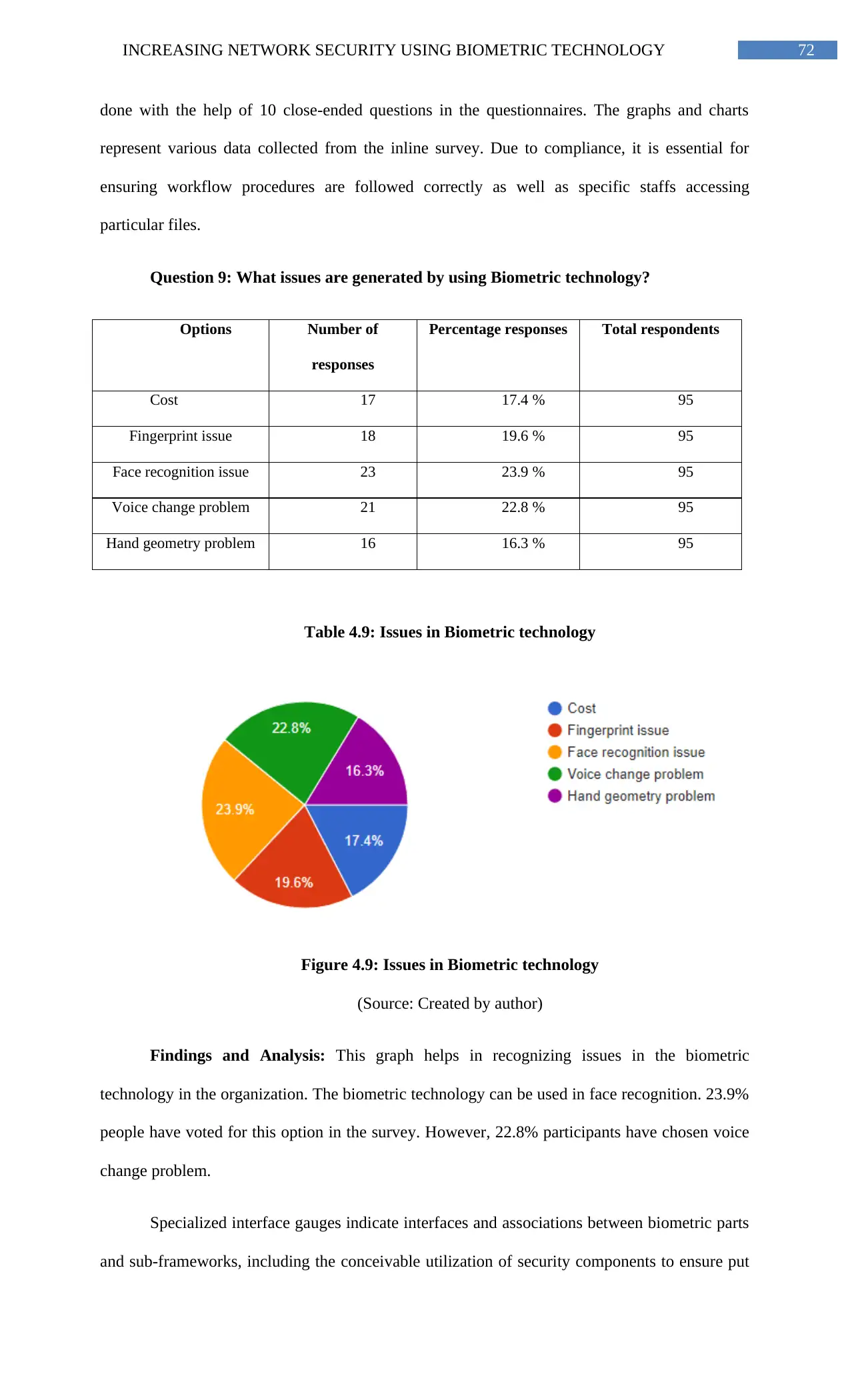
72INCREASING NETWORK SECURITY USING BIOMETRIC TECHNOLOGY
done with the help of 10 close-ended questions in the questionnaires. The graphs and charts
represent various data collected from the inline survey. Due to compliance, it is essential for
ensuring workflow procedures are followed correctly as well as specific staffs accessing
particular files.
Question 9: What issues are generated by using Biometric technology?
Options Number of
responses
Percentage responses Total respondents
Cost 17 17.4 % 95
Fingerprint issue 18 19.6 % 95
Face recognition issue 23 23.9 % 95
Voice change problem 21 22.8 % 95
Hand geometry problem 16 16.3 % 95
Table 4.9: Issues in Biometric technology
Figure 4.9: Issues in Biometric technology
(Source: Created by author)
Findings and Analysis: This graph helps in recognizing issues in the biometric
technology in the organization. The biometric technology can be used in face recognition. 23.9%
people have voted for this option in the survey. However, 22.8% participants have chosen voice
change problem.
Specialized interface gauges indicate interfaces and associations between biometric parts
and sub-frameworks, including the conceivable utilization of security components to ensure put
done with the help of 10 close-ended questions in the questionnaires. The graphs and charts
represent various data collected from the inline survey. Due to compliance, it is essential for
ensuring workflow procedures are followed correctly as well as specific staffs accessing
particular files.
Question 9: What issues are generated by using Biometric technology?
Options Number of
responses
Percentage responses Total respondents
Cost 17 17.4 % 95
Fingerprint issue 18 19.6 % 95
Face recognition issue 23 23.9 % 95
Voice change problem 21 22.8 % 95
Hand geometry problem 16 16.3 % 95
Table 4.9: Issues in Biometric technology
Figure 4.9: Issues in Biometric technology
(Source: Created by author)
Findings and Analysis: This graph helps in recognizing issues in the biometric
technology in the organization. The biometric technology can be used in face recognition. 23.9%
people have voted for this option in the survey. However, 22.8% participants have chosen voice
change problem.
Specialized interface gauges indicate interfaces and associations between biometric parts
and sub-frameworks, including the conceivable utilization of security components to ensure put
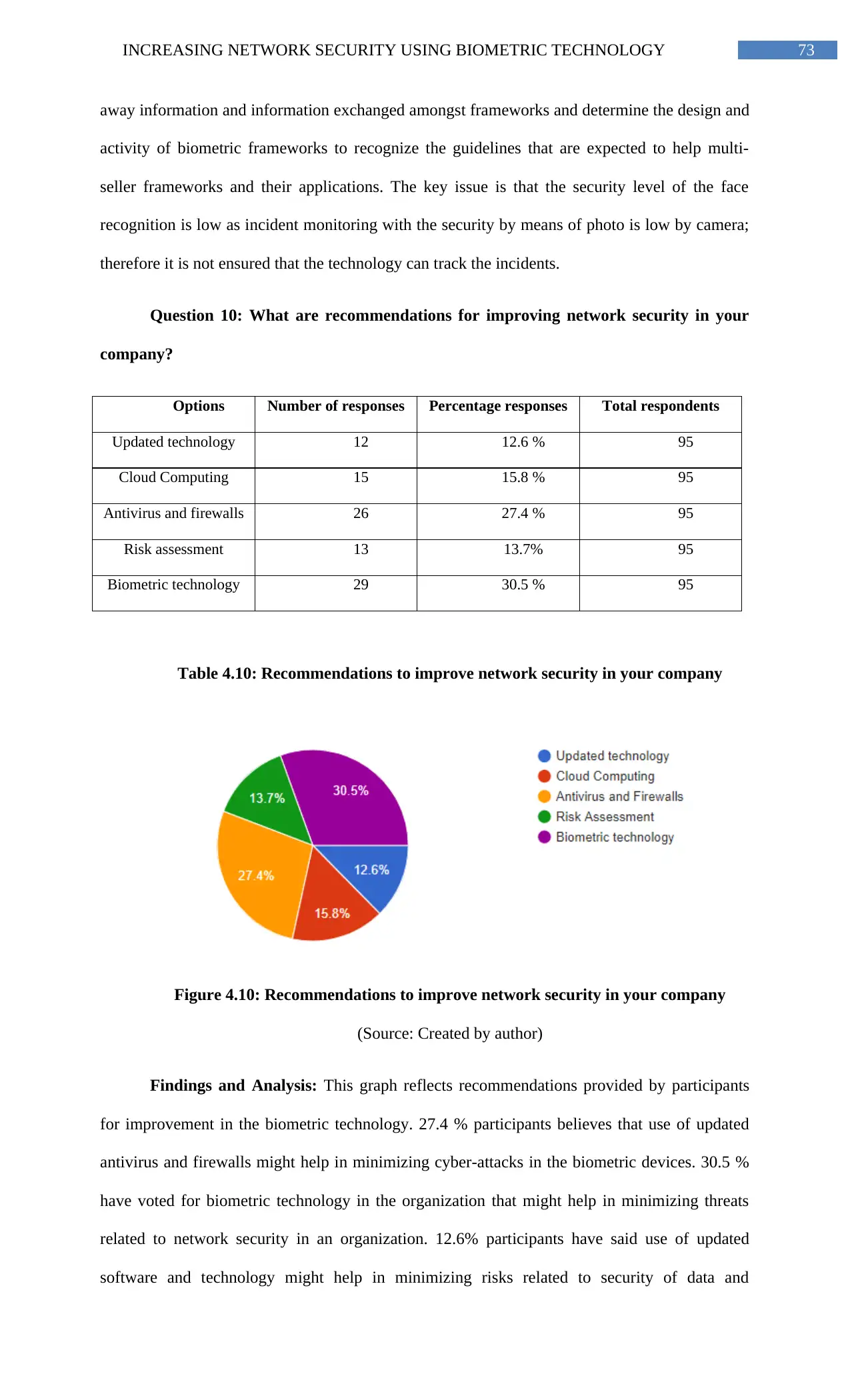
73INCREASING NETWORK SECURITY USING BIOMETRIC TECHNOLOGY
away information and information exchanged amongst frameworks and determine the design and
activity of biometric frameworks to recognize the guidelines that are expected to help multi-
seller frameworks and their applications. The key issue is that the security level of the face
recognition is low as incident monitoring with the security by means of photo is low by camera;
therefore it is not ensured that the technology can track the incidents.
Question 10: What are recommendations for improving network security in your
company?
Options Number of responses Percentage responses Total respondents
Updated technology 12 12.6 % 95
Cloud Computing 15 15.8 % 95
Antivirus and firewalls 26 27.4 % 95
Risk assessment 13 13.7% 95
Biometric technology 29 30.5 % 95
Table 4.10: Recommendations to improve network security in your company
Figure 4.10: Recommendations to improve network security in your company
(Source: Created by author)
Findings and Analysis: This graph reflects recommendations provided by participants
for improvement in the biometric technology. 27.4 % participants believes that use of updated
antivirus and firewalls might help in minimizing cyber-attacks in the biometric devices. 30.5 %
have voted for biometric technology in the organization that might help in minimizing threats
related to network security in an organization. 12.6% participants have said use of updated
software and technology might help in minimizing risks related to security of data and
away information and information exchanged amongst frameworks and determine the design and
activity of biometric frameworks to recognize the guidelines that are expected to help multi-
seller frameworks and their applications. The key issue is that the security level of the face
recognition is low as incident monitoring with the security by means of photo is low by camera;
therefore it is not ensured that the technology can track the incidents.
Question 10: What are recommendations for improving network security in your
company?
Options Number of responses Percentage responses Total respondents
Updated technology 12 12.6 % 95
Cloud Computing 15 15.8 % 95
Antivirus and firewalls 26 27.4 % 95
Risk assessment 13 13.7% 95
Biometric technology 29 30.5 % 95
Table 4.10: Recommendations to improve network security in your company
Figure 4.10: Recommendations to improve network security in your company
(Source: Created by author)
Findings and Analysis: This graph reflects recommendations provided by participants
for improvement in the biometric technology. 27.4 % participants believes that use of updated
antivirus and firewalls might help in minimizing cyber-attacks in the biometric devices. 30.5 %
have voted for biometric technology in the organization that might help in minimizing threats
related to network security in an organization. 12.6% participants have said use of updated
software and technology might help in minimizing risks related to security of data and
Paraphrase This Document
Need a fresh take? Get an instant paraphrase of this document with our AI Paraphraser
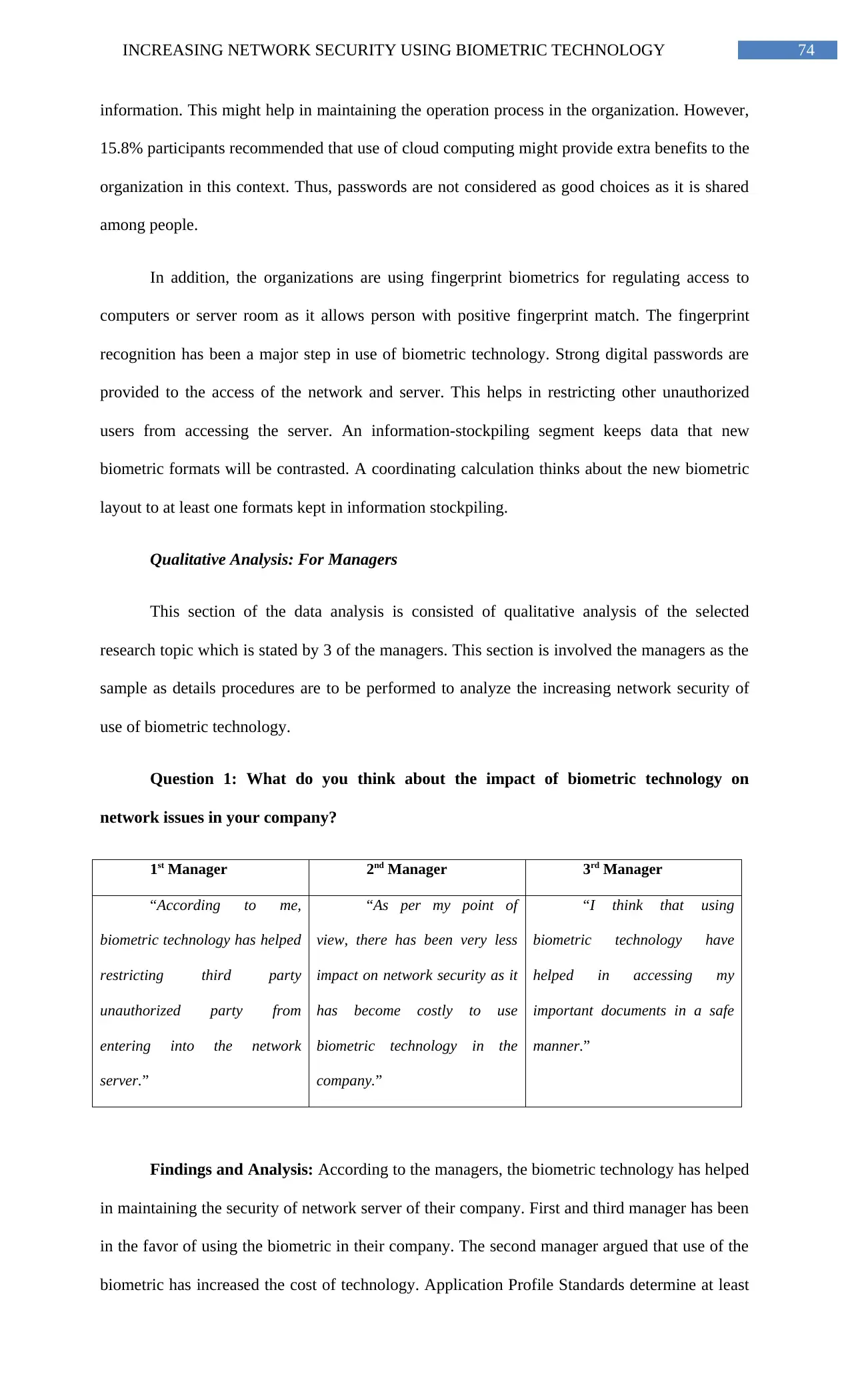
74INCREASING NETWORK SECURITY USING BIOMETRIC TECHNOLOGY
information. This might help in maintaining the operation process in the organization. However,
15.8% participants recommended that use of cloud computing might provide extra benefits to the
organization in this context. Thus, passwords are not considered as good choices as it is shared
among people.
In addition, the organizations are using fingerprint biometrics for regulating access to
computers or server room as it allows person with positive fingerprint match. The fingerprint
recognition has been a major step in use of biometric technology. Strong digital passwords are
provided to the access of the network and server. This helps in restricting other unauthorized
users from accessing the server. An information-stockpiling segment keeps data that new
biometric formats will be contrasted. A coordinating calculation thinks about the new biometric
layout to at least one formats kept in information stockpiling.
Qualitative Analysis: For Managers
This section of the data analysis is consisted of qualitative analysis of the selected
research topic which is stated by 3 of the managers. This section is involved the managers as the
sample as details procedures are to be performed to analyze the increasing network security of
use of biometric technology.
Question 1: What do you think about the impact of biometric technology on
network issues in your company?
1st Manager 2nd Manager 3rd Manager
“According to me,
biometric technology has helped
restricting third party
unauthorized party from
entering into the network
server.”
“As per my point of
view, there has been very less
impact on network security as it
has become costly to use
biometric technology in the
company.”
“I think that using
biometric technology have
helped in accessing my
important documents in a safe
manner.”
Findings and Analysis: According to the managers, the biometric technology has helped
in maintaining the security of network server of their company. First and third manager has been
in the favor of using the biometric in their company. The second manager argued that use of the
biometric has increased the cost of technology. Application Profile Standards determine at least
information. This might help in maintaining the operation process in the organization. However,
15.8% participants recommended that use of cloud computing might provide extra benefits to the
organization in this context. Thus, passwords are not considered as good choices as it is shared
among people.
In addition, the organizations are using fingerprint biometrics for regulating access to
computers or server room as it allows person with positive fingerprint match. The fingerprint
recognition has been a major step in use of biometric technology. Strong digital passwords are
provided to the access of the network and server. This helps in restricting other unauthorized
users from accessing the server. An information-stockpiling segment keeps data that new
biometric formats will be contrasted. A coordinating calculation thinks about the new biometric
layout to at least one formats kept in information stockpiling.
Qualitative Analysis: For Managers
This section of the data analysis is consisted of qualitative analysis of the selected
research topic which is stated by 3 of the managers. This section is involved the managers as the
sample as details procedures are to be performed to analyze the increasing network security of
use of biometric technology.
Question 1: What do you think about the impact of biometric technology on
network issues in your company?
1st Manager 2nd Manager 3rd Manager
“According to me,
biometric technology has helped
restricting third party
unauthorized party from
entering into the network
server.”
“As per my point of
view, there has been very less
impact on network security as it
has become costly to use
biometric technology in the
company.”
“I think that using
biometric technology have
helped in accessing my
important documents in a safe
manner.”
Findings and Analysis: According to the managers, the biometric technology has helped
in maintaining the security of network server of their company. First and third manager has been
in the favor of using the biometric in their company. The second manager argued that use of the
biometric has increased the cost of technology. Application Profile Standards determine at least
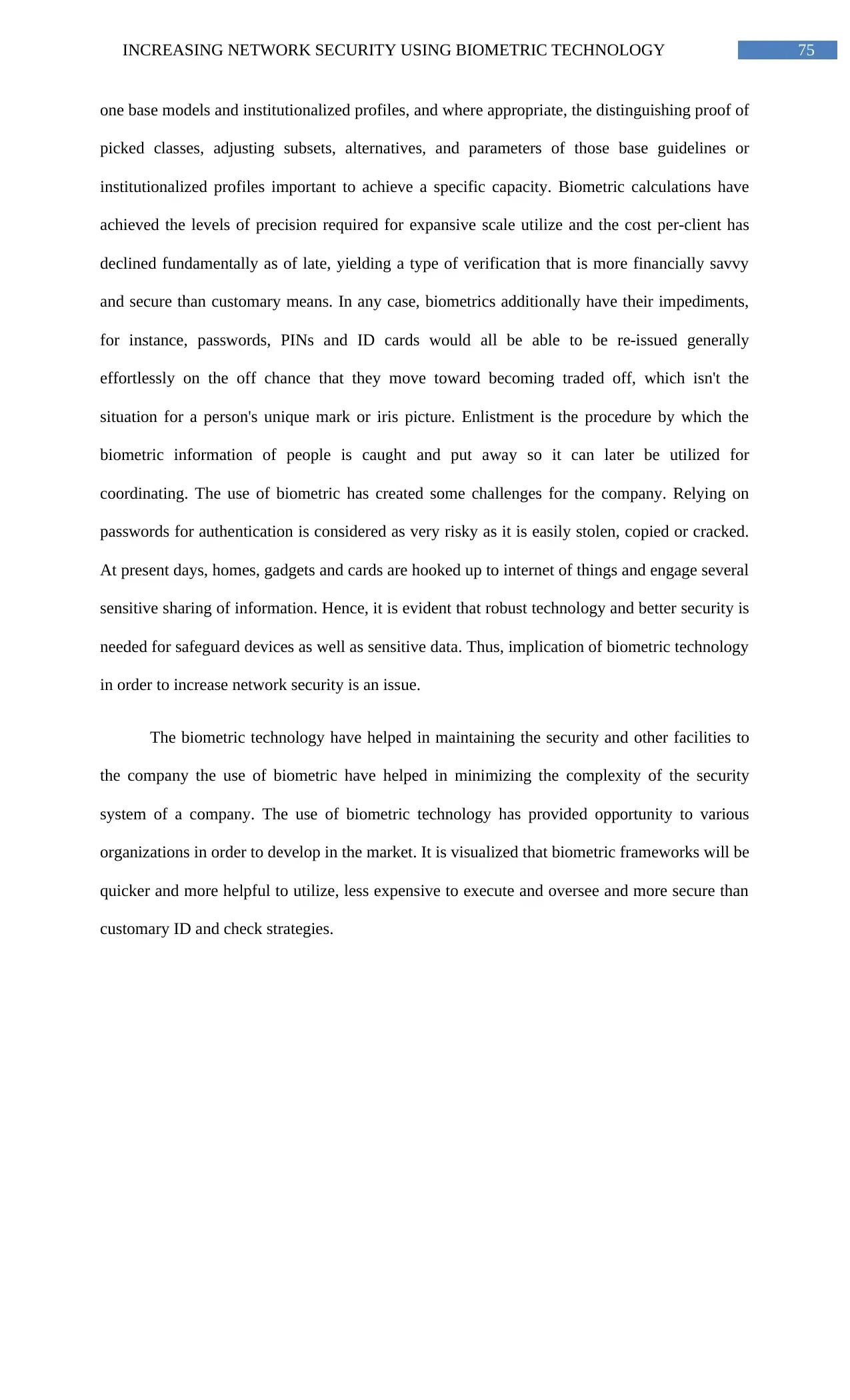
75INCREASING NETWORK SECURITY USING BIOMETRIC TECHNOLOGY
one base models and institutionalized profiles, and where appropriate, the distinguishing proof of
picked classes, adjusting subsets, alternatives, and parameters of those base guidelines or
institutionalized profiles important to achieve a specific capacity. Biometric calculations have
achieved the levels of precision required for expansive scale utilize and the cost per-client has
declined fundamentally as of late, yielding a type of verification that is more financially savvy
and secure than customary means. In any case, biometrics additionally have their impediments,
for instance, passwords, PINs and ID cards would all be able to be re-issued generally
effortlessly on the off chance that they move toward becoming traded off, which isn't the
situation for a person's unique mark or iris picture. Enlistment is the procedure by which the
biometric information of people is caught and put away so it can later be utilized for
coordinating. The use of biometric has created some challenges for the company. Relying on
passwords for authentication is considered as very risky as it is easily stolen, copied or cracked.
At present days, homes, gadgets and cards are hooked up to internet of things and engage several
sensitive sharing of information. Hence, it is evident that robust technology and better security is
needed for safeguard devices as well as sensitive data. Thus, implication of biometric technology
in order to increase network security is an issue.
The biometric technology have helped in maintaining the security and other facilities to
the company the use of biometric have helped in minimizing the complexity of the security
system of a company. The use of biometric technology has provided opportunity to various
organizations in order to develop in the market. It is visualized that biometric frameworks will be
quicker and more helpful to utilize, less expensive to execute and oversee and more secure than
customary ID and check strategies.
one base models and institutionalized profiles, and where appropriate, the distinguishing proof of
picked classes, adjusting subsets, alternatives, and parameters of those base guidelines or
institutionalized profiles important to achieve a specific capacity. Biometric calculations have
achieved the levels of precision required for expansive scale utilize and the cost per-client has
declined fundamentally as of late, yielding a type of verification that is more financially savvy
and secure than customary means. In any case, biometrics additionally have their impediments,
for instance, passwords, PINs and ID cards would all be able to be re-issued generally
effortlessly on the off chance that they move toward becoming traded off, which isn't the
situation for a person's unique mark or iris picture. Enlistment is the procedure by which the
biometric information of people is caught and put away so it can later be utilized for
coordinating. The use of biometric has created some challenges for the company. Relying on
passwords for authentication is considered as very risky as it is easily stolen, copied or cracked.
At present days, homes, gadgets and cards are hooked up to internet of things and engage several
sensitive sharing of information. Hence, it is evident that robust technology and better security is
needed for safeguard devices as well as sensitive data. Thus, implication of biometric technology
in order to increase network security is an issue.
The biometric technology have helped in maintaining the security and other facilities to
the company the use of biometric have helped in minimizing the complexity of the security
system of a company. The use of biometric technology has provided opportunity to various
organizations in order to develop in the market. It is visualized that biometric frameworks will be
quicker and more helpful to utilize, less expensive to execute and oversee and more secure than
customary ID and check strategies.
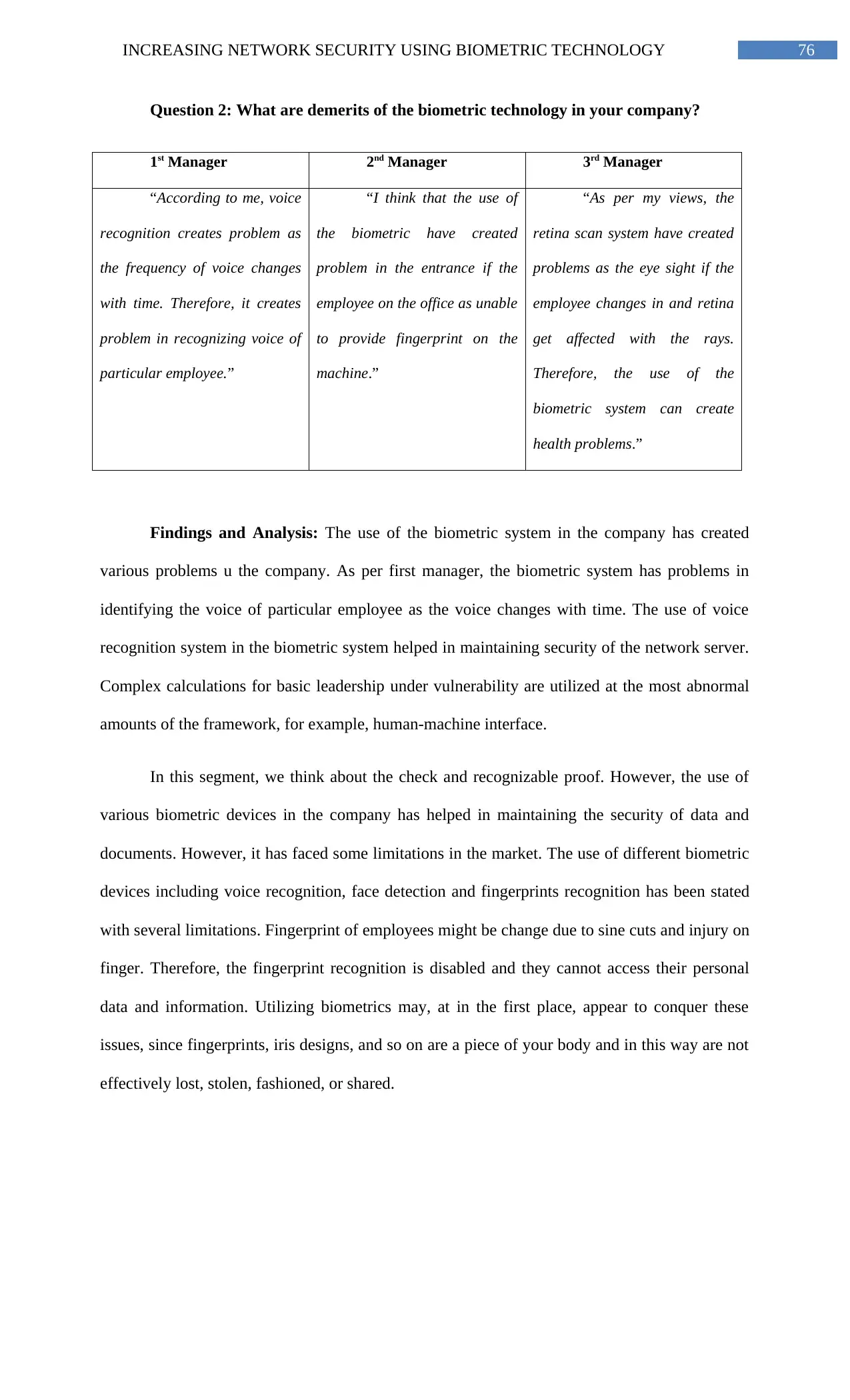
76INCREASING NETWORK SECURITY USING BIOMETRIC TECHNOLOGY
Question 2: What are demerits of the biometric technology in your company?
1st Manager 2nd Manager 3rd Manager
“According to me, voice
recognition creates problem as
the frequency of voice changes
with time. Therefore, it creates
problem in recognizing voice of
particular employee.”
“I think that the use of
the biometric have created
problem in the entrance if the
employee on the office as unable
to provide fingerprint on the
machine.”
“As per my views, the
retina scan system have created
problems as the eye sight if the
employee changes in and retina
get affected with the rays.
Therefore, the use of the
biometric system can create
health problems.”
Findings and Analysis: The use of the biometric system in the company has created
various problems u the company. As per first manager, the biometric system has problems in
identifying the voice of particular employee as the voice changes with time. The use of voice
recognition system in the biometric system helped in maintaining security of the network server.
Complex calculations for basic leadership under vulnerability are utilized at the most abnormal
amounts of the framework, for example, human-machine interface.
In this segment, we think about the check and recognizable proof. However, the use of
various biometric devices in the company has helped in maintaining the security of data and
documents. However, it has faced some limitations in the market. The use of different biometric
devices including voice recognition, face detection and fingerprints recognition has been stated
with several limitations. Fingerprint of employees might be change due to sine cuts and injury on
finger. Therefore, the fingerprint recognition is disabled and they cannot access their personal
data and information. Utilizing biometrics may, at in the first place, appear to conquer these
issues, since fingerprints, iris designs, and so on are a piece of your body and in this way are not
effectively lost, stolen, fashioned, or shared.
Question 2: What are demerits of the biometric technology in your company?
1st Manager 2nd Manager 3rd Manager
“According to me, voice
recognition creates problem as
the frequency of voice changes
with time. Therefore, it creates
problem in recognizing voice of
particular employee.”
“I think that the use of
the biometric have created
problem in the entrance if the
employee on the office as unable
to provide fingerprint on the
machine.”
“As per my views, the
retina scan system have created
problems as the eye sight if the
employee changes in and retina
get affected with the rays.
Therefore, the use of the
biometric system can create
health problems.”
Findings and Analysis: The use of the biometric system in the company has created
various problems u the company. As per first manager, the biometric system has problems in
identifying the voice of particular employee as the voice changes with time. The use of voice
recognition system in the biometric system helped in maintaining security of the network server.
Complex calculations for basic leadership under vulnerability are utilized at the most abnormal
amounts of the framework, for example, human-machine interface.
In this segment, we think about the check and recognizable proof. However, the use of
various biometric devices in the company has helped in maintaining the security of data and
documents. However, it has faced some limitations in the market. The use of different biometric
devices including voice recognition, face detection and fingerprints recognition has been stated
with several limitations. Fingerprint of employees might be change due to sine cuts and injury on
finger. Therefore, the fingerprint recognition is disabled and they cannot access their personal
data and information. Utilizing biometrics may, at in the first place, appear to conquer these
issues, since fingerprints, iris designs, and so on are a piece of your body and in this way are not
effectively lost, stolen, fashioned, or shared.
Secure Best Marks with AI Grader
Need help grading? Try our AI Grader for instant feedback on your assignments.
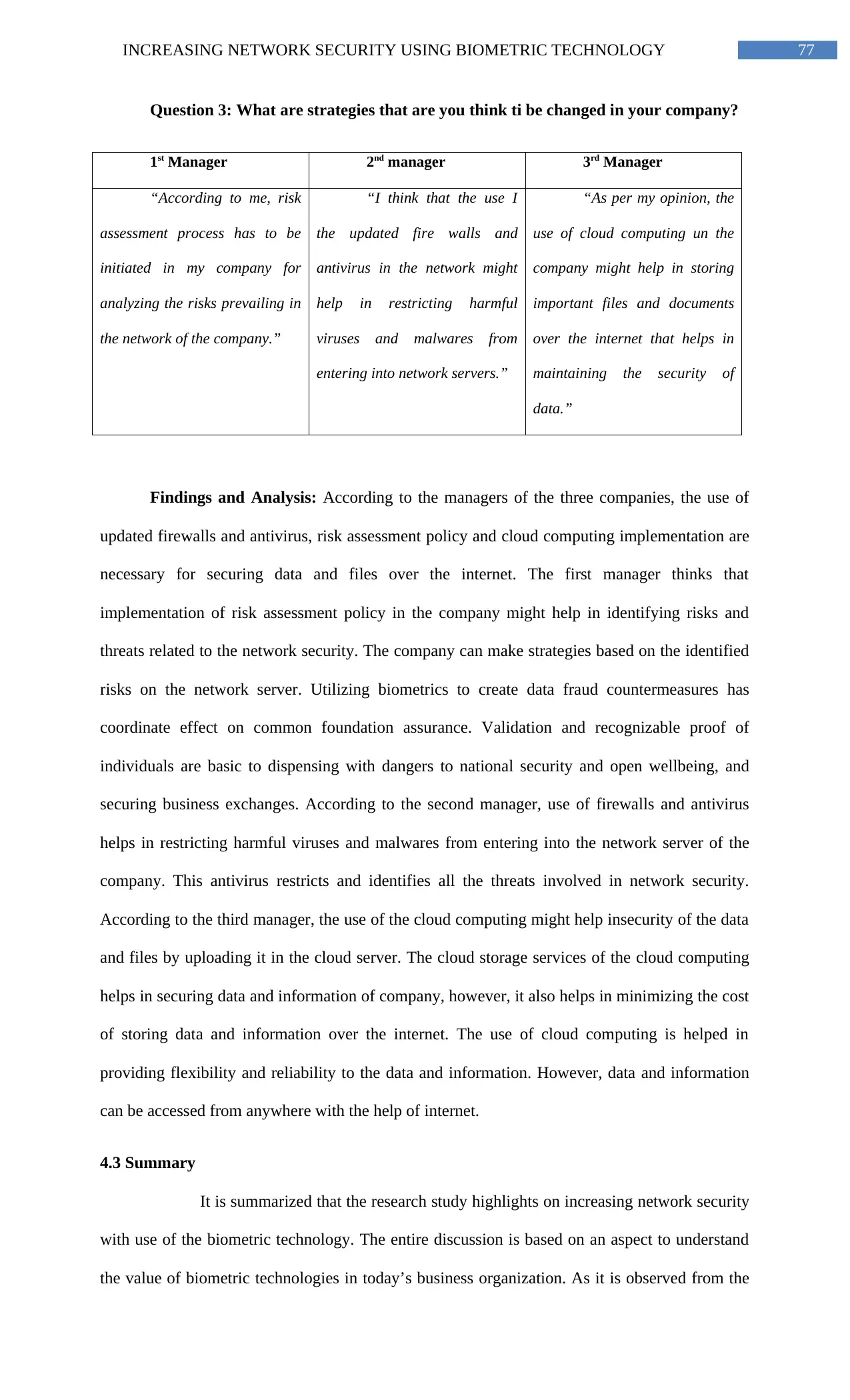
77INCREASING NETWORK SECURITY USING BIOMETRIC TECHNOLOGY
Question 3: What are strategies that are you think ti be changed in your company?
1st Manager 2nd manager 3rd Manager
“According to me, risk
assessment process has to be
initiated in my company for
analyzing the risks prevailing in
the network of the company.”
“I think that the use I
the updated fire walls and
antivirus in the network might
help in restricting harmful
viruses and malwares from
entering into network servers.”
“As per my opinion, the
use of cloud computing un the
company might help in storing
important files and documents
over the internet that helps in
maintaining the security of
data.”
Findings and Analysis: According to the managers of the three companies, the use of
updated firewalls and antivirus, risk assessment policy and cloud computing implementation are
necessary for securing data and files over the internet. The first manager thinks that
implementation of risk assessment policy in the company might help in identifying risks and
threats related to the network security. The company can make strategies based on the identified
risks on the network server. Utilizing biometrics to create data fraud countermeasures has
coordinate effect on common foundation assurance. Validation and recognizable proof of
individuals are basic to dispensing with dangers to national security and open wellbeing, and
securing business exchanges. According to the second manager, use of firewalls and antivirus
helps in restricting harmful viruses and malwares from entering into the network server of the
company. This antivirus restricts and identifies all the threats involved in network security.
According to the third manager, the use of the cloud computing might help insecurity of the data
and files by uploading it in the cloud server. The cloud storage services of the cloud computing
helps in securing data and information of company, however, it also helps in minimizing the cost
of storing data and information over the internet. The use of cloud computing is helped in
providing flexibility and reliability to the data and information. However, data and information
can be accessed from anywhere with the help of internet.
4.3 Summary
It is summarized that the research study highlights on increasing network security
with use of the biometric technology. The entire discussion is based on an aspect to understand
the value of biometric technologies in today’s business organization. As it is observed from the
Question 3: What are strategies that are you think ti be changed in your company?
1st Manager 2nd manager 3rd Manager
“According to me, risk
assessment process has to be
initiated in my company for
analyzing the risks prevailing in
the network of the company.”
“I think that the use I
the updated fire walls and
antivirus in the network might
help in restricting harmful
viruses and malwares from
entering into network servers.”
“As per my opinion, the
use of cloud computing un the
company might help in storing
important files and documents
over the internet that helps in
maintaining the security of
data.”
Findings and Analysis: According to the managers of the three companies, the use of
updated firewalls and antivirus, risk assessment policy and cloud computing implementation are
necessary for securing data and files over the internet. The first manager thinks that
implementation of risk assessment policy in the company might help in identifying risks and
threats related to the network security. The company can make strategies based on the identified
risks on the network server. Utilizing biometrics to create data fraud countermeasures has
coordinate effect on common foundation assurance. Validation and recognizable proof of
individuals are basic to dispensing with dangers to national security and open wellbeing, and
securing business exchanges. According to the second manager, use of firewalls and antivirus
helps in restricting harmful viruses and malwares from entering into the network server of the
company. This antivirus restricts and identifies all the threats involved in network security.
According to the third manager, the use of the cloud computing might help insecurity of the data
and files by uploading it in the cloud server. The cloud storage services of the cloud computing
helps in securing data and information of company, however, it also helps in minimizing the cost
of storing data and information over the internet. The use of cloud computing is helped in
providing flexibility and reliability to the data and information. However, data and information
can be accessed from anywhere with the help of internet.
4.3 Summary
It is summarized that the research study highlights on increasing network security
with use of the biometric technology. The entire discussion is based on an aspect to understand
the value of biometric technologies in today’s business organization. As it is observed from the
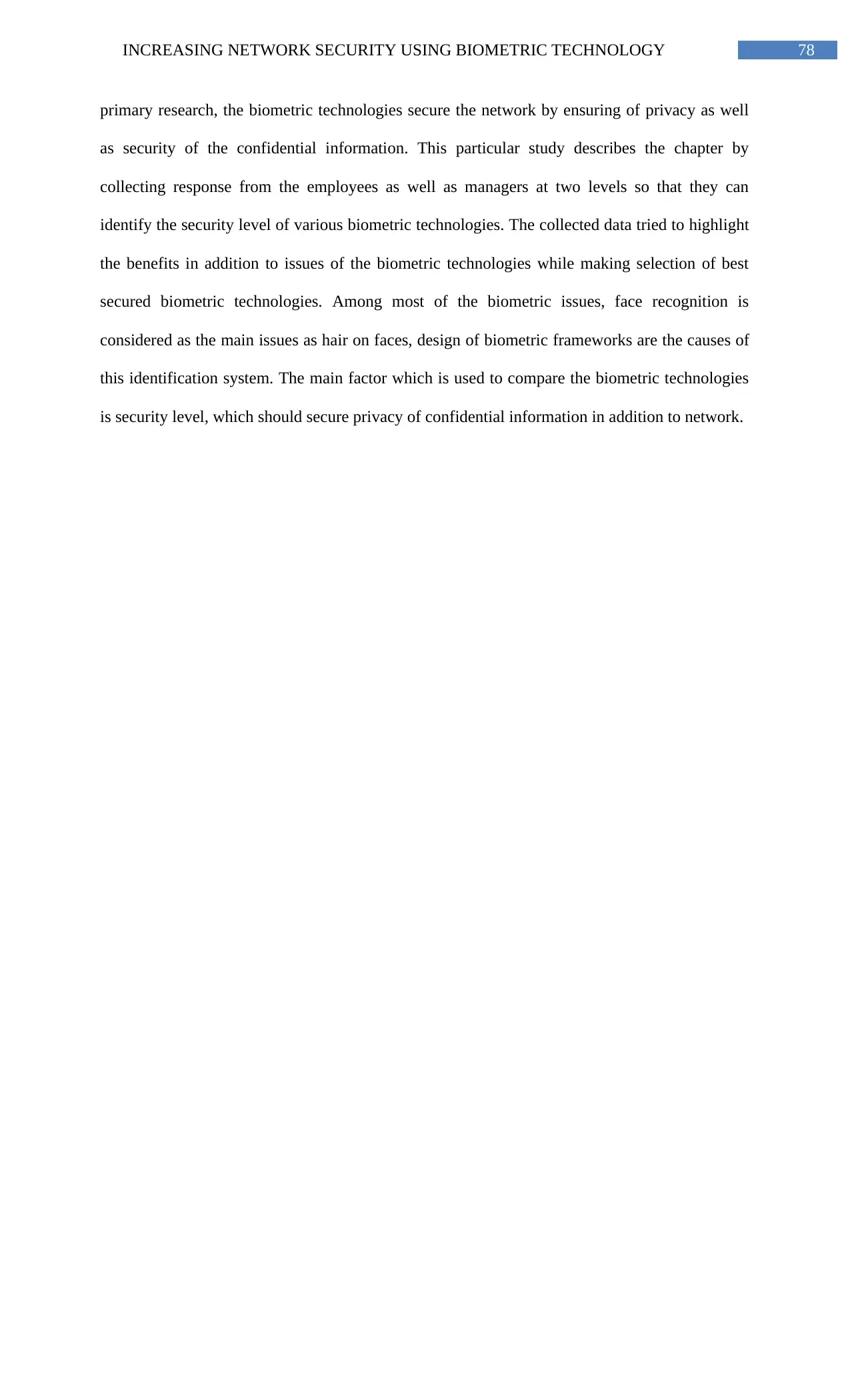
78INCREASING NETWORK SECURITY USING BIOMETRIC TECHNOLOGY
primary research, the biometric technologies secure the network by ensuring of privacy as well
as security of the confidential information. This particular study describes the chapter by
collecting response from the employees as well as managers at two levels so that they can
identify the security level of various biometric technologies. The collected data tried to highlight
the benefits in addition to issues of the biometric technologies while making selection of best
secured biometric technologies. Among most of the biometric issues, face recognition is
considered as the main issues as hair on faces, design of biometric frameworks are the causes of
this identification system. The main factor which is used to compare the biometric technologies
is security level, which should secure privacy of confidential information in addition to network.
primary research, the biometric technologies secure the network by ensuring of privacy as well
as security of the confidential information. This particular study describes the chapter by
collecting response from the employees as well as managers at two levels so that they can
identify the security level of various biometric technologies. The collected data tried to highlight
the benefits in addition to issues of the biometric technologies while making selection of best
secured biometric technologies. Among most of the biometric issues, face recognition is
considered as the main issues as hair on faces, design of biometric frameworks are the causes of
this identification system. The main factor which is used to compare the biometric technologies
is security level, which should secure privacy of confidential information in addition to network.
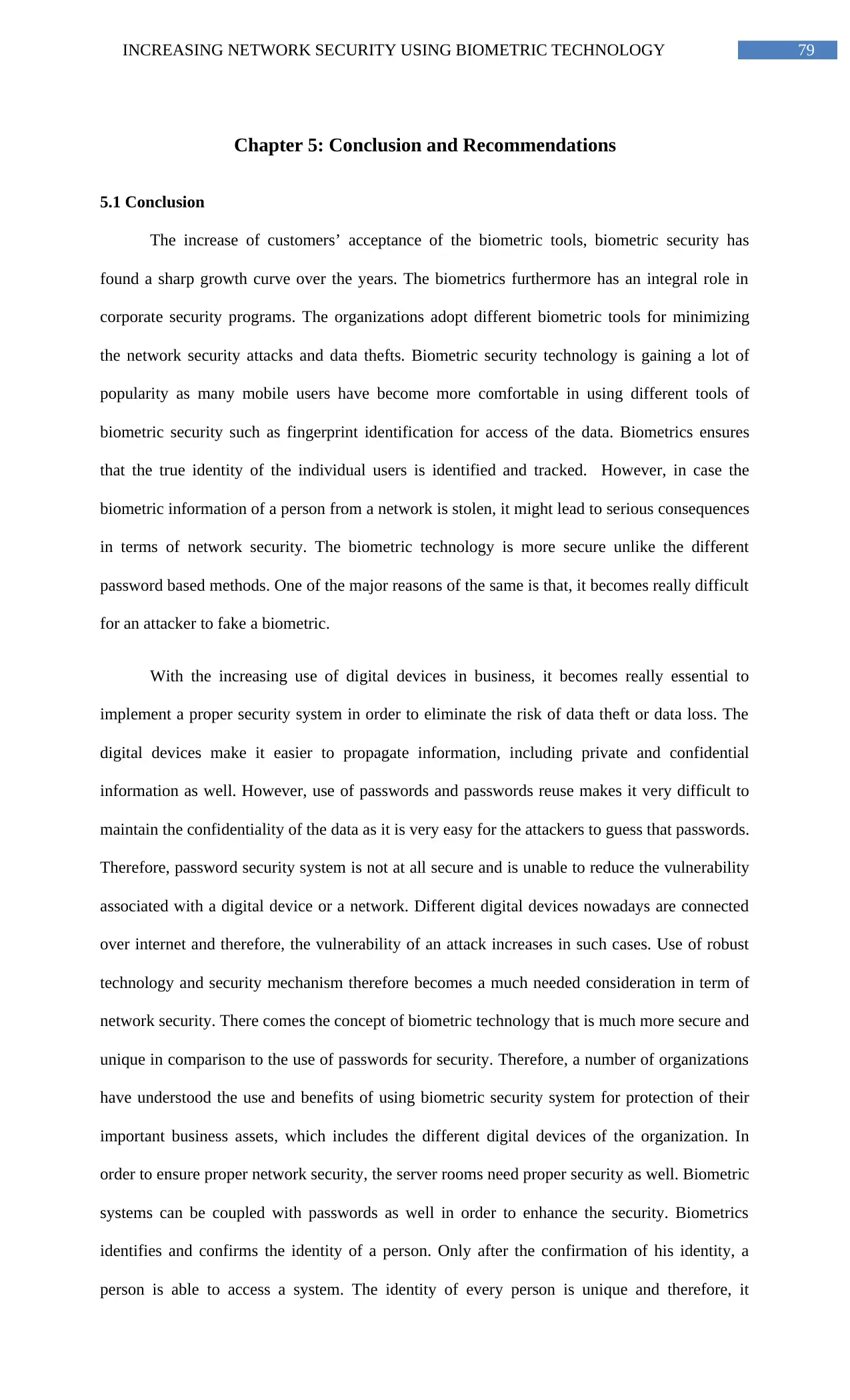
79INCREASING NETWORK SECURITY USING BIOMETRIC TECHNOLOGY
Chapter 5: Conclusion and Recommendations
5.1 Conclusion
The increase of customers’ acceptance of the biometric tools, biometric security has
found a sharp growth curve over the years. The biometrics furthermore has an integral role in
corporate security programs. The organizations adopt different biometric tools for minimizing
the network security attacks and data thefts. Biometric security technology is gaining a lot of
popularity as many mobile users have become more comfortable in using different tools of
biometric security such as fingerprint identification for access of the data. Biometrics ensures
that the true identity of the individual users is identified and tracked. However, in case the
biometric information of a person from a network is stolen, it might lead to serious consequences
in terms of network security. The biometric technology is more secure unlike the different
password based methods. One of the major reasons of the same is that, it becomes really difficult
for an attacker to fake a biometric.
With the increasing use of digital devices in business, it becomes really essential to
implement a proper security system in order to eliminate the risk of data theft or data loss. The
digital devices make it easier to propagate information, including private and confidential
information as well. However, use of passwords and passwords reuse makes it very difficult to
maintain the confidentiality of the data as it is very easy for the attackers to guess that passwords.
Therefore, password security system is not at all secure and is unable to reduce the vulnerability
associated with a digital device or a network. Different digital devices nowadays are connected
over internet and therefore, the vulnerability of an attack increases in such cases. Use of robust
technology and security mechanism therefore becomes a much needed consideration in term of
network security. There comes the concept of biometric technology that is much more secure and
unique in comparison to the use of passwords for security. Therefore, a number of organizations
have understood the use and benefits of using biometric security system for protection of their
important business assets, which includes the different digital devices of the organization. In
order to ensure proper network security, the server rooms need proper security as well. Biometric
systems can be coupled with passwords as well in order to enhance the security. Biometrics
identifies and confirms the identity of a person. Only after the confirmation of his identity, a
person is able to access a system. The identity of every person is unique and therefore, it
Chapter 5: Conclusion and Recommendations
5.1 Conclusion
The increase of customers’ acceptance of the biometric tools, biometric security has
found a sharp growth curve over the years. The biometrics furthermore has an integral role in
corporate security programs. The organizations adopt different biometric tools for minimizing
the network security attacks and data thefts. Biometric security technology is gaining a lot of
popularity as many mobile users have become more comfortable in using different tools of
biometric security such as fingerprint identification for access of the data. Biometrics ensures
that the true identity of the individual users is identified and tracked. However, in case the
biometric information of a person from a network is stolen, it might lead to serious consequences
in terms of network security. The biometric technology is more secure unlike the different
password based methods. One of the major reasons of the same is that, it becomes really difficult
for an attacker to fake a biometric.
With the increasing use of digital devices in business, it becomes really essential to
implement a proper security system in order to eliminate the risk of data theft or data loss. The
digital devices make it easier to propagate information, including private and confidential
information as well. However, use of passwords and passwords reuse makes it very difficult to
maintain the confidentiality of the data as it is very easy for the attackers to guess that passwords.
Therefore, password security system is not at all secure and is unable to reduce the vulnerability
associated with a digital device or a network. Different digital devices nowadays are connected
over internet and therefore, the vulnerability of an attack increases in such cases. Use of robust
technology and security mechanism therefore becomes a much needed consideration in term of
network security. There comes the concept of biometric technology that is much more secure and
unique in comparison to the use of passwords for security. Therefore, a number of organizations
have understood the use and benefits of using biometric security system for protection of their
important business assets, which includes the different digital devices of the organization. In
order to ensure proper network security, the server rooms need proper security as well. Biometric
systems can be coupled with passwords as well in order to enhance the security. Biometrics
identifies and confirms the identity of a person. Only after the confirmation of his identity, a
person is able to access a system. The identity of every person is unique and therefore, it
Paraphrase This Document
Need a fresh take? Get an instant paraphrase of this document with our AI Paraphraser
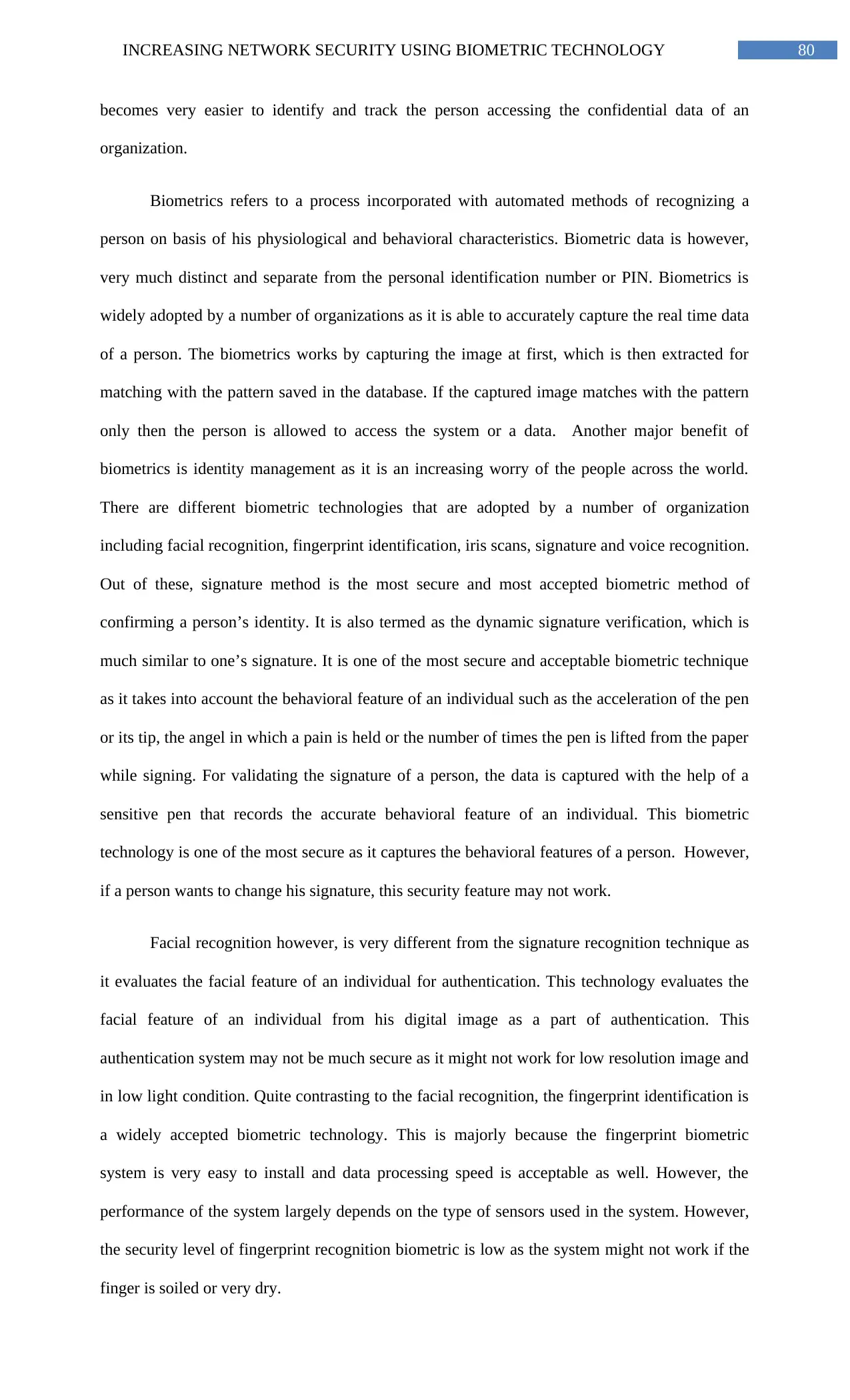
80INCREASING NETWORK SECURITY USING BIOMETRIC TECHNOLOGY
becomes very easier to identify and track the person accessing the confidential data of an
organization.
Biometrics refers to a process incorporated with automated methods of recognizing a
person on basis of his physiological and behavioral characteristics. Biometric data is however,
very much distinct and separate from the personal identification number or PIN. Biometrics is
widely adopted by a number of organizations as it is able to accurately capture the real time data
of a person. The biometrics works by capturing the image at first, which is then extracted for
matching with the pattern saved in the database. If the captured image matches with the pattern
only then the person is allowed to access the system or a data. Another major benefit of
biometrics is identity management as it is an increasing worry of the people across the world.
There are different biometric technologies that are adopted by a number of organization
including facial recognition, fingerprint identification, iris scans, signature and voice recognition.
Out of these, signature method is the most secure and most accepted biometric method of
confirming a person’s identity. It is also termed as the dynamic signature verification, which is
much similar to one’s signature. It is one of the most secure and acceptable biometric technique
as it takes into account the behavioral feature of an individual such as the acceleration of the pen
or its tip, the angel in which a pain is held or the number of times the pen is lifted from the paper
while signing. For validating the signature of a person, the data is captured with the help of a
sensitive pen that records the accurate behavioral feature of an individual. This biometric
technology is one of the most secure as it captures the behavioral features of a person. However,
if a person wants to change his signature, this security feature may not work.
Facial recognition however, is very different from the signature recognition technique as
it evaluates the facial feature of an individual for authentication. This technology evaluates the
facial feature of an individual from his digital image as a part of authentication. This
authentication system may not be much secure as it might not work for low resolution image and
in low light condition. Quite contrasting to the facial recognition, the fingerprint identification is
a widely accepted biometric technology. This is majorly because the fingerprint biometric
system is very easy to install and data processing speed is acceptable as well. However, the
performance of the system largely depends on the type of sensors used in the system. However,
the security level of fingerprint recognition biometric is low as the system might not work if the
finger is soiled or very dry.
becomes very easier to identify and track the person accessing the confidential data of an
organization.
Biometrics refers to a process incorporated with automated methods of recognizing a
person on basis of his physiological and behavioral characteristics. Biometric data is however,
very much distinct and separate from the personal identification number or PIN. Biometrics is
widely adopted by a number of organizations as it is able to accurately capture the real time data
of a person. The biometrics works by capturing the image at first, which is then extracted for
matching with the pattern saved in the database. If the captured image matches with the pattern
only then the person is allowed to access the system or a data. Another major benefit of
biometrics is identity management as it is an increasing worry of the people across the world.
There are different biometric technologies that are adopted by a number of organization
including facial recognition, fingerprint identification, iris scans, signature and voice recognition.
Out of these, signature method is the most secure and most accepted biometric method of
confirming a person’s identity. It is also termed as the dynamic signature verification, which is
much similar to one’s signature. It is one of the most secure and acceptable biometric technique
as it takes into account the behavioral feature of an individual such as the acceleration of the pen
or its tip, the angel in which a pain is held or the number of times the pen is lifted from the paper
while signing. For validating the signature of a person, the data is captured with the help of a
sensitive pen that records the accurate behavioral feature of an individual. This biometric
technology is one of the most secure as it captures the behavioral features of a person. However,
if a person wants to change his signature, this security feature may not work.
Facial recognition however, is very different from the signature recognition technique as
it evaluates the facial feature of an individual for authentication. This technology evaluates the
facial feature of an individual from his digital image as a part of authentication. This
authentication system may not be much secure as it might not work for low resolution image and
in low light condition. Quite contrasting to the facial recognition, the fingerprint identification is
a widely accepted biometric technology. This is majorly because the fingerprint biometric
system is very easy to install and data processing speed is acceptable as well. However, the
performance of the system largely depends on the type of sensors used in the system. However,
the security level of fingerprint recognition biometric is low as the system might not work if the
finger is soiled or very dry.
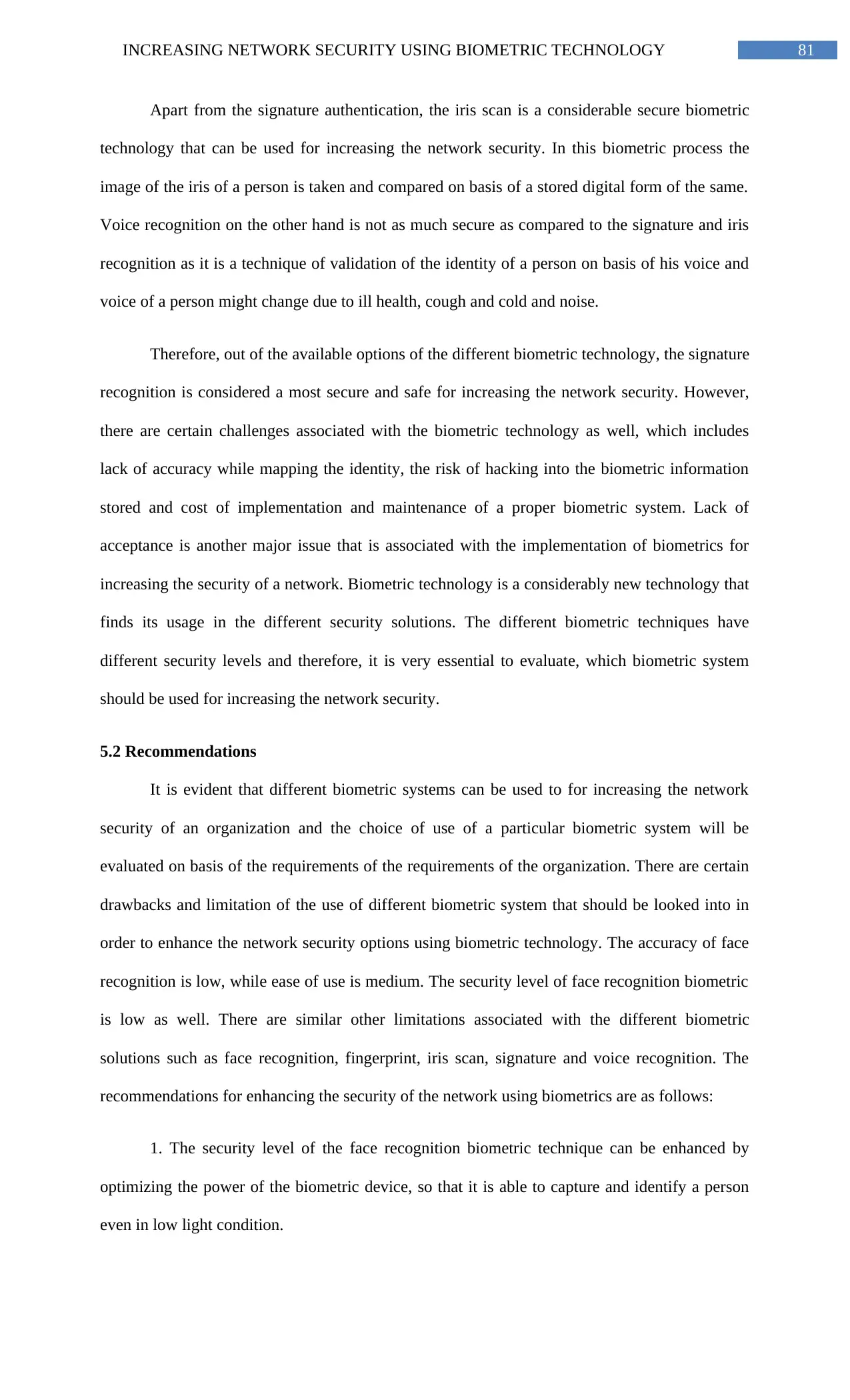
81INCREASING NETWORK SECURITY USING BIOMETRIC TECHNOLOGY
Apart from the signature authentication, the iris scan is a considerable secure biometric
technology that can be used for increasing the network security. In this biometric process the
image of the iris of a person is taken and compared on basis of a stored digital form of the same.
Voice recognition on the other hand is not as much secure as compared to the signature and iris
recognition as it is a technique of validation of the identity of a person on basis of his voice and
voice of a person might change due to ill health, cough and cold and noise.
Therefore, out of the available options of the different biometric technology, the signature
recognition is considered a most secure and safe for increasing the network security. However,
there are certain challenges associated with the biometric technology as well, which includes
lack of accuracy while mapping the identity, the risk of hacking into the biometric information
stored and cost of implementation and maintenance of a proper biometric system. Lack of
acceptance is another major issue that is associated with the implementation of biometrics for
increasing the security of a network. Biometric technology is a considerably new technology that
finds its usage in the different security solutions. The different biometric techniques have
different security levels and therefore, it is very essential to evaluate, which biometric system
should be used for increasing the network security.
5.2 Recommendations
It is evident that different biometric systems can be used to for increasing the network
security of an organization and the choice of use of a particular biometric system will be
evaluated on basis of the requirements of the requirements of the organization. There are certain
drawbacks and limitation of the use of different biometric system that should be looked into in
order to enhance the network security options using biometric technology. The accuracy of face
recognition is low, while ease of use is medium. The security level of face recognition biometric
is low as well. There are similar other limitations associated with the different biometric
solutions such as face recognition, fingerprint, iris scan, signature and voice recognition. The
recommendations for enhancing the security of the network using biometrics are as follows:
1. The security level of the face recognition biometric technique can be enhanced by
optimizing the power of the biometric device, so that it is able to capture and identify a person
even in low light condition.
Apart from the signature authentication, the iris scan is a considerable secure biometric
technology that can be used for increasing the network security. In this biometric process the
image of the iris of a person is taken and compared on basis of a stored digital form of the same.
Voice recognition on the other hand is not as much secure as compared to the signature and iris
recognition as it is a technique of validation of the identity of a person on basis of his voice and
voice of a person might change due to ill health, cough and cold and noise.
Therefore, out of the available options of the different biometric technology, the signature
recognition is considered a most secure and safe for increasing the network security. However,
there are certain challenges associated with the biometric technology as well, which includes
lack of accuracy while mapping the identity, the risk of hacking into the biometric information
stored and cost of implementation and maintenance of a proper biometric system. Lack of
acceptance is another major issue that is associated with the implementation of biometrics for
increasing the security of a network. Biometric technology is a considerably new technology that
finds its usage in the different security solutions. The different biometric techniques have
different security levels and therefore, it is very essential to evaluate, which biometric system
should be used for increasing the network security.
5.2 Recommendations
It is evident that different biometric systems can be used to for increasing the network
security of an organization and the choice of use of a particular biometric system will be
evaluated on basis of the requirements of the requirements of the organization. There are certain
drawbacks and limitation of the use of different biometric system that should be looked into in
order to enhance the network security options using biometric technology. The accuracy of face
recognition is low, while ease of use is medium. The security level of face recognition biometric
is low as well. There are similar other limitations associated with the different biometric
solutions such as face recognition, fingerprint, iris scan, signature and voice recognition. The
recommendations for enhancing the security of the network using biometrics are as follows:
1. The security level of the face recognition biometric technique can be enhanced by
optimizing the power of the biometric device, so that it is able to capture and identify a person
even in low light condition.
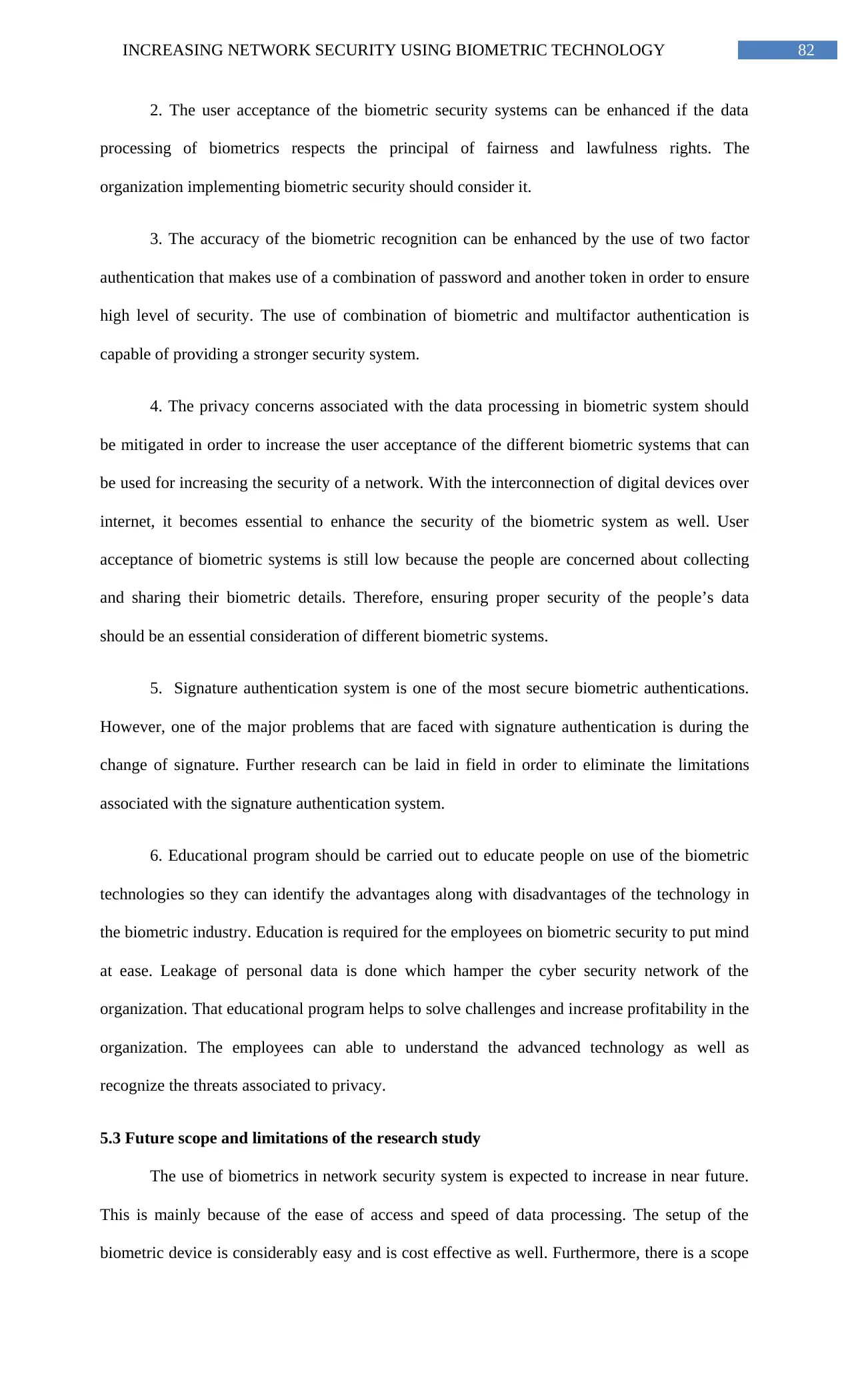
82INCREASING NETWORK SECURITY USING BIOMETRIC TECHNOLOGY
2. The user acceptance of the biometric security systems can be enhanced if the data
processing of biometrics respects the principal of fairness and lawfulness rights. The
organization implementing biometric security should consider it.
3. The accuracy of the biometric recognition can be enhanced by the use of two factor
authentication that makes use of a combination of password and another token in order to ensure
high level of security. The use of combination of biometric and multifactor authentication is
capable of providing a stronger security system.
4. The privacy concerns associated with the data processing in biometric system should
be mitigated in order to increase the user acceptance of the different biometric systems that can
be used for increasing the security of a network. With the interconnection of digital devices over
internet, it becomes essential to enhance the security of the biometric system as well. User
acceptance of biometric systems is still low because the people are concerned about collecting
and sharing their biometric details. Therefore, ensuring proper security of the people’s data
should be an essential consideration of different biometric systems.
5. Signature authentication system is one of the most secure biometric authentications.
However, one of the major problems that are faced with signature authentication is during the
change of signature. Further research can be laid in field in order to eliminate the limitations
associated with the signature authentication system.
6. Educational program should be carried out to educate people on use of the biometric
technologies so they can identify the advantages along with disadvantages of the technology in
the biometric industry. Education is required for the employees on biometric security to put mind
at ease. Leakage of personal data is done which hamper the cyber security network of the
organization. That educational program helps to solve challenges and increase profitability in the
organization. The employees can able to understand the advanced technology as well as
recognize the threats associated to privacy.
5.3 Future scope and limitations of the research study
The use of biometrics in network security system is expected to increase in near future.
This is mainly because of the ease of access and speed of data processing. The setup of the
biometric device is considerably easy and is cost effective as well. Furthermore, there is a scope
2. The user acceptance of the biometric security systems can be enhanced if the data
processing of biometrics respects the principal of fairness and lawfulness rights. The
organization implementing biometric security should consider it.
3. The accuracy of the biometric recognition can be enhanced by the use of two factor
authentication that makes use of a combination of password and another token in order to ensure
high level of security. The use of combination of biometric and multifactor authentication is
capable of providing a stronger security system.
4. The privacy concerns associated with the data processing in biometric system should
be mitigated in order to increase the user acceptance of the different biometric systems that can
be used for increasing the security of a network. With the interconnection of digital devices over
internet, it becomes essential to enhance the security of the biometric system as well. User
acceptance of biometric systems is still low because the people are concerned about collecting
and sharing their biometric details. Therefore, ensuring proper security of the people’s data
should be an essential consideration of different biometric systems.
5. Signature authentication system is one of the most secure biometric authentications.
However, one of the major problems that are faced with signature authentication is during the
change of signature. Further research can be laid in field in order to eliminate the limitations
associated with the signature authentication system.
6. Educational program should be carried out to educate people on use of the biometric
technologies so they can identify the advantages along with disadvantages of the technology in
the biometric industry. Education is required for the employees on biometric security to put mind
at ease. Leakage of personal data is done which hamper the cyber security network of the
organization. That educational program helps to solve challenges and increase profitability in the
organization. The employees can able to understand the advanced technology as well as
recognize the threats associated to privacy.
5.3 Future scope and limitations of the research study
The use of biometrics in network security system is expected to increase in near future.
This is mainly because of the ease of access and speed of data processing. The setup of the
biometric device is considerably easy and is cost effective as well. Furthermore, there is a scope
Secure Best Marks with AI Grader
Need help grading? Try our AI Grader for instant feedback on your assignments.
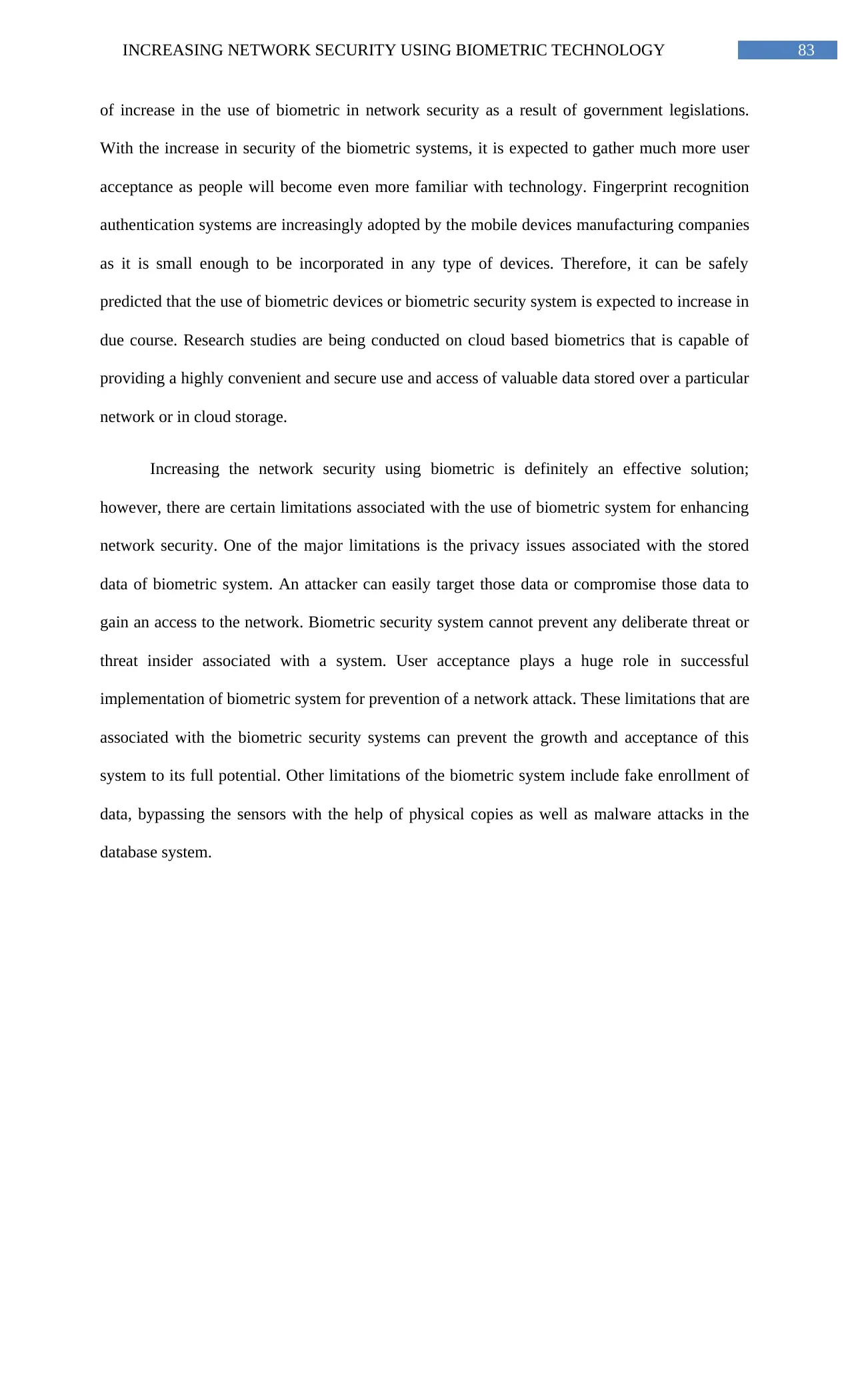
83INCREASING NETWORK SECURITY USING BIOMETRIC TECHNOLOGY
of increase in the use of biometric in network security as a result of government legislations.
With the increase in security of the biometric systems, it is expected to gather much more user
acceptance as people will become even more familiar with technology. Fingerprint recognition
authentication systems are increasingly adopted by the mobile devices manufacturing companies
as it is small enough to be incorporated in any type of devices. Therefore, it can be safely
predicted that the use of biometric devices or biometric security system is expected to increase in
due course. Research studies are being conducted on cloud based biometrics that is capable of
providing a highly convenient and secure use and access of valuable data stored over a particular
network or in cloud storage.
Increasing the network security using biometric is definitely an effective solution;
however, there are certain limitations associated with the use of biometric system for enhancing
network security. One of the major limitations is the privacy issues associated with the stored
data of biometric system. An attacker can easily target those data or compromise those data to
gain an access to the network. Biometric security system cannot prevent any deliberate threat or
threat insider associated with a system. User acceptance plays a huge role in successful
implementation of biometric system for prevention of a network attack. These limitations that are
associated with the biometric security systems can prevent the growth and acceptance of this
system to its full potential. Other limitations of the biometric system include fake enrollment of
data, bypassing the sensors with the help of physical copies as well as malware attacks in the
database system.
of increase in the use of biometric in network security as a result of government legislations.
With the increase in security of the biometric systems, it is expected to gather much more user
acceptance as people will become even more familiar with technology. Fingerprint recognition
authentication systems are increasingly adopted by the mobile devices manufacturing companies
as it is small enough to be incorporated in any type of devices. Therefore, it can be safely
predicted that the use of biometric devices or biometric security system is expected to increase in
due course. Research studies are being conducted on cloud based biometrics that is capable of
providing a highly convenient and secure use and access of valuable data stored over a particular
network or in cloud storage.
Increasing the network security using biometric is definitely an effective solution;
however, there are certain limitations associated with the use of biometric system for enhancing
network security. One of the major limitations is the privacy issues associated with the stored
data of biometric system. An attacker can easily target those data or compromise those data to
gain an access to the network. Biometric security system cannot prevent any deliberate threat or
threat insider associated with a system. User acceptance plays a huge role in successful
implementation of biometric system for prevention of a network attack. These limitations that are
associated with the biometric security systems can prevent the growth and acceptance of this
system to its full potential. Other limitations of the biometric system include fake enrollment of
data, bypassing the sensors with the help of physical copies as well as malware attacks in the
database system.
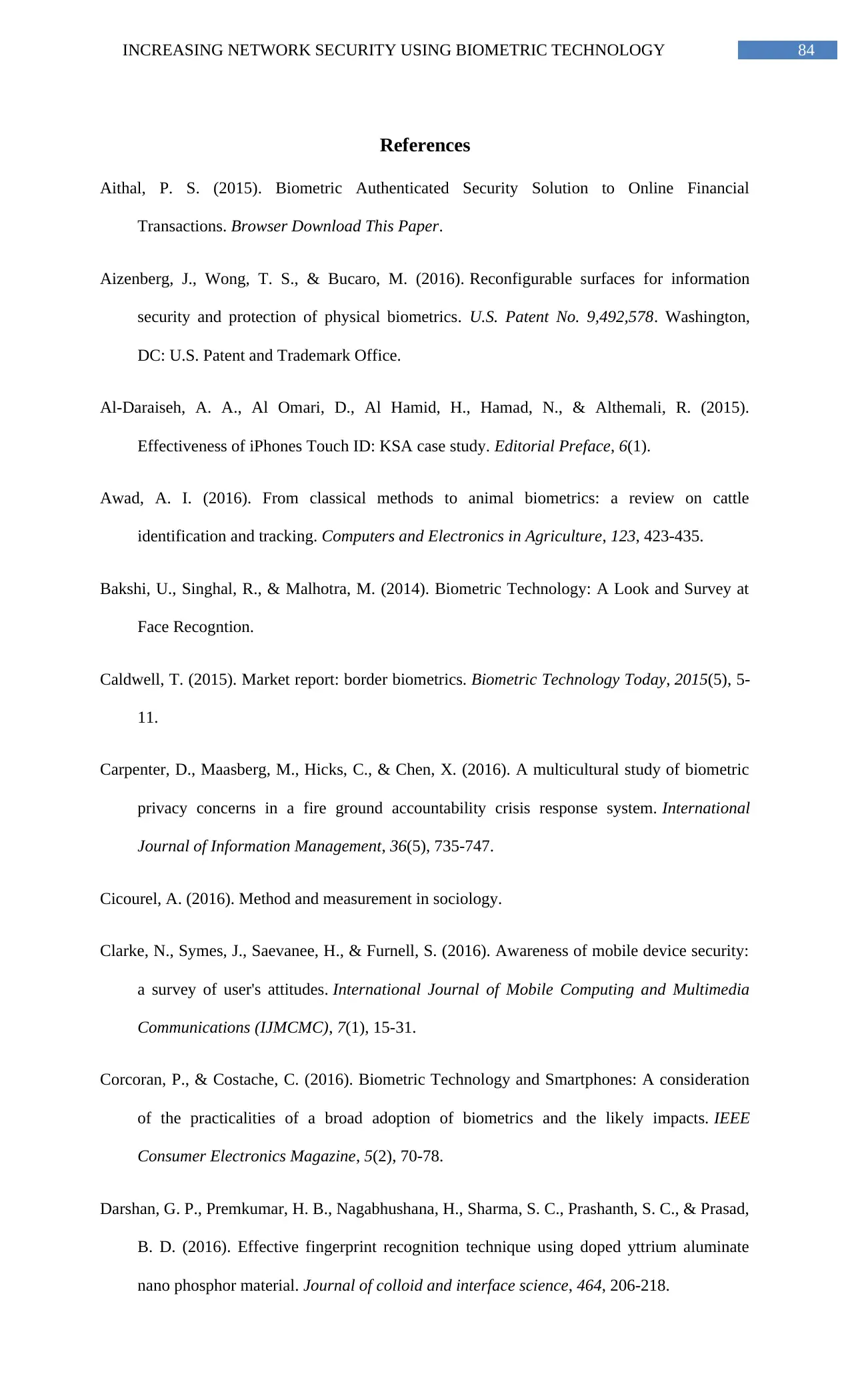
84INCREASING NETWORK SECURITY USING BIOMETRIC TECHNOLOGY
References
Aithal, P. S. (2015). Biometric Authenticated Security Solution to Online Financial
Transactions. Browser Download This Paper.
Aizenberg, J., Wong, T. S., & Bucaro, M. (2016). Reconfigurable surfaces for information
security and protection of physical biometrics. U.S. Patent No. 9,492,578. Washington,
DC: U.S. Patent and Trademark Office.
Al-Daraiseh, A. A., Al Omari, D., Al Hamid, H., Hamad, N., & Althemali, R. (2015).
Effectiveness of iPhones Touch ID: KSA case study. Editorial Preface, 6(1).
Awad, A. I. (2016). From classical methods to animal biometrics: a review on cattle
identification and tracking. Computers and Electronics in Agriculture, 123, 423-435.
Bakshi, U., Singhal, R., & Malhotra, M. (2014). Biometric Technology: A Look and Survey at
Face Recogntion.
Caldwell, T. (2015). Market report: border biometrics. Biometric Technology Today, 2015(5), 5-
11.
Carpenter, D., Maasberg, M., Hicks, C., & Chen, X. (2016). A multicultural study of biometric
privacy concerns in a fire ground accountability crisis response system. International
Journal of Information Management, 36(5), 735-747.
Cicourel, A. (2016). Method and measurement in sociology.
Clarke, N., Symes, J., Saevanee, H., & Furnell, S. (2016). Awareness of mobile device security:
a survey of user's attitudes. International Journal of Mobile Computing and Multimedia
Communications (IJMCMC), 7(1), 15-31.
Corcoran, P., & Costache, C. (2016). Biometric Technology and Smartphones: A consideration
of the practicalities of a broad adoption of biometrics and the likely impacts. IEEE
Consumer Electronics Magazine, 5(2), 70-78.
Darshan, G. P., Premkumar, H. B., Nagabhushana, H., Sharma, S. C., Prashanth, S. C., & Prasad,
B. D. (2016). Effective fingerprint recognition technique using doped yttrium aluminate
nano phosphor material. Journal of colloid and interface science, 464, 206-218.
References
Aithal, P. S. (2015). Biometric Authenticated Security Solution to Online Financial
Transactions. Browser Download This Paper.
Aizenberg, J., Wong, T. S., & Bucaro, M. (2016). Reconfigurable surfaces for information
security and protection of physical biometrics. U.S. Patent No. 9,492,578. Washington,
DC: U.S. Patent and Trademark Office.
Al-Daraiseh, A. A., Al Omari, D., Al Hamid, H., Hamad, N., & Althemali, R. (2015).
Effectiveness of iPhones Touch ID: KSA case study. Editorial Preface, 6(1).
Awad, A. I. (2016). From classical methods to animal biometrics: a review on cattle
identification and tracking. Computers and Electronics in Agriculture, 123, 423-435.
Bakshi, U., Singhal, R., & Malhotra, M. (2014). Biometric Technology: A Look and Survey at
Face Recogntion.
Caldwell, T. (2015). Market report: border biometrics. Biometric Technology Today, 2015(5), 5-
11.
Carpenter, D., Maasberg, M., Hicks, C., & Chen, X. (2016). A multicultural study of biometric
privacy concerns in a fire ground accountability crisis response system. International
Journal of Information Management, 36(5), 735-747.
Cicourel, A. (2016). Method and measurement in sociology.
Clarke, N., Symes, J., Saevanee, H., & Furnell, S. (2016). Awareness of mobile device security:
a survey of user's attitudes. International Journal of Mobile Computing and Multimedia
Communications (IJMCMC), 7(1), 15-31.
Corcoran, P., & Costache, C. (2016). Biometric Technology and Smartphones: A consideration
of the practicalities of a broad adoption of biometrics and the likely impacts. IEEE
Consumer Electronics Magazine, 5(2), 70-78.
Darshan, G. P., Premkumar, H. B., Nagabhushana, H., Sharma, S. C., Prashanth, S. C., & Prasad,
B. D. (2016). Effective fingerprint recognition technique using doped yttrium aluminate
nano phosphor material. Journal of colloid and interface science, 464, 206-218.
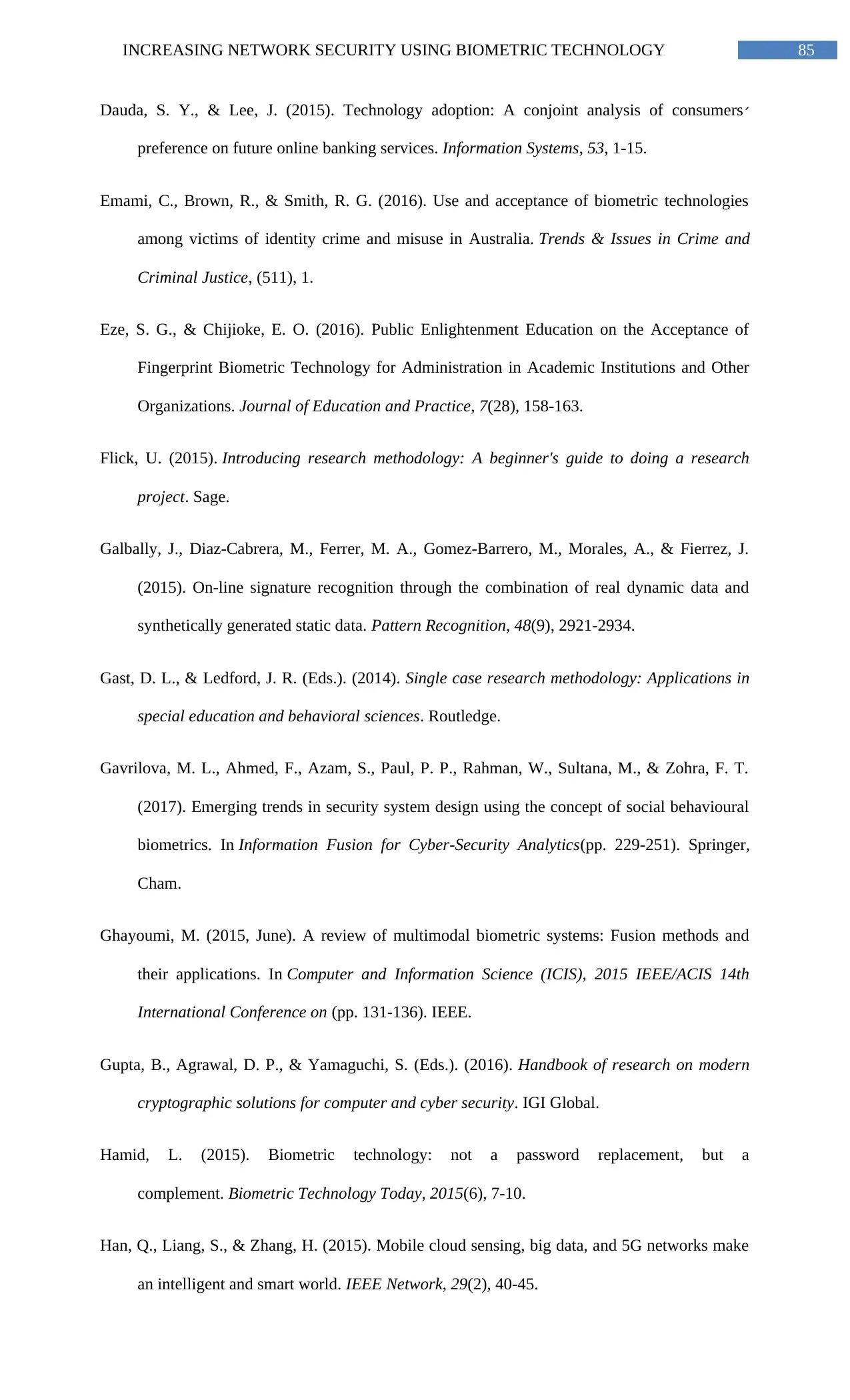
85INCREASING NETWORK SECURITY USING BIOMETRIC TECHNOLOGY
Dauda, S. Y., & Lee, J. (2015). Technology adoption: A conjoint analysis of consumers׳
preference on future online banking services. Information Systems, 53, 1-15.
Emami, C., Brown, R., & Smith, R. G. (2016). Use and acceptance of biometric technologies
among victims of identity crime and misuse in Australia. Trends & Issues in Crime and
Criminal Justice, (511), 1.
Eze, S. G., & Chijioke, E. O. (2016). Public Enlightenment Education on the Acceptance of
Fingerprint Biometric Technology for Administration in Academic Institutions and Other
Organizations. Journal of Education and Practice, 7(28), 158-163.
Flick, U. (2015). Introducing research methodology: A beginner's guide to doing a research
project. Sage.
Galbally, J., Diaz-Cabrera, M., Ferrer, M. A., Gomez-Barrero, M., Morales, A., & Fierrez, J.
(2015). On-line signature recognition through the combination of real dynamic data and
synthetically generated static data. Pattern Recognition, 48(9), 2921-2934.
Gast, D. L., & Ledford, J. R. (Eds.). (2014). Single case research methodology: Applications in
special education and behavioral sciences. Routledge.
Gavrilova, M. L., Ahmed, F., Azam, S., Paul, P. P., Rahman, W., Sultana, M., & Zohra, F. T.
(2017). Emerging trends in security system design using the concept of social behavioural
biometrics. In Information Fusion for Cyber-Security Analytics(pp. 229-251). Springer,
Cham.
Ghayoumi, M. (2015, June). A review of multimodal biometric systems: Fusion methods and
their applications. In Computer and Information Science (ICIS), 2015 IEEE/ACIS 14th
International Conference on (pp. 131-136). IEEE.
Gupta, B., Agrawal, D. P., & Yamaguchi, S. (Eds.). (2016). Handbook of research on modern
cryptographic solutions for computer and cyber security. IGI Global.
Hamid, L. (2015). Biometric technology: not a password replacement, but a
complement. Biometric Technology Today, 2015(6), 7-10.
Han, Q., Liang, S., & Zhang, H. (2015). Mobile cloud sensing, big data, and 5G networks make
an intelligent and smart world. IEEE Network, 29(2), 40-45.
Dauda, S. Y., & Lee, J. (2015). Technology adoption: A conjoint analysis of consumers׳
preference on future online banking services. Information Systems, 53, 1-15.
Emami, C., Brown, R., & Smith, R. G. (2016). Use and acceptance of biometric technologies
among victims of identity crime and misuse in Australia. Trends & Issues in Crime and
Criminal Justice, (511), 1.
Eze, S. G., & Chijioke, E. O. (2016). Public Enlightenment Education on the Acceptance of
Fingerprint Biometric Technology for Administration in Academic Institutions and Other
Organizations. Journal of Education and Practice, 7(28), 158-163.
Flick, U. (2015). Introducing research methodology: A beginner's guide to doing a research
project. Sage.
Galbally, J., Diaz-Cabrera, M., Ferrer, M. A., Gomez-Barrero, M., Morales, A., & Fierrez, J.
(2015). On-line signature recognition through the combination of real dynamic data and
synthetically generated static data. Pattern Recognition, 48(9), 2921-2934.
Gast, D. L., & Ledford, J. R. (Eds.). (2014). Single case research methodology: Applications in
special education and behavioral sciences. Routledge.
Gavrilova, M. L., Ahmed, F., Azam, S., Paul, P. P., Rahman, W., Sultana, M., & Zohra, F. T.
(2017). Emerging trends in security system design using the concept of social behavioural
biometrics. In Information Fusion for Cyber-Security Analytics(pp. 229-251). Springer,
Cham.
Ghayoumi, M. (2015, June). A review of multimodal biometric systems: Fusion methods and
their applications. In Computer and Information Science (ICIS), 2015 IEEE/ACIS 14th
International Conference on (pp. 131-136). IEEE.
Gupta, B., Agrawal, D. P., & Yamaguchi, S. (Eds.). (2016). Handbook of research on modern
cryptographic solutions for computer and cyber security. IGI Global.
Hamid, L. (2015). Biometric technology: not a password replacement, but a
complement. Biometric Technology Today, 2015(6), 7-10.
Han, Q., Liang, S., & Zhang, H. (2015). Mobile cloud sensing, big data, and 5G networks make
an intelligent and smart world. IEEE Network, 29(2), 40-45.
Paraphrase This Document
Need a fresh take? Get an instant paraphrase of this document with our AI Paraphraser
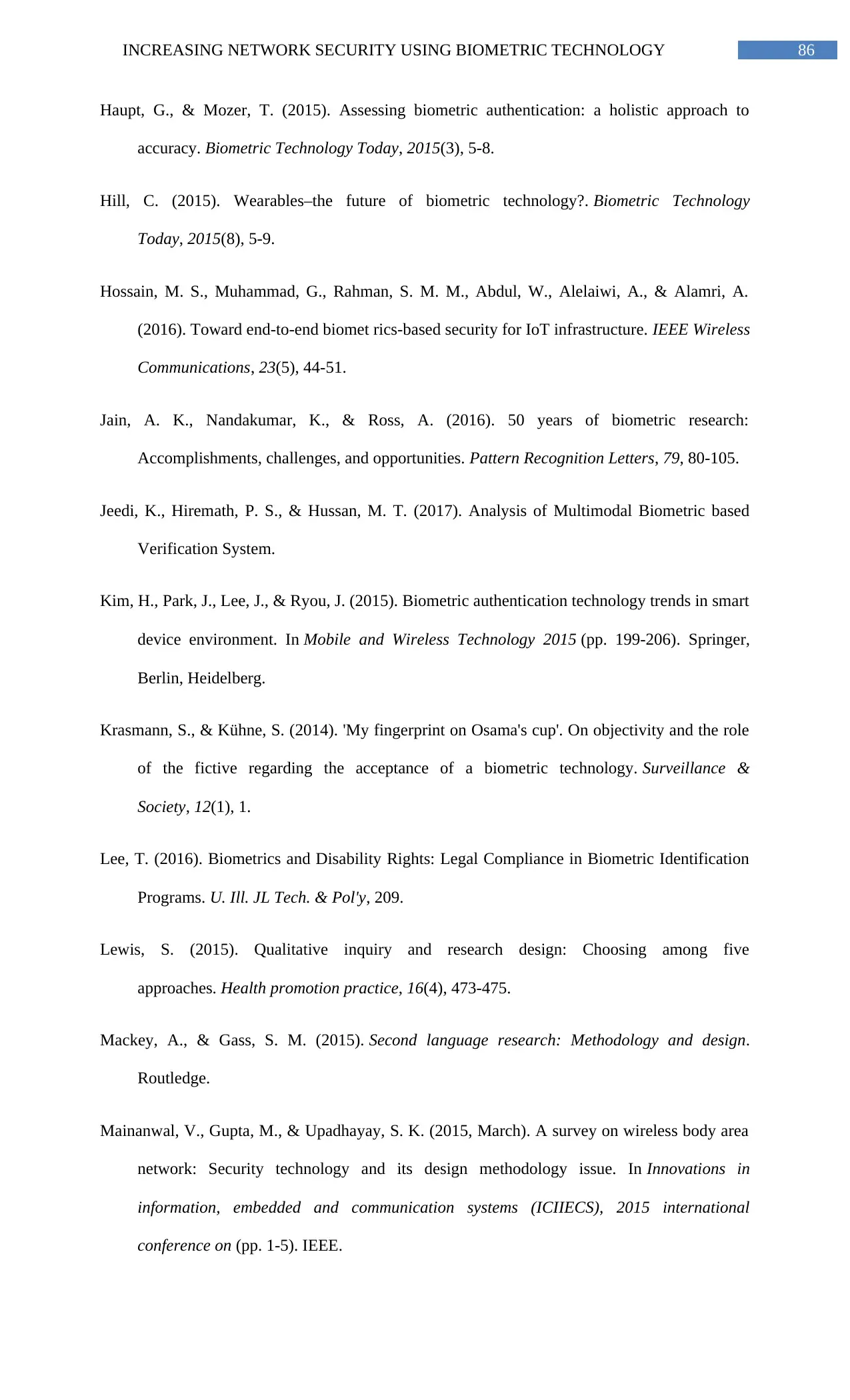
86INCREASING NETWORK SECURITY USING BIOMETRIC TECHNOLOGY
Haupt, G., & Mozer, T. (2015). Assessing biometric authentication: a holistic approach to
accuracy. Biometric Technology Today, 2015(3), 5-8.
Hill, C. (2015). Wearables–the future of biometric technology?. Biometric Technology
Today, 2015(8), 5-9.
Hossain, M. S., Muhammad, G., Rahman, S. M. M., Abdul, W., Alelaiwi, A., & Alamri, A.
(2016). Toward end-to-end biomet rics-based security for IoT infrastructure. IEEE Wireless
Communications, 23(5), 44-51.
Jain, A. K., Nandakumar, K., & Ross, A. (2016). 50 years of biometric research:
Accomplishments, challenges, and opportunities. Pattern Recognition Letters, 79, 80-105.
Jeedi, K., Hiremath, P. S., & Hussan, M. T. (2017). Analysis of Multimodal Biometric based
Verification System.
Kim, H., Park, J., Lee, J., & Ryou, J. (2015). Biometric authentication technology trends in smart
device environment. In Mobile and Wireless Technology 2015 (pp. 199-206). Springer,
Berlin, Heidelberg.
Krasmann, S., & Kühne, S. (2014). 'My fingerprint on Osama's cup'. On objectivity and the role
of the fictive regarding the acceptance of a biometric technology. Surveillance &
Society, 12(1), 1.
Lee, T. (2016). Biometrics and Disability Rights: Legal Compliance in Biometric Identification
Programs. U. Ill. JL Tech. & Pol'y, 209.
Lewis, S. (2015). Qualitative inquiry and research design: Choosing among five
approaches. Health promotion practice, 16(4), 473-475.
Mackey, A., & Gass, S. M. (2015). Second language research: Methodology and design.
Routledge.
Mainanwal, V., Gupta, M., & Upadhayay, S. K. (2015, March). A survey on wireless body area
network: Security technology and its design methodology issue. In Innovations in
information, embedded and communication systems (ICIIECS), 2015 international
conference on (pp. 1-5). IEEE.
Haupt, G., & Mozer, T. (2015). Assessing biometric authentication: a holistic approach to
accuracy. Biometric Technology Today, 2015(3), 5-8.
Hill, C. (2015). Wearables–the future of biometric technology?. Biometric Technology
Today, 2015(8), 5-9.
Hossain, M. S., Muhammad, G., Rahman, S. M. M., Abdul, W., Alelaiwi, A., & Alamri, A.
(2016). Toward end-to-end biomet rics-based security for IoT infrastructure. IEEE Wireless
Communications, 23(5), 44-51.
Jain, A. K., Nandakumar, K., & Ross, A. (2016). 50 years of biometric research:
Accomplishments, challenges, and opportunities. Pattern Recognition Letters, 79, 80-105.
Jeedi, K., Hiremath, P. S., & Hussan, M. T. (2017). Analysis of Multimodal Biometric based
Verification System.
Kim, H., Park, J., Lee, J., & Ryou, J. (2015). Biometric authentication technology trends in smart
device environment. In Mobile and Wireless Technology 2015 (pp. 199-206). Springer,
Berlin, Heidelberg.
Krasmann, S., & Kühne, S. (2014). 'My fingerprint on Osama's cup'. On objectivity and the role
of the fictive regarding the acceptance of a biometric technology. Surveillance &
Society, 12(1), 1.
Lee, T. (2016). Biometrics and Disability Rights: Legal Compliance in Biometric Identification
Programs. U. Ill. JL Tech. & Pol'y, 209.
Lewis, S. (2015). Qualitative inquiry and research design: Choosing among five
approaches. Health promotion practice, 16(4), 473-475.
Mackey, A., & Gass, S. M. (2015). Second language research: Methodology and design.
Routledge.
Mainanwal, V., Gupta, M., & Upadhayay, S. K. (2015, March). A survey on wireless body area
network: Security technology and its design methodology issue. In Innovations in
information, embedded and communication systems (ICIIECS), 2015 international
conference on (pp. 1-5). IEEE.
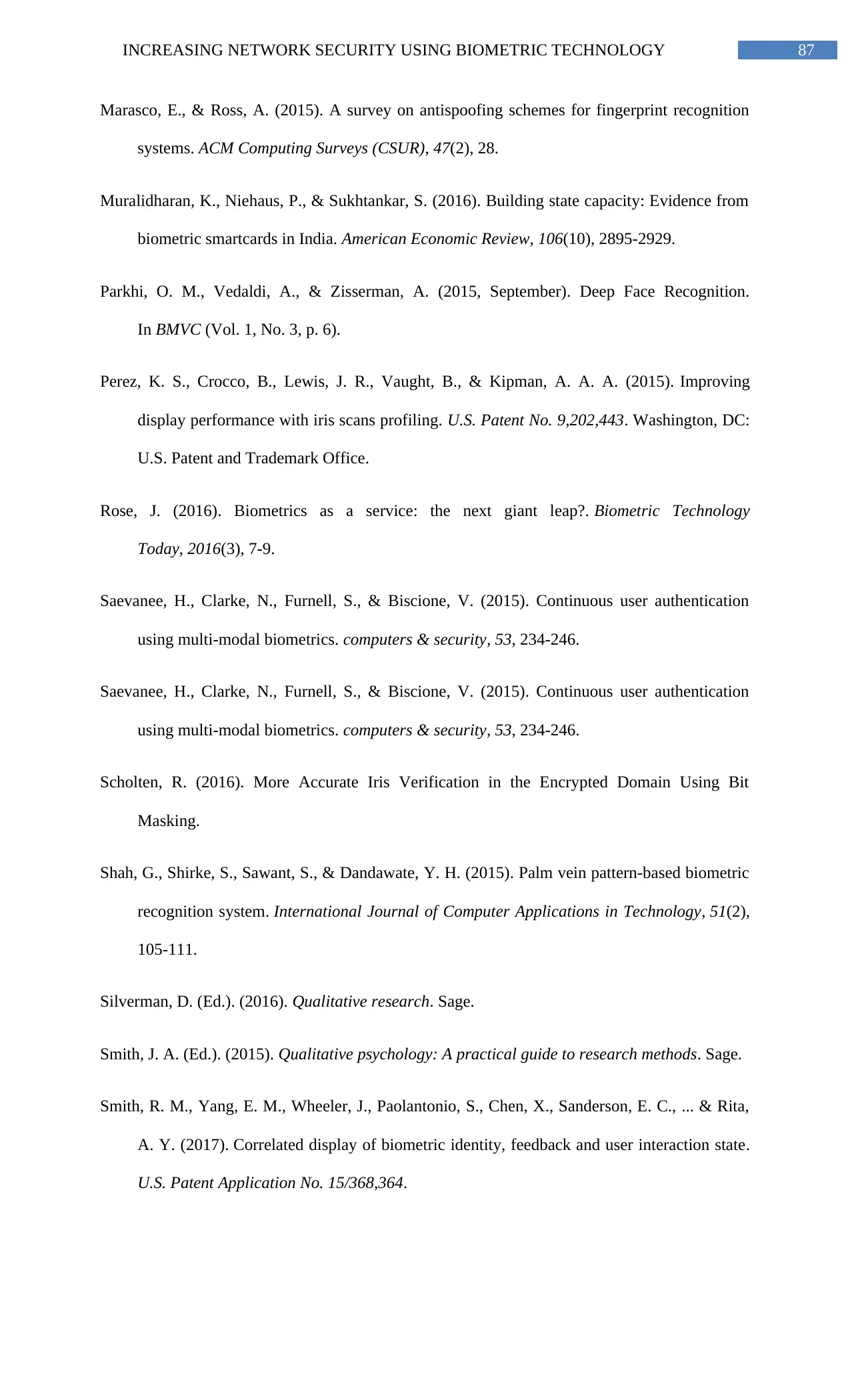
87INCREASING NETWORK SECURITY USING BIOMETRIC TECHNOLOGY
Marasco, E., & Ross, A. (2015). A survey on antispoofing schemes for fingerprint recognition
systems. ACM Computing Surveys (CSUR), 47(2), 28.
Muralidharan, K., Niehaus, P., & Sukhtankar, S. (2016). Building state capacity: Evidence from
biometric smartcards in India. American Economic Review, 106(10), 2895-2929.
Parkhi, O. M., Vedaldi, A., & Zisserman, A. (2015, September). Deep Face Recognition.
In BMVC (Vol. 1, No. 3, p. 6).
Perez, K. S., Crocco, B., Lewis, J. R., Vaught, B., & Kipman, A. A. A. (2015). Improving
display performance with iris scans profiling. U.S. Patent No. 9,202,443. Washington, DC:
U.S. Patent and Trademark Office.
Rose, J. (2016). Biometrics as a service: the next giant leap?. Biometric Technology
Today, 2016(3), 7-9.
Saevanee, H., Clarke, N., Furnell, S., & Biscione, V. (2015). Continuous user authentication
using multi-modal biometrics. computers & security, 53, 234-246.
Saevanee, H., Clarke, N., Furnell, S., & Biscione, V. (2015). Continuous user authentication
using multi-modal biometrics. computers & security, 53, 234-246.
Scholten, R. (2016). More Accurate Iris Verification in the Encrypted Domain Using Bit
Masking.
Shah, G., Shirke, S., Sawant, S., & Dandawate, Y. H. (2015). Palm vein pattern-based biometric
recognition system. International Journal of Computer Applications in Technology, 51(2),
105-111.
Silverman, D. (Ed.). (2016). Qualitative research. Sage.
Smith, J. A. (Ed.). (2015). Qualitative psychology: A practical guide to research methods. Sage.
Smith, R. M., Yang, E. M., Wheeler, J., Paolantonio, S., Chen, X., Sanderson, E. C., ... & Rita,
A. Y. (2017). Correlated display of biometric identity, feedback and user interaction state.
U.S. Patent Application No. 15/368,364.
Marasco, E., & Ross, A. (2015). A survey on antispoofing schemes for fingerprint recognition
systems. ACM Computing Surveys (CSUR), 47(2), 28.
Muralidharan, K., Niehaus, P., & Sukhtankar, S. (2016). Building state capacity: Evidence from
biometric smartcards in India. American Economic Review, 106(10), 2895-2929.
Parkhi, O. M., Vedaldi, A., & Zisserman, A. (2015, September). Deep Face Recognition.
In BMVC (Vol. 1, No. 3, p. 6).
Perez, K. S., Crocco, B., Lewis, J. R., Vaught, B., & Kipman, A. A. A. (2015). Improving
display performance with iris scans profiling. U.S. Patent No. 9,202,443. Washington, DC:
U.S. Patent and Trademark Office.
Rose, J. (2016). Biometrics as a service: the next giant leap?. Biometric Technology
Today, 2016(3), 7-9.
Saevanee, H., Clarke, N., Furnell, S., & Biscione, V. (2015). Continuous user authentication
using multi-modal biometrics. computers & security, 53, 234-246.
Saevanee, H., Clarke, N., Furnell, S., & Biscione, V. (2015). Continuous user authentication
using multi-modal biometrics. computers & security, 53, 234-246.
Scholten, R. (2016). More Accurate Iris Verification in the Encrypted Domain Using Bit
Masking.
Shah, G., Shirke, S., Sawant, S., & Dandawate, Y. H. (2015). Palm vein pattern-based biometric
recognition system. International Journal of Computer Applications in Technology, 51(2),
105-111.
Silverman, D. (Ed.). (2016). Qualitative research. Sage.
Smith, J. A. (Ed.). (2015). Qualitative psychology: A practical guide to research methods. Sage.
Smith, R. M., Yang, E. M., Wheeler, J., Paolantonio, S., Chen, X., Sanderson, E. C., ... & Rita,
A. Y. (2017). Correlated display of biometric identity, feedback and user interaction state.
U.S. Patent Application No. 15/368,364.
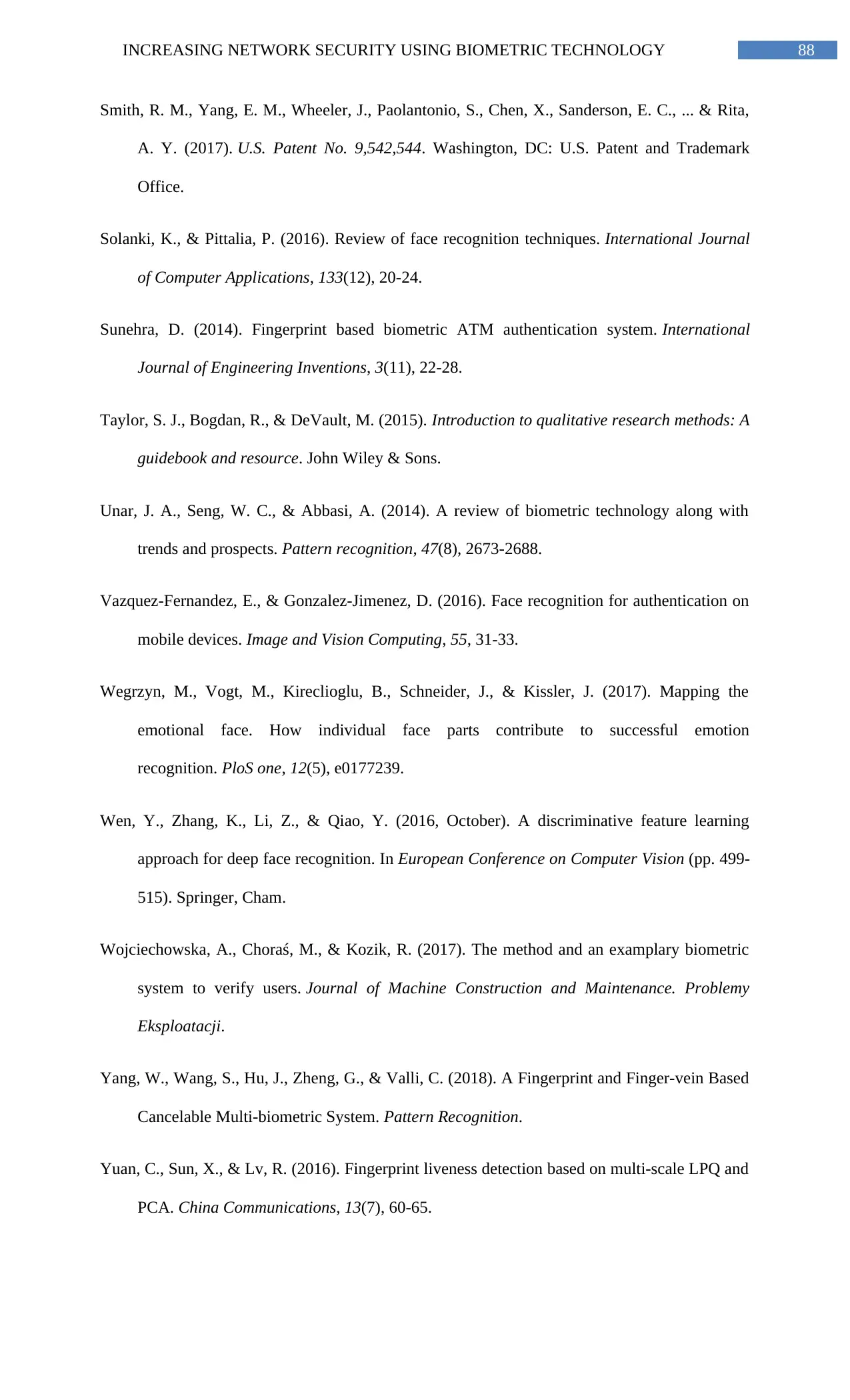
88INCREASING NETWORK SECURITY USING BIOMETRIC TECHNOLOGY
Smith, R. M., Yang, E. M., Wheeler, J., Paolantonio, S., Chen, X., Sanderson, E. C., ... & Rita,
A. Y. (2017). U.S. Patent No. 9,542,544. Washington, DC: U.S. Patent and Trademark
Office.
Solanki, K., & Pittalia, P. (2016). Review of face recognition techniques. International Journal
of Computer Applications, 133(12), 20-24.
Sunehra, D. (2014). Fingerprint based biometric ATM authentication system. International
Journal of Engineering Inventions, 3(11), 22-28.
Taylor, S. J., Bogdan, R., & DeVault, M. (2015). Introduction to qualitative research methods: A
guidebook and resource. John Wiley & Sons.
Unar, J. A., Seng, W. C., & Abbasi, A. (2014). A review of biometric technology along with
trends and prospects. Pattern recognition, 47(8), 2673-2688.
Vazquez-Fernandez, E., & Gonzalez-Jimenez, D. (2016). Face recognition for authentication on
mobile devices. Image and Vision Computing, 55, 31-33.
Wegrzyn, M., Vogt, M., Kireclioglu, B., Schneider, J., & Kissler, J. (2017). Mapping the
emotional face. How individual face parts contribute to successful emotion
recognition. PloS one, 12(5), e0177239.
Wen, Y., Zhang, K., Li, Z., & Qiao, Y. (2016, October). A discriminative feature learning
approach for deep face recognition. In European Conference on Computer Vision (pp. 499-
515). Springer, Cham.
Wojciechowska, A., Choraś, M., & Kozik, R. (2017). The method and an examplary biometric
system to verify users. Journal of Machine Construction and Maintenance. Problemy
Eksploatacji.
Yang, W., Wang, S., Hu, J., Zheng, G., & Valli, C. (2018). A Fingerprint and Finger-vein Based
Cancelable Multi-biometric System. Pattern Recognition.
Yuan, C., Sun, X., & Lv, R. (2016). Fingerprint liveness detection based on multi-scale LPQ and
PCA. China Communications, 13(7), 60-65.
Smith, R. M., Yang, E. M., Wheeler, J., Paolantonio, S., Chen, X., Sanderson, E. C., ... & Rita,
A. Y. (2017). U.S. Patent No. 9,542,544. Washington, DC: U.S. Patent and Trademark
Office.
Solanki, K., & Pittalia, P. (2016). Review of face recognition techniques. International Journal
of Computer Applications, 133(12), 20-24.
Sunehra, D. (2014). Fingerprint based biometric ATM authentication system. International
Journal of Engineering Inventions, 3(11), 22-28.
Taylor, S. J., Bogdan, R., & DeVault, M. (2015). Introduction to qualitative research methods: A
guidebook and resource. John Wiley & Sons.
Unar, J. A., Seng, W. C., & Abbasi, A. (2014). A review of biometric technology along with
trends and prospects. Pattern recognition, 47(8), 2673-2688.
Vazquez-Fernandez, E., & Gonzalez-Jimenez, D. (2016). Face recognition for authentication on
mobile devices. Image and Vision Computing, 55, 31-33.
Wegrzyn, M., Vogt, M., Kireclioglu, B., Schneider, J., & Kissler, J. (2017). Mapping the
emotional face. How individual face parts contribute to successful emotion
recognition. PloS one, 12(5), e0177239.
Wen, Y., Zhang, K., Li, Z., & Qiao, Y. (2016, October). A discriminative feature learning
approach for deep face recognition. In European Conference on Computer Vision (pp. 499-
515). Springer, Cham.
Wojciechowska, A., Choraś, M., & Kozik, R. (2017). The method and an examplary biometric
system to verify users. Journal of Machine Construction and Maintenance. Problemy
Eksploatacji.
Yang, W., Wang, S., Hu, J., Zheng, G., & Valli, C. (2018). A Fingerprint and Finger-vein Based
Cancelable Multi-biometric System. Pattern Recognition.
Yuan, C., Sun, X., & Lv, R. (2016). Fingerprint liveness detection based on multi-scale LPQ and
PCA. China Communications, 13(7), 60-65.
Secure Best Marks with AI Grader
Need help grading? Try our AI Grader for instant feedback on your assignments.
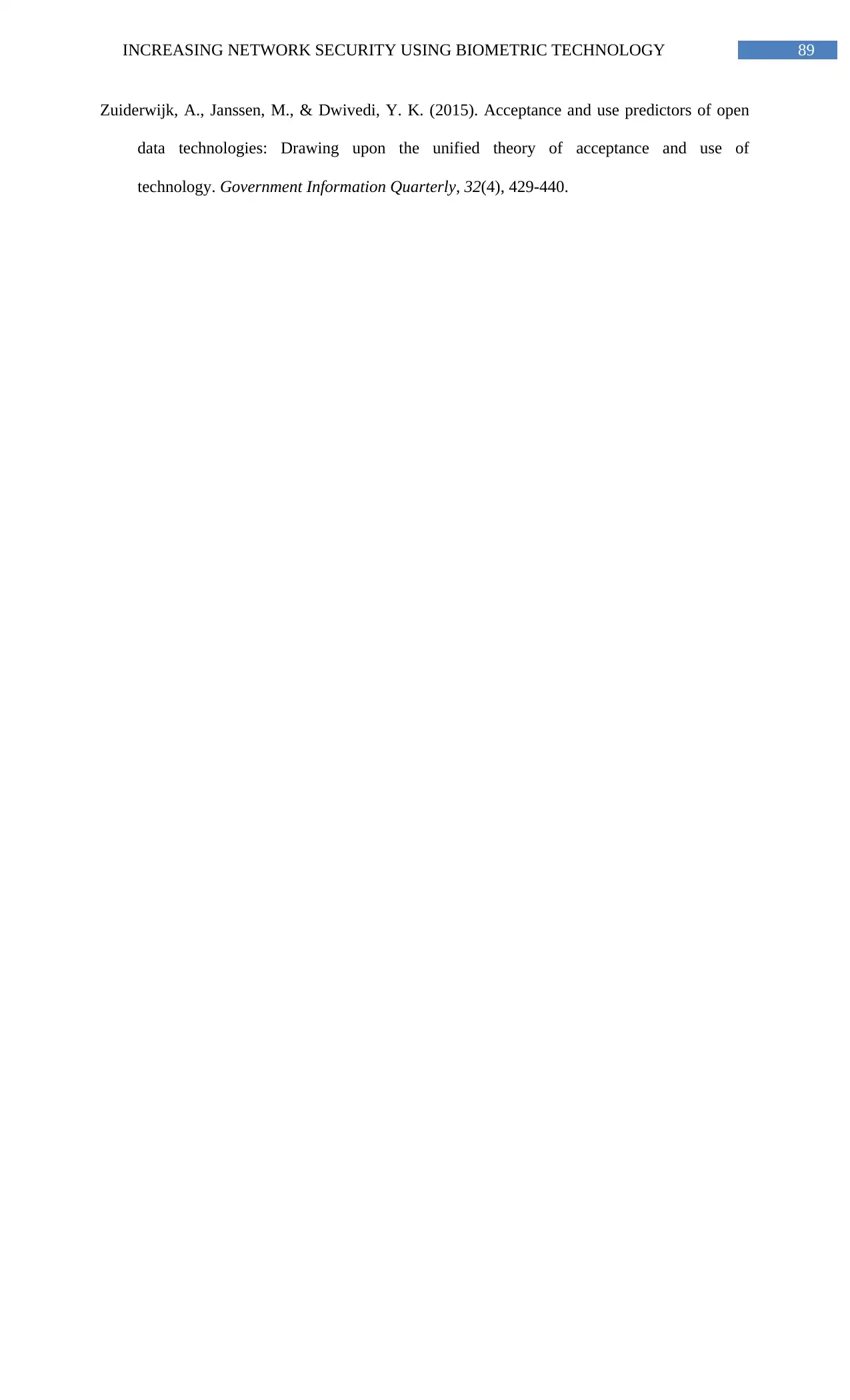
89INCREASING NETWORK SECURITY USING BIOMETRIC TECHNOLOGY
Zuiderwijk, A., Janssen, M., & Dwivedi, Y. K. (2015). Acceptance and use predictors of open
data technologies: Drawing upon the unified theory of acceptance and use of
technology. Government Information Quarterly, 32(4), 429-440.
Zuiderwijk, A., Janssen, M., & Dwivedi, Y. K. (2015). Acceptance and use predictors of open
data technologies: Drawing upon the unified theory of acceptance and use of
technology. Government Information Quarterly, 32(4), 429-440.
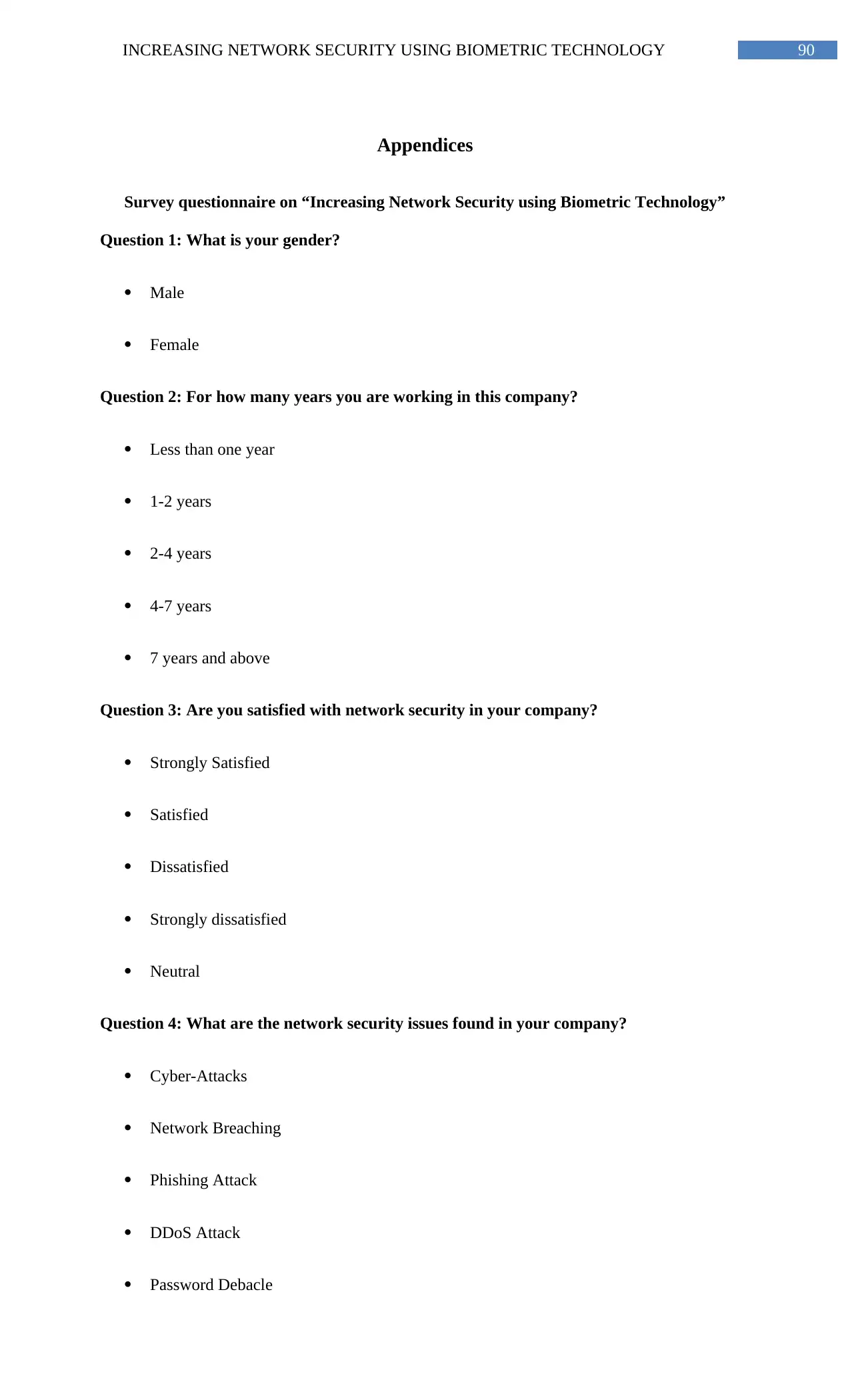
90INCREASING NETWORK SECURITY USING BIOMETRIC TECHNOLOGY
Appendices
Survey questionnaire on “Increasing Network Security using Biometric Technology”
Question 1: What is your gender?
Male
Female
Question 2: For how many years you are working in this company?
Less than one year
1-2 years
2-4 years
4-7 years
7 years and above
Question 3: Are you satisfied with network security in your company?
Strongly Satisfied
Satisfied
Dissatisfied
Strongly dissatisfied
Neutral
Question 4: What are the network security issues found in your company?
Cyber-Attacks
Network Breaching
Phishing Attack
DDoS Attack
Password Debacle
Appendices
Survey questionnaire on “Increasing Network Security using Biometric Technology”
Question 1: What is your gender?
Male
Female
Question 2: For how many years you are working in this company?
Less than one year
1-2 years
2-4 years
4-7 years
7 years and above
Question 3: Are you satisfied with network security in your company?
Strongly Satisfied
Satisfied
Dissatisfied
Strongly dissatisfied
Neutral
Question 4: What are the network security issues found in your company?
Cyber-Attacks
Network Breaching
Phishing Attack
DDoS Attack
Password Debacle
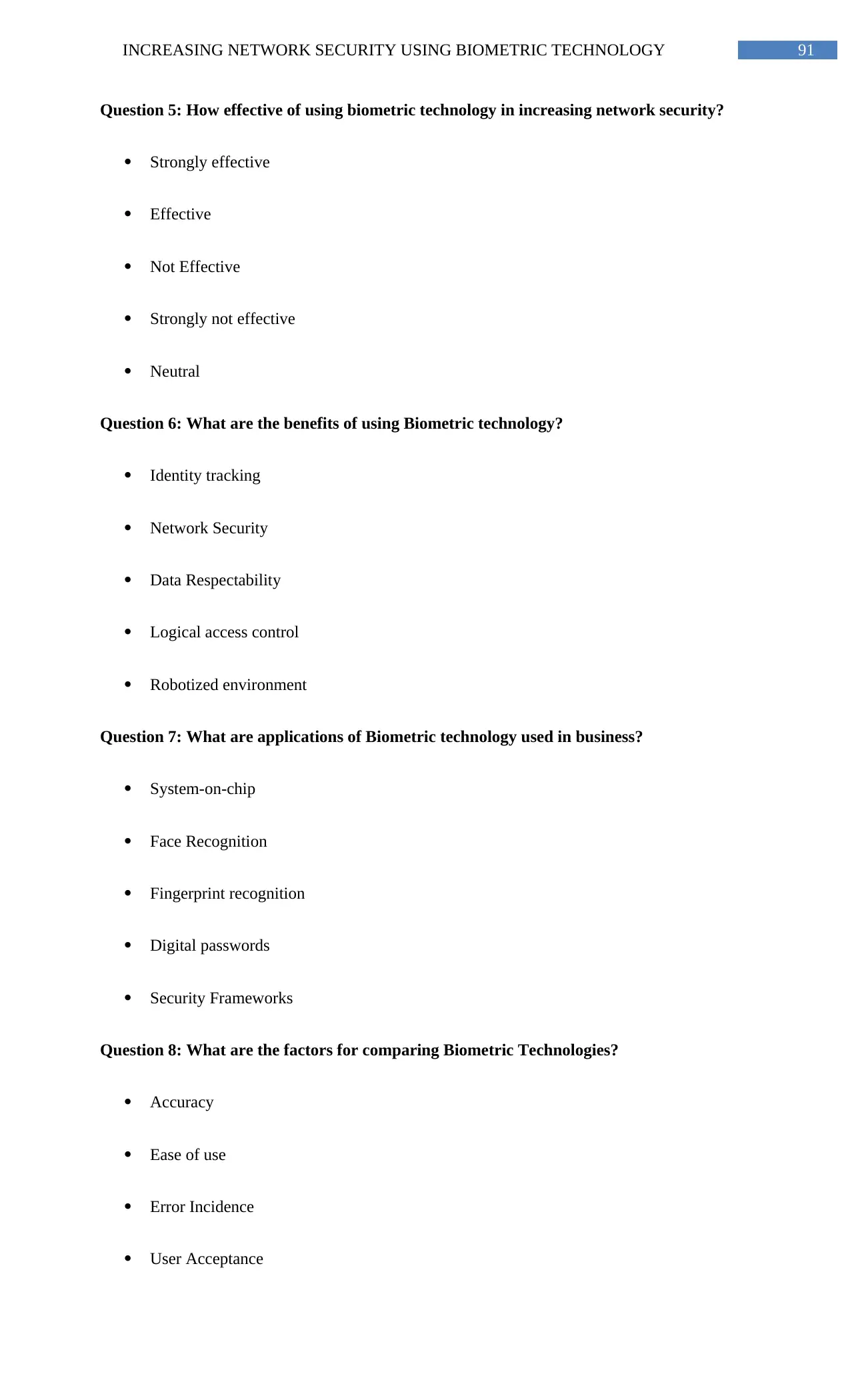
91INCREASING NETWORK SECURITY USING BIOMETRIC TECHNOLOGY
Question 5: How effective of using biometric technology in increasing network security?
Strongly effective
Effective
Not Effective
Strongly not effective
Neutral
Question 6: What are the benefits of using Biometric technology?
Identity tracking
Network Security
Data Respectability
Logical access control
Robotized environment
Question 7: What are applications of Biometric technology used in business?
System-on-chip
Face Recognition
Fingerprint recognition
Digital passwords
Security Frameworks
Question 8: What are the factors for comparing Biometric Technologies?
Accuracy
Ease of use
Error Incidence
User Acceptance
Question 5: How effective of using biometric technology in increasing network security?
Strongly effective
Effective
Not Effective
Strongly not effective
Neutral
Question 6: What are the benefits of using Biometric technology?
Identity tracking
Network Security
Data Respectability
Logical access control
Robotized environment
Question 7: What are applications of Biometric technology used in business?
System-on-chip
Face Recognition
Fingerprint recognition
Digital passwords
Security Frameworks
Question 8: What are the factors for comparing Biometric Technologies?
Accuracy
Ease of use
Error Incidence
User Acceptance
1 out of 91
Related Documents
Your All-in-One AI-Powered Toolkit for Academic Success.
+13062052269
info@desklib.com
Available 24*7 on WhatsApp / Email
![[object Object]](/_next/static/media/star-bottom.7253800d.svg)
Unlock your academic potential
© 2024 | Zucol Services PVT LTD | All rights reserved.





